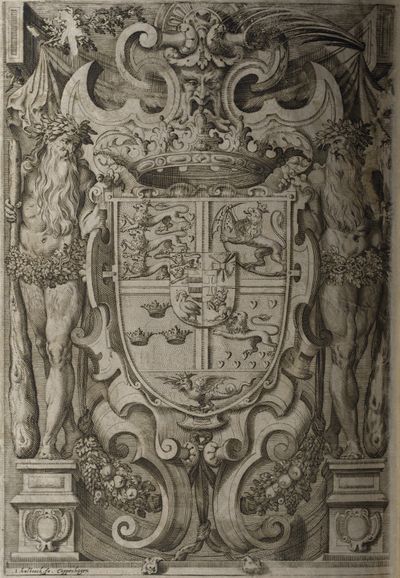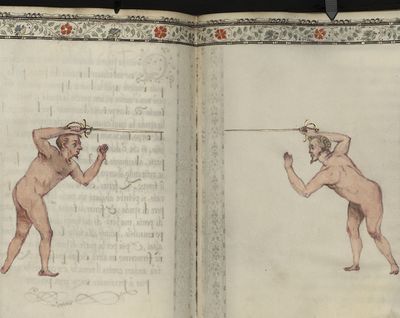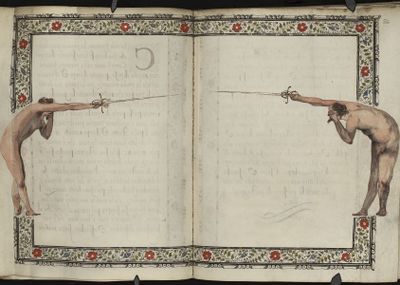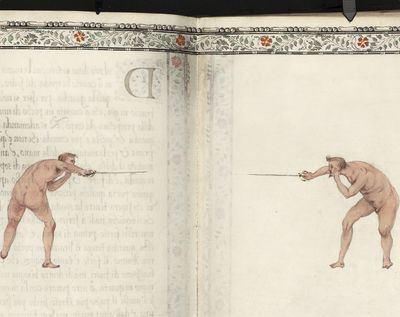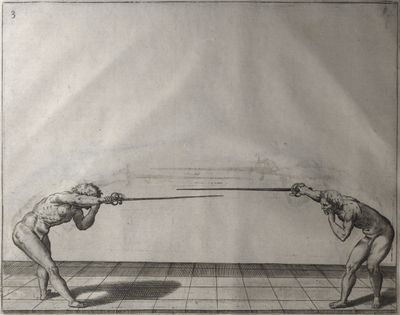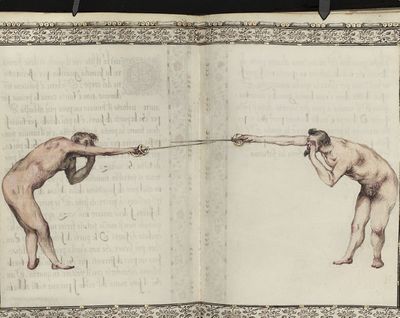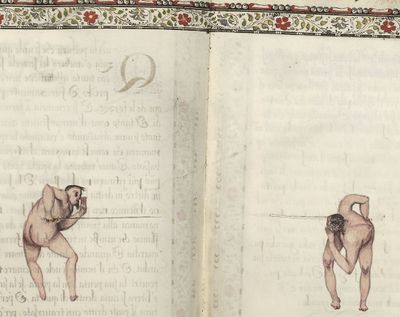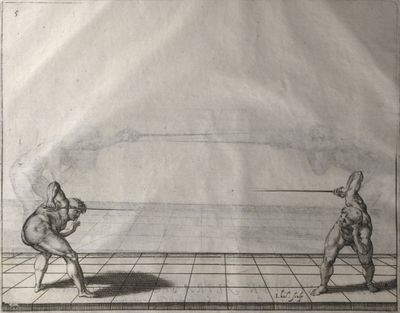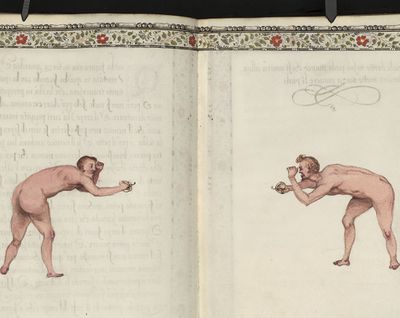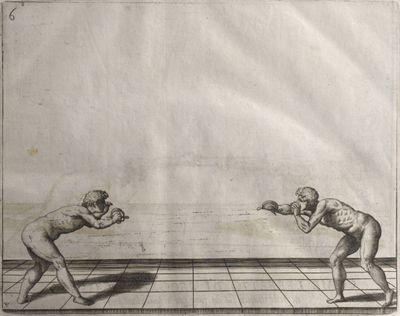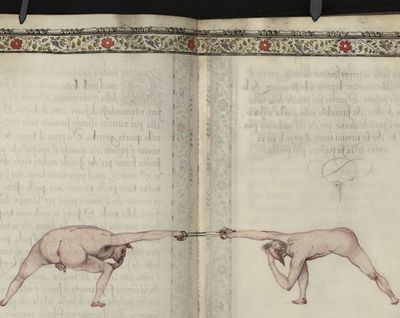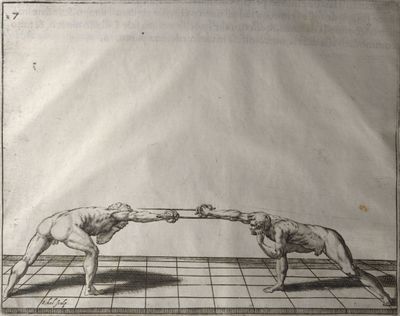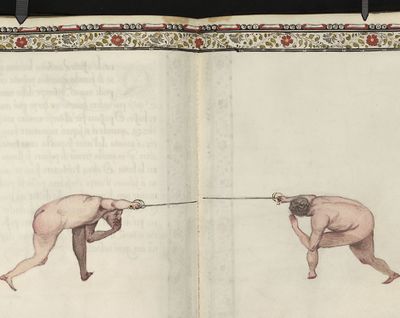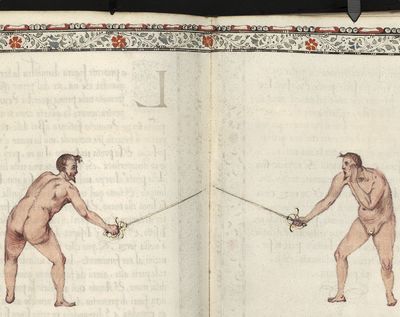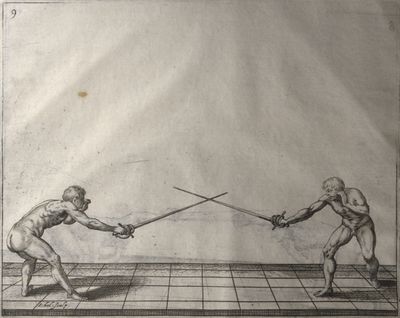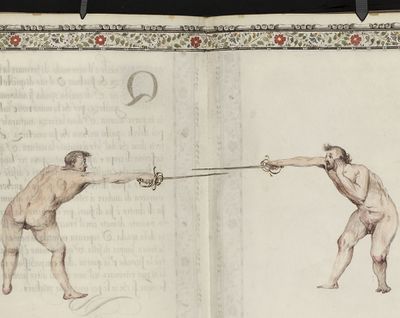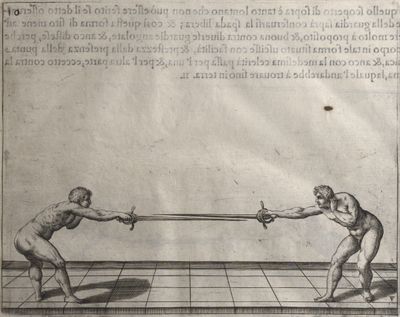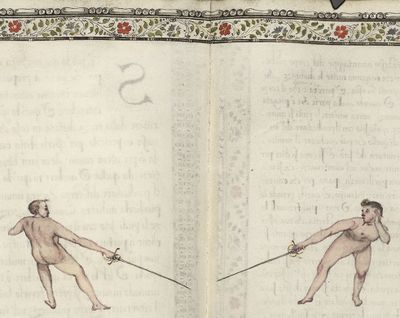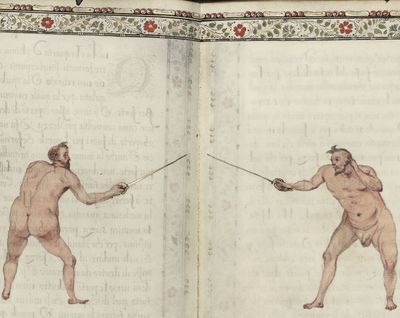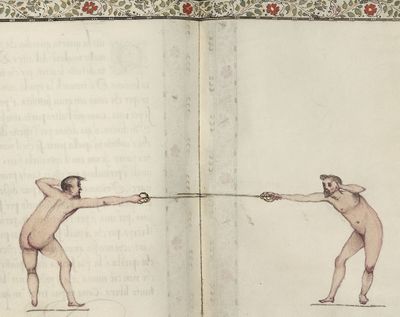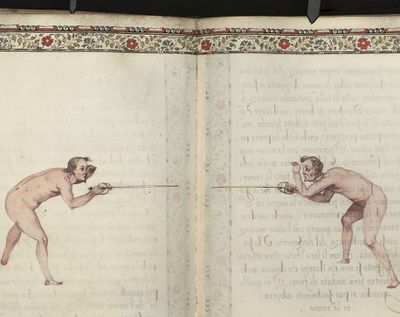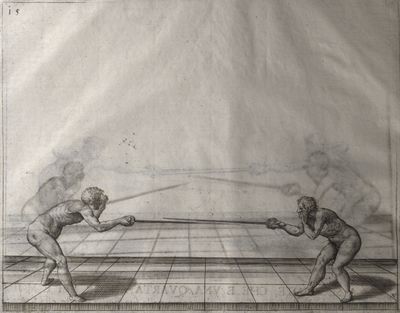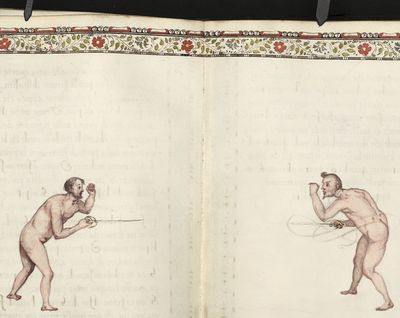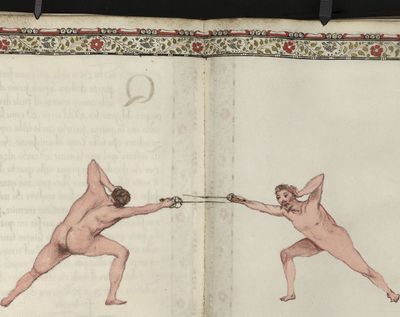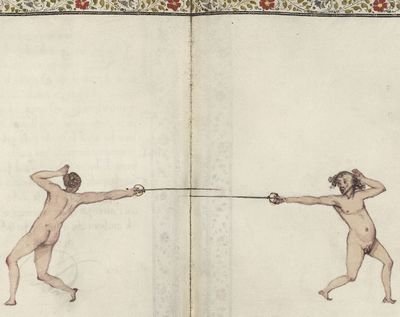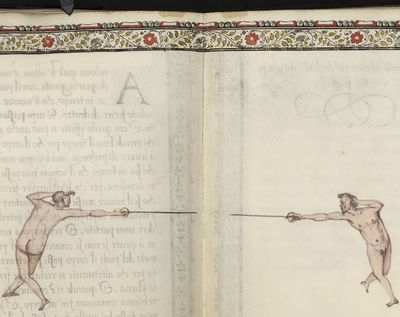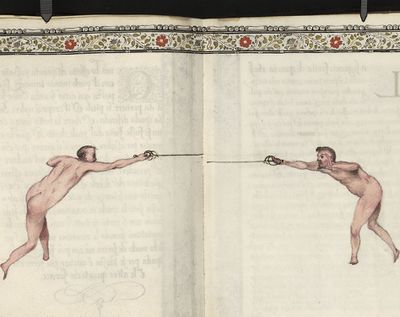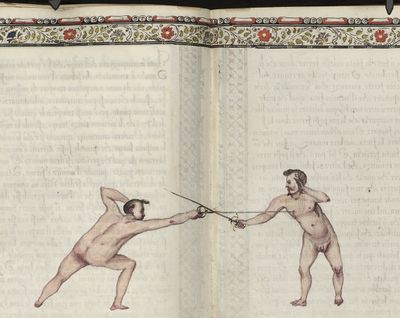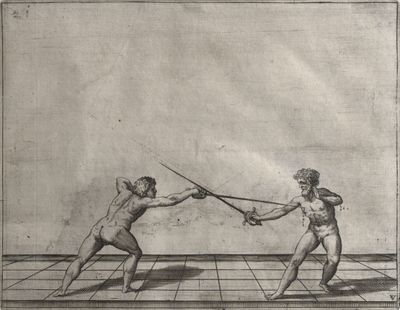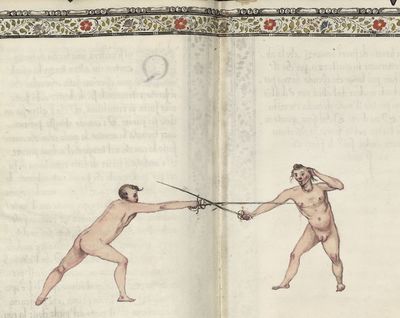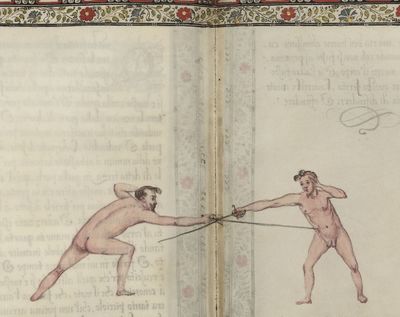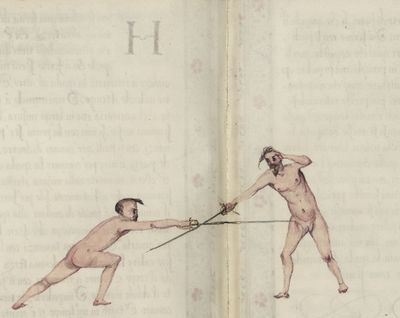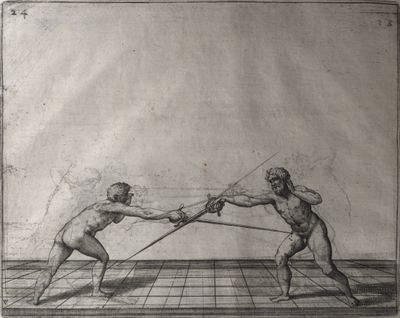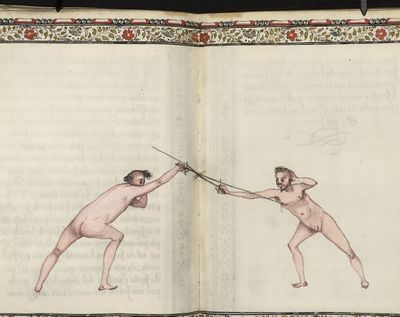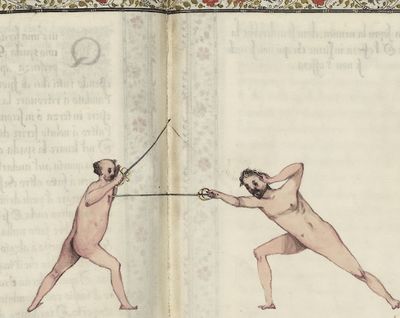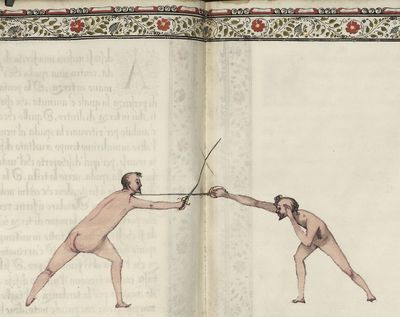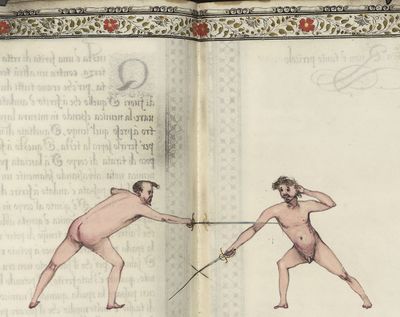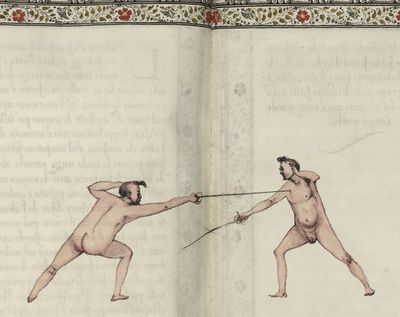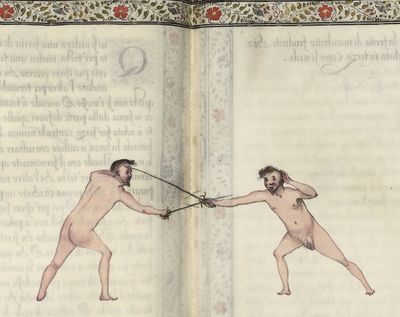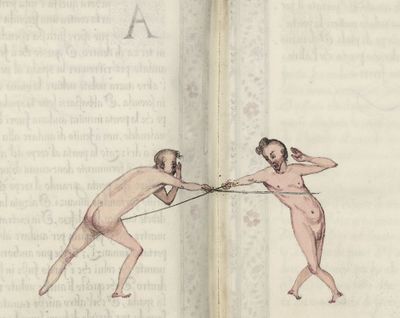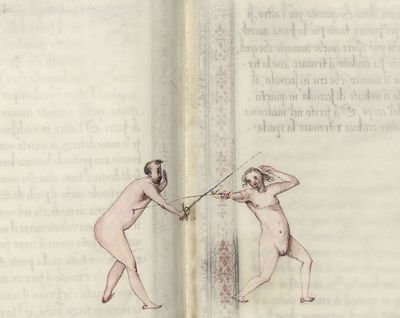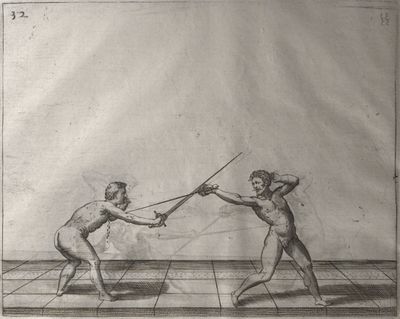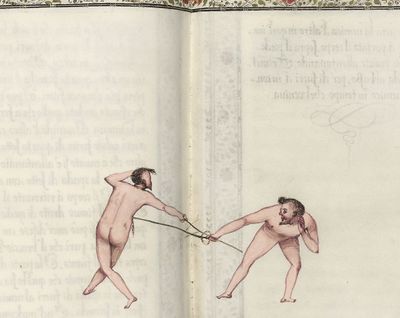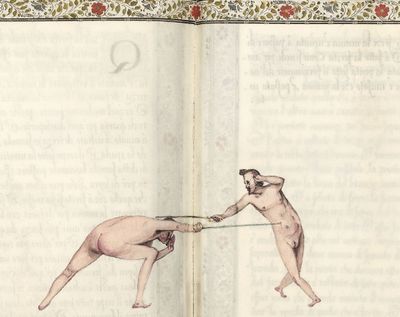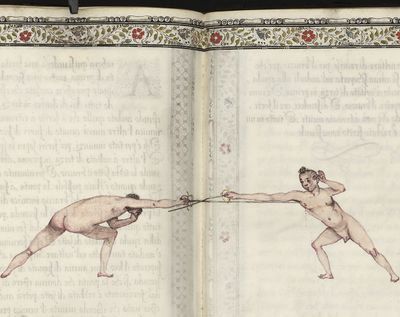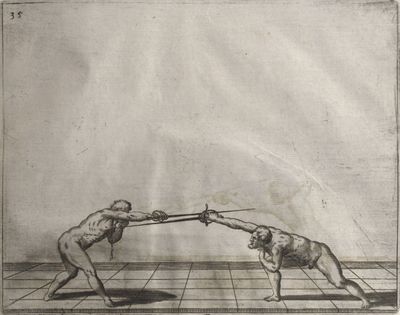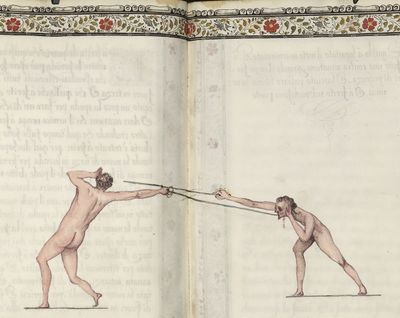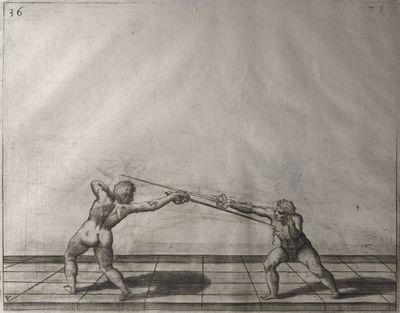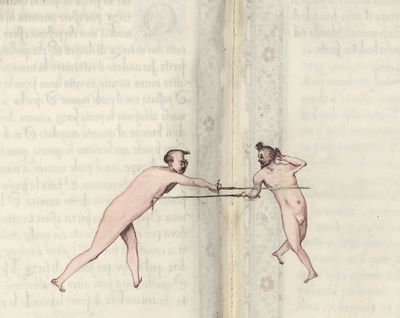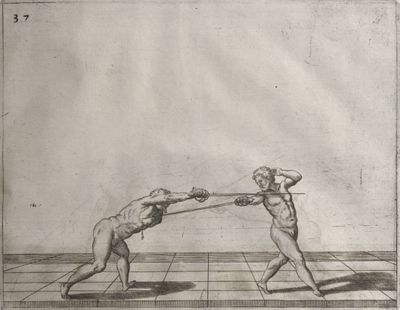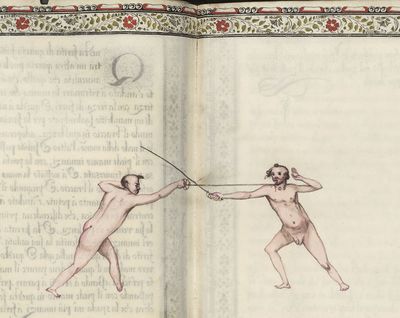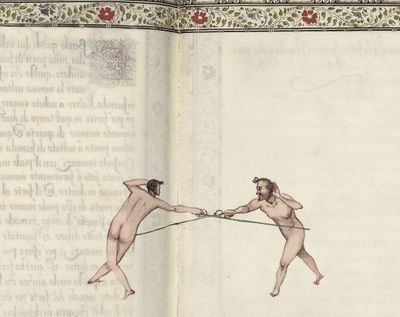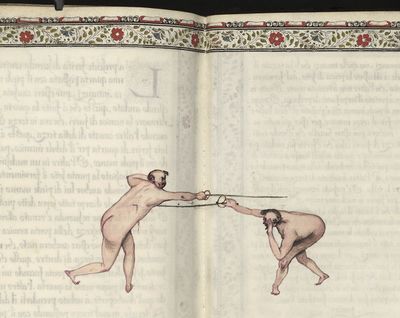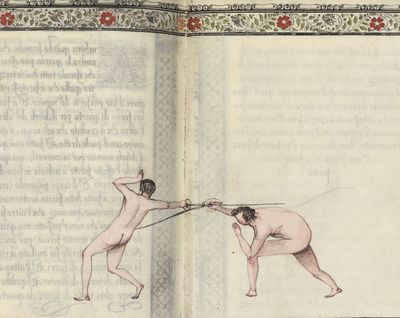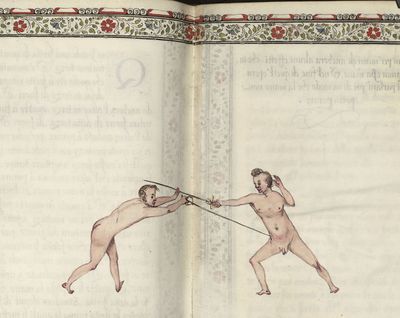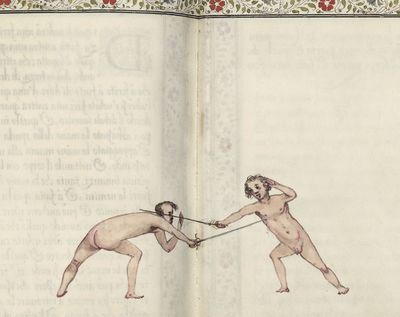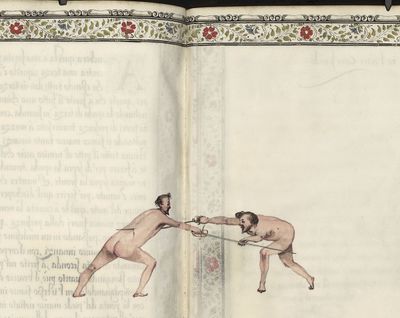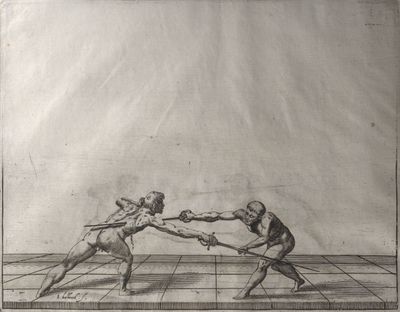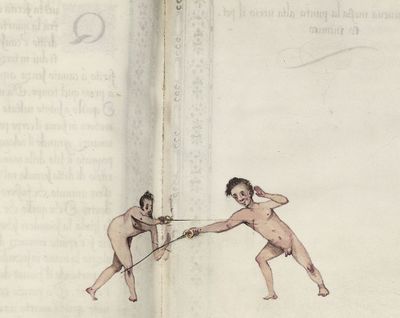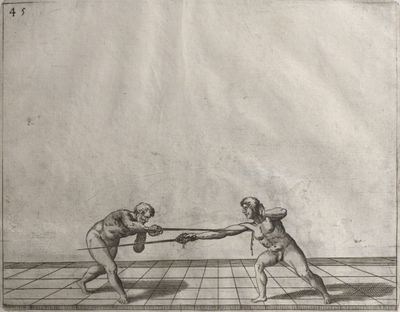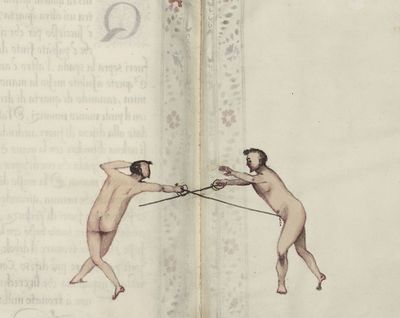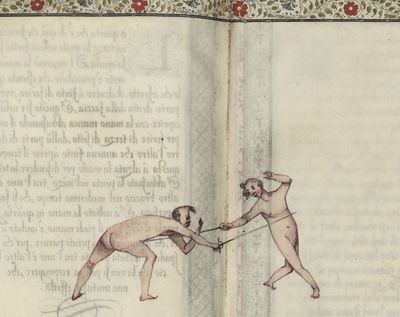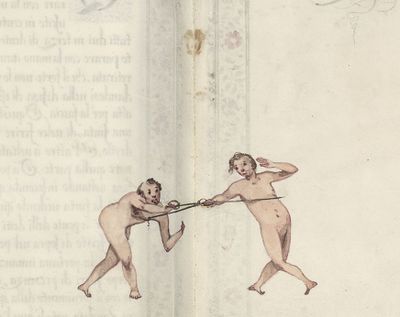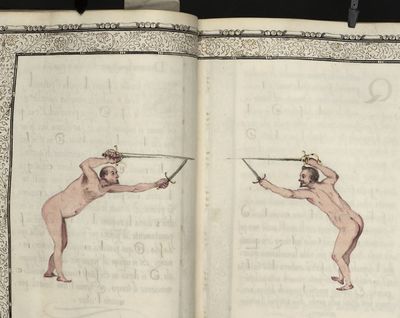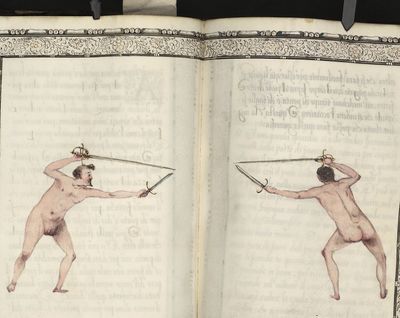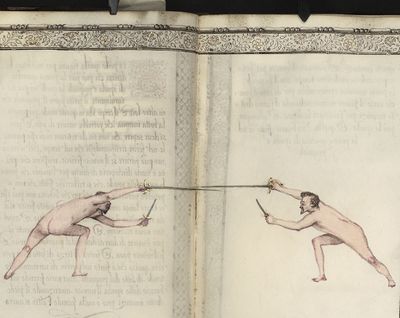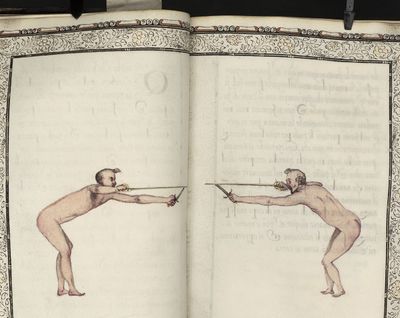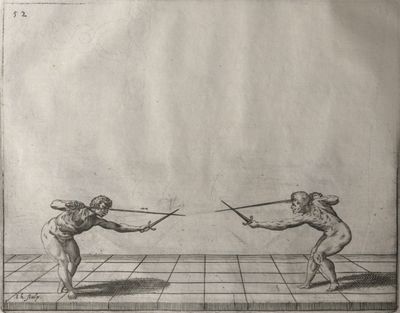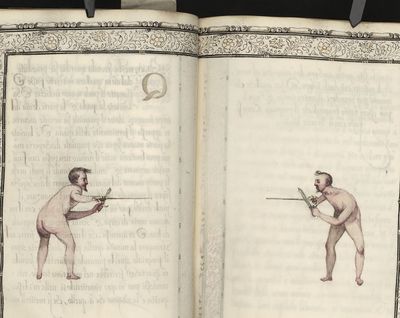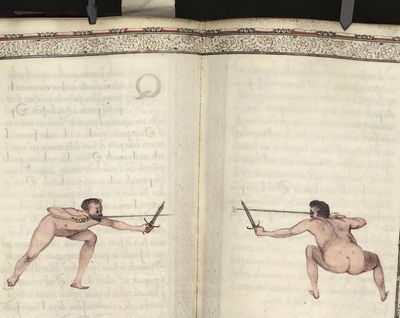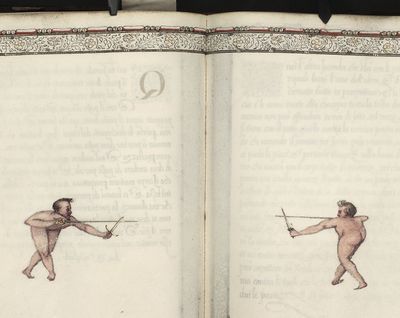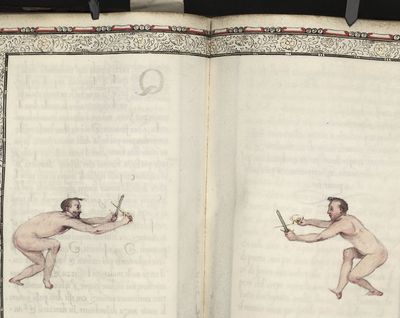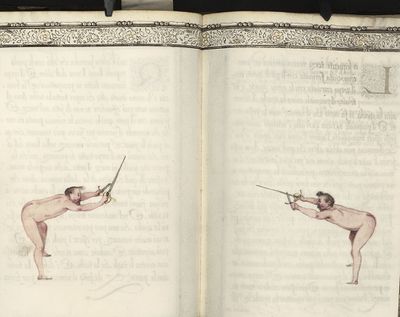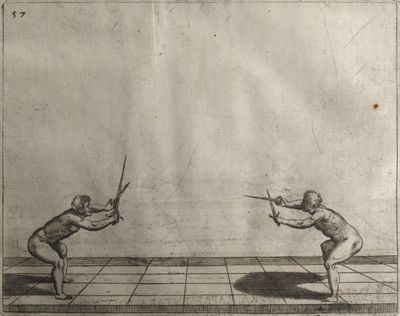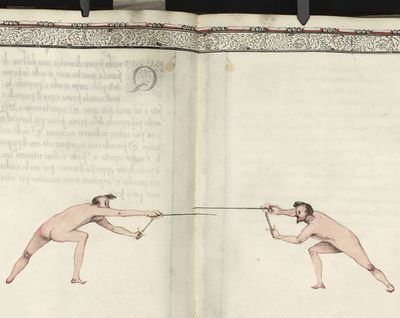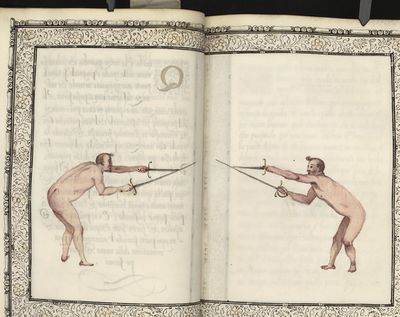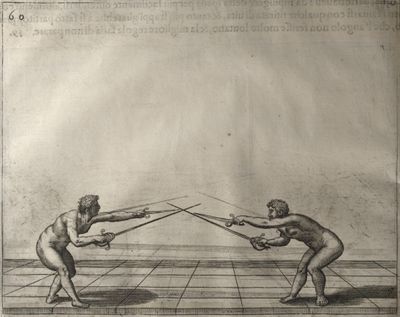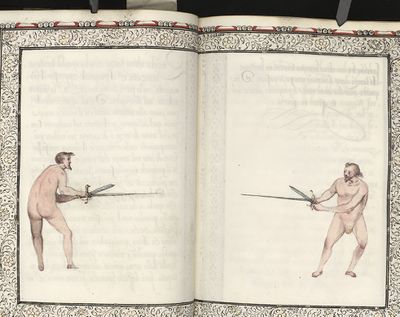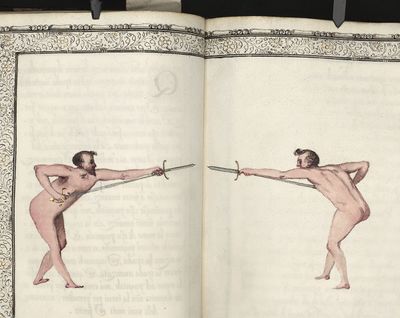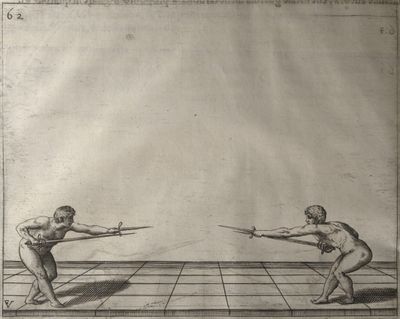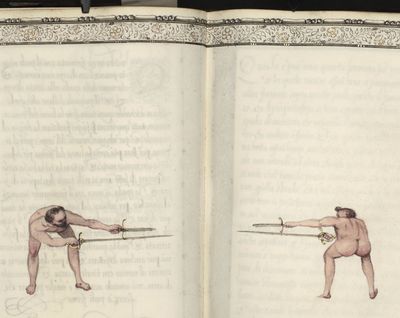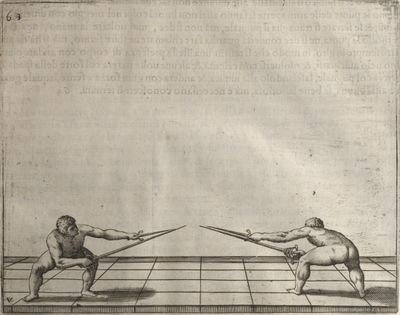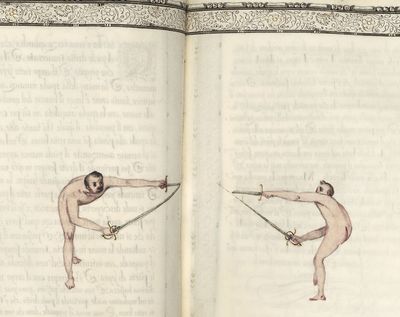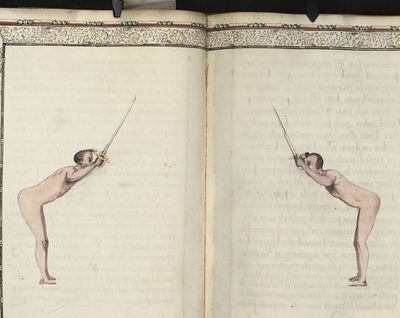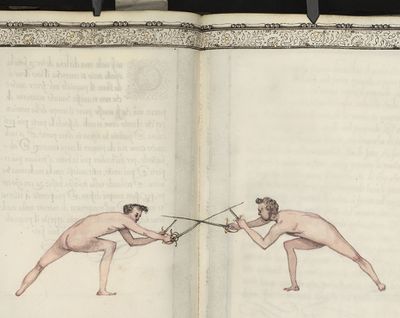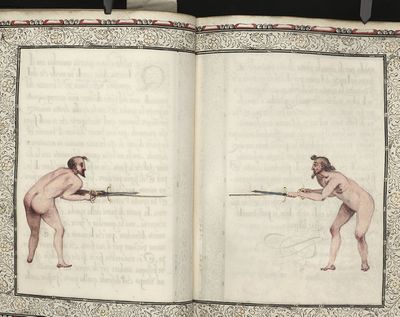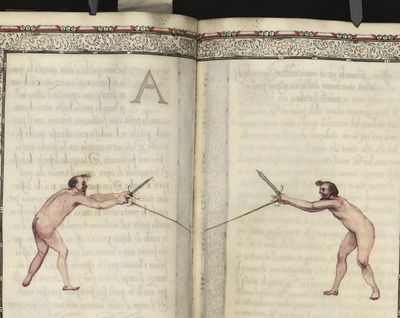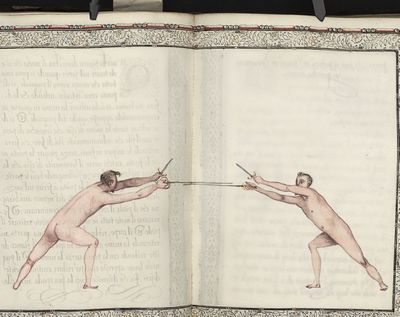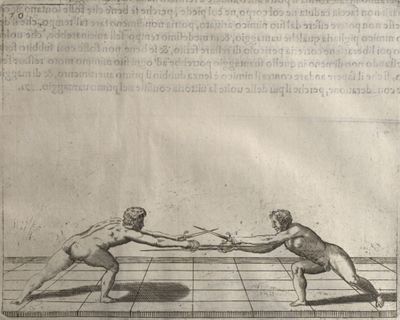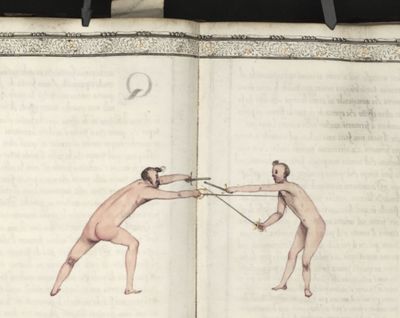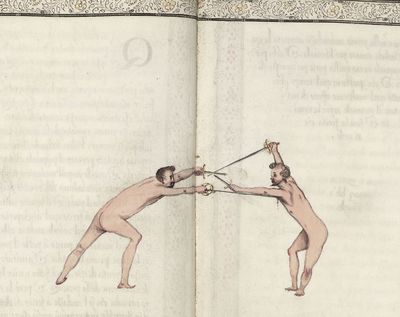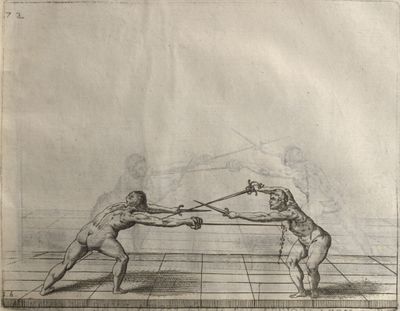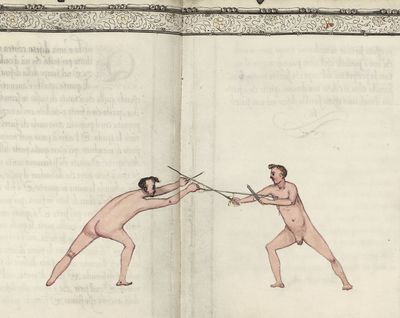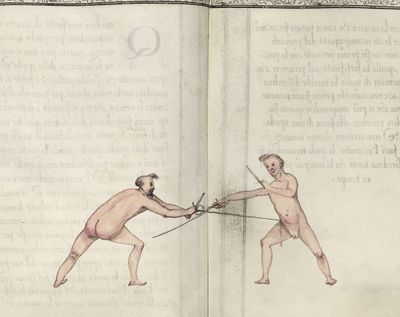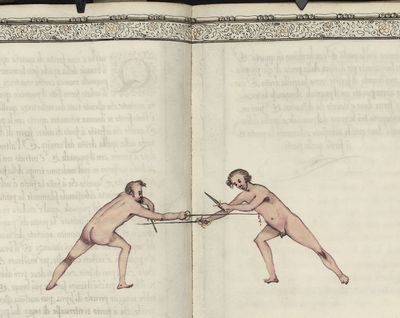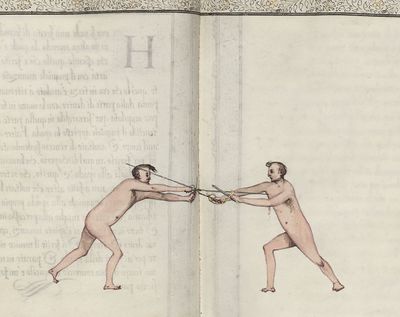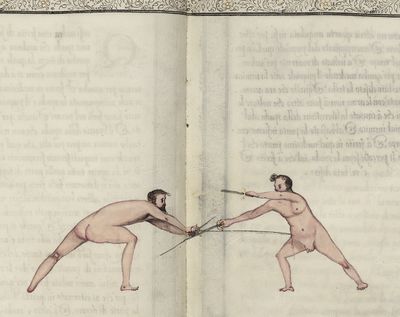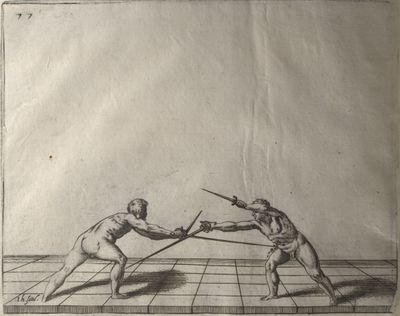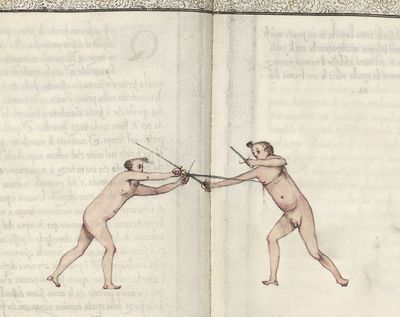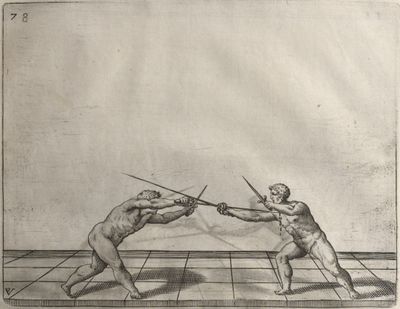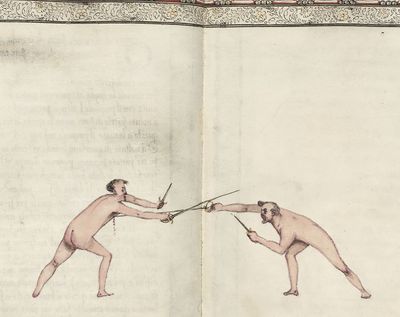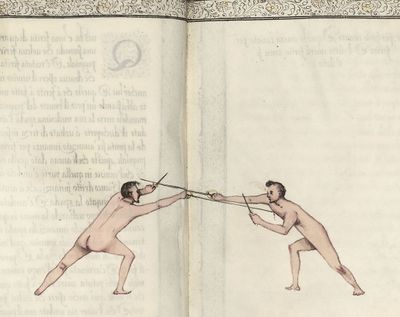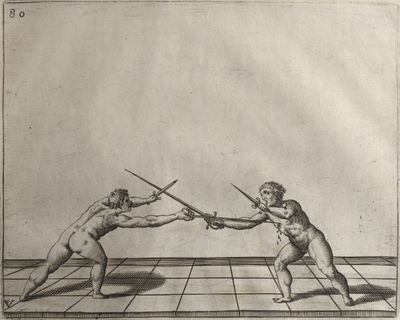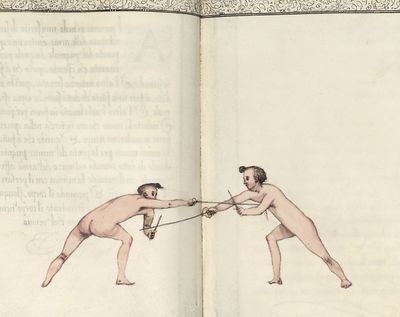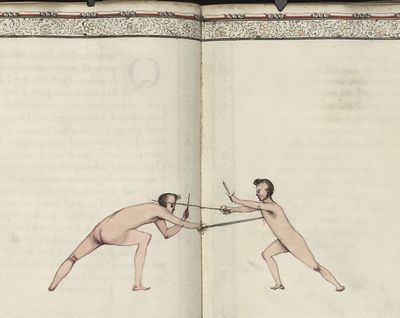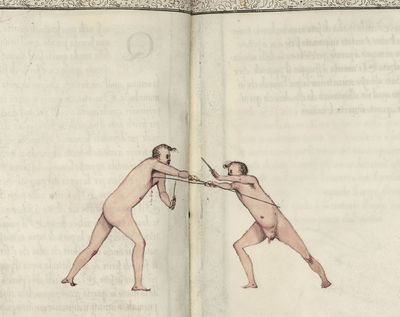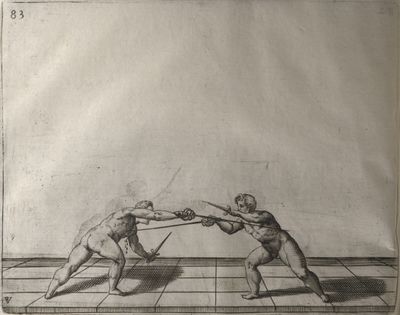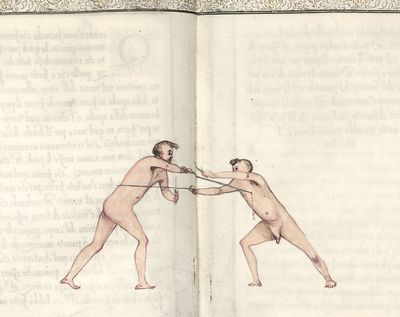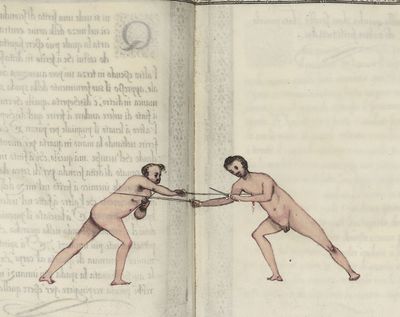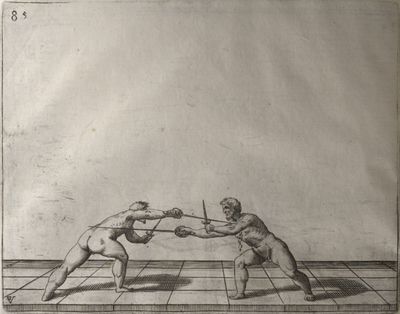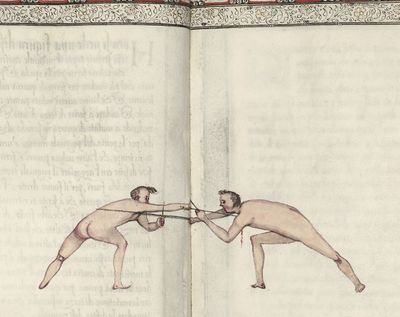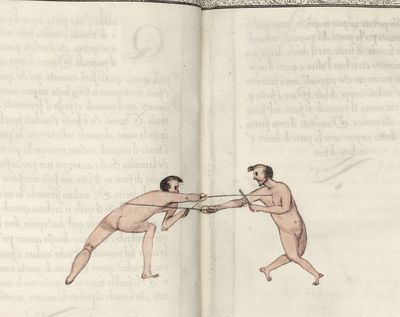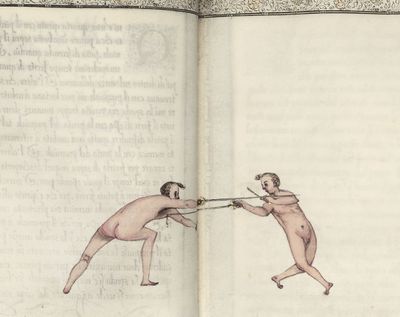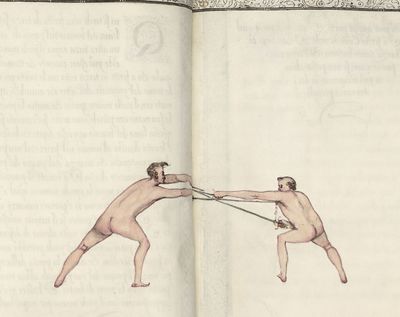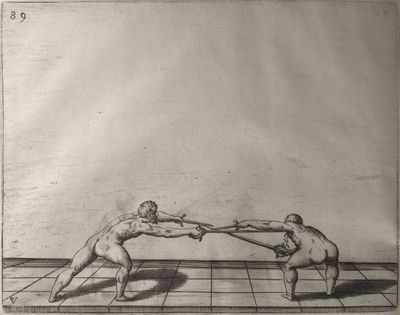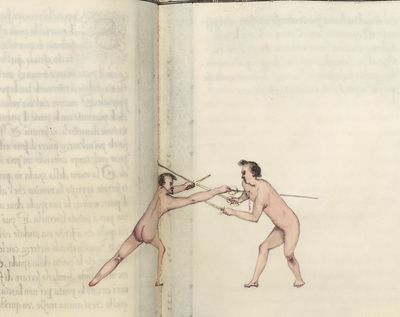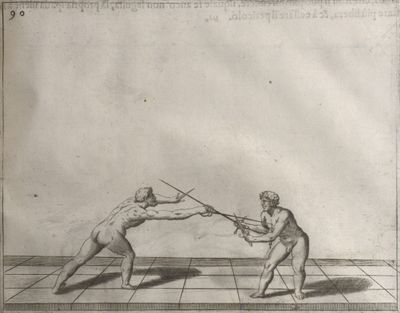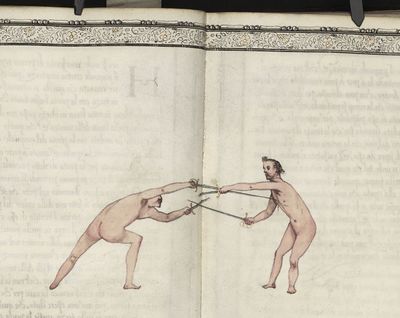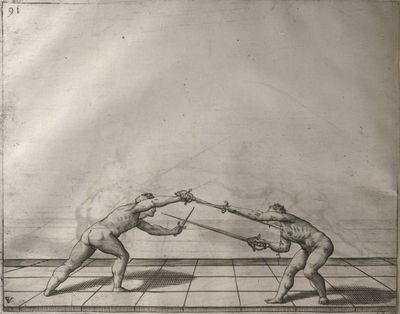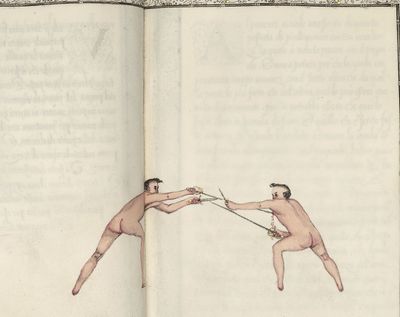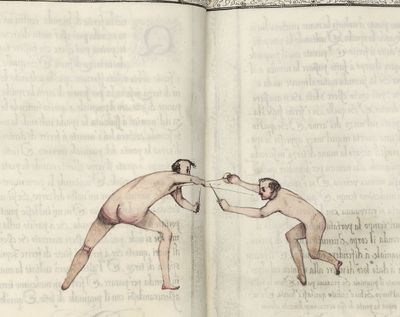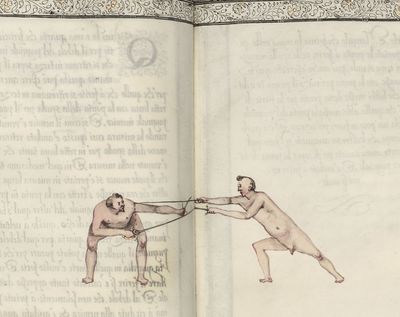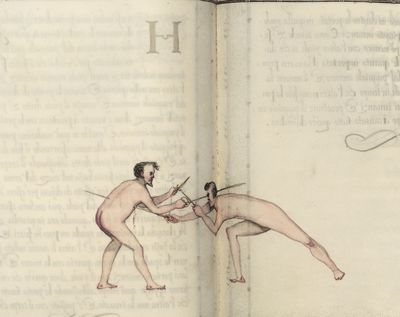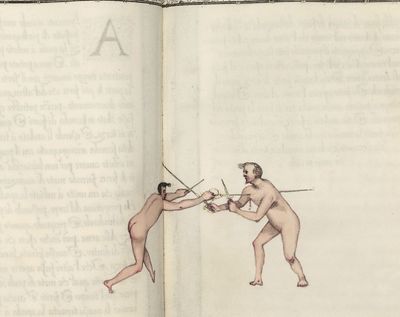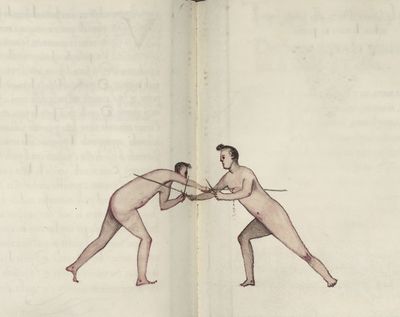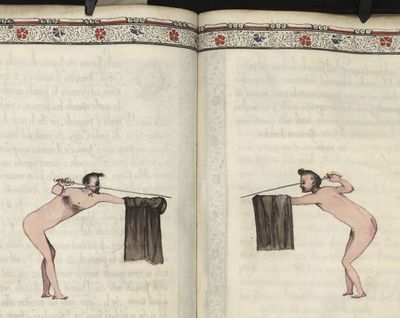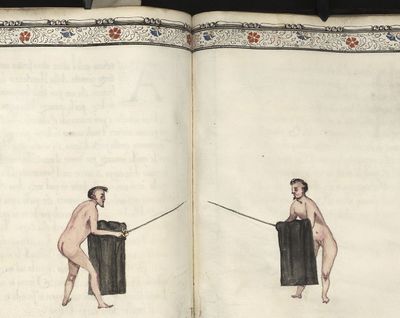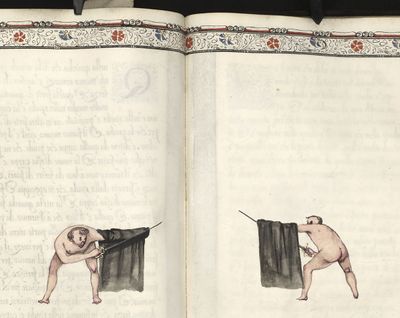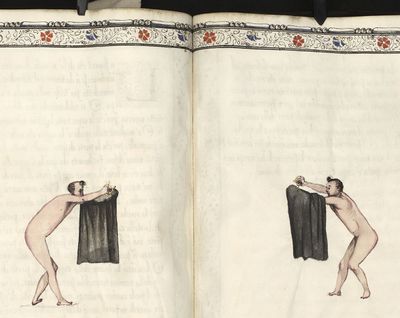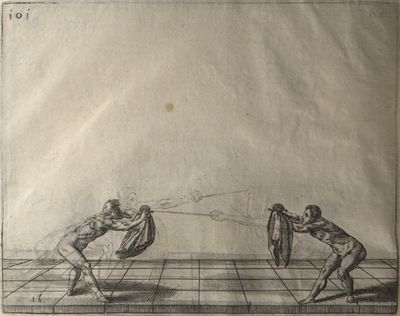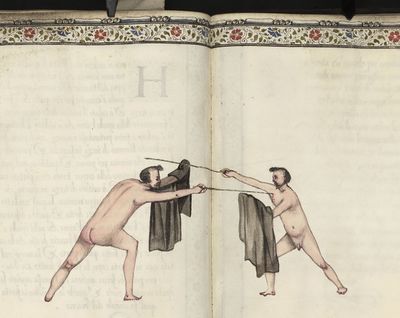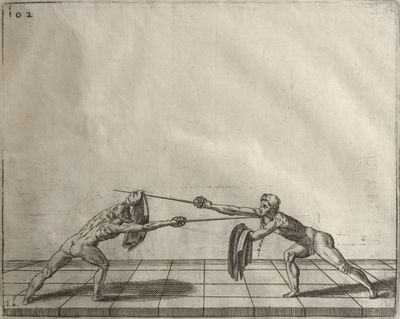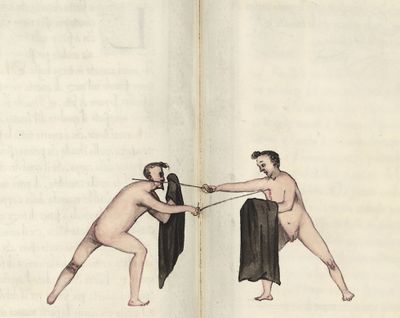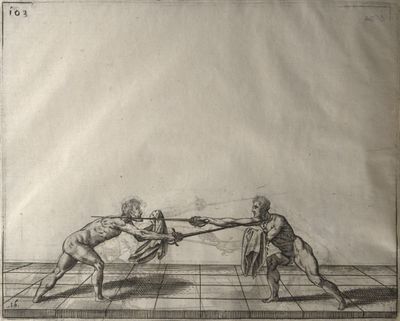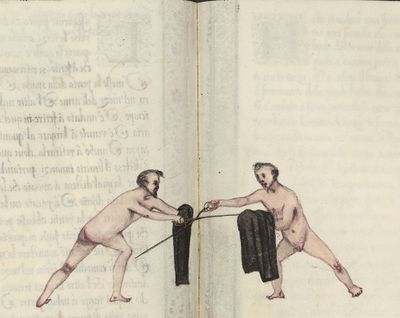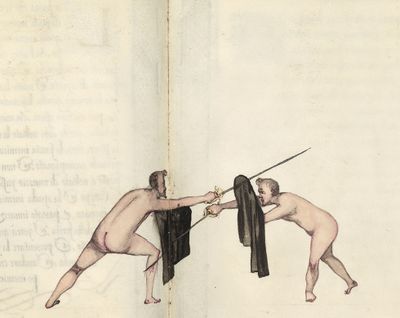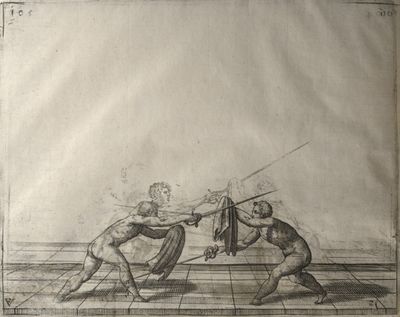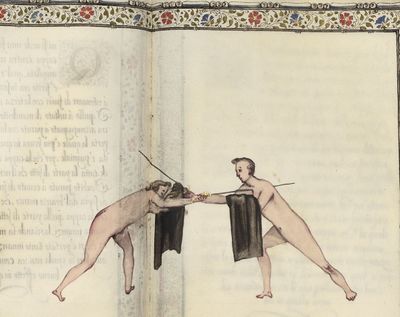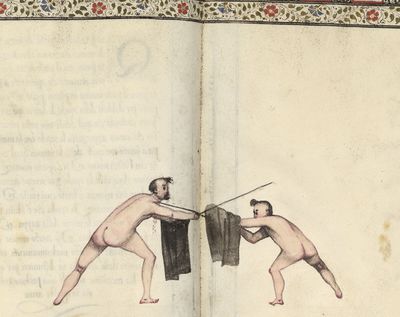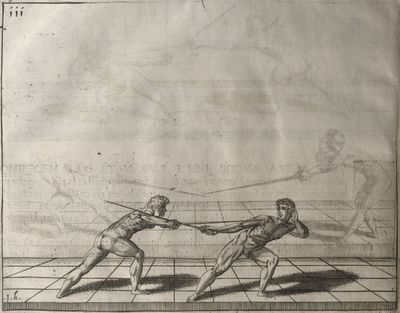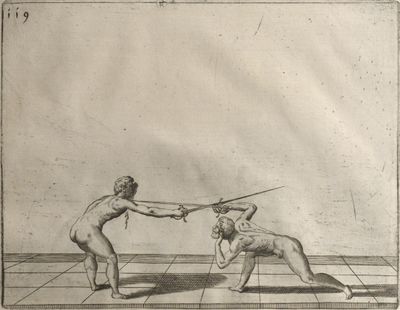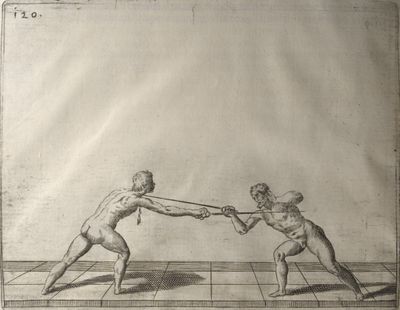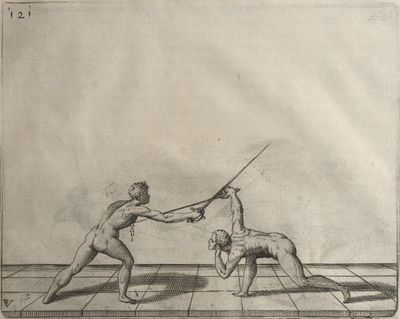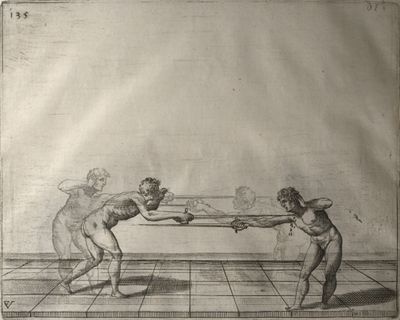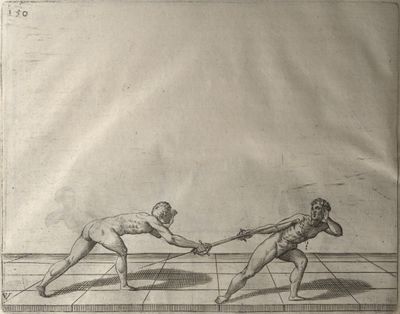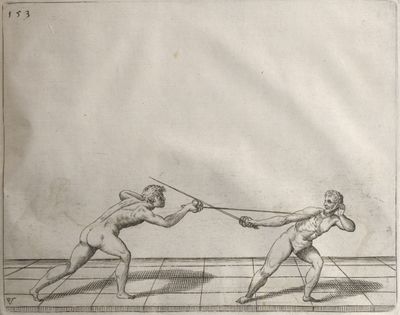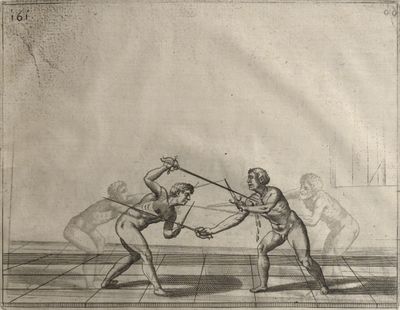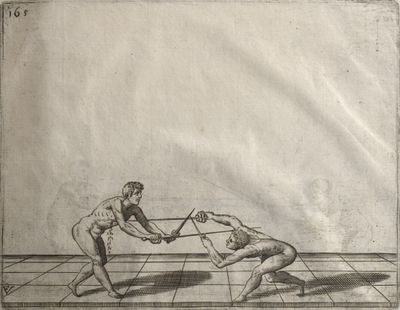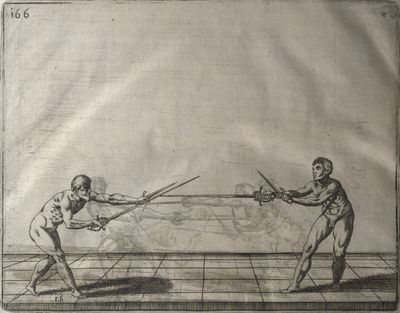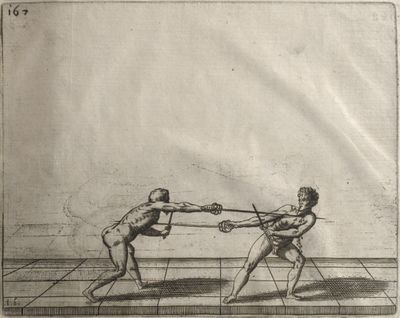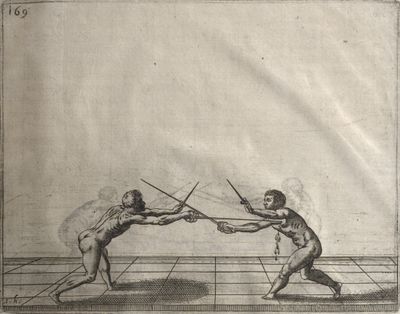|
|
You are not currently logged in. Are you accessing the unsecure (http) portal? Click here to switch to the secure portal. |
Difference between revisions of "Salvator Fabris"
| (51 intermediate revisions by 3 users not shown) | |||
| Line 31: | Line 31: | ||
| subject = | | subject = | ||
| movement = | | movement = | ||
| − | | notableworks = ''[[Scienza | + | | notableworks = ''[[Scienza d'Arme (Salvator Fabris)|Scienza d'Arme]]'' (1601-06) |
| manuscript(s) = {{collapsible list | | manuscript(s) = {{collapsible list | ||
| [[Scientia e Prattica dell'Arme (GI.kgl.Saml.1868.4040)|GI.kgl.Saml.1868.4040]] (1601) | | [[Scientia e Prattica dell'Arme (GI.kgl.Saml.1868.4040)|GI.kgl.Saml.1868.4040]] (1601) | ||
| Line 62: | Line 62: | ||
| below = | | below = | ||
}} | }} | ||
| − | '''Salvator Fabris''' (Salvador Fabbri, Salvator Fabriz, Fabrice; 1544-1618) was a 16th – [[century::17th century]] [[nationality::Italian]] knight and [[fencing master]]. He was born in or around Padua, Italy in 1544, and although little is known about his early years, he seems to have studied fencing from a young age and possibly attended the prestigious University of Padua.{{cn}} The French master [[Henry de Sainct Didier]] recounts a meeting with an Italian fencer named "Fabrice" during the course of preparing his treatise (completed in 1573) in which they debated fencing theory, potentially placing Fabris in France in the early 1570s | + | '''Salvator Fabris''' (Salvador Fabbri, Salvator Fabriz, Fabrice; 1544-1618) was a 16th – [[century::17th century]] [[nationality::Italian]] knight and [[fencing master]]. He was born in or around Padua, Italy in 1544, and although little is known about his early years, he seems to have studied fencing from a young age and possibly attended the prestigious University of Padua.{{cn}} The French master [[Henry de Sainct Didier]] recounts a meeting with an Italian fencer named "Fabrice" during the course of preparing his treatise (completed in 1573) in which they debated fencing theory, potentially placing Fabris in France in the early 1570s<ref>[[Henry de Sainct Didier|Didier, Henry de Sainct]]. ''[[Les secrets du premier livre sur l'espée seule (Henry de Sainct Didier)|Les secrets du premier livre sur l'espée seule]]''. Paris, 1573. pp 5-8.</ref>, although that piece of evidence is [https://blog.subcaelo.net/ensis/sainct-didier-fabris/ particularly slim]. In the 1580s, Fabris corresponded with Christian Barnekow, a Danish nobleman with ties to the royal court as well as an alumnus of the university.<ref name="Leoni">[[Salvator Fabris|Fabris, Salvator]] and Leoni, Tom. ''Art of Dueling: Salvator Fabris' Rapier Fencing Treatise of 1606''. Highland Village, TX: [[Chivalry Bookshelf]], 2005. pp XVIII-XIX.</ref> It seems likely that Fabris traveled a great deal during the 1570s and 80s, spending time in France, Germany, Spain, and possibly other regions before returning to teach at his alma mater.{{cn}} |
It is unclear if Fabris himself was of noble birth, but at some point he seems to have earned a knighthood. In fact, he is described in his treatise as ''Supremus Eques'' ("Supreme Knight") of the Order of the Seven Hearts. In Johann Joachim Hynitzsch's introduction to the 1676 edition, he identifies Fabris as a Colonel of the Order.<ref>[[Salvator Fabris|Fabris, Salvator]] and Leoni, Tom. ''Art of Dueling: Salvator Fabris' Rapier Fencing Treatise of 1606''. Highland Village, TX: [[Chivalry Bookshelf]], 2005. p XXIX.</ref> It seems therefore that he was not only a knight of the Order of the Seven Hearts, but rose to a high rank and perhaps even overall leadership. | It is unclear if Fabris himself was of noble birth, but at some point he seems to have earned a knighthood. In fact, he is described in his treatise as ''Supremus Eques'' ("Supreme Knight") of the Order of the Seven Hearts. In Johann Joachim Hynitzsch's introduction to the 1676 edition, he identifies Fabris as a Colonel of the Order.<ref>[[Salvator Fabris|Fabris, Salvator]] and Leoni, Tom. ''Art of Dueling: Salvator Fabris' Rapier Fencing Treatise of 1606''. Highland Village, TX: [[Chivalry Bookshelf]], 2005. p XXIX.</ref> It seems therefore that he was not only a knight of the Order of the Seven Hearts, but rose to a high rank and perhaps even overall leadership. | ||
| Line 70: | Line 70: | ||
What is certain is that by 1598, Fabris had left his position at the University of Padua and was attached to the court of Johan Frederik, the young duke of Schleswig-Holstein-Gottorp. He continued in the duke's service until 1601, and as a parting gift prepared a lavishly-illustrated, three-volume manuscript of his treatise entitled ''Scientia e Prattica dell'Arme'' ([[Scientia e Prattica dell'Arme (GI.kgl.Saml.1868.4040)|GI.kgl.Saml.1868 4040]]).<ref name="Leoni"/> | What is certain is that by 1598, Fabris had left his position at the University of Padua and was attached to the court of Johan Frederik, the young duke of Schleswig-Holstein-Gottorp. He continued in the duke's service until 1601, and as a parting gift prepared a lavishly-illustrated, three-volume manuscript of his treatise entitled ''Scientia e Prattica dell'Arme'' ([[Scientia e Prattica dell'Arme (GI.kgl.Saml.1868.4040)|GI.kgl.Saml.1868 4040]]).<ref name="Leoni"/> | ||
| − | In 1601, Fabris was hired as chief [[rapier]] instructor to the court of Christianus Ⅳ, King of Denmark and Duke Johan Frederik's cousin. He ultimately served in the royal court for five years; toward the end of his tenure and at the king's insistence, he published his opus under the title '' | + | In 1601, Fabris was hired as chief [[rapier]] instructor to the court of Christianus Ⅳ, King of Denmark and Duke Johan Frederik's cousin. He ultimately served in the royal court for five years; toward the end of his tenure and at the king's insistence, he published his opus under the title ''De lo Schermo, overo Scienza d'Arme'' ("On Defense, or the Science of Arms") or ''Sienza e Pratica d’Arme'' ("Science and Practice of Arms"). Christianus funded this first edition and placed his court artist, [[Jan van Halbeeck]], at Fabris' disposal to illustrate it; it was ultimately published in Copenhagen on 25 September 1606.<ref name="Leoni"/> |
| − | Soon after the text was published, and perhaps feeling his 62 years, Fabris asked to be released from his six-year contract with the king so that he might return home. | + | Soon after the text was published, and perhaps feeling his 62 years, Fabris asked to be released from his six-year contract with the king so that he might return home.{{cn}} In 1608 Fabris was in Paris, France, where [[Joachim Köppe]] recounts meeting him in 1609.<ref>Troyes,Claude I de. https://www.siv.archives-nationales.culture.gouv.fr/siv/UD/FRAN_IR_043571/c1p74y7y7sfv--1o1nfgiiyd2pc [[Minutes et répertoires du notaire Claude I de TROYES, janvier 1603 - décembre 1612 (étude CXXII)]] 20th September, 1608 MC/ET/CXXII/1565, fol. IIII/XX/XI Retrieved 2025-07-28.</ref><ref>[[Joachim Köppe|Joachim Köppe]]. ''[[Newer Discůrs Von der Rittermeszigen und Weitberůmbten Kůnst des Fechtens (Joachim Köppe)|Newer Discůrs Von der Rittermeszigen und Weitberůmbten Kůnst des Fechtens]]''. Magdeburg, 1619. pp. 21-2 Antwort.</ref> Ultimately, he received a position at the University of Padua and there passed his final years. He died of a fever on 11 November 1618 at the age of 74, and the town of Padua declared an official day of mourning in his honor. In 1676, the town of Padua erected a statue of the master in the Chiesa del Santo.{{cn}} |
The importance of Fabris' work can hardly be overstated. Versions of his treatise were reprinted for over a hundred years, and translated into German at least four times as well as French and Latin. He is almost universally praised by later masters and fencing historians, and through the influence of his students and their students (most notably [[Hans Wilhelm Schöffer]]), he became the dominant figure in German fencing throughout the 17th century and into the 18th. | The importance of Fabris' work can hardly be overstated. Versions of his treatise were reprinted for over a hundred years, and translated into German at least four times as well as French and Latin. He is almost universally praised by later masters and fencing historians, and through the influence of his students and their students (most notably [[Hans Wilhelm Schöffer]]), he became the dominant figure in German fencing throughout the 17th century and into the 18th. | ||
| Line 88: | Line 88: | ||
! class="double" | <p>{{rating|C|Draft Translation (from the archetype)}} (ca. 1900)<br/>by [[translator::A. F. Johnson]] (transcribed by [[Michael Chidester]])</p> | ! class="double" | <p>{{rating|C|Draft Translation (from the archetype)}} (ca. 1900)<br/>by [[translator::A. F. Johnson]] (transcribed by [[Michael Chidester]])</p> | ||
! class="double" | <p>[[Scientia e Prattica dell'Arme (GI.kgl.Saml.1868.4040)|Prototype]] (1601)<br/></p> | ! class="double" | <p>[[Scientia e Prattica dell'Arme (GI.kgl.Saml.1868.4040)|Prototype]] (1601)<br/></p> | ||
| − | ! class="double" | <p>[[Scienza | + | ! class="double" | <p>[[Scienza d'Arme (Salvator Fabris)|Archetype]] (1606){{edit index|Scienza d'Arme (Salvator Fabris) 1606.pdf}}<br/>Transcribed by [[Michael Chidester]]</p> |
| − | ! class="double" | <p>German Translation (1677){{edit index|Sienza e pratica | + | ! class="double" | <p>German Translation (1677){{edit index|Sienza e pratica d'arme (Johann Joachim Hynitzsch) 1677.pdf}}<br/>Transcribed by [[Michael Chidester]]</p> |
|- | |- | ||
| Line 95: | Line 95: | ||
| [[File:Scienza d’Arme (Fabris) Title 1.png|400px|center]] | | [[File:Scienza d’Arme (Fabris) Title 1.png|400px|center]] | ||
| <p>[1] '''Fencing''', or '''the Science of Arms''' by Salvator Fabris.</p> | | <p>[1] '''Fencing''', or '''the Science of Arms''' by Salvator Fabris.</p> | ||
| − | | | + | | {{paget|Page:GI.kgl.Saml.1868.4040|1r|jpg}} |
| − | | {{pagetb|Page:Scienza | + | | {{pagetb|Page:Scienza d'Arme (Salvator Fabris) 1606.pdf|3|lbl=I}} |
| − | | {{pagetb|Page:Sienza e pratica | + | | {{pagetb|Page:Sienza e pratica d'arme (Johann Joachim Hynitzsch) 1677.pdf|6|lbl=I}} |
|- | |- | ||
| Line 104: | Line 104: | ||
| <p>[2] </p> | | <p>[2] </p> | ||
| | | | ||
| − | | {{pagetb|Page:Scienza | + | | |
| + | {{pagetb|Page:Scienza d'Arme (Salvator Fabris) 1606.pdf|1|lbl=*|p=1}}<ref>This second title page is an interesting anomaly. It was not printed as part of the main book the way the other title page was, and is instead printed on a single sheet that was glued into the binding. Of 24 copies surveyed by Michael Chidester, 14 had only the first title page, 3 had only the second title page, 16 had both title pages, and 1 had neither (instead, a second copy of page 151 was glued into the beginning of the book to serve as a title page). It's unclear what these anomalies indicate about the process of printing the book.</ref> | ||
| | | | ||
| Line 112: | Line 113: | ||
| <p>[3] </p> | | <p>[3] </p> | ||
| | | | ||
| − | | {{pagetb|Page:Scienza | + | | {{pagetb|Page:Scienza d'Arme (Salvator Fabris) 1606.pdf|5|lbl=V}} |
| | | | ||
| Line 118: | Line 119: | ||
| | | | ||
| [[File:Scienza d’Arme (Fabris) Heraldry.jpg|400px|center]] | | [[File:Scienza d’Arme (Fabris) Heraldry.jpg|400px|center]] | ||
| − | | <p>[4] To His Serene Majesty, the most Powerful Christian IV., King of Denmark, Norway, Gothland and Vandalia, Duke of Schleswig Holstein, Stormarn and Ditmarsch, Count of Oldenburg and Delmenhorst, &c. | + | | <p>[4] To His Serene Majesty, the most Powerful Christian IV., King of Denmark, Norway, Gothland and Vandalia, Duke of Schleswig Holstein, Stormarn and Ditmarsch, Count of Oldenburg and Delmenhorst, &c.</p> |
| − | <p>I am confident that all who read this work of mine will recognise that the many benefits received from your Serene Highness are the cause, which has urged and impelled me to publish to the world these my labours. I have wished also to help professors of the science of arms by showing them those instructions and rules, which after long use and continual practice and from observing the errors of others I have found to be good. I hope then that a work based on such principles will find merit, especially as it is under the protection of your Serene Highness - a work as worthy by reason of the excellence of its subject as it is glorious through the approval of your high judgment. To you, therefore, my benefactor, my king and a prince of incomparable valour as much in civil government as in the practice of arms, a true hero of our times, I have dared to dedicate my work; for since its inception is due to you, I am bringing it forth to the sight of men under the same protection. I know moreover how useful to the world and necessary to good men this art is, bringing honour to anyone who practises it aright either in the defence of his prince, his country, the laws, his life or his honour. Will your Serene Majesty therefore deign to receive into your favour not only the work, but the devotion with which, your humble and obedient servant, dedicate it. Meantime I will pray the Divine grace that long life may be granted you for the well-being of your blessed subjects and the good of the world, and that by grace you may obtain salvation in the world to come. | + | <p>I am confident that all who read this work of mine will recognise that the many benefits received from your Serene Highness are the cause, which has urged and impelled me to publish to the world these my labours. I have wished also to help professors of the science of arms by showing them those instructions and rules, which after long use and continual practice and from observing the errors of others I have found to be good. I hope then that a work based on such principles will find merit, especially as it is under the protection of your Serene Highness - a work as worthy by reason of the excellence of its subject as it is glorious through the approval of your high judgment. To you, therefore, my benefactor, my king and a prince of incomparable valour as much in civil government as in the practice of arms, a true hero of our times, I have dared to dedicate my work; for since its inception is due to you, I am bringing it forth to the sight of men under the same protection. I know moreover how useful to the world and necessary to good men this art is, bringing honour to anyone who practises it aright either in the defence of his prince, his country, the laws, his life or his honour. Will your Serene Majesty therefore deign to receive into your favour not only the work, but the devotion with which, your humble and obedient servant, dedicate it. Meantime I will pray the Divine grace that long life may be granted you for the well-being of your blessed subjects and the good of the world, and that by grace you may obtain salvation in the world to come.</p> |
<p>Your Serene Majesty's</p> | <p>Your Serene Majesty's</p> | ||
| Line 128: | Line 129: | ||
<p>'''Salvatore Fabris'''</p> | <p>'''Salvatore Fabris'''</p> | ||
| | | | ||
| − | | {{pagetb|Page:Scienza | + | | {{pagetb|Page:Scienza d'Arme (Salvator Fabris) 1606.pdf|7|lbl=VII}} |
| | | | ||
| Line 138: | Line 139: | ||
<p>Marvel not, Reader, if you see a man of the sword, unaccustomed to the schools or the circles of literary men, presuming to write and print books; rather rejoice at seeing the science of arms and the knowledge of the sword reduced to rules and precepts, and like the other arts to a teachable form, wherein the curious and eager men of arms may learn by turning the leaves. More than others should men of arms rejoice, in that men of learning and science have never translated their arts from theory to practice, as now a man of arms has brought his from practice to true theory. To him is owed much greater faith, because he has had a thousand experiences in his own case and in that of others of what he has written. Here then, Reader, is my book on the science of arms, illustrated with plates suitable to each case; to these plates and dumb images, as it were, our words give life; the plates will demonstrate and our words will interpret the effects and principles treated of in the book. We have written in our mother tongue, Italian, dispensing with flowers of rhetoric and elegance of style, not thinking shame to acknowledge our little learning, or, following the example of a very famous captain of our age, to declare that in our youth we could not wield both the sword and the pen. We believe however that we have dealt adequately with what is required in this art and have tried as far as in us lay to avoid obscurity and prolixity, although in so subtle a subject it is difficult to preserve the necessary brevity. We have shunned the use of geometrical terms, although swordsmanship has its foundations more in geometry than in any other science. Simply and as naturally as possible we have tried to bring the art within the capacity of all. For what we have written and demonstrated we require no praise or reward, for it was never our intention to publish it to the world; but if in it there is anything worthy of merit, it should be ascribed to his Serene Majesty our King, through whom we have written this work, and at whose command this book is brought to the light of day. We will not speak of the nobility and excellence of this profession, for it is in itself so glorious and resplendent that it has no need of our words, nor is there any man so ignorant as not to know, that by its[!] kingdoms are defended, religion spread abroad, injustice avenged, peace and the prosperity of nations established. We wish only to say that after acquiring this inestimable knowledge a man should not become puffed up nor use it violently to the detriment of others, but always with moderation and justice in all cases, thinking that the last victory of all rests not in his own hand, but in the just will of God; and may He grant us abundance of his saving grace.</p> | <p>Marvel not, Reader, if you see a man of the sword, unaccustomed to the schools or the circles of literary men, presuming to write and print books; rather rejoice at seeing the science of arms and the knowledge of the sword reduced to rules and precepts, and like the other arts to a teachable form, wherein the curious and eager men of arms may learn by turning the leaves. More than others should men of arms rejoice, in that men of learning and science have never translated their arts from theory to practice, as now a man of arms has brought his from practice to true theory. To him is owed much greater faith, because he has had a thousand experiences in his own case and in that of others of what he has written. Here then, Reader, is my book on the science of arms, illustrated with plates suitable to each case; to these plates and dumb images, as it were, our words give life; the plates will demonstrate and our words will interpret the effects and principles treated of in the book. We have written in our mother tongue, Italian, dispensing with flowers of rhetoric and elegance of style, not thinking shame to acknowledge our little learning, or, following the example of a very famous captain of our age, to declare that in our youth we could not wield both the sword and the pen. We believe however that we have dealt adequately with what is required in this art and have tried as far as in us lay to avoid obscurity and prolixity, although in so subtle a subject it is difficult to preserve the necessary brevity. We have shunned the use of geometrical terms, although swordsmanship has its foundations more in geometry than in any other science. Simply and as naturally as possible we have tried to bring the art within the capacity of all. For what we have written and demonstrated we require no praise or reward, for it was never our intention to publish it to the world; but if in it there is anything worthy of merit, it should be ascribed to his Serene Majesty our King, through whom we have written this work, and at whose command this book is brought to the light of day. We will not speak of the nobility and excellence of this profession, for it is in itself so glorious and resplendent that it has no need of our words, nor is there any man so ignorant as not to know, that by its[!] kingdoms are defended, religion spread abroad, injustice avenged, peace and the prosperity of nations established. We wish only to say that after acquiring this inestimable knowledge a man should not become puffed up nor use it violently to the detriment of others, but always with moderation and justice in all cases, thinking that the last victory of all rests not in his own hand, but in the just will of God; and may He grant us abundance of his saving grace.</p> | ||
| | | | ||
| − | | {{pagetb|Page:Scienza | + | | {{pagetb|Page:Scienza d'Arme (Salvator Fabris) 1606.pdf|8|lbl=VIII}} |
| | | | ||
| Line 158: | Line 159: | ||
! class="double" | <p>{{rating|C|Draft Translation (from the archetype)}} (ca. 1900)<br/>by [[translator::A. F. Johnson]] (transcribed by [[Michael Chidester]])</p> | ! class="double" | <p>{{rating|C|Draft Translation (from the archetype)}} (ca. 1900)<br/>by [[translator::A. F. Johnson]] (transcribed by [[Michael Chidester]])</p> | ||
! class="double" | <p>[[Scientia e Prattica dell'Arme (GI.kgl.Saml.1868.4040)|Prototype]] (1601)<br/></p> | ! class="double" | <p>[[Scientia e Prattica dell'Arme (GI.kgl.Saml.1868.4040)|Prototype]] (1601)<br/></p> | ||
| − | ! class="double" | <p>[[Scienza | + | ! class="double" | <p>[[Scienza d'Arme (Salvator Fabris)|Archetype]] (1606){{edit index|Scienza d'Arme (Salvator Fabris) 1606.pdf}}<br/>Transcribed by [[Michael Chidester]]</p> |
| − | ! class="double" | <p>German Translation (1677){{edit index|Sienza e pratica | + | ! class="double" | <p>German Translation (1677){{edit index|Sienza e pratica d'arme (Johann Joachim Hynitzsch) 1677.pdf}}<br/>Transcribed by [[Alex Kiermayer]]</p> |
|- | |- | ||
| Line 168: | Line 169: | ||
<p>In opening our promised work we shall begin with the sword alone, for on the knowledge of the sword depend the principles of all other arms. Many rules will be given which may serve excellently for the sword accompanied by the dagger or any other arm. He who can use the sword alone well will easily learn to use it in conjunction with other arms. You must know then that the rules of the sword are founded on four guards in which are formed all the positions and counter positions. From them arise the ''times'', ''counter-times'', disengagements, counter-disengagements, double disengagements, half disengagements, and re-engagements; nor in short can anything be done in attack or defence which does not partake of the nature of one of these four guards. They are differently formed, as will be seen in the accompanying plates. These we have introduced in order that you may recognise with what variations of position of the sword, feet and body, they are made. We shall describe the nature of each guard in its place and the plates will show the results which may arise from them. The discourses will be such that you will easily see when to apply the various rules, and how to the best advantage you must approach your adversary in order to come within presence. Though one who understands the art may approach as he pleases, since in whatever position he is he will succeed by his knowledge of distances, weak and strong positions, exposed and unexposed parts. Nevertheless it is certain that one position is better than another, and a man may approach with more security when he parries his arms in the proper manner. When within distance he must proceed in various ways, according to the changes made and the opportunities offered by his adversary, and according to the distance in which he finds himself. The distances are two, and what is good in the one is not so in the other. These distances control the whole attack and defence, as we shall explain. First we shall describe the four principal guards, why they are called, ''prime'', ''seconde'', ''tierce'' and ''quarte'', and the origin of these names. Then we shall treat of the divisions of the sword, then of counterpositions, distances, and some other matters which we consider necessary and useful to the good student of this art.</p> | <p>In opening our promised work we shall begin with the sword alone, for on the knowledge of the sword depend the principles of all other arms. Many rules will be given which may serve excellently for the sword accompanied by the dagger or any other arm. He who can use the sword alone well will easily learn to use it in conjunction with other arms. You must know then that the rules of the sword are founded on four guards in which are formed all the positions and counter positions. From them arise the ''times'', ''counter-times'', disengagements, counter-disengagements, double disengagements, half disengagements, and re-engagements; nor in short can anything be done in attack or defence which does not partake of the nature of one of these four guards. They are differently formed, as will be seen in the accompanying plates. These we have introduced in order that you may recognise with what variations of position of the sword, feet and body, they are made. We shall describe the nature of each guard in its place and the plates will show the results which may arise from them. The discourses will be such that you will easily see when to apply the various rules, and how to the best advantage you must approach your adversary in order to come within presence. Though one who understands the art may approach as he pleases, since in whatever position he is he will succeed by his knowledge of distances, weak and strong positions, exposed and unexposed parts. Nevertheless it is certain that one position is better than another, and a man may approach with more security when he parries his arms in the proper manner. When within distance he must proceed in various ways, according to the changes made and the opportunities offered by his adversary, and according to the distance in which he finds himself. The distances are two, and what is good in the one is not so in the other. These distances control the whole attack and defence, as we shall explain. First we shall describe the four principal guards, why they are called, ''prime'', ''seconde'', ''tierce'' and ''quarte'', and the origin of these names. Then we shall treat of the divisions of the sword, then of counterpositions, distances, and some other matters which we consider necessary and useful to the good student of this art.</p> | ||
| | | | ||
| − | | {{section|Page:Scienza | + | | {{section|Page:Scienza d'Arme (Salvator Fabris) 1606.pdf/9|1|lbl=1}} |
| | | | ||
| Line 179: | Line 180: | ||
| | | | ||
| | | | ||
| − | {{section|Page:Scienza | + | {{section|Page:Scienza d'Arme (Salvator Fabris) 1606.pdf/9|2|lbl=-|p=1}} {{section|Page:Scienza d'Arme (Salvator Fabris) 1606.pdf/10|1|lbl=2|p=1}} |
| | | | ||
| Line 190: | Line 191: | ||
| | | | ||
| | | | ||
| − | {{section|Page:Scienza | + | {{section|Page:Scienza d'Arme (Salvator Fabris) 1606.pdf/10|2|lbl=-|p=1}} {{section|Page:Scienza d'Arme (Salvator Fabris) 1606.pdf/11|1|lbl=3|p=1}} |
| | | | ||
| Line 196: | Line 197: | ||
| | | | ||
| | | | ||
| − | | <p>[4] '''Method of forming the counter-positions,''' showing '''The position of the arms and the body, and when they are to be formed.'''</p> | + | | <p>[4] '''Method of forming the counter-positions,''' showing '''The position of the arms and the body, and when they are to be formed.'''<br/><br/></p> |
<p>If you wish to form a sound counter-position, the position of the body and arms must be such that without touching the adversary's sword you are defended in the straight line from the point of his sword to your body, so that without making any movement of the body or the sword you are sure that your adversary cannot hit you in that line, but that if he wishes to attack he must move his sword elsewhere, with the result that his ''time'' is so long, that there is every opportunity to parry. But in forming this position care must be taken that your sword is held in such a way as to be stronger than your adversary's, so that it may offer resistance in defence. This rule can be observed against all positions and changes of your adversary, whether accompanied by the dagger or any other defensive weapon, or when you use the sword alone. He who can most subtly maintain this guard will have a great advantage over his adversary.</p> | <p>If you wish to form a sound counter-position, the position of the body and arms must be such that without touching the adversary's sword you are defended in the straight line from the point of his sword to your body, so that without making any movement of the body or the sword you are sure that your adversary cannot hit you in that line, but that if he wishes to attack he must move his sword elsewhere, with the result that his ''time'' is so long, that there is every opportunity to parry. But in forming this position care must be taken that your sword is held in such a way as to be stronger than your adversary's, so that it may offer resistance in defence. This rule can be observed against all positions and changes of your adversary, whether accompanied by the dagger or any other defensive weapon, or when you use the sword alone. He who can most subtly maintain this guard will have a great advantage over his adversary.</p> | ||
| Line 202: | Line 203: | ||
<p>But it often happens that when you form this guard, your adversary forms another against it. Often also this guard is formed so far out of distance that your adversary can wait until you begin to move your foot against him, and at the moment of year advance change his line, so that you are disconcerted by another counter-position. Therefore you must be full of devices and be able in a moment to take up another position of advantage against that of your adversary and make a fresh guard, unless you are so far within distance that you can hit him daring this change, and if in changing he has not retired, since if he had retired you could not hit him even if you had been within distance. You must then take up another counter-position and approach at the same time, to regain the same distance as before. In forming this counter-position you must bear in mind the rule, that the body must be so far distant that the adversary cannot hit, or, if you have approached within distance so that he could hit by advancing his foot, you must form the counter-position without moving the feet. In this way, if the adversary should attempt to hit during the movement, you could parry and hit him, or break ground;<ref>This seems like a mistranslation of ''rompere di misura'' at first blush, but according to Kevin Murakoshi, this is an archaic piece of fencing jargon that was still current in the early 20th century. It means to "break measure" or withdraw. ~ Michael Chidester</ref> in the latter case his sword, would not reach. But if in moving your weapons to take up this advantage, you have moved slowly, you could then abandon your object and hit at the very moment in which your adversary advanced to attack, parrying at the same time. So that if the first movement is made without violence, you can abandon your attempt and make another, as opportunity offers. In short, if you wish to get within distance with some safety, you must first form the counter-position, and if disconcerted by your adversary's counter-position, it will be better to break ground than to approach, until there is an opportunity to get an advantage.</p> | <p>But it often happens that when you form this guard, your adversary forms another against it. Often also this guard is formed so far out of distance that your adversary can wait until you begin to move your foot against him, and at the moment of year advance change his line, so that you are disconcerted by another counter-position. Therefore you must be full of devices and be able in a moment to take up another position of advantage against that of your adversary and make a fresh guard, unless you are so far within distance that you can hit him daring this change, and if in changing he has not retired, since if he had retired you could not hit him even if you had been within distance. You must then take up another counter-position and approach at the same time, to regain the same distance as before. In forming this counter-position you must bear in mind the rule, that the body must be so far distant that the adversary cannot hit, or, if you have approached within distance so that he could hit by advancing his foot, you must form the counter-position without moving the feet. In this way, if the adversary should attempt to hit during the movement, you could parry and hit him, or break ground;<ref>This seems like a mistranslation of ''rompere di misura'' at first blush, but according to Kevin Murakoshi, this is an archaic piece of fencing jargon that was still current in the early 20th century. It means to "break measure" or withdraw. ~ Michael Chidester</ref> in the latter case his sword, would not reach. But if in moving your weapons to take up this advantage, you have moved slowly, you could then abandon your object and hit at the very moment in which your adversary advanced to attack, parrying at the same time. So that if the first movement is made without violence, you can abandon your attempt and make another, as opportunity offers. In short, if you wish to get within distance with some safety, you must first form the counter-position, and if disconcerted by your adversary's counter-position, it will be better to break ground than to approach, until there is an opportunity to get an advantage.</p> | ||
| | | | ||
| − | | {{section|Page:Scienza | + | | {{section|Page:Scienza d'Arme (Salvator Fabris) 1606.pdf/11|2|lbl=-}} |
| | | | ||
| Line 208: | Line 209: | ||
| | | | ||
| | | | ||
| − | | <p>[5] '''Explanation of the two distances, wide and close, and how to acquire the one or the other with least danger.'''</p> | + | | <p>[5] '''Explanation of the two distances, wide and close, and how to acquire the one or the other with least danger.'''<br/><br/></p> |
<p>You are within wide distance when by advancing the rear foot to the front you can make a hit. After forming the counter-position a little out of distance, you must begin to advance the foot in order to get within the required distance. But you must be on your guard, lest your adversary, being steady, at the moment when you move your foot to advance it, should advance his too and hit at the same time. Therefore, you must move it very carefully, remembering that your adversary may effect something during the movement. After forming the counter-position you must endeavour to throw him into disorder, or at least make some feint in order to have an opportunity to hit. Thus prepared for what may happen you are more guarded and can better resist attack. When you are within wide distance and your adversary makes some movement of his foot, provided he does not break ground, you can hit him in the nearest exposed part, even if he has not moved his weapons. This could not be done if he moved his weapons and stood firm on his feet, the reason being that a movement of the foot is slower than that of the weapons, and therefore he could parry before your sword arrived, while he remained steady; if there were no other way he could protect himself by breaking ground, so that your sword could not reach. Being thrown into disorder you would then be in danger of being hit before you had recovered. Therefore whenever he gives an opportunity without moving his feet, it would be better to approach within close distance in that time. In that distance you can reach with the sword by merely bending the body, without moving the feet, and the adversary is forced to retire to get out of such danger. If he does not move you could hit him even though he retained the advantage of the counter-position. If your adversary does not move, you can sometimes make a hit by judging the distance from the point of your sword to your adversary's body and the distance from the ''forte'' of his sword. If you consider both how much you must advance the point and how far you must move it from the adversary's ''forte'', and understand that the time required for him to parry is the same as for you to hit, the sword will arrive before he has parried by the advantage of having moved first. If you see that his body is little exposed, as may happen, since one guard covers more than another, you can then attempt to hit in the exposed part, and as he moves to the defence change your line and hit in the second exposed part.</p> | <p>You are within wide distance when by advancing the rear foot to the front you can make a hit. After forming the counter-position a little out of distance, you must begin to advance the foot in order to get within the required distance. But you must be on your guard, lest your adversary, being steady, at the moment when you move your foot to advance it, should advance his too and hit at the same time. Therefore, you must move it very carefully, remembering that your adversary may effect something during the movement. After forming the counter-position you must endeavour to throw him into disorder, or at least make some feint in order to have an opportunity to hit. Thus prepared for what may happen you are more guarded and can better resist attack. When you are within wide distance and your adversary makes some movement of his foot, provided he does not break ground, you can hit him in the nearest exposed part, even if he has not moved his weapons. This could not be done if he moved his weapons and stood firm on his feet, the reason being that a movement of the foot is slower than that of the weapons, and therefore he could parry before your sword arrived, while he remained steady; if there were no other way he could protect himself by breaking ground, so that your sword could not reach. Being thrown into disorder you would then be in danger of being hit before you had recovered. Therefore whenever he gives an opportunity without moving his feet, it would be better to approach within close distance in that time. In that distance you can reach with the sword by merely bending the body, without moving the feet, and the adversary is forced to retire to get out of such danger. If he does not move you could hit him even though he retained the advantage of the counter-position. If your adversary does not move, you can sometimes make a hit by judging the distance from the point of your sword to your adversary's body and the distance from the ''forte'' of his sword. If you consider both how much you must advance the point and how far you must move it from the adversary's ''forte'', and understand that the time required for him to parry is the same as for you to hit, the sword will arrive before he has parried by the advantage of having moved first. If you see that his body is little exposed, as may happen, since one guard covers more than another, you can then attempt to hit in the exposed part, and as he moves to the defence change your line and hit in the second exposed part.</p> | ||
| Line 217: | Line 218: | ||
| | | | ||
| | | | ||
| − | {{pagetb|Page:Scienza | + | {{pagetb|Page:Scienza d'Arme (Salvator Fabris) 1606.pdf|12|lbl=4|p=1}} {{section|Page:Scienza d'Arme (Salvator Fabris) 1606.pdf/13|1|lbl=5|p=1}} |
| | | | ||
| Line 230: | Line 231: | ||
| | | | ||
| | | | ||
| − | {{section|Page:Scienza | + | {{section|Page:Scienza d'Arme (Salvator Fabris) 1606.pdf/13|2|lbl=-|p=1}} {{pagetb|Page:Scienza d'Arme (Salvator Fabris) 1606.pdf|14|lbl=6|p=1}} {{section|Page:Scienza d'Arme (Salvator Fabris) 1606.pdf/15|1|lbl=7|p=1}} |
| | | | ||
| Line 245: | Line 246: | ||
| | | | ||
| | | | ||
| − | {{section|Page:Scienza | + | {{section|Page:Scienza d'Arme (Salvator Fabris) 1606.pdf/15|2|lbl=-|p=1}} {{pagetb|Page:Scienza d'Arme (Salvator Fabris) 1606.pdf|16|lbl=8|p=1}} {{section|Page:Scienza d'Arme (Salvator Fabris) 1606.pdf/17|1|lbl=9|p=1}} |
| | | | ||
| Line 264: | Line 265: | ||
| | | | ||
| | | | ||
| − | {{section|Page:Scienza | + | {{section|Page:Scienza d'Arme (Salvator Fabris) 1606.pdf/17|2|lbl=-|p=1}} {{pagetb|Page:Scienza d'Arme (Salvator Fabris) 1606.pdf|18|lbl=10|p=1}} {{section|Page:Scienza d'Arme (Salvator Fabris) 1606.pdf/19|1|lbl=11|p=1}} |
| | | | ||
| Line 277: | Line 278: | ||
| | | | ||
| | | | ||
| − | {{section|Page:Scienza | + | {{section|Page:Scienza d'Arme (Salvator Fabris) 1606.pdf/19|2|lbl=-|p=1}} {{pagetb|Page:Scienza d'Arme (Salvator Fabris) 1606.pdf|20|lbl=12|p=1}} {{section|Page:Scienza d'Arme (Salvator Fabris) 1606.pdf/21|1|lbl=13|p=1}} |
| | | | ||
| Line 294: | Line 295: | ||
| | | | ||
| | | | ||
| − | {{section|Page:Scienza | + | {{section|Page:Scienza d'Arme (Salvator Fabris) 1606.pdf/21|2|lbl=-|p=1}} {{pagetb|Page:Scienza d'Arme (Salvator Fabris) 1606.pdf|22|lbl=14|p=1}} |
| | | | ||
| Line 304: | Line 305: | ||
<p>When your adversary attempts to engage your sword or to beat it, and you change from one line to another, before he can beat or engage, you are said to make a disengagement in ''time''. If, while your adversary is disengaging, you follow his movement, which he has begun in order to get the superiority, and let your sword go after his, so that you engage him in the same line as before, that is called a counter-disengagement. If you have disengaged and your adversary has also disengaged and you then deceive his engagement, that is a double disengagement. If, without completing the change from one line to another, you leave your sword under the adversary's, you make a half disengagement. If you disengage and, when your adversary moves to engage or to make a hit, you engage again where you were before, you are said to re-engage - - -. To make a successful disengagement you must bend forward — so that, when the disengagement is completed, the lunge is completed, if you wish to hit, otherwise you will not be in time. If you follow this principle, your adversary will not be able to parry, if you have taken the ''time'', though he may counter-disengage, if that was his intention in seeking to engage. If he had meant simply to get the superiority or to beat he would certainly be hit. If in seeking to engage your sword, the adversary remains steady, then you must disengage in order to free your sword. This gives him an opportunity for a counter-disengagement, for he has moved at the same time as you disengaged. Then to protect yourself you must make a double disengagement and thrust in the same ''time'', in which he has meant to hit you with a counter-disengagement. Some remain steady in seeking to engage in order to make the adversary disengage and so hit him in the straight line, before he has completed the disengagement. In such a case if the adversary, who has begun to disengage, returns to the same line as before, carrying his ''forte'' to your ''faible'' and thrusting on to the body, he will save himself and certainly hit at the moment you meant to hit. The half disengagement is used when you are in doubt that the adversary may pass to your body, before you have completed,[!] the disengagement, since your point would be out of presence and could not hit. Therefore you make a half disengagement to save time, and remain below the adversary's sword in order to hit, removing your body out of presence, as we shall explain in its place. Such a half disengagement is not always used in the first passes, but more often in the second and third movements, as the distance is shortened. The effects produced by these disengagements will be seen in the plates.</p> | <p>When your adversary attempts to engage your sword or to beat it, and you change from one line to another, before he can beat or engage, you are said to make a disengagement in ''time''. If, while your adversary is disengaging, you follow his movement, which he has begun in order to get the superiority, and let your sword go after his, so that you engage him in the same line as before, that is called a counter-disengagement. If you have disengaged and your adversary has also disengaged and you then deceive his engagement, that is a double disengagement. If, without completing the change from one line to another, you leave your sword under the adversary's, you make a half disengagement. If you disengage and, when your adversary moves to engage or to make a hit, you engage again where you were before, you are said to re-engage - - -. To make a successful disengagement you must bend forward — so that, when the disengagement is completed, the lunge is completed, if you wish to hit, otherwise you will not be in time. If you follow this principle, your adversary will not be able to parry, if you have taken the ''time'', though he may counter-disengage, if that was his intention in seeking to engage. If he had meant simply to get the superiority or to beat he would certainly be hit. If in seeking to engage your sword, the adversary remains steady, then you must disengage in order to free your sword. This gives him an opportunity for a counter-disengagement, for he has moved at the same time as you disengaged. Then to protect yourself you must make a double disengagement and thrust in the same ''time'', in which he has meant to hit you with a counter-disengagement. Some remain steady in seeking to engage in order to make the adversary disengage and so hit him in the straight line, before he has completed the disengagement. In such a case if the adversary, who has begun to disengage, returns to the same line as before, carrying his ''forte'' to your ''faible'' and thrusting on to the body, he will save himself and certainly hit at the moment you meant to hit. The half disengagement is used when you are in doubt that the adversary may pass to your body, before you have completed,[!] the disengagement, since your point would be out of presence and could not hit. Therefore you make a half disengagement to save time, and remain below the adversary's sword in order to hit, removing your body out of presence, as we shall explain in its place. Such a half disengagement is not always used in the first passes, but more often in the second and third movements, as the distance is shortened. The effects produced by these disengagements will be seen in the plates.</p> | ||
| | | | ||
| − | | {{pagetb|Page:Scienza | + | | {{pagetb|Page:Scienza d'Arme (Salvator Fabris) 1606.pdf|23|lbl=15}} |
| | | | ||
| Line 327: | Line 328: | ||
| | | | ||
| | | | ||
| − | {{pagetb|Page:Scienza | + | {{pagetb|Page:Scienza d'Arme (Salvator Fabris) 1606.pdf|24|lbl=16|p=1}} {{section|Page:Scienza d'Arme (Salvator Fabris) 1606.pdf/25|1|lbl=17|p=1}} |
| | | | ||
| Line 350: | Line 351: | ||
| | | | ||
| | | | ||
| − | {{section|Page:Scienza | + | {{section|Page:Scienza d'Arme (Salvator Fabris) 1606.pdf/25|2|lbl=-|p=1}} {{pagetb|Page:Scienza d'Arme (Salvator Fabris) 1606.pdf|26|lbl=18|p=1}} {{pagetb|Page:Scienza d'Arme (Salvator Fabris) 1606.pdf|27|lbl=19|p=1}} |
| | | | ||
| Line 367: | Line 368: | ||
| | | | ||
| | | | ||
| − | {{pagetb|Page:Scienza | + | {{pagetb|Page:Scienza d'Arme (Salvator Fabris) 1606.pdf|28|lbl=20|p=1}} {{pagetb|Page:Scienza d'Arme (Salvator Fabris) 1606.pdf|29|lbl=21|p=1}} {{section|Page:Scienza d'Arme (Salvator Fabris) 1606.pdf/30|1|lbl=22|p=1}} |
| | | | ||
| Line 384: | Line 385: | ||
| | | | ||
| | | | ||
| − | {{section|Page:Scienza | + | {{section|Page:Scienza d'Arme (Salvator Fabris) 1606.pdf/30|2|lbl=-|p=1}} {{section|Page:Scienza d'Arme (Salvator Fabris) 1606.pdf/31|1|lbl=23|p=1}} |
| | | | ||
| Line 405: | Line 406: | ||
| | | | ||
| | | | ||
| − | {{section|Page:Scienza | + | {{section|Page:Scienza d'Arme (Salvator Fabris) 1606.pdf/31|2|lbl=-|p=1}} {{pagetb|Page:Scienza d'Arme (Salvator Fabris) 1606.pdf|32|lbl=24|p=1}} {{section|Page:Scienza d'Arme (Salvator Fabris) 1606.pdf/33|1|lbl=25|p=1}} |
| | | | ||
| Line 412: | Line 413: | ||
| | | | ||
| <p>[17] '''General discourse on the guards.'''</p> | | <p>[17] '''General discourse on the guards.'''</p> | ||
| + | |||
| + | <p><br/></p> | ||
<p>We have now reached the point when we must treat of the formation of the principal guards, and movements and the results obtained in arms. We must first warn the reader not to wonder if he sees two figures illustrating one result. This is done to represent the right and the left side of the body. On the other hand we have thought it unimportant and idle to treat of many other guards of which some authors have written; for instance a guard with the dagger extended and the sword thrown behind, now on one foot and now on the other, now high, now low, which seems to us to defend the rear rather than the front. Others with the sword alone have kept it so far back and low, that the point was near the point of their feet, and also they held the sword across the legs and with the point almost on the ground, and all this that the sword might not be engaged. Sometimes on guard they take the blade in the left hand to give it strength, in order to beat the adversary's sword and hit. All these things we have omitted as inappropriate and, more often harmful than useful, and in any case tedious to the reader. Perhaps it had been better to have passed them in silence, but some might have thought we had not seen or considered such things; - therefore we have made some mention of them, as of the practice of throwing the sword at the adversary, when fighting with the sword alone; some think this an essential movement, but we deem it of little value; it may succeed against those who leave the sword free or hold their own too stiff, but against those who engage their adversary's sword and can disengage, it effects nothing, rather he who adopts this method will always be beaten. Therefore we shall not treat of it further in the present work, but shall try to give such discourses, as when well considered can bring you such counsel and judgment, that, when you see your adversary approaching sword in hand in whatever manner, you will recognise the principles he is following as well as he himself. These results are illustrated by plates, from which you may expect great benefit. To these are added the discourses not only as an explanation of the results, but also in order that you may discover the intention of one who uses them and so anticipate your adversary's thoughts and prepare yourself before the result follows.</p> | <p>We have now reached the point when we must treat of the formation of the principal guards, and movements and the results obtained in arms. We must first warn the reader not to wonder if he sees two figures illustrating one result. This is done to represent the right and the left side of the body. On the other hand we have thought it unimportant and idle to treat of many other guards of which some authors have written; for instance a guard with the dagger extended and the sword thrown behind, now on one foot and now on the other, now high, now low, which seems to us to defend the rear rather than the front. Others with the sword alone have kept it so far back and low, that the point was near the point of their feet, and also they held the sword across the legs and with the point almost on the ground, and all this that the sword might not be engaged. Sometimes on guard they take the blade in the left hand to give it strength, in order to beat the adversary's sword and hit. All these things we have omitted as inappropriate and, more often harmful than useful, and in any case tedious to the reader. Perhaps it had been better to have passed them in silence, but some might have thought we had not seen or considered such things; - therefore we have made some mention of them, as of the practice of throwing the sword at the adversary, when fighting with the sword alone; some think this an essential movement, but we deem it of little value; it may succeed against those who leave the sword free or hold their own too stiff, but against those who engage their adversary's sword and can disengage, it effects nothing, rather he who adopts this method will always be beaten. Therefore we shall not treat of it further in the present work, but shall try to give such discourses, as when well considered can bring you such counsel and judgment, that, when you see your adversary approaching sword in hand in whatever manner, you will recognise the principles he is following as well as he himself. These results are illustrated by plates, from which you may expect great benefit. To these are added the discourses not only as an explanation of the results, but also in order that you may discover the intention of one who uses them and so anticipate your adversary's thoughts and prepare yourself before the result follows.</p> | ||
| Line 418: | Line 421: | ||
| | | | ||
| | | | ||
| − | {{section|Page:Scienza | + | {{section|Page:Scienza d'Arme (Salvator Fabris) 1606.pdf/33|2|lbl=-|p=1}} {{section|Page:Scienza d'Arme (Salvator Fabris) 1606.pdf/34|1|lbl=26|p=1}} |
| − | | {{section|Page:Sienza e pratica | + | | {{section|Page:Sienza e pratica d'arme (Johann Joachim Hynitzsch) 1677.pdf/76|2|lbl=59}} |
| − | {{section|Page:Sienza e pratica | + | {{section|Page:Sienza e pratica d'arme (Johann Joachim Hynitzsch) 1677.pdf/77|3|lbl=60}} |
| − | {{section|Page:Sienza e pratica | + | {{section|Page:Sienza e pratica d'arme (Johann Joachim Hynitzsch) 1677.pdf/77|4|lbl=-|p=1}} {{section|Page:Sienza e pratica d'arme (Johann Joachim Hynitzsch) 1677.pdf/78|4|lbl=61|p=1}} |
| − | {{section|Page:Sienza e pratica | + | {{section|Page:Sienza e pratica d'arme (Johann Joachim Hynitzsch) 1677.pdf/78|5|lbl=-}} |
| − | {{section|Page:Sienza e pratica | + | {{section|Page:Sienza e pratica d'arme (Johann Joachim Hynitzsch) 1677.pdf/78|6|lbl=-}} |
|- | |- | ||
| Line 436: | Line 439: | ||
<p>This plate shows the nature of all the cuts, which a hand can make. The names are placed against them so that you may see where each of them naturally hits, although they may hit higher or lower according to whether they are made with the hand or the arm. At least their path is seen, and from a knowledge of that follows a knowledge of the second point, what sort of defence can he made in order to parry them and hit at the same time. Therefore the names on the plate are placed not in the part from which the cuts are delivered, but where they hit; for the cut of ''mandiritto'' is delivered from the right and hits the adversary's left shoulder, and the cut of ''riverso'' is delivered from the left and hits somewhere on the right side, as may be seen. Whoever examines and ponders on these cuts, will easily discover the principles of proceeding against each one of them, bearing in mind that even if all the cuts are made by the same arm they may not have the same strength, and therefore against the stronger it is necessary to find a stronger defence in order to resist and hit. Although it might appear that we should here treat of the differences in the cuts, still we think we have treated of them sufficiently in speaking of the defence and the attack, and of thrusting and cutting. It is our intention to base our instruction, not on these, but on more subtle and profitable principles.</p> | <p>This plate shows the nature of all the cuts, which a hand can make. The names are placed against them so that you may see where each of them naturally hits, although they may hit higher or lower according to whether they are made with the hand or the arm. At least their path is seen, and from a knowledge of that follows a knowledge of the second point, what sort of defence can he made in order to parry them and hit at the same time. Therefore the names on the plate are placed not in the part from which the cuts are delivered, but where they hit; for the cut of ''mandiritto'' is delivered from the right and hits the adversary's left shoulder, and the cut of ''riverso'' is delivered from the left and hits somewhere on the right side, as may be seen. Whoever examines and ponders on these cuts, will easily discover the principles of proceeding against each one of them, bearing in mind that even if all the cuts are made by the same arm they may not have the same strength, and therefore against the stronger it is necessary to find a stronger defence in order to resist and hit. Although it might appear that we should here treat of the differences in the cuts, still we think we have treated of them sufficiently in speaking of the defence and the attack, and of thrusting and cutting. It is our intention to base our instruction, not on these, but on more subtle and profitable principles.</p> | ||
| | | | ||
| − | | {{section|Page:Scienza | + | | {{section|Page:Scienza d'Arme (Salvator Fabris) 1606.pdf/34|2|lbl=-}} |
| − | {{section|Page:Scienza | + | {{section|Page:Scienza d'Arme (Salvator Fabris) 1606.pdf/35|1|lbl=27}} |
| | | | ||
| − | {{section|Page:Sienza e pratica | + | {{section|Page:Sienza e pratica d'arme (Johann Joachim Hynitzsch) 1677.pdf/79|3|lbl=62|p=1}} {{section|Page:Sienza e pratica d'arme (Johann Joachim Hynitzsch) 1677.pdf/80|4|lbl=63|p=1}} |
| − | {{section|Page:Sienza e pratica | + | {{section|Page:Sienza e pratica d'arme (Johann Joachim Hynitzsch) 1677.pdf/80|5|lbl=-}} |
|- | |- | ||
| Line 451: | Line 454: | ||
<p>This plate (the second in order) shows the position into which the hand goes in drawing the sword from the scabbard, wherefore its name of the guard in ''prime''. It cannot be held to be very secure, since the sword is too much withdrawn and the body entirely exposed owing to the height of the sword, which brings the ''forte'' very far from the body, so that it cannot defend the exposed part below in time. In this case you would have to defend with the hand, unless you broke ground, otherwise you would be hit before parrying. If you wished to hit after the parry you could lower the point a little, abandoning his sword, and make a cut, or a rush, but as this would be a hit in two ''times'' it would not be very successful. As to the head it is sufficiently defended by the guard, and more on the outside than the inside. But we shall form another guard which is safer, with which you can await your adversary or advance. With the present one an advance would be very dangerous; therefore this position of the body and the sword should be used on breaking ground rather than at any other time.</p> | <p>This plate (the second in order) shows the position into which the hand goes in drawing the sword from the scabbard, wherefore its name of the guard in ''prime''. It cannot be held to be very secure, since the sword is too much withdrawn and the body entirely exposed owing to the height of the sword, which brings the ''forte'' very far from the body, so that it cannot defend the exposed part below in time. In this case you would have to defend with the hand, unless you broke ground, otherwise you would be hit before parrying. If you wished to hit after the parry you could lower the point a little, abandoning his sword, and make a cut, or a rush, but as this would be a hit in two ''times'' it would not be very successful. As to the head it is sufficiently defended by the guard, and more on the outside than the inside. But we shall form another guard which is safer, with which you can await your adversary or advance. With the present one an advance would be very dangerous; therefore this position of the body and the sword should be used on breaking ground rather than at any other time.</p> | ||
| | | | ||
| − | | {{section|Page:Scienza | + | | {{section|Page:Scienza d'Arme (Salvator Fabris) 1606.pdf/35|2|lbl=-}} |
| | | | ||
| − | {{section|Page:Sienza e pratica | + | {{section|Page:Sienza e pratica d'arme (Johann Joachim Hynitzsch) 1677.pdf/80|6|lbl=-|p=1}} {{section|Page:Sienza e pratica d'arme (Johann Joachim Hynitzsch) 1677.pdf/81|4|lbl=64|p=1}} |
| − | {{section|Page:Sienza e pratica | + | {{section|Page:Sienza e pratica d'arme (Johann Joachim Hynitzsch) 1677.pdf/81|5|lbl=-}} |
| − | {{section|Page:Sienza e pratica | + | {{section|Page:Sienza e pratica d'arme (Johann Joachim Hynitzsch) 1677.pdf/81|6|lbl=-}} |
|- | |- | ||
| Line 466: | Line 469: | ||
<p>If you wish to form a sound guard in ''prime'' the position of the body and sword must be as shown in the plate, the feet close together, body bent, arm extended, with the sword in front with the point as straight as possible; for the point will naturally incline towards the ground. Thus your adversary cannot thrust over the sword; this part being the weaker must be better defended. Moreover you must keep the feet together and the body bent, so that the lower parts may be so far withdrawn that the adversary cannot reach them without penetrating with his head half the sword's length. Your sword will have to defend only the head and part of the chest, which it can easily do, as the ''forte'' is already so far advanced that the adversary's sword can never extend so far as not to be always nearer the forte than the body. This guard is excellent against cuts, for with it you can defend and attack without turning the hand. It would be as good as any other guard in fencing if it were not so laborious for the arm, that you cannot long endure this position. With this guard you can advance to engage and harass your adversary's sword without changing guard, always approaching so as to hit on the outside over the sword, or below, in case your adversary disengages, by lowering your body still further, moving the feet apart, and keeping the arm in the same guard; as soon as you have hit, bring the feet together again and try to engage his sword above, even though his sword is on the inside, and push it out. This you can easily do, for your adversary cannot resist, as in this line your guard is strongest.</p> | <p>If you wish to form a sound guard in ''prime'' the position of the body and sword must be as shown in the plate, the feet close together, body bent, arm extended, with the sword in front with the point as straight as possible; for the point will naturally incline towards the ground. Thus your adversary cannot thrust over the sword; this part being the weaker must be better defended. Moreover you must keep the feet together and the body bent, so that the lower parts may be so far withdrawn that the adversary cannot reach them without penetrating with his head half the sword's length. Your sword will have to defend only the head and part of the chest, which it can easily do, as the ''forte'' is already so far advanced that the adversary's sword can never extend so far as not to be always nearer the forte than the body. This guard is excellent against cuts, for with it you can defend and attack without turning the hand. It would be as good as any other guard in fencing if it were not so laborious for the arm, that you cannot long endure this position. With this guard you can advance to engage and harass your adversary's sword without changing guard, always approaching so as to hit on the outside over the sword, or below, in case your adversary disengages, by lowering your body still further, moving the feet apart, and keeping the arm in the same guard; as soon as you have hit, bring the feet together again and try to engage his sword above, even though his sword is on the inside, and push it out. This you can easily do, for your adversary cannot resist, as in this line your guard is strongest.</p> | ||
| | | | ||
| − | | {{pagetb|Page:Scienza | + | | {{pagetb|Page:Scienza d'Arme (Salvator Fabris) 1606.pdf|36|lbl=28}} |
| | | | ||
| − | {{section|Page:Sienza e pratica | + | {{section|Page:Sienza e pratica d'arme (Johann Joachim Hynitzsch) 1677.pdf/82|2|lbl=65|p=1}} {{section|Page:Sienza e pratica d'arme (Johann Joachim Hynitzsch) 1677.pdf/83|5|lbl=66|p=1}} |
| − | {{section|Page:Sienza e pratica | + | {{section|Page:Sienza e pratica d'arme (Johann Joachim Hynitzsch) 1677.pdf/83|6|lbl=-}} |
|- | |- | ||
| Line 479: | Line 482: | ||
<p>From the position of the hand in drawing the sword from the scabbard arises this guard, with the arm somewhat lowered and turned downwards. This has caused a slight change in the front of the body. It is called the guard in ''seconde'' because it is the first movement which the hand can make in changing from the guard in ''prime.'' It is easier than the guard in ''prime'', as the arm is not so strained; owing to the change of the position of the hand the weak part has changed. In the first it was above, now it is on the outside. It is true that as the feat are rather far apart the leg is in some danger towards the knee; still if you can keep your sword free, your adversary will only with difficulty hit you so low before he is himself hit above. Although in this guard the arm is somewhat withdrawn, the ''forte'' is so far forward that it can parry excellently both on the outside and the inside; but the hand must be turned in ''quarte'', or you must parry with the hand. If the feet are kept closer together this guard will be safer on both sides. But we shall form another guard like the first but much better.</p> | <p>From the position of the hand in drawing the sword from the scabbard arises this guard, with the arm somewhat lowered and turned downwards. This has caused a slight change in the front of the body. It is called the guard in ''seconde'' because it is the first movement which the hand can make in changing from the guard in ''prime.'' It is easier than the guard in ''prime'', as the arm is not so strained; owing to the change of the position of the hand the weak part has changed. In the first it was above, now it is on the outside. It is true that as the feat are rather far apart the leg is in some danger towards the knee; still if you can keep your sword free, your adversary will only with difficulty hit you so low before he is himself hit above. Although in this guard the arm is somewhat withdrawn, the ''forte'' is so far forward that it can parry excellently both on the outside and the inside; but the hand must be turned in ''quarte'', or you must parry with the hand. If the feet are kept closer together this guard will be safer on both sides. But we shall form another guard like the first but much better.</p> | ||
| | | | ||
| − | | {{pagetb|Page:Scienza | + | | {{pagetb|Page:Scienza d'Arme (Salvator Fabris) 1606.pdf|37|lbl=29}} |
| − | | {{section|Page:Sienza e pratica | + | | {{section|Page:Sienza e pratica d'arme (Johann Joachim Hynitzsch) 1677.pdf/83|7|lbl=-}} |
| − | {{section|Page:Sienza e pratica | + | {{section|Page:Sienza e pratica d'arme (Johann Joachim Hynitzsch) 1677.pdf/83|8|lbl=-|p=1}} {{section|Page:Sienza e pratica d'arme (Johann Joachim Hynitzsch) 1677.pdf/84|3|lbl=67|p=1}} |
|- | |- | ||
| Line 491: | Line 494: | ||
<p>This is the position in which you should form the guard in ''seconde'' for greater safety. Although it is fatiguing, it is less so than the guard in ''prime,'' for the arm is somewhat lower. Its weakest part is on the outside, therefore you must hold the point so straight that your adversary cannot come in there. Although it is the most covered part, only a little of the head showing above the right arm, your adversary might come in there, put you to the necessity of defending the spot, and then proceed to hit below. If then he should attack on the outside you should disengage, without advancing, if you have not been able to hit whilst he was moving on the outside. The lower parts are still more secure than with the guard in ''prime''. The defences are somewhat different, for you must defend the ''mandiritto tondo'' by turning into ''quarte'', as also the ''sottomano''. All the others are parried with the guard <sup>of</sup> ''seconde'' except some thrusts on the inside, which are likewise parried with a turn to ''quarte''. You will do well with this guard, as your sword is advanced and straight. If you understand its principles you will find it excellent and advantageous; it leaves little uncovered for the adversary to hit, and the body is so far withdrawn that he cannot reach it without first subjecting your sword, which is difficult as the disengage is with this guard made with little movement and quickly. But as we have said above it is somewhat laborious to maintain for long.</p> | <p>This is the position in which you should form the guard in ''seconde'' for greater safety. Although it is fatiguing, it is less so than the guard in ''prime,'' for the arm is somewhat lower. Its weakest part is on the outside, therefore you must hold the point so straight that your adversary cannot come in there. Although it is the most covered part, only a little of the head showing above the right arm, your adversary might come in there, put you to the necessity of defending the spot, and then proceed to hit below. If then he should attack on the outside you should disengage, without advancing, if you have not been able to hit whilst he was moving on the outside. The lower parts are still more secure than with the guard in ''prime''. The defences are somewhat different, for you must defend the ''mandiritto tondo'' by turning into ''quarte'', as also the ''sottomano''. All the others are parried with the guard <sup>of</sup> ''seconde'' except some thrusts on the inside, which are likewise parried with a turn to ''quarte''. You will do well with this guard, as your sword is advanced and straight. If you understand its principles you will find it excellent and advantageous; it leaves little uncovered for the adversary to hit, and the body is so far withdrawn that he cannot reach it without first subjecting your sword, which is difficult as the disengage is with this guard made with little movement and quickly. But as we have said above it is somewhat laborious to maintain for long.</p> | ||
| | | | ||
| − | | {{pagetb|Page:Scienza | + | | {{pagetb|Page:Scienza d'Arme (Salvator Fabris) 1606.pdf|38|lbl=30}} |
| | | | ||
| − | {{section|Page:Sienza e pratica | + | {{section|Page:Sienza e pratica d'arme (Johann Joachim Hynitzsch) 1677.pdf/84|4|lbl=-|p=1}} {{section|Page:Sienza e pratica d'arme (Johann Joachim Hynitzsch) 1677.pdf/85|4|lbl=68|p=1}} |
| − | {{section|Page:Sienza e pratica | + | {{section|Page:Sienza e pratica d'arme (Johann Joachim Hynitzsch) 1677.pdf/85|5|lbl=-}} |
| − | {{section|Page:Sienza e pratica | + | {{section|Page:Sienza e pratica d'arme (Johann Joachim Hynitzsch) 1677.pdf/85|6|lbl=-|p=1}} {{section|Page:Sienza e pratica d'arme (Johann Joachim Hynitzsch) 1677.pdf/86|3|lbl=69|p=1}} |
|- | |- | ||
| Line 509: | Line 512: | ||
| | | | ||
| | | | ||
| − | {{pagetb|Page:Scienza | + | {{pagetb|Page:Scienza d'Arme (Salvator Fabris) 1606.pdf|39|lbl=31|p=1}} {{section|Page:Scienza d'Arme (Salvator Fabris) 1606.pdf/40|1|lbl=32|p=1}} |
| | | | ||
| − | {{section|Page:Sienza e pratica | + | {{section|Page:Sienza e pratica d'arme (Johann Joachim Hynitzsch) 1677.pdf/86|4|lbl=-|p=1}} {{section|Page:Sienza e pratica d'arme (Johann Joachim Hynitzsch) 1677.pdf/87|6|lbl=70|p=1}} |
| − | {{section|Page:Sienza e pratica | + | {{section|Page:Sienza e pratica d'arme (Johann Joachim Hynitzsch) 1677.pdf/87|7|lbl=-}} |
| − | {{section|Page:Sienza e pratica | + | {{section|Page:Sienza e pratica d'arme (Johann Joachim Hynitzsch) 1677.pdf/87|8|lbl=-}} |
| − | {{section|Page:Sienza e pratica | + | {{section|Page:Sienza e pratica d'arme (Johann Joachim Hynitzsch) 1677.pdf/87|9|lbl=-}} |
| − | {{section|Page:Sienza e pratica | + | {{section|Page:Sienza e pratica d'arme (Johann Joachim Hynitzsch) 1677.pdf/87|10|lbl=-|p=1}} {{section|Page:Sienza e pratica d'arme (Johann Joachim Hynitzsch) 1677.pdf/88|3|lbl=71|p=1}} |
|- | |- | ||
| [[file:GKS 1868 1 detail 13.jpg|400px|center]] | | [[file:GKS 1868 1 detail 13.jpg|400px|center]] | ||
| [[file:Scienza d’Arme (Fabris) 006.jpg|400px|center]] | | [[file:Scienza d’Arme (Fabris) 006.jpg|400px|center]] | ||
| − | | <p>[24] | + | | <p>[24] <br/><br/></p> |
| − | <p>In this plate the sword is shown foreshortened, and the left side as far forward as the right. You have formed a guard in ''tierce'' and changed into ''seconde''. The sword is turned so far to the left as to be quite | + | <p>In this plate the sword is shown foreshortened, and the left side as far forward as the right. You have formed a guard in ''tierce'' and changed into ''seconde''. The sword is turned so far to the left as to be quite fore-shortened, and therefore only the cross or hilt is seen. This movement has been made in order to let the adversary approach. The body is bent forward so that it may not be hit save on the head and chest, and if the adversary attempts to hit you can parry with the left hand, which is held before the face, hitting with the same movement of the body and extending your sword into ''seconde''. If you have completed the position when your adverysary[!] advances, you can change to ''quarte'' and hit below or above his sword, according as he comes low or high, and can carry the body out of line without parrying, though you may parry and hit with this ''seconde''. If your adversary does not respond to this ''appel'', you must not remain in this position, but change your line, remaining steady on your feet, so that he may not take the ''time'' on that change; for if your feet were being brought together you could not parry, but if you were withdrawing it would be well to parry, since your adversary could be sure of making a hit. If when he took the ''time'', you were steady, you could advance or retreat according to the distance and intention of the adversary, because you would have adapted yourself for attack or defence at the same time.</p> |
| | | | ||
| | | | ||
| − | {{section|Page:Scienza | + | {{section|Page:Scienza d'Arme (Salvator Fabris) 1606.pdf/40|2|lbl=-|p=1}} {{section|Page:Scienza d'Arme (Salvator Fabris) 1606.pdf/41|1|lbl=33|p=1}} |
| | | | ||
| − | {{section|Page:Sienza e pratica | + | {{section|Page:Sienza e pratica d'arme (Johann Joachim Hynitzsch) 1677.pdf/88|4|lbl=-|p=1}} {{section|Page:Sienza e pratica d'arme (Johann Joachim Hynitzsch) 1677.pdf/89|5|lbl=72|p=1}} |
| − | {{section|Page:Sienza e pratica | + | {{section|Page:Sienza e pratica d'arme (Johann Joachim Hynitzsch) 1677.pdf/89|6|lbl=-}} |
|- | |- | ||
| Line 542: | Line 545: | ||
<p>The extension seen in this plate is made in ''seconde'' with the right foot, and can be made on the inside or the outside of the adversary's sword in the time when he is passing. The lunge is made with the idea of letting his sword pass in the air without parrying, if, as might be, he is in a guard of ''tierce'' or ''quarte''; but if he is in ''seconde'' you will not succeed with this lunge. If the adversary does not pass, it is not a good movement, for the body is so low and the feet so far apart that you cannot recover quickly enough to protect yourself. You should certainly make this stroke if your adversary passes in order to save yourself from the impact of his sword without parrying, and hit him at the moment of his passing. If you realise the opportunity it is quite safe, because the body is so low, that the knee and the head are covered under the line of the arm in such a way, that even if the adversary attempts to hit at the centre of your body, he will pass far above. Thus the position deceives the adversary; but you must have a care not to form it at too great a distance, for he could then lower his point again before it had passed, and your head would be in greater danger than before. If the movement is made within the proper distance this danger ceases, for at the moment when your adversary's sword approaches, your body goes to meet him and causes his sword to pass with even greater celerity.</p> | <p>The extension seen in this plate is made in ''seconde'' with the right foot, and can be made on the inside or the outside of the adversary's sword in the time when he is passing. The lunge is made with the idea of letting his sword pass in the air without parrying, if, as might be, he is in a guard of ''tierce'' or ''quarte''; but if he is in ''seconde'' you will not succeed with this lunge. If the adversary does not pass, it is not a good movement, for the body is so low and the feet so far apart that you cannot recover quickly enough to protect yourself. You should certainly make this stroke if your adversary passes in order to save yourself from the impact of his sword without parrying, and hit him at the moment of his passing. If you realise the opportunity it is quite safe, because the body is so low, that the knee and the head are covered under the line of the arm in such a way, that even if the adversary attempts to hit at the centre of your body, he will pass far above. Thus the position deceives the adversary; but you must have a care not to form it at too great a distance, for he could then lower his point again before it had passed, and your head would be in greater danger than before. If the movement is made within the proper distance this danger ceases, for at the moment when your adversary's sword approaches, your body goes to meet him and causes his sword to pass with even greater celerity.</p> | ||
| | | | ||
| − | | {{section|Page:Scienza | + | | {{section|Page:Scienza d'Arme (Salvator Fabris) 1606.pdf/41|2|lbl=-}} |
| − | | {{section|Page:Sienza e pratica | + | | {{section|Page:Sienza e pratica d'arme (Johann Joachim Hynitzsch) 1677.pdf/89|7|lbl=-}} |
| − | {{section|Page:Sienza e pratica | + | {{section|Page:Sienza e pratica d'arme (Johann Joachim Hynitzsch) 1677.pdf/89|8|lbl=-|p=1}} {{section|Page:Sienza e pratica d'arme (Johann Joachim Hynitzsch) 1677.pdf/90|2|lbl=73}} |
|- | |- | ||
| Line 554: | Line 557: | ||
<p>This extension is made with the guard in ''seconde'', with the left foot brought forward in the time of the adversary's movement. Here you may clearly perceive how low a body may go and pass right to the adversary's body with swiftness, when you know how to control the body. This figure is drawn from life like all the others. With this manner of advancing the foot the lunge is very long. The body is protected by its low position. The left foot is carried forward, as is seen, but the right shoulder and side also go forward in such a manner that the lunge is as long as possible. The occasion for its use may arise, not only when the adversary tries to lunge or pass, but at the slightest ''time'' offered, when you are within such distance, that at the first movement you can pass the adversary's point. You may take the ''time'' to make such a lunge whether on the outside or the inside, for the body is so low that your adversary's sword remains far out of line, and all the more when his point has been no lower than your chest. Further this extension is made with great velocity, much more so than the first extension.</p> | <p>This extension is made with the guard in ''seconde'', with the left foot brought forward in the time of the adversary's movement. Here you may clearly perceive how low a body may go and pass right to the adversary's body with swiftness, when you know how to control the body. This figure is drawn from life like all the others. With this manner of advancing the foot the lunge is very long. The body is protected by its low position. The left foot is carried forward, as is seen, but the right shoulder and side also go forward in such a manner that the lunge is as long as possible. The occasion for its use may arise, not only when the adversary tries to lunge or pass, but at the slightest ''time'' offered, when you are within such distance, that at the first movement you can pass the adversary's point. You may take the ''time'' to make such a lunge whether on the outside or the inside, for the body is so low that your adversary's sword remains far out of line, and all the more when his point has been no lower than your chest. Further this extension is made with great velocity, much more so than the first extension.</p> | ||
| | | | ||
| − | | {{pagetb|Page:Scienza | + | | {{pagetb|Page:Scienza d'Arme (Salvator Fabris) 1606.pdf|42|lbl=34}} |
| − | | {{section|Page:Sienza e pratica | + | | {{section|Page:Sienza e pratica d'arme (Johann Joachim Hynitzsch) 1677.pdf/91|3|lbl=74}} |
| − | {{section|Page:Sienza e pratica | + | {{section|Page:Sienza e pratica d'arme (Johann Joachim Hynitzsch) 1677.pdf/91|4|lbl=-|p=1}} {{section|Page:Sienza e pratica d'arme (Johann Joachim Hynitzsch) 1677.pdf/92|3|lbl=75|p=1}} |
|- | |- | ||
| Line 564: | Line 567: | ||
| <p>[27] <br/><br/></p> | | <p>[27] <br/><br/></p> | ||
| − | <p>This plate illustrates the guard in ''tierce'', which arises from the guard in ''prime'', as does the guard in ''quarte'', as will be seen. The guard in ''tierce'' is less fatiguing than the other two, because the arm is in a natural position. But the hand is too low and the point inclined upwards at an angle, so that there are many exposed parts. If you draw a straight line from the point to the body you will see how great is the angle, and all the space between that straight line and the hand is exposed, where you may be hit on the outside and on the inside. On some sides it is not strong; further you may be hit before your | + | <p>This plate illustrates the guard in ''tierce'', which arises from the guard in ''prime'', as does the guard in ''quarte'', as will be seen. The guard in ''tierce'' is less fatiguing than the other two, because the arm is in a natural position. But the hand is too low and the point inclined upwards at an angle, so that there are many exposed parts. If you draw a straight line from the point to the body you will see how great is the angle, and all the space between that straight line and the hand is exposed, where you may be hit on the outside and on the inside. On some sides it is not strong; further you may be hit before your hilt is reached. If you wish to defend the upper parts you make so large a movement with the hand, that you cannot reach the defence in time, and your adversary can easily deceive you. Again, as your sword is at such an angle, in parrying you often go out of line, offering a great advantage to your adversary. Again, by bringing the sword into the straight line you weaken it, for the sword is always weakened by being extended, with great danger that your adversary's sword, if already extended, will remain the stronger, since the sword is always stronger after coming to rest than in its passage. Further, one who stands in this manner with his sword at an angle, can make little use of the disengagement, since his point has to make too great a circle and too large a movement. Nevertheless this guard may be used, because its nature is not always known. Though the sword is at a great angle and the body much uncovered, still you can sufficiently deceive your adversary by avoiding and freeing your sword by a half disengagement. Therefore he who can use these devices in time will defend and easily protect himself. The desire of the adversary to hit is increased by the sight of so much exposure, with the result that you may readily save yourself and hit your adversary. But we shall form a safer guard in ''tierce''.</p> |
| | | | ||
| <p><br/><br/></p> | | <p><br/><br/></p> | ||
| − | {{pagetb|Page:Scienza | + | {{pagetb|Page:Scienza d'Arme (Salvator Fabris) 1606.pdf|43|lbl=35}} |
| | | | ||
| − | {{section|Page:Sienza e pratica | + | {{section|Page:Sienza e pratica d'arme (Johann Joachim Hynitzsch) 1677.pdf/92|4|lbl=75|p=1}} {{section|Page:Sienza e pratica d'arme (Johann Joachim Hynitzsch) 1677.pdf/93|4|lbl=76|p=1}} |
| − | {{section|Page:Sienza e pratica | + | {{section|Page:Sienza e pratica d'arme (Johann Joachim Hynitzsch) 1677.pdf/93|5|lbl=-}} |
| − | {{section|Page:Sienza e pratica | + | {{section|Page:Sienza e pratica d'arme (Johann Joachim Hynitzsch) 1677.pdf/93|6|lbl=-}} |
|- | |- | ||
| Line 585: | Line 588: | ||
| <p><br/></p> | | <p><br/></p> | ||
| − | {{pagetb|Page:Scienza | + | {{pagetb|Page:Scienza d'Arme (Salvator Fabris) 1606.pdf|44|lbl=36}} |
| − | | {{section|Page:Sienza e pratica | + | | {{section|Page:Sienza e pratica d'arme (Johann Joachim Hynitzsch) 1677.pdf/94|4|lbl=77}} |
| − | {{section|Page:Sienza e pratica | + | {{section|Page:Sienza e pratica d'arme (Johann Joachim Hynitzsch) 1677.pdf/94|5|lbl=-}} |
| − | {{section|Page:Sienza e pratica | + | {{section|Page:Sienza e pratica d'arme (Johann Joachim Hynitzsch) 1677.pdf/94|6|lbl=-|p=1}} {{section|Page:Sienza e pratica d'arme (Johann Joachim Hynitzsch) 1677.pdf/95|3|lbl=78|p=1}} |
|- | |- | ||
| Line 601: | Line 604: | ||
| <p><br/></p> | | <p><br/></p> | ||
| − | {{pagetb|Page:Scienza | + | {{pagetb|Page:Scienza d'Arme (Salvator Fabris) 1606.pdf|45|lbl=37|p=1}} {{section|Page:Scienza d'Arme (Salvator Fabris) 1606.pdf/46|1|lbl=38|p=1}} |
| | | | ||
| − | {{section|Page:Sienza e pratica | + | {{section|Page:Sienza e pratica d'arme (Johann Joachim Hynitzsch) 1677.pdf/95|4|lbl=-|p=1}} {{section|Page:Sienza e pratica d'arme (Johann Joachim Hynitzsch) 1677.pdf/96|6|lbl=79|p=1}} |
| − | {{section|Page:Sienza e pratica | + | {{section|Page:Sienza e pratica d'arme (Johann Joachim Hynitzsch) 1677.pdf/96|7|lbl=-}} |
| − | {{section|Page:Sienza e pratica | + | {{section|Page:Sienza e pratica d'arme (Johann Joachim Hynitzsch) 1677.pdf/96|8|lbl=-}} |
| − | {{section|Page:Sienza e pratica | + | {{section|Page:Sienza e pratica d'arme (Johann Joachim Hynitzsch) 1677.pdf/96|9|lbl=-}} |
| − | {{section|Page:Sienza e pratica | + | {{section|Page:Sienza e pratica d'arme (Johann Joachim Hynitzsch) 1677.pdf/96|10|lbl=-|p=1}} {{section|Page:Sienza e pratica d'arme (Johann Joachim Hynitzsch) 1677.pdf/97|4|lbl=80|p=-}} |
|- | |- | ||
| Line 622: | Line 625: | ||
| <p><br/></p> | | <p><br/></p> | ||
| − | {{section|Page:Scienza | + | {{section|Page:Scienza d'Arme (Salvator Fabris) 1606.pdf/46|2|lbl=-}} |
| − | | {{section|Page:Sienza e pratica | + | | {{section|Page:Sienza e pratica d'arme (Johann Joachim Hynitzsch) 1677.pdf/97|5|lbl=-}} |
| − | {{section|Page:Sienza e pratica | + | {{section|Page:Sienza e pratica d'arme (Johann Joachim Hynitzsch) 1677.pdf/97|6|lbl=-|p=1}} {{section|Page:Sienza e pratica d'arme (Johann Joachim Hynitzsch) 1677.pdf/98|4|lbl=81|p=1}} |
| − | {{section|Page:Sienza e pratica | + | {{section|Page:Sienza e pratica d'arme (Johann Joachim Hynitzsch) 1677.pdf/98|5|lbl=-}} |
|- | |- | ||
| Line 638: | Line 641: | ||
| <p><br/><br/></p> | | <p><br/><br/></p> | ||
| − | {{pagetb|Page:Scienza | + | {{pagetb|Page:Scienza d'Arme (Salvator Fabris) 1606.pdf|47|lbl=39}} |
| | | | ||
| − | {{section|Page:Sienza e pratica | + | {{section|Page:Sienza e pratica d'arme (Johann Joachim Hynitzsch) 1677.pdf/98|6|lbl=-|p=1}} {{section|Page:Sienza e pratica d'arme (Johann Joachim Hynitzsch) 1677.pdf/99|4|lbl=82|p=1}} |
| − | {{section|Page:Sienza e pratica | + | {{section|Page:Sienza e pratica d'arme (Johann Joachim Hynitzsch) 1677.pdf/99|5|lbl=-}} |
| − | {{section|Page:Sienza e pratica | + | {{section|Page:Sienza e pratica d'arme (Johann Joachim Hynitzsch) 1677.pdf/99|6|lbl=-}} |
|- | |- | ||
| Line 655: | Line 658: | ||
| <p><br/></p> | | <p><br/></p> | ||
| − | {{pagetb|Page:Scienza | + | {{pagetb|Page:Scienza d'Arme (Salvator Fabris) 1606.pdf|48|lbl=40}} |
| − | | {{section|Page:Sienza e pratica | + | | {{section|Page:Sienza e pratica d'arme (Johann Joachim Hynitzsch) 1677.pdf/100|4|lbl=83}} |
| − | {{section|Page:Sienza e pratica | + | {{section|Page:Sienza e pratica d'arme (Johann Joachim Hynitzsch) 1677.pdf/100|5|lbl=-}} |
| − | {{section|Page:Sienza e pratica | + | {{section|Page:Sienza e pratica d'arme (Johann Joachim Hynitzsch) 1677.pdf/100|6|lbl=-|p=1}} {{section|Page:Sienza e pratica d'arme (Johann Joachim Hynitzsch) 1677.pdf/101|4|lbl=84|p=1}} |
|- | |- | ||
| Line 671: | Line 674: | ||
| <p><br/></p> | | <p><br/></p> | ||
| − | {{pagetb|Page:Scienza | + | {{pagetb|Page:Scienza d'Arme (Salvator Fabris) 1606.pdf|49|lbl=41|p=1}} {{section|Page:Scienza d'Arme (Salvator Fabris) 1606.pdf/50|1|lbl=42|p=1}} |
| − | | {{section|Page:Sienza e pratica | + | | {{section|Page:Sienza e pratica d'arme (Johann Joachim Hynitzsch) 1677.pdf/101|5|lbl=-}} |
| − | {{section|Page:Sienza e pratica | + | {{section|Page:Sienza e pratica d'arme (Johann Joachim Hynitzsch) 1677.pdf/101|6|lbl=-|p=1}} {{section|Page:Sienza e pratica d'arme (Johann Joachim Hynitzsch) 1677.pdf/102|6|lbl=85|p=1}} |
| − | {{section|Page:Sienza e pratica | + | {{section|Page:Sienza e pratica d'arme (Johann Joachim Hynitzsch) 1677.pdf/102|7|lbl=-}} |
| − | {{section|Page:Sienza e pratica | + | {{section|Page:Sienza e pratica d'arme (Johann Joachim Hynitzsch) 1677.pdf/102|8|lbl=-}} |
| − | {{section|Page:Sienza e pratica | + | {{section|Page:Sienza e pratica d'arme (Johann Joachim Hynitzsch) 1677.pdf/102|9|lbl=-}} |
| − | {{section|Page:Sienza e pratica | + | {{section|Page:Sienza e pratica d'arme (Johann Joachim Hynitzsch) 1677.pdf/102|10|lbl=-}} |
|- | |- | ||
| Line 689: | Line 692: | ||
| <p>[34] <br/><br/></p> | | <p>[34] <br/><br/></p> | ||
| − | <p>Although this guard resembles the last, nevertheless it has considerable differences, for in this guard the sword is held in such a manner, that the hand does not form an angle on the outside, but the wrist is inclined inwards, and bends the sword so that it appears foreshortened. Whereas the other ''quartes'' are stronger on the outside, this ''quarte'' has more power on the inside owing to this foreshortening of the sword, and also to the position of the body with the left side so far forward, as is seen. We have included this guard in order to show how you may advance on the inside to subject the adversary's sword, which is in ''seconde'' at an angle. You must know that the greater the angle your sword forms, the greater is your force in that line. If the adversary tried to hit your exposed part, he might himself be hit through the angle of the guard in ''seconde'', if he did not hit with the advantage of the line for the straight line always reaches | + | <p>Although this guard resembles the last, nevertheless it has considerable differences, for in this guard the sword is held in such a manner, that the hand does not form an angle on the outside, but the wrist is inclined inwards, and bends the sword so that it appears foreshortened. Whereas the other ''quartes'' are stronger on the outside, this ''quarte'' has more power on the inside owing to this foreshortening of the sword, and also to the position of the body with the left side so far forward, as is seen. We have included this guard in order to show how you may advance on the inside to subject the adversary's sword, which is in ''seconde'' at an angle. You must know that the greater the angle your sword forms, the greater is your force in that line. If the adversary tried to hit your exposed part, he might himself be hit through the angle of the guard in ''seconde'', if he did not hit with the advantage of the line for the straight line always reaches further, or did not avoid with his body, or wait until his opponent came within distance in order to be able to hit and withdraw. But for passing at the fitting opportunity without being hit there is no sounder or better position than the one seen here. For, whatever the angle of the adversary's sword, this foreshortened sword will push his way and will be stronger than the ''seconde'', so that he will be forced to change his guard, or retreat; otherwise you will at the slightest move-<ref name="hyphen"/> proceed to hit and pass to the body.</p> |
| | | | ||
| <p><br/><br/></p> | | <p><br/><br/></p> | ||
| − | {{section|Page:Scienza | + | {{section|Page:Scienza d'Arme (Salvator Fabris) 1606.pdf/50|2|lbl=-}} |
| − | | {{section|Page:Sienza e pratica | + | | {{section|Page:Sienza e pratica d'arme (Johann Joachim Hynitzsch) 1677.pdf/103|3|lbl=86}} |
| − | {{section|Page:Sienza e pratica | + | {{section|Page:Sienza e pratica d'arme (Johann Joachim Hynitzsch) 1677.pdf/103|4|lbl=-|p=1}} {{section|Page:Sienza e pratica d'arme (Johann Joachim Hynitzsch) 1677.pdf/104|4|lbl=87|p=1}} |
| − | {{section|Page:Sienza e pratica | + | {{section|Page:Sienza e pratica d'arme (Johann Joachim Hynitzsch) 1677.pdf/104|5|lbl=-}} |
|- | |- | ||
| Line 709: | Line 712: | ||
| <p><br/></p> | | <p><br/></p> | ||
| − | {{pagetb|Page:Scienza | + | {{pagetb|Page:Scienza d'Arme (Salvator Fabris) 1606.pdf|51|lbl=43}} |
| − | | {{section|Page:Sienza e pratica | + | | {{section|Page:Sienza e pratica d'arme (Johann Joachim Hynitzsch) 1677.pdf/104|6|lbl=-}} |
| − | {{section|Page:Sienza e pratica | + | {{section|Page:Sienza e pratica d'arme (Johann Joachim Hynitzsch) 1677.pdf/105|4|lbl=88}} |
| − | {{section|Page:Sienza e pratica | + | {{section|Page:Sienza e pratica d'arme (Johann Joachim Hynitzsch) 1677.pdf/105|5|lbl=-}} |
|- | |- | ||
| Line 725: | Line 728: | ||
| <p><br/></p> | | <p><br/></p> | ||
| − | {{pagetb|Page:Scienza | + | {{pagetb|Page:Scienza d'Arme (Salvator Fabris) 1606.pdf|52|lbl=44}} |
| | | | ||
| − | {{section|Page:Sienza e pratica | + | {{section|Page:Sienza e pratica d'arme (Johann Joachim Hynitzsch) 1677.pdf/105|6|lbl=-|p=1}} {{section|Page:Sienza e pratica d'arme (Johann Joachim Hynitzsch) 1677.pdf/106|4|lbl=89|p=1}} |
| − | {{section|Page:Sienza e pratica | + | {{section|Page:Sienza e pratica d'arme (Johann Joachim Hynitzsch) 1677.pdf/106|5|lbl=-}} |
| − | {{section|Page:Sienza e pratica | + | {{section|Page:Sienza e pratica d'arme (Johann Joachim Hynitzsch) 1677.pdf/106|6|lbl=-}} |
|- | |- | ||
| Line 742: | Line 745: | ||
| <p><br/></p> | | <p><br/></p> | ||
| − | {{pagetb|Page:Scienza | + | {{pagetb|Page:Scienza d'Arme (Salvator Fabris) 1606.pdf|53|lbl=45}} |
| − | | {{section|Page:Sienza e pratica | + | | {{section|Page:Sienza e pratica d'arme (Johann Joachim Hynitzsch) 1677.pdf/107|3|lbl=90}} |
| − | {{section|Page:Sienza e pratica | + | {{section|Page:Sienza e pratica d'arme (Johann Joachim Hynitzsch) 1677.pdf/107|4|lbl=-|p=1}} {{section|Page:Sienza e pratica d'arme (Johann Joachim Hynitzsch) 1677.pdf/108|3|lbl=91|p=1}} |
|- | |- | ||
| Line 756: | Line 759: | ||
| <p><br/></p> | | <p><br/></p> | ||
| − | {{pagetb|Page:Scienza | + | {{pagetb|Page:Scienza d'Arme (Salvator Fabris) 1606.pdf|54|lbl=46}} |
| | | | ||
| − | {{section|Page:Sienza e pratica | + | {{section|Page:Sienza e pratica d'arme (Johann Joachim Hynitzsch) 1677.pdf/108|4|lbl=-|p=1}} {{section|Page:Sienza e pratica d'arme (Johann Joachim Hynitzsch) 1677.pdf/109|3|lbl=92|p=1}} |
|- | |- | ||
| Line 769: | Line 772: | ||
| <p><br/></p> | | <p><br/></p> | ||
| − | {{pagetb|Page:Scienza | + | {{pagetb|Page:Scienza d'Arme (Salvator Fabris) 1606.pdf|55|lbl=47|p=1}} {{pagetb|Page:Scienza d'Arme (Salvator Fabris) 1606.pdf|56|lbl=48|p=1}} |
| | | | ||
| − | {{section|Page:Sienza e pratica | + | {{section|Page:Sienza e pratica d'arme (Johann Joachim Hynitzsch) 1677.pdf/109|4|lbl=-|p=1}} {{section|Page:Sienza e pratica d'arme (Johann Joachim Hynitzsch) 1677.pdf/110|5|lbl=93|p=1}} |
| − | {{section|Page:Sienza e pratica | + | {{section|Page:Sienza e pratica d'arme (Johann Joachim Hynitzsch) 1677.pdf/110|6|lbl=-}} |
| − | {{section|Page:Sienza e pratica | + | {{section|Page:Sienza e pratica d'arme (Johann Joachim Hynitzsch) 1677.pdf/110|7|lbl=-}} |
| − | {{section|Page:Sienza e pratica | + | {{section|Page:Sienza e pratica d'arme (Johann Joachim Hynitzsch) 1677.pdf/110|8|lbl=-}} |
| − | {{section|Page:Sienza e pratica | + | {{section|Page:Sienza e pratica d'arme (Johann Joachim Hynitzsch) 1677.pdf/111|5|lbl=94}} |
| − | {{section|Page:Sienza e pratica | + | {{section|Page:Sienza e pratica d'arme (Johann Joachim Hynitzsch) 1677.pdf/111|6|lbl=-}} |
| − | {{section|Page:Sienza e pratica | + | {{section|Page:Sienza e pratica d'arme (Johann Joachim Hynitzsch) 1677.pdf/111|7|lbl=-}} |
| − | {{section|Page:Sienza e pratica | + | {{section|Page:Sienza e pratica d'arme (Johann Joachim Hynitzsch) 1677.pdf/111|8|lbl=-|p=1}} {{section|Page:Sienza e pratica d'arme (Johann Joachim Hynitzsch) 1677.pdf/112|3|lbl=95|p=1}} |
|- | |- | ||
| Line 796: | Line 799: | ||
| <p><br/></p> | | <p><br/></p> | ||
| − | {{pagetb|Page:Scienza | + | {{pagetb|Page:Scienza d'Arme (Salvator Fabris) 1606.pdf|57|lbl=49}} |
| | | | ||
| − | {{section|Page:Sienza e pratica | + | {{section|Page:Sienza e pratica d'arme (Johann Joachim Hynitzsch) 1677.pdf/112|4|lbl=-|p=1}} {{section|Page:Sienza e pratica d'arme (Johann Joachim Hynitzsch) 1677.pdf/113|3|lbl=96|p=1}} |
|- | |- | ||
| Line 809: | Line 812: | ||
| <p><br/></p> | | <p><br/></p> | ||
| − | {{pagetb|Page:Scienza | + | {{pagetb|Page:Scienza d'Arme (Salvator Fabris) 1606.pdf|58|lbl=50}} |
| | | | ||
| − | {{section|Page:Sienza e pratica | + | {{section|Page:Sienza e pratica d'arme (Johann Joachim Hynitzsch) 1677.pdf/113|4|lbl=-|p=1}} {{section|Page:Sienza e pratica d'arme (Johann Joachim Hynitzsch) 1677.pdf/114|3|lbl=97|p=1}} |
| − | {{section|Page:Sienza e pratica | + | {{section|Page:Sienza e pratica d'arme (Johann Joachim Hynitzsch) 1677.pdf/114|4|lbl=-}} |
|- | |- | ||
| Line 824: | Line 827: | ||
| <p><br/></p> | | <p><br/></p> | ||
| − | {{pagetb|Page:Scienza | + | {{pagetb|Page:Scienza d'Arme (Salvator Fabris) 1606.pdf|59|lbl=51}} |
| − | | {{section|Page:Sienza e pratica | + | | {{section|Page:Sienza e pratica d'arme (Johann Joachim Hynitzsch) 1677.pdf/115|4|lbl=98}} |
| − | {{section|Page:Sienza e pratica | + | {{section|Page:Sienza e pratica d'arme (Johann Joachim Hynitzsch) 1677.pdf/115|5|lbl=-}} |
| − | {{section|Page:Sienza e pratica | + | {{section|Page:Sienza e pratica d'arme (Johann Joachim Hynitzsch) 1677.pdf/115|6|lbl=-|p=1}} {{section|Page:Sienza e pratica d'arme (Johann Joachim Hynitzsch) 1677.pdf/116|5|lbl=99|p=1}} |
| − | {{section|Page:Sienza e pratica | + | {{section|Page:Sienza e pratica d'arme (Johann Joachim Hynitzsch) 1677.pdf/116|6|lbl=-|p=1}} |
| − | {{section|Page:Sienza e pratica | + | {{section|Page:Sienza e pratica d'arme (Johann Joachim Hynitzsch) 1677.pdf/116|7|lbl=-|p=1}} |
|- | |- | ||
| Line 844: | Line 847: | ||
| <p><br/></p> | | <p><br/></p> | ||
| − | {{pagetb|Page:Scienza | + | {{pagetb|Page:Scienza d'Arme (Salvator Fabris) 1606.pdf|60|lbl=52}} |
| | | | ||
| − | {{section|Page:Sienza e pratica | + | {{section|Page:Sienza e pratica d'arme (Johann Joachim Hynitzsch) 1677.pdf/116|8|lbl=-|p=1}} {{section|Page:Sienza e pratica d'arme (Johann Joachim Hynitzsch) 1677.pdf/117|3|lbl=100|p=1}} |
| − | {{section|Page:Sienza e pratica | + | {{section|Page:Sienza e pratica d'arme (Johann Joachim Hynitzsch) 1677.pdf/117|4|lbl=-}} |
|- | |- | ||
| Line 859: | Line 862: | ||
| <p><br/></p> | | <p><br/></p> | ||
| − | {{pagetb|Page:Scienza | + | {{pagetb|Page:Scienza d'Arme (Salvator Fabris) 1606.pdf|61|lbl=53}} |
| − | | {{section|Page:Sienza e pratica | + | | {{section|Page:Sienza e pratica d'arme (Johann Joachim Hynitzsch) 1677.pdf/118|3|lbl=101}} |
| − | {{section|Page:Sienza e pratica | + | {{section|Page:Sienza e pratica d'arme (Johann Joachim Hynitzsch) 1677.pdf/118|4|lbl=-|p=1}} {{section|Page:Sienza e pratica d'arme (Johann Joachim Hynitzsch) 1677.pdf/119|4|lbl=102|p=1}} |
| − | {{section|Page:Sienza e pratica | + | {{section|Page:Sienza e pratica d'arme (Johann Joachim Hynitzsch) 1677.pdf/119|5|lbl=-}} |
|- | |- | ||
| Line 875: | Line 878: | ||
| <p><br/></p> | | <p><br/></p> | ||
| − | {{pagetb|Page:Scienza | + | {{pagetb|Page:Scienza d'Arme (Salvator Fabris) 1606.pdf|62|lbl=54}} |
| | | | ||
| − | {{section|Page:Sienza e pratica | + | {{section|Page:Sienza e pratica d'arme (Johann Joachim Hynitzsch) 1677.pdf/119|6|lbl=-|p=1}} {{section|Page:Sienza e pratica d'arme (Johann Joachim Hynitzsch) 1677.pdf/120|4|lbl=103|p=1}} |
| − | {{section|Page:Sienza e pratica | + | {{section|Page:Sienza e pratica d'arme (Johann Joachim Hynitzsch) 1677.pdf/120|5|lbl=-}} |
|- | |- | ||
| Line 890: | Line 893: | ||
| <p><br/></p> | | <p><br/></p> | ||
| − | {{pagetb|Page:Scienza | + | {{pagetb|Page:Scienza d'Arme (Salvator Fabris) 1606.pdf|63|lbl=55}} |
| | | | ||
| − | {{section|Page:Sienza e pratica | + | {{section|Page:Sienza e pratica d'arme (Johann Joachim Hynitzsch) 1677.pdf/120|6|lbl=-|p=1}} {{section|Page:Sienza e pratica d'arme (Johann Joachim Hynitzsch) 1677.pdf/121|4|lbl=104|p=1}} |
| − | {{section|Page:Sienza e pratica | + | {{section|Page:Sienza e pratica d'arme (Johann Joachim Hynitzsch) 1677.pdf/121|5|lbl=-}} |
|- | |- | ||
| Line 905: | Line 908: | ||
| <p><br/></p> | | <p><br/></p> | ||
| − | {{pagetb|Page:Scienza | + | {{pagetb|Page:Scienza d'Arme (Salvator Fabris) 1606.pdf|64|lbl=56}} |
| − | | {{section|Page:Sienza e pratica | + | | {{section|Page:Sienza e pratica d'arme (Johann Joachim Hynitzsch) 1677.pdf/121|6|lbl=-}} |
| − | {{section|Page:Sienza e pratica | + | {{section|Page:Sienza e pratica d'arme (Johann Joachim Hynitzsch) 1677.pdf/122|4|lbl=105}} |
| − | {{section|Page:Sienza e pratica | + | {{section|Page:Sienza e pratica d'arme (Johann Joachim Hynitzsch) 1677.pdf/122|5|lbl=-}} |
|- | |- | ||
| Line 921: | Line 924: | ||
| <p><br/></p> | | <p><br/></p> | ||
| − | {{pagetb|Page:Scienza | + | {{pagetb|Page:Scienza d'Arme (Salvator Fabris) 1606.pdf|65|lbl=57}} |
| | | | ||
| − | {{section|Page:Sienza e pratica | + | {{section|Page:Sienza e pratica d'arme (Johann Joachim Hynitzsch) 1677.pdf/122|6|lbl=-|p=1}} {{section|Page:Sienza e pratica d'arme (Johann Joachim Hynitzsch) 1677.pdf/123|4|lbl=106|p=1}} |
| − | {{section|Page:Sienza e pratica | + | {{section|Page:Sienza e pratica d'arme (Johann Joachim Hynitzsch) 1677.pdf/123|5|lbl=-}} |
| − | {{section|Page:Sienza e pratica | + | {{section|Page:Sienza e pratica d'arme (Johann Joachim Hynitzsch) 1677.pdf/123|6|lbl=-}} |
|- | |- | ||
| Line 938: | Line 941: | ||
| <p><br/></p> | | <p><br/></p> | ||
| − | {{pagetb|Page:Scienza | + | {{pagetb|Page:Scienza d'Arme (Salvator Fabris) 1606.pdf|66|lbl=58}} |
| − | | {{section|Page:Sienza e pratica | + | | {{section|Page:Sienza e pratica d'arme (Johann Joachim Hynitzsch) 1677.pdf/124|3|lbl=107}} |
| − | {{section|Page:Sienza e pratica | + | {{section|Page:Sienza e pratica d'arme (Johann Joachim Hynitzsch) 1677.pdf/124|4|lbl=-|p=1}} {{section|Page:Sienza e pratica d'arme (Johann Joachim Hynitzsch) 1677.pdf/125|4|lbl=108|p=1}} |
| − | {{section|Page:Sienza e pratica | + | {{section|Page:Sienza e pratica d'arme (Johann Joachim Hynitzsch) 1677.pdf/125|5|lbl=-}} |
|- | |- | ||
| Line 954: | Line 957: | ||
| <p><br/></p> | | <p><br/></p> | ||
| − | {{pagetb|Page:Scienza | + | {{pagetb|Page:Scienza d'Arme (Salvator Fabris) 1606.pdf|67|lbl=59}} |
| | | | ||
| − | {{section|Page:Sienza e pratica | + | {{section|Page:Sienza e pratica d'arme (Johann Joachim Hynitzsch) 1677.pdf/125|6|lbl=-|p=1}} {{section|Page:Sienza e pratica d'arme (Johann Joachim Hynitzsch) 1677.pdf/126|5|lbl=109|p=1}} |
| − | {{section|Page:Sienza e pratica | + | {{section|Page:Sienza e pratica d'arme (Johann Joachim Hynitzsch) 1677.pdf/126|6|lbl=-}} |
| − | {{section|Page:Sienza e pratica | + | {{section|Page:Sienza e pratica d'arme (Johann Joachim Hynitzsch) 1677.pdf/126|7|lbl=-}} |
|- | |- | ||
| Line 971: | Line 974: | ||
| <p><br/></p> | | <p><br/></p> | ||
| − | {{pagetb|Page:Scienza | + | {{pagetb|Page:Scienza d'Arme (Salvator Fabris) 1606.pdf|68|lbl=60}} |
| | | | ||
| − | {{section|Page:Sienza e pratica | + | {{section|Page:Sienza e pratica d'arme (Johann Joachim Hynitzsch) 1677.pdf/126|8|lbl=-|p=1}} {{section|Page:Sienza e pratica d'arme (Johann Joachim Hynitzsch) 1677.pdf/127|4|lbl=110|p=1}} |
| − | {{section|Page:Sienza e pratica | + | {{section|Page:Sienza e pratica d'arme (Johann Joachim Hynitzsch) 1677.pdf/127|5|lbl=-}} |
| − | {{section|Page:Sienza e pratica | + | {{section|Page:Sienza e pratica d'arme (Johann Joachim Hynitzsch) 1677.pdf/127|6|lbl=-}} |
|- | |- | ||
| Line 988: | Line 991: | ||
| <p><br/></p> | | <p><br/></p> | ||
| − | {{pagetb|Page:Scienza | + | {{pagetb|Page:Scienza d'Arme (Salvator Fabris) 1606.pdf|69|lbl=61}} |
| − | | {{section|Page:Sienza e pratica | + | | {{section|Page:Sienza e pratica d'arme (Johann Joachim Hynitzsch) 1677.pdf/128|3|lbl=111}} |
| − | {{section|Page:Sienza e pratica | + | {{section|Page:Sienza e pratica d'arme (Johann Joachim Hynitzsch) 1677.pdf/128|4|lbl=-|p=1}} {{section|Page:Sienza e pratica d'arme (Johann Joachim Hynitzsch) 1677.pdf/129|3|lbl=112|p=1}} |
|- | |- | ||
| Line 1,002: | Line 1,005: | ||
| <p><br/></p> | | <p><br/></p> | ||
| − | {{pagetb|Page:Scienza | + | {{pagetb|Page:Scienza d'Arme (Salvator Fabris) 1606.pdf|70|lbl=62}} |
| | | | ||
| − | {{section|Page:Sienza e pratica | + | {{section|Page:Sienza e pratica d'arme (Johann Joachim Hynitzsch) 1677.pdf/129|4|lbl=-|p=1}} {{section|Page:Sienza e pratica d'arme (Johann Joachim Hynitzsch) 1677.pdf/130|4|lbl=113|p=1}} |
| − | {{section|Page:Sienza e pratica | + | {{section|Page:Sienza e pratica d'arme (Johann Joachim Hynitzsch) 1677.pdf/130|5|lbl=-}} |
|- | |- | ||
| Line 1,017: | Line 1,020: | ||
| <p><br/></p> | | <p><br/></p> | ||
| − | {{pagetb|Page:Scienza | + | {{pagetb|Page:Scienza d'Arme (Salvator Fabris) 1606.pdf|71|lbl=63}} |
| | | | ||
| − | {{section|Page:Sienza e pratica | + | {{section|Page:Sienza e pratica d'arme (Johann Joachim Hynitzsch) 1677.pdf/130|6|lbl=-|p=1}} {{section|Page:Sienza e pratica d'arme (Johann Joachim Hynitzsch) 1677.pdf/131|3|lbl=114|p=1}} |
| − | {{section|Page:Sienza e pratica | + | {{section|Page:Sienza e pratica d'arme (Johann Joachim Hynitzsch) 1677.pdf/131|4|lbl=-}} |
|- | |- | ||
| Line 1,032: | Line 1,035: | ||
| <p><br/></p> | | <p><br/></p> | ||
| − | {{pagetb|Page:Scienza | + | {{pagetb|Page:Scienza d'Arme (Salvator Fabris) 1606.pdf|72|lbl=64}} |
| − | | {{section|Page:Sienza e pratica | + | | {{section|Page:Sienza e pratica d'arme (Johann Joachim Hynitzsch) 1677.pdf/132|4|lbl=115}} |
| − | {{section|Page:Sienza e pratica | + | {{section|Page:Sienza e pratica d'arme (Johann Joachim Hynitzsch) 1677.pdf/132|5|lbl=-}} |
| − | {{section|Page:Sienza e pratica | + | {{section|Page:Sienza e pratica d'arme (Johann Joachim Hynitzsch) 1677.pdf/132|6|lbl=-|p=1}} {{section|Page:Sienza e pratica d'arme (Johann Joachim Hynitzsch) 1677.pdf/133|3|lbl=116|p=1}} |
|- | |- | ||
| Line 1,048: | Line 1,051: | ||
| <p><br/></p> | | <p><br/></p> | ||
| − | {{pagetb|Page:Scienza | + | {{pagetb|Page:Scienza d'Arme (Salvator Fabris) 1606.pdf|73|lbl=65}} |
| | | | ||
| − | {{section|Page:Sienza e pratica | + | {{section|Page:Sienza e pratica d'arme (Johann Joachim Hynitzsch) 1677.pdf/133|4|lbl=-|p=1}} {{section|Page:Sienza e pratica d'arme (Johann Joachim Hynitzsch) 1677.pdf/134|4|lbl=117|p=1}} |
| − | {{section|Page:Sienza e pratica | + | {{section|Page:Sienza e pratica d'arme (Johann Joachim Hynitzsch) 1677.pdf/134|5|lbl=-}} |
|- | |- | ||
| Line 1,063: | Line 1,066: | ||
| <p><br/></p> | | <p><br/></p> | ||
| − | {{pagetb|Page:Scienza | + | {{pagetb|Page:Scienza d'Arme (Salvator Fabris) 1606.pdf|74|lbl=66}} |
| − | | {{section|Page:Sienza e pratica | + | | {{section|Page:Sienza e pratica d'arme (Johann Joachim Hynitzsch) 1677.pdf/134|6|lbl=-}} |
| − | {{section|Page:Sienza e pratica | + | {{section|Page:Sienza e pratica d'arme (Johann Joachim Hynitzsch) 1677.pdf/135|6|lbl=118}} |
| − | {{section|Page:Sienza e pratica | + | {{section|Page:Sienza e pratica d'arme (Johann Joachim Hynitzsch) 1677.pdf/135|7|lbl=-}} |
| − | {{section|Page:Sienza e pratica | + | {{section|Page:Sienza e pratica d'arme (Johann Joachim Hynitzsch) 1677.pdf/135|8|lbl=-}} |
| − | {{section|Page:Sienza e pratica | + | {{section|Page:Sienza e pratica d'arme (Johann Joachim Hynitzsch) 1677.pdf/135|9|lbl=-}} |
|- | |- | ||
| Line 1,083: | Line 1,086: | ||
| <p><br/></p> | | <p><br/></p> | ||
| − | {{pagetb|Page:Scienza | + | {{pagetb|Page:Scienza d'Arme (Salvator Fabris) 1606.pdf|75|lbl=67|p=1}} {{section|Page:Scienza d'Arme (Salvator Fabris) 1606.pdf/76|1|lbl=68|p=1}} |
| − | | {{section|Page:Sienza e pratica | + | | {{section|Page:Sienza e pratica d'arme (Johann Joachim Hynitzsch) 1677.pdf/135|10|lbl=-}} |
| − | {{section|Page:Sienza e pratica | + | {{section|Page:Sienza e pratica d'arme (Johann Joachim Hynitzsch) 1677.pdf/136|3|lbl=119}} |
| − | {{section|Page:Sienza e pratica | + | {{section|Page:Sienza e pratica d'arme (Johann Joachim Hynitzsch) 1677.pdf/136|4|lbl=-}} |
| − | {{section|Page:Sienza e pratica | + | {{section|Page:Sienza e pratica d'arme (Johann Joachim Hynitzsch) 1677.pdf/137|5|lbl=120}} |
| − | {{section|Page:Sienza e pratica | + | {{section|Page:Sienza e pratica d'arme (Johann Joachim Hynitzsch) 1677.pdf/137|6|lbl=-}} |
|- | |- | ||
| [[file:GKS 1868 1 detail 41.jpg|400px|center]] | | [[file:GKS 1868 1 detail 41.jpg|400px|center]] | ||
| [[file:Scienza d’Arme (Fabris) 041.jpg|400px|center]] | | [[file:Scienza d’Arme (Fabris) 041.jpg|400px|center]] | ||
| − | | <p>[59] | + | | <p>[59] </p> |
<p>Here is another hit in ''seconde'' also against a ''quarte''. Both were in ''tierce'' on the inside. You were in a stronger position than your adversary and have made a feint of hitting in ''quarte'' through his ''faible''. He, thinking the thrust was coming, has made a turn of his body with his right foot and a thrust in ''quarte'' through your ''faible'', in order to meet you in the ''time'' of your approach. Seeing his plan, you have suddenly changed to ''seconde'', lowering your point and body and bringing the left foot forward; thus you have made the hit by continuing on to his body, before he could recover, for he has not passed, but turned, and his left foot has remained steady. Or it may be that you have tried to engage your adversary's sword on the outside. He has disengaged in ''tierce'' on the inside, but in that ''time'' you have made a feint in ''quarte''. He has tried a counter ''quarte'' through your ''faible'' turning his body out of line, in order to meet your approach. Seeing the danger you have changed from ''quarte'' to ''seconde'' and made the hit shown, while his sword has passed over in vain.</p> | <p>Here is another hit in ''seconde'' also against a ''quarte''. Both were in ''tierce'' on the inside. You were in a stronger position than your adversary and have made a feint of hitting in ''quarte'' through his ''faible''. He, thinking the thrust was coming, has made a turn of his body with his right foot and a thrust in ''quarte'' through your ''faible'', in order to meet you in the ''time'' of your approach. Seeing his plan, you have suddenly changed to ''seconde'', lowering your point and body and bringing the left foot forward; thus you have made the hit by continuing on to his body, before he could recover, for he has not passed, but turned, and his left foot has remained steady. Or it may be that you have tried to engage your adversary's sword on the outside. He has disengaged in ''tierce'' on the inside, but in that ''time'' you have made a feint in ''quarte''. He has tried a counter ''quarte'' through your ''faible'' turning his body out of line, in order to meet your approach. Seeing the danger you have changed from ''quarte'' to ''seconde'' and made the hit shown, while his sword has passed over in vain.</p> | ||
| | | | ||
| − | | <p | + | | <p><br/></p> |
| − | {{section|Page:Scienza | + | {{section|Page:Scienza d'Arme (Salvator Fabris) 1606.pdf/76|2|lbl=-}} |
| − | | {{section|Page:Sienza e pratica | + | | {{section|Page:Sienza e pratica d'arme (Johann Joachim Hynitzsch) 1677.pdf/137|7|lbl=-}} |
| − | {{section|Page:Sienza e pratica | + | {{section|Page:Sienza e pratica d'arme (Johann Joachim Hynitzsch) 1677.pdf/137|8|lbl=-}} |
| − | {{section|Page:Sienza e pratica | + | {{section|Page:Sienza e pratica d'arme (Johann Joachim Hynitzsch) 1677.pdf/138|3|lbl=121}} |
| − | {{section|Page:Sienza e pratica | + | {{section|Page:Sienza e pratica d'arme (Johann Joachim Hynitzsch) 1677.pdf/138|4|lbl=-}} |
|- | |- | ||
| Line 1,121: | Line 1,124: | ||
| <p><br/></p> | | <p><br/></p> | ||
| − | {{pagetb|Page:Scienza | + | {{pagetb|Page:Scienza d'Arme (Salvator Fabris) 1606.pdf|77|lbl=69}} |
| − | | {{section|Page:Sienza e pratica | + | | {{section|Page:Sienza e pratica d'arme (Johann Joachim Hynitzsch) 1677.pdf/139|3|lbl=122}} |
| − | {{section|Page:Sienza e pratica | + | {{section|Page:Sienza e pratica d'arme (Johann Joachim Hynitzsch) 1677.pdf/139|4|lbl=-|p=1}} {{section|Page:Sienza e pratica d'arme (Johann Joachim Hynitzsch) 1677.pdf/140|4|lbl=123|p=1}} |
| − | {{section|Page:Sienza e pratica | + | {{section|Page:Sienza e pratica d'arme (Johann Joachim Hynitzsch) 1677.pdf/140|5|lbl=-}} |
|- | |- | ||
| Line 1,137: | Line 1,140: | ||
| <p><br/></p> | | <p><br/></p> | ||
| − | {{pagetb|Page:Scienza | + | {{pagetb|Page:Scienza d'Arme (Salvator Fabris) 1606.pdf|80|lbl=70}} |
| | | | ||
| − | {{section|Page:Sienza e pratica | + | {{section|Page:Sienza e pratica d'arme (Johann Joachim Hynitzsch) 1677.pdf/140|6|lbl=-|p=1}} {{section|Page:Sienza e pratica d'arme (Johann Joachim Hynitzsch) 1677.pdf/141|5|lbl=124|p=1}} |
| − | {{section|Page:Sienza e pratica | + | {{section|Page:Sienza e pratica d'arme (Johann Joachim Hynitzsch) 1677.pdf/141|6|lbl=-}} |
| − | {{section|Page:Sienza e pratica | + | {{section|Page:Sienza e pratica d'arme (Johann Joachim Hynitzsch) 1677.pdf/141|7|lbl=-}} |
|- | |- | ||
| Line 1,154: | Line 1,157: | ||
| <p><br/></p> | | <p><br/></p> | ||
| − | {{pagetb|Page:Scienza | + | {{pagetb|Page:Scienza d'Arme (Salvator Fabris) 1606.pdf|81|lbl=71}} |
| − | | {{section|Page:Sienza e pratica | + | | {{section|Page:Sienza e pratica d'arme (Johann Joachim Hynitzsch) 1677.pdf/141|8|lbl=-}} |
| − | {{section|Page:Sienza e pratica | + | {{section|Page:Sienza e pratica d'arme (Johann Joachim Hynitzsch) 1677.pdf/142|5|lbl=125}} |
| − | {{section|Page:Sienza e pratica | + | {{section|Page:Sienza e pratica d'arme (Johann Joachim Hynitzsch) 1677.pdf/142|6|lbl=-}} |
|- | |- | ||
| Line 1,170: | Line 1,173: | ||
| <p><br/></p> | | <p><br/></p> | ||
| − | {{pagetb|Page:Scienza | + | {{pagetb|Page:Scienza d'Arme (Salvator Fabris) 1606.pdf|82|lbl=72}} |
| − | | {{section|Page:Sienza e pratica | + | | {{section|Page:Sienza e pratica d'arme (Johann Joachim Hynitzsch) 1677.pdf/142|7|lbl=-}} |
| − | {{section|Page:Sienza e pratica | + | {{section|Page:Sienza e pratica d'arme (Johann Joachim Hynitzsch) 1677.pdf/142|8|lbl=-|p=1}} {{section|Page:Sienza e pratica d'arme (Johann Joachim Hynitzsch) 1677.pdf/143|5|lbl=126|p=1}} |
| − | {{section|Page:Sienza e pratica | + | {{section|Page:Sienza e pratica d'arme (Johann Joachim Hynitzsch) 1677.pdf/143|6|lbl=-}} |
| − | {{section|Page:Sienza e pratica | + | {{section|Page:Sienza e pratica d'arme (Johann Joachim Hynitzsch) 1677.pdf/143|7|lbl=-}} |
| − | {{section|Page:Sienza e pratica | + | {{section|Page:Sienza e pratica d'arme (Johann Joachim Hynitzsch) 1677.pdf/143|8|lbl=-}} |
|- | |- | ||
| Line 1,190: | Line 1,193: | ||
| <p><br/></p> | | <p><br/></p> | ||
| − | {{pagetb|Page:Scienza | + | {{pagetb|Page:Scienza d'Arme (Salvator Fabris) 1606.pdf|83|lbl=73}} |
| − | | {{section|Page:Sienza e pratica | + | | {{section|Page:Sienza e pratica d'arme (Johann Joachim Hynitzsch) 1677.pdf/144|4|lbl=127}} |
| − | {{section|Page:Sienza e pratica | + | {{section|Page:Sienza e pratica d'arme (Johann Joachim Hynitzsch) 1677.pdf/144|5|lbl=-}} |
| − | {{section|Page:Sienza e pratica | + | {{section|Page:Sienza e pratica d'arme (Johann Joachim Hynitzsch) 1677.pdf/144|6|lbl=-|p=1}} {{section|Page:Sienza e pratica d'arme (Johann Joachim Hynitzsch) 1677.pdf/145|5|lbl=128|p=1}} |
| − | {{section|Page:Sienza e pratica | + | {{section|Page:Sienza e pratica d'arme (Johann Joachim Hynitzsch) 1677.pdf/145|6|lbl=-}} |
|- | |- | ||
| Line 1,208: | Line 1,211: | ||
| <p><br/></p> | | <p><br/></p> | ||
| − | {{pagetb|Page:Scienza | + | {{pagetb|Page:Scienza d'Arme (Salvator Fabris) 1606.pdf|84|lbl=74}} |
| − | | {{section|Page:Sienza e pratica | + | | {{section|Page:Sienza e pratica d'arme (Johann Joachim Hynitzsch) 1677.pdf/145|7|lbl=-}} |
| − | {{section|Page:Sienza e pratica | + | {{section|Page:Sienza e pratica d'arme (Johann Joachim Hynitzsch) 1677.pdf/145|8|lbl=-|p=1}} {{section|Page:Sienza e pratica d'arme (Johann Joachim Hynitzsch) 1677.pdf/146|4|lbl=129|p=1}} |
|- | |- | ||
| Line 1,222: | Line 1,225: | ||
| <p><br/></p> | | <p><br/></p> | ||
| − | {{pagetb|Page:Scienza | + | {{pagetb|Page:Scienza d'Arme (Salvator Fabris) 1606.pdf|85|lbl=75}} |
| − | | {{section|Page:Sienza e pratica | + | | {{section|Page:Sienza e pratica d'arme (Johann Joachim Hynitzsch) 1677.pdf/146|5|lbl=-}} |
| − | {{section|Page:Sienza e pratica | + | {{section|Page:Sienza e pratica d'arme (Johann Joachim Hynitzsch) 1677.pdf/146|6|lbl=-|p=1}} {{section|Page:Sienza e pratica d'arme (Johann Joachim Hynitzsch) 1677.pdf/147|4|lbl=130|p=1}} |
| − | {{section|Page:Sienza e pratica | + | {{section|Page:Sienza e pratica d'arme (Johann Joachim Hynitzsch) 1677.pdf/147|5|lbl=-}} |
|- | |- | ||
| Line 1,235: | Line 1,238: | ||
| | | | ||
| | | | ||
| − | | {{section|Page:Sienza e pratica | + | | {{section|Page:Sienza e pratica d'arme (Johann Joachim Hynitzsch) 1677.pdf/147|6|lbl=-}} |
|} | |} | ||
| Line 1,250: | Line 1,253: | ||
! class="double" | <p>{{rating|C|Draft Translation (from the archetype)}} (ca. 1900)<br/>by [[translator::A. F. Johnson]] (transcribed by [[Michael Chidester]])</p> | ! class="double" | <p>{{rating|C|Draft Translation (from the archetype)}} (ca. 1900)<br/>by [[translator::A. F. Johnson]] (transcribed by [[Michael Chidester]])</p> | ||
! class="double" | <p>[[Scientia e Prattica dell'Arme (GI.kgl.Saml.1868.4040)|Prototype]] (1601)<br/></p> | ! class="double" | <p>[[Scientia e Prattica dell'Arme (GI.kgl.Saml.1868.4040)|Prototype]] (1601)<br/></p> | ||
| − | ! class="double" | <p>[[Scienza | + | ! class="double" | <p>[[Scienza d'Arme (Salvator Fabris)|Archetype]] (1606){{edit index|Scienza d'Arme (Salvator Fabris) 1606.pdf}}<br/>Transcribed by [[Michael Chidester]]</p> |
| − | ! class="double" | <p>German Translation (1677){{edit index|Sienza e pratica | + | ! class="double" | <p>German Translation (1677){{edit index|Sienza e pratica d'arme (Johann Joachim Hynitzsch) 1677.pdf}}</p> |
|- | |- | ||
| Line 1,263: | Line 1,266: | ||
| | | | ||
| | | | ||
| − | {{pagetb|Page:Scienza | + | {{pagetb|Page:Scienza d'Arme (Salvator Fabris) 1606.pdf|86|lbl=76|p=1}} {{section|Page:Scienza d'Arme (Salvator Fabris) 1606.pdf/87|1|lbl=77|p=1}} |
| | | | ||
| Line 1,273: | Line 1,276: | ||
<p>The positions of the sword and dagger are formed with the body bent and the feet close together, and with the weight of the body on the foot which is to remain steady. The arm holding the dagger should be extended as high as the point of the shoulder, with the point of the dagger inclined upwards and directed towards the adversary. The sword should be so far advanced as to extend beyond the dagger by at least one fifth of the sword's length, so as not to be impeded by the movements and feints of the adversary. With this guard you can make better use of the ''forte'' of the sword in any event. The sword and the dagger should be in conjunction so as to close the path between them against the adversary. If you wish to use the sword in an advanced position, the dagger should be held in conjunction with the hilt of the sword, so as to close the path to the adversary. Similarly the right side should be kept forward and the left back, as the latter is more exposed and in greater danger.</p> | <p>The positions of the sword and dagger are formed with the body bent and the feet close together, and with the weight of the body on the foot which is to remain steady. The arm holding the dagger should be extended as high as the point of the shoulder, with the point of the dagger inclined upwards and directed towards the adversary. The sword should be so far advanced as to extend beyond the dagger by at least one fifth of the sword's length, so as not to be impeded by the movements and feints of the adversary. With this guard you can make better use of the ''forte'' of the sword in any event. The sword and the dagger should be in conjunction so as to close the path between them against the adversary. If you wish to use the sword in an advanced position, the dagger should be held in conjunction with the hilt of the sword, so as to close the path to the adversary. Similarly the right side should be kept forward and the left back, as the latter is more exposed and in greater danger.</p> | ||
| | | | ||
| − | | {{section|Page:Scienza | + | | {{section|Page:Scienza d'Arme (Salvator Fabris) 1606.pdf/87|2|lbl=-}} |
| | | | ||
| Line 1,284: | Line 1,287: | ||
</p> | </p> | ||
| | | | ||
| − | | {{section|Page:Scienza | + | | {{section|Page:Scienza d'Arme (Salvator Fabris) 1606.pdf/87|3|lbl=-}} |
| | | | ||
| Line 1,303: | Line 1,306: | ||
| | | | ||
| | | | ||
| − | {{pagetb|Page:Scienza | + | {{pagetb|Page:Scienza d'Arme (Salvator Fabris) 1606.pdf|88|lbl=78|p=1}} {{pagetb|Page:Scienza d'Arme (Salvator Fabris) 1606.pdf|89|lbl=79|p=1}} {{section|Page:Scienza d'Arme (Salvator Fabris) 1606.pdf/90|1|lbl=80|p=1}} |
| | | | ||
| Line 1,322: | Line 1,325: | ||
| | | | ||
| | | | ||
| − | {{section|Page:Scienza | + | {{section|Page:Scienza d'Arme (Salvator Fabris) 1606.pdf/90|2|lbl=-|p=1}} {{pagetb|Page:Scienza d'Arme (Salvator Fabris) 1606.pdf|91|lbl=81|p=1}} {{section|Page:Scienza d'Arme (Salvator Fabris) 1606.pdf/92|1|lbl=82|p=1}} |
| | | | ||
| Line 1,339: | Line 1,342: | ||
| | | | ||
| | | | ||
| − | {{section|Page:Scienza | + | {{section|Page:Scienza d'Arme (Salvator Fabris) 1606.pdf/92|2|lbl=-|p=1}} {{pagetb|Page:Scienza d'Arme (Salvator Fabris) 1606.pdf|93|lbl=83|p=1}} |
| | | | ||
| Line 1,347: | Line 1,350: | ||
| <p>[7] '''''General discourse on the use of the dagger.'''''</p> | | <p>[7] '''''General discourse on the use of the dagger.'''''</p> | ||
| − | <p>In practising we say that it is good to hold the dagger with the arm extended with little help from the sword, so that you may become secure in the defence and may make little movement in parrying in order not to uncover one side while covering the other; for when the dagger is held well forward and you are disordered by large movements, you become confused and are defeated. Therefore it is necessary to use it judiciously and with practice to acquire such exactness that the dagger is not disturbed by the movements of the sword and you are more secure in its use. When then you have acquired that familiarity and security, you can hold it withdrawn and push it forward to the defence as required. Then you will be certain that it will perform its function with more exactness and security in engaging the adversary's sword. Similarly after such exercise you will be able to hold it more in union with the sword, which will render the defence easier and stronger, nor will your dagger be so much harassed. But you should not hold it fixed in any position. The reason is that in some cases it is good to have it advanced, and in other cases not according to the position of your adversary's weapons, whether advanced or withdrawn, and according to the position of your own guard. For having fixed the body and pushed the sword forward, it may be better to have the dagger withdrawn while in other cases it may be better to have it advanced. But to discuss all the positions in which it may be held against the various counter-positions would make this discourse too long, for the subject is very large, almost endless. We shall merely say that as a general rule the point of the dagger should be held always opposed to the point of the adversary's sword, until that point is turned against the body. To hold the dagger out of line would not be advantageous, nor to keep it turned towards the feet, unless you were careful to hold the body so low that you could defend the upper part with little movement, and were ready to hit in the same ''time''. As we have said it is better to cover the dagger with the sword in such a manner that your adversary's only resource is to disengage. This method is safer and less subtle, and may also be used against a sword held high. Also you should hold the dagger so close to the sword that there is no path for the adversary's sword between the two hands; his sword will either meet the dagger or pass on to the ''forte'' of your sword. We must also remind you that in using the dagger the defences are all to be made with the edge, whether on the inside or the outside, whether high or low, and with the strongest part of the dagger especially against cuts, and against thrusts too, when you wish to glide along the blade. It is true that if you wish to beat a practice which we do not recommend, it is better to do so, with the point of the dagger on the ''faible'' of the adversary's sword, since the point describes a larger circle.</p> | + | <p>In practising we say that it is good to hold the dagger with the arm extended with little help from the sword, so that you may become secure in the defence and may make little movement in parrying in order not to uncover one side while covering the other; for when the dagger is held well forward and you are disordered by large movements, you become confused and are defeated. Therefore it is necessary to use it judiciously and with practice to acquire such exactness that the dagger is not disturbed by the movements of the sword and you are more secure in its use. When then you have acquired that familiarity and security, you can hold it withdrawn and push it forward to the defence as required. Then you will be certain that it will perform its function with more exactness and security in engaging the adversary's sword. Similarly after such exercise you will be able to hold it more in union with the sword, which will render the defence easier and stronger, nor will your dagger be so much harassed. But you should not hold it fixed in any position. The reason is that in some cases it is good to have it advanced, and in other cases not according to the position of your adversary's weapons, whether advanced or withdrawn, and according to the position of your own guard. For having fixed the body and pushed the sword forward, it may be better to have the dagger withdrawn, while in other cases it may be better to have it advanced. But to discuss all the positions in which it may be held against the various counter-positions would make this discourse too long, for the subject is very large, almost endless. We shall merely say that as a general rule the point of the dagger should be held always opposed to the point of the adversary's sword, until that point is turned against the body. To hold the dagger out of line would not be advantageous, nor to keep it turned towards the feet, unless you were careful to hold the body so low that you could defend the upper part with little movement, and were ready to hit in the same ''time''. As we have said it is better to cover the dagger with the sword in such a manner that your adversary's only resource is to disengage. This method is safer and less subtle, and may also be used against a sword held high. Also you should hold the dagger so close to the sword that there is no path for the adversary's sword between the two hands; his sword will either meet the dagger or pass on to the ''forte'' of your sword. We must also remind you that in using the dagger the defences are all to be made with the edge, whether on the inside or the outside, whether high or low, and with the strongest part of the dagger especially against cuts, and against thrusts too, when you wish to glide along the blade. It is true that if you wish to beat a practice which we do not recommend, it is better to do so, with the point of the dagger on the ''faible'' of the adversary's sword, since the point describes a larger circle.</p> |
| | | | ||
| − | | {{pagetb|Page:Scienza | + | | {{pagetb|Page:Scienza d'Arme (Salvator Fabris) 1606.pdf|94|lbl=84}} |
| | | | ||
| Line 1,357: | Line 1,360: | ||
| <p>[8] This discourse will explain the guard in ''prime'' with the sword and dagger here illustrated. The hand is in the position reached by drawing the sword from the scabbard. With these weapons your guard will be securer than with the sword alone, for the dagger defends the upper part towards the face, which is nearest to the adversary and defends below to the middle of the body. Below that part there is no danger since the adversary cannot reach. If you keep the feet close together and the weapons in conjunction, your sword cannot easily be engaged and is always free, whilst the conjunction of the dagger with it prevents the entrance of thrust or cut between them. Cuts at the head too are defended by this guard, and you may hit in the same ''time''. With this guard in every case after hitting you should recover to the same position for your protection, keeping the dagger always extended. As to the legs no other defence is needed, where the adversary cannot reach. In the ''time'' of your adversary's approaching to hit you can thrust a cut at the head or sword arm, merely bringing back the left foot, thus you will protect yourself and make a hit.</p> | | <p>[8] This discourse will explain the guard in ''prime'' with the sword and dagger here illustrated. The hand is in the position reached by drawing the sword from the scabbard. With these weapons your guard will be securer than with the sword alone, for the dagger defends the upper part towards the face, which is nearest to the adversary and defends below to the middle of the body. Below that part there is no danger since the adversary cannot reach. If you keep the feet close together and the weapons in conjunction, your sword cannot easily be engaged and is always free, whilst the conjunction of the dagger with it prevents the entrance of thrust or cut between them. Cuts at the head too are defended by this guard, and you may hit in the same ''time''. With this guard in every case after hitting you should recover to the same position for your protection, keeping the dagger always extended. As to the legs no other defence is needed, where the adversary cannot reach. In the ''time'' of your adversary's approaching to hit you can thrust a cut at the head or sword arm, merely bringing back the left foot, thus you will protect yourself and make a hit.</p> | ||
| | | | ||
| − | | {{pagetb|Page:Scienza | + | | {{pagetb|Page:Scienza d'Arme (Salvator Fabris) 1606.pdf|95|lbl=85}} |
| | | | ||
| Line 1,365: | Line 1,368: | ||
| <p>[9] The second guard in order is a guard in ''prime'' in its nature and derived from the first. The difference between them is that you have carried the left foot forward, or the right foot forward, and that is the only change in position. As to its security this guard is inferior to the first, because the advanced leg is in great danger and the side below the dagger is exposed. Nor can you hit without passing, and having passed you cannot return on guard without being hit owing to the length of the movement; also you are too far advanced to be able to break ground. Still this guard may be used, if its correct principles are observed, that is to wait for the adversary to hit him in order to parry and hit, or make a feint with the point and cut. A guard formed in this manner is also fitted for making a feint with the point and thrusting; but you must not give the adversary a ''time'' or an opening, unless you carry thw[!] weight of the body on to the rear leg, leaving the other leg exposed; when the adversary advances to hit that leg, you must carry it behind the other, which you may do without difficulty as it is already relieved of the weight. In this manner with the body bent forward on the right foot you may in the same ''time'' thrust or cut according to the opportunity; this is beyond comparison the best device which can be used with this guard.</p> | | <p>[9] The second guard in order is a guard in ''prime'' in its nature and derived from the first. The difference between them is that you have carried the left foot forward, or the right foot forward, and that is the only change in position. As to its security this guard is inferior to the first, because the advanced leg is in great danger and the side below the dagger is exposed. Nor can you hit without passing, and having passed you cannot return on guard without being hit owing to the length of the movement; also you are too far advanced to be able to break ground. Still this guard may be used, if its correct principles are observed, that is to wait for the adversary to hit him in order to parry and hit, or make a feint with the point and cut. A guard formed in this manner is also fitted for making a feint with the point and thrusting; but you must not give the adversary a ''time'' or an opening, unless you carry thw[!] weight of the body on to the rear leg, leaving the other leg exposed; when the adversary advances to hit that leg, you must carry it behind the other, which you may do without difficulty as it is already relieved of the weight. In this manner with the body bent forward on the right foot you may in the same ''time'' thrust or cut according to the opportunity; this is beyond comparison the best device which can be used with this guard.</p> | ||
| | | | ||
| − | | {{pagetb|Page:Scienza | + | | {{pagetb|Page:Scienza d'Arme (Salvator Fabris) 1606.pdf|96|lbl=86}} |
| | | | ||
| Line 1,373: | Line 1,376: | ||
| <p>[10] This plate represents an extension made from the guard in ''prime'' with the sword and dagger. This guard would naturally hit over the adversary's weapons, for if you try to hit below with this extension your adversary would easily knock your sword to the ground. The plate shows the dagger extended and the body bent in order to parry the blow which the adversary might make; for in hitting you must never withdraw the dagger or let it fall-back[!], since it is clear that in the ''time'' of withdrawing or abandoning it you cannot parry. With this guard you increase your danger by the large part uncovered by the angle formed with the sword hand, so that if you could not parry you would be hit, and still more easily as the thrust with this guard is shorter than with the other guards. After hitting with this thrust you must recover the right foot to the other foot and wait for a new opportunity; if your adversary does nothing, you can make a feint of a thrust on the inside of the dagger, but if he should design to hit in ''tierce'', as he may easily do, you should then make a cut of ''mandiritto tondo'' under his dagger, which will hit him in the sword arm at the moment of his thrust in ''tierce''; you must carry the right foot forward a very little way according to his distance, parrying his point at the same moment with your dagger by pushing it out to the left side and bringing the right side forward in order to facilitate the defence and lengthen your sword; this will have a good effect when you recover on guard.</p> | | <p>[10] This plate represents an extension made from the guard in ''prime'' with the sword and dagger. This guard would naturally hit over the adversary's weapons, for if you try to hit below with this extension your adversary would easily knock your sword to the ground. The plate shows the dagger extended and the body bent in order to parry the blow which the adversary might make; for in hitting you must never withdraw the dagger or let it fall-back[!], since it is clear that in the ''time'' of withdrawing or abandoning it you cannot parry. With this guard you increase your danger by the large part uncovered by the angle formed with the sword hand, so that if you could not parry you would be hit, and still more easily as the thrust with this guard is shorter than with the other guards. After hitting with this thrust you must recover the right foot to the other foot and wait for a new opportunity; if your adversary does nothing, you can make a feint of a thrust on the inside of the dagger, but if he should design to hit in ''tierce'', as he may easily do, you should then make a cut of ''mandiritto tondo'' under his dagger, which will hit him in the sword arm at the moment of his thrust in ''tierce''; you must carry the right foot forward a very little way according to his distance, parrying his point at the same moment with your dagger by pushing it out to the left side and bringing the right side forward in order to facilitate the defence and lengthen your sword; this will have a good effect when you recover on guard.</p> | ||
| | | | ||
| − | | {{pagetb|Page:Scienza | + | | {{pagetb|Page:Scienza d'Arme (Salvator Fabris) 1606.pdf|97|lbl=87}} |
| | | | ||
| Line 1,379: | Line 1,382: | ||
| [[file:GKS 1868 2 detail 02.jpg|400px|center]] | | [[file:GKS 1868 2 detail 02.jpg|400px|center]] | ||
| [[file:Scienza d’Arme (Fabris) 052.jpg|400px|center]] | | [[file:Scienza d’Arme (Fabris) 052.jpg|400px|center]] | ||
| − | | <p>[11] The next is a guard in ''seconde'' with the sword and dagger, better and more convenient than the guard in ''prime'', because the arm is not so strained, and safer, because the sword covers the lower part and keeps the adversary at a distance. Further cuts the head can be parried with this guard, but with the weapons in conjunction for greater strength, and in the same ''time'' you may hit. Thrusts are parried with the dagger alone. This guard will be most successful if you are careful to hit with the right foot, raising the left foot and carrying it somewhat back, but in a circle, and recovering the right foot close to it. In hitting the right side should go forward. Carrying away the foot must be done with great care, so that the body in recovering may describe a circle and get out of the line of the adversary's point, while you are covered from the line of the dagger, without movement and the distance is enlarged. In closing distance also you should move in a circle towards the adversary's right side and with short steps, in order not to close except on hitting; also you should keep the body out of distance while continuing to move in a circle. When you hit, advance in a straight line and recover in a circle. With this caution you will be very secure in this guard in comparison with some others. With the same short steps as in approaching you can also withdraw, preserving the guard without any disadvantage, or you can proceed according to the occasion by advancing more or less without any change of line.</p> | + | | <p>[11] The next is a guard in ''seconde'' with the sword and dagger, better and more convenient than the guard in ''prime'', because the arm is not so strained, and safer, because the sword covers the lower part and keeps the adversary at a distance. Further cuts at the head can be parried with this guard, but with the weapons in conjunction for greater strength, and in the same ''time'' you may hit. Thrusts are parried with the dagger alone. This guard will be most successful if you are careful to hit with the right foot, raising the left foot and carrying it somewhat back, but in a circle, and recovering the right foot close to it. In hitting the right side should go forward. Carrying away the foot must be done with great care, so that the body in recovering may describe a circle and get out of the line of the adversary's point, while you are covered from the line of the dagger, without movement and the distance is enlarged. In closing distance also you should move in a circle towards the adversary's right side and with short steps, in order not to close except on hitting; also you should keep the body out of distance while continuing to move in a circle. When you hit, advance in a straight line and recover in a circle. With this caution you will be very secure in this guard in comparison with some others. With the same short steps as in approaching you can also withdraw, preserving the guard without any disadvantage, or you can proceed according to the occasion by advancing more or less without any change of line.</p> |
| | | | ||
| − | | {{pagetb|Page:Scienza | + | | {{pagetb|Page:Scienza d'Arme (Salvator Fabris) 1606.pdf|98|lbl=88}} |
| | | | ||
| Line 1,389: | Line 1,392: | ||
| <p>[12] The position here shown arises after you have carried the left foot back, leaving the sword and the right side of the body advanced; thus the dagger has been shortened and remains near the hilt of the sword; the left side too has been left exposed above, but at such a distance that the adversary cannot easily reach it. It is seen that you are carrying your feet towards the adversary's left side, in order to withdraw your own left side and find an opening to hit him above or below the dagger by advancing the right foot in a circle towards that part with the same motion of the body, and without moving the dagger from its position. In this way if it happens that your adversary tries to hit the exposed left side by closing the distance, you could while parrying change from ''seconde'' to ''quarte'' and hit at the same moment, and then recover in a circle to the same guard. This is the true reason of this position; he who knows how to use it can also provoke his adversary to hit by a ''time'' or an ''appel'', in order to use the ''counter-time''. Moreover the dagger is safer in this position than with the arm extended.</p> | | <p>[12] The position here shown arises after you have carried the left foot back, leaving the sword and the right side of the body advanced; thus the dagger has been shortened and remains near the hilt of the sword; the left side too has been left exposed above, but at such a distance that the adversary cannot easily reach it. It is seen that you are carrying your feet towards the adversary's left side, in order to withdraw your own left side and find an opening to hit him above or below the dagger by advancing the right foot in a circle towards that part with the same motion of the body, and without moving the dagger from its position. In this way if it happens that your adversary tries to hit the exposed left side by closing the distance, you could while parrying change from ''seconde'' to ''quarte'' and hit at the same moment, and then recover in a circle to the same guard. This is the true reason of this position; he who knows how to use it can also provoke his adversary to hit by a ''time'' or an ''appel'', in order to use the ''counter-time''. Moreover the dagger is safer in this position than with the arm extended.</p> | ||
| | | | ||
| − | | {{section|Page:Scienza | + | | {{section|Page:Scienza d'Arme (Salvator Fabris) 1606.pdf/99|1|lbl=89}} |
| | | | ||
| Line 1,398: | Line 1,401: | ||
| | | | ||
| | | | ||
| − | {{section|Page:Scienza | + | {{section|Page:Scienza d'Arme (Salvator Fabris) 1606.pdf/99|2|lbl=-|p=1}} {{pagetb|Page:Scienza d'Arme (Salvator Fabris) 1606.pdf|100|lbl=90|p=1}} |
| | | | ||
| Line 1,406: | Line 1,409: | ||
| <p>[14] This next guard in ''seconde'' with the right foot forward, the point of the foot turned outwards and the whole weight of the body on that foot, is really an excellent position, because the exposed parts of the body are well withdrawn and in consequence there is little the adversary can reach. Moreover in this position the body can pass with great swiftness. In advancing take short steps and try to engage your adversary's sword; when you have found it with the dagger, do not beat it but glide along the blade, and hit by passing in order better to change the front of the body and to bring out of the line of his point all that part which might be hit. With this guard you may hit in ''quarte'' as well as in ''seconde''. Also you give the adversary no chance of a ''time'' but press him resolutely and assault him without changing time or being disconcerted in any way.</p> | | <p>[14] This next guard in ''seconde'' with the right foot forward, the point of the foot turned outwards and the whole weight of the body on that foot, is really an excellent position, because the exposed parts of the body are well withdrawn and in consequence there is little the adversary can reach. Moreover in this position the body can pass with great swiftness. In advancing take short steps and try to engage your adversary's sword; when you have found it with the dagger, do not beat it but glide along the blade, and hit by passing in order better to change the front of the body and to bring out of the line of his point all that part which might be hit. With this guard you may hit in ''quarte'' as well as in ''seconde''. Also you give the adversary no chance of a ''time'' but press him resolutely and assault him without changing time or being disconcerted in any way.</p> | ||
| | | | ||
| − | | {{section|Page:Scienza | + | | {{section|Page:Scienza d'Arme (Salvator Fabris) 1606.pdf/101|1|lbl=91}} |
| | | | ||
| Line 1,415: | Line 1,418: | ||
| | | | ||
| | | | ||
| − | {{section|Page:Scienza | + | {{section|Page:Scienza d'Arme (Salvator Fabris) 1606.pdf/101|2|lbl=-|p=1}} {{section|Page:Scienza d'Arme (Salvator Fabris) 1606.pdf/102|1|lbl=92|p=1}} |
| | | | ||
| Line 1,424: | Line 1,427: | ||
| | | | ||
| | | | ||
| − | {{section|Page:Scienza | + | {{section|Page:Scienza d'Arme (Salvator Fabris) 1606.pdf/102|2|lbl=-|p=1}} {{section|Page:Scienza d'Arme (Salvator Fabris) 1606.pdf/103|1|lbl=93|p=1}} |
| | | | ||
| Line 1,430: | Line 1,433: | ||
| [[file:GKS 1868 2 detail 20.jpg|400px|center]] | | [[file:GKS 1868 2 detail 20.jpg|400px|center]] | ||
| [[file:Scienza d’Arme (Fabris) 058.jpg|400px|center]] | | [[file:Scienza d’Arme (Fabris) 058.jpg|400px|center]] | ||
| − | | <p>[17] Here follows an extension from the guard in ''seconde'', differing little from the extension from ''prime''. The difference is in the sword hand, which is turned slightly upwards; therefore the extension is longer and the sword hand nearer the dagger, which gives greater security between the weapons. With this ''seconde'' you can hit in any part, so that it is better and more convenient than the ''prime''. You may use it on more occasions and ''times'', whilst the union with the dagger offers greater protection. After asking a hit you must be careful to withdraw the right | + | | <p>[17] Here follows an extension from the guard in ''seconde'', differing little from the extension from ''prime''. The difference is in the sword hand, which is turned slightly upwards; therefore the extension is longer and the sword hand nearer the dagger, which gives greater security between the weapons. With this ''seconde'' you can hit in any part, so that it is better and more convenient than the ''prime''. You may use it on more occasions and ''times'', whilst the union with the dagger offers greater protection. After asking a hit you must be careful to withdraw the right foot close to the left and recover to the same guard. In closing distance you must make a circle towards your adversary's right side and hit by passing in the straight line, and then recover in a circle; this is done by putting the right foot to the ground when you make the extension, lifting the left foot, carrying it in a circle out of distance, and then recovering the right foot close to it. This is the true method of proceeding and is sure to make a hit.</p> |
| | | | ||
| | | | ||
| − | {{section|Page:Scienza | + | {{section|Page:Scienza d'Arme (Salvator Fabris) 1606.pdf/103|2|lbl=-|p=1}} {{section|Page:Scienza d'Arme (Salvator Fabris) 1606.pdf/104|1|lbl=94|p=1}} |
| | | | ||
| Line 1,442: | Line 1,445: | ||
| | | | ||
| | | | ||
| − | {{section|Page:Scienza | + | {{section|Page:Scienza d'Arme (Salvator Fabris) 1606.pdf/104|2|lbl=-|p=1}} {{section|Page:Scienza d'Arme (Salvator Fabris) 1606.pdf/105|1|lbl=95|p=1}} |
| | | | ||
| Line 1,451: | Line 1,454: | ||
| | | | ||
| | | | ||
| − | {{section|Page:Scienza | + | {{section|Page:Scienza d'Arme (Salvator Fabris) 1606.pdf/105|2|lbl=-|p=1}} {{section|Page:Scienza d'Arme (Salvator Fabris) 1606.pdf/106|1|lbl=96|p=1}} |
| | | | ||
| Line 1,460: | Line 1,463: | ||
| | | | ||
| | | | ||
| − | {{section|Page:Scienza | + | {{section|Page:Scienza d'Arme (Salvator Fabris) 1606.pdf/106|2|lbl=-|p=1}} {{section|Page:Scienza d'Arme (Salvator Fabris) 1606.pdf/107|1|lbl=97|p=1}} |
| | | | ||
| Line 1,468: | Line 1,471: | ||
| <p>[21] Here follows another ''tierce'' with the dagger advanced and the sword as much withdrawn, in order to keep it free from the adversary's weapons and to give more impetus to the lungs[!]. The sword does not impede the dagger in seeking the adversary's point, and the whole defence is based on the dagger. It is considered that the distance from your dagger to your body is so great, that the adversary's sword cannot penetrate so far, before you have had a chance to parry. This would be true, if he had begun to hit before the point of his sword penetrated your dagger. But against an opponent who knew how to carry his sword forward, so that its point began to penetrate your dagger hand, and knew how to form his decision according to the opportunity, you would be deceived in your judgment, especially if your opponent decided not to advance his sword; to meet that case you must hold your sword advanced and bring the point close to the dagger hand; but promptness is required lest your adversary should engage your sword, and in order that you may take advantage of his movements. This guard is better used in practice, in order to learn the use of the dagger, rather than for anything else. In actual fighting another position and a different style would be required.</p> | | <p>[21] Here follows another ''tierce'' with the dagger advanced and the sword as much withdrawn, in order to keep it free from the adversary's weapons and to give more impetus to the lungs[!]. The sword does not impede the dagger in seeking the adversary's point, and the whole defence is based on the dagger. It is considered that the distance from your dagger to your body is so great, that the adversary's sword cannot penetrate so far, before you have had a chance to parry. This would be true, if he had begun to hit before the point of his sword penetrated your dagger. But against an opponent who knew how to carry his sword forward, so that its point began to penetrate your dagger hand, and knew how to form his decision according to the opportunity, you would be deceived in your judgment, especially if your opponent decided not to advance his sword; to meet that case you must hold your sword advanced and bring the point close to the dagger hand; but promptness is required lest your adversary should engage your sword, and in order that you may take advantage of his movements. This guard is better used in practice, in order to learn the use of the dagger, rather than for anything else. In actual fighting another position and a different style would be required.</p> | ||
| | | | ||
| − | | {{section|Page:Scienza | + | | {{section|Page:Scienza d'Arme (Salvator Fabris) 1606.pdf/107|2|lbl=-}} |
| | | | ||
| Line 1,476: | Line 1,479: | ||
| <p>[22] Here follows another ''tierce'' formed on the left foot, with the body bent, the sword hand opposite the left thigh and the dagger extended and so high, that the head is almost entirely hidden beneath the line of the left arm. All these positions are to facilitate the defence with the dagger and for the greater security of the body, which is seen to be bent so as to shorten the line of the left side and so that it may be defended with less movement. With this guard the head is low, so that in parrying below there is less exposed above. The hilt of the sword is kept near the knee in order that you may use the ''forte'' in defence and be better able to hit. The dagger cannot be much harassed. With this guard you can close distance, or wait and give your adversary various opportunities by movements of the body and weapons. When your opportunity to hit comes, it is better to pass than to lunge.</p> | | <p>[22] Here follows another ''tierce'' formed on the left foot, with the body bent, the sword hand opposite the left thigh and the dagger extended and so high, that the head is almost entirely hidden beneath the line of the left arm. All these positions are to facilitate the defence with the dagger and for the greater security of the body, which is seen to be bent so as to shorten the line of the left side and so that it may be defended with less movement. With this guard the head is low, so that in parrying below there is less exposed above. The hilt of the sword is kept near the knee in order that you may use the ''forte'' in defence and be better able to hit. The dagger cannot be much harassed. With this guard you can close distance, or wait and give your adversary various opportunities by movements of the body and weapons. When your opportunity to hit comes, it is better to pass than to lunge.</p> | ||
| | | | ||
| − | | {{pagetb|Page:Scienza | + | | {{pagetb|Page:Scienza d'Arme (Salvator Fabris) 1606.pdf|108|lbl=98}} |
| | | | ||
| Line 1,485: | Line 1,488: | ||
| | | | ||
| | | | ||
| − | {{pagetb|Page:Scienza | + | {{pagetb|Page:Scienza d'Arme (Salvator Fabris) 1606.pdf|109|lbl=99|p=1}} {{section|Page:Scienza d'Arme (Salvator Fabris) 1606.pdf/110|1|lbl=100|p=1}} |
| | | | ||
| Line 1,496: | Line 1,499: | ||
| | | | ||
| | | | ||
| − | {{section|Page:Scienza | + | {{section|Page:Scienza d'Arme (Salvator Fabris) 1606.pdf/110|2|lbl=-|p=1}} {{pagetb|Page:Scienza d'Arme (Salvator Fabris) 1606.pdf|111|lbl=101|p=1}} |
| | | | ||
| Line 1,504: | Line 1,507: | ||
| <p>[25] This is another extension in ''tierce'', in which is shown the position of the dagger, when making a hit, even if there is no occasion to parry, but simply for the safety of the upper part, and in order that the dagger may be ready for all cases. You may also see the manner of bending and lowering the body in order to extend the thrust, preserve a better union of the weapons and offer a smaller target. When you withdraw with the weapons thus united you are better covered. You should always recover the sword close to the dagger and remain at the same height in order to be readier to retire and be better defended; you should maintain the ''tierce'' which is advantageous and very safe.</p> | | <p>[25] This is another extension in ''tierce'', in which is shown the position of the dagger, when making a hit, even if there is no occasion to parry, but simply for the safety of the upper part, and in order that the dagger may be ready for all cases. You may also see the manner of bending and lowering the body in order to extend the thrust, preserve a better union of the weapons and offer a smaller target. When you withdraw with the weapons thus united you are better covered. You should always recover the sword close to the dagger and remain at the same height in order to be readier to retire and be better defended; you should maintain the ''tierce'' which is advantageous and very safe.</p> | ||
| | | | ||
| − | | {{pagetb|Page:Scienza | + | | {{pagetb|Page:Scienza d'Arme (Salvator Fabris) 1606.pdf|112|lbl=102}} |
| | | | ||
| Line 1,513: | Line 1,516: | ||
| | | | ||
| | | | ||
| − | {{pagetb|Page:Scienza | + | {{pagetb|Page:Scienza d'Arme (Salvator Fabris) 1606.pdf|113|lbl=103|p=1}} {{section|Page:Scienza d'Arme (Salvator Fabris) 1606.pdf/114|1|lbl=104|p=1}} |
| | | | ||
| Line 1,521: | Line 1,524: | ||
| <p>[27] This also is a ''quarte'' formed with the hands advanced and close together, and the point of the sword so low that the adversary cannot engage nor find it with his dagger. If your adversary also tried to lower himself he would be hit, nor would he succeed by covering your sword with his, since you could easily free yours. The sword in this position defends below while the dagger defends above, wherever the adversary attacks. You can also defend all cuts of ''mandiritto'' directed at the leg towards the right thigh, and hit in the same ''time''. This is the true method of defending against such an attack. This guard is in fact not useful for the assault, but in defence is very good and safe, for, as the weapons are so close together and extended from the body, your adversary can hit only by passing the ''fortes'' of your weapons, which are even stronger by the union of the hands and their distance from the body. But, as we have said, you cannot inflict much damage in the assault, and if your hands can be separated you can be hit without difficulty.</p> | | <p>[27] This also is a ''quarte'' formed with the hands advanced and close together, and the point of the sword so low that the adversary cannot engage nor find it with his dagger. If your adversary also tried to lower himself he would be hit, nor would he succeed by covering your sword with his, since you could easily free yours. The sword in this position defends below while the dagger defends above, wherever the adversary attacks. You can also defend all cuts of ''mandiritto'' directed at the leg towards the right thigh, and hit in the same ''time''. This is the true method of defending against such an attack. This guard is in fact not useful for the assault, but in defence is very good and safe, for, as the weapons are so close together and extended from the body, your adversary can hit only by passing the ''fortes'' of your weapons, which are even stronger by the union of the hands and their distance from the body. But, as we have said, you cannot inflict much damage in the assault, and if your hands can be separated you can be hit without difficulty.</p> | ||
| | | | ||
| − | | {{section|Page:Scienza | + | | {{section|Page:Scienza d'Arme (Salvator Fabris) 1606.pdf/114|2|lbl=-}} |
| | | | ||
| Line 1,529: | Line 1,532: | ||
| <p>[28] Here follows another ''quarte'' formed with the left foot forward. This is very successful and better than the others formed on that foot, because the left side is covered by the ''forte'' of the sword in such a way, that if your adversary advances to hit, you have only to hit him, since with this guard you lunge very far even without passing. The dagger merely defends the upper part. It is held low in order to close the path between the dagger and the sword, that you may not be hit there; there is the chief danger, especially in approaching, more than on the inside or the outside. Unlike the previous guard with this guard you may attack or wait, lunge or pass according to your opportunity. On the other hand it has its disadvantages, since it is not useful for making ''appels'', and it is dangerous if the adversary closes; in that case, if you have no time to hit, you should make a feint in order to hold him, and then hit. If you observe its conditions this guard will serve excellently in attack and defence.</p> | | <p>[28] Here follows another ''quarte'' formed with the left foot forward. This is very successful and better than the others formed on that foot, because the left side is covered by the ''forte'' of the sword in such a way, that if your adversary advances to hit, you have only to hit him, since with this guard you lunge very far even without passing. The dagger merely defends the upper part. It is held low in order to close the path between the dagger and the sword, that you may not be hit there; there is the chief danger, especially in approaching, more than on the inside or the outside. Unlike the previous guard with this guard you may attack or wait, lunge or pass according to your opportunity. On the other hand it has its disadvantages, since it is not useful for making ''appels'', and it is dangerous if the adversary closes; in that case, if you have no time to hit, you should make a feint in order to hold him, and then hit. If you observe its conditions this guard will serve excellently in attack and defence.</p> | ||
| | | | ||
| − | | {{pagetb|Page:Scienza | + | | {{pagetb|Page:Scienza d'Arme (Salvator Fabris) 1606.pdf|115|lbl=105}} |
| | | | ||
| Line 1,537: | Line 1,540: | ||
| <p>[29] Now follows an extension in ''quarte'', which shows the manner of holding oneself in parrying a thrust or cat over the dagger. In order that this defence may be strong, in addition to the union of the weapons you should turn the dagger hand that it parries with the edge which is usually below, without dropping the point, so that the blow falls towards the hilt of the dagger; thus the defence will be firmer, and by advancing the right side the lunge will reach further, and the circle made by the body will bring it away from the adversary's point, if you are careful to begin and finish the movement with body feet and weapons in one ''time''. You should also bear in mind that when you make a hit and have no occasion to parry, it is not good to raise the hands so far as to uncover yourself below. The weapons should be united and remain so when you retire the body with the point directed towards your adversary's sword in ''tierce'' or in the same ''quarte''; thus you will recover safely on guard.</p> | | <p>[29] Now follows an extension in ''quarte'', which shows the manner of holding oneself in parrying a thrust or cat over the dagger. In order that this defence may be strong, in addition to the union of the weapons you should turn the dagger hand that it parries with the edge which is usually below, without dropping the point, so that the blow falls towards the hilt of the dagger; thus the defence will be firmer, and by advancing the right side the lunge will reach further, and the circle made by the body will bring it away from the adversary's point, if you are careful to begin and finish the movement with body feet and weapons in one ''time''. You should also bear in mind that when you make a hit and have no occasion to parry, it is not good to raise the hands so far as to uncover yourself below. The weapons should be united and remain so when you retire the body with the point directed towards your adversary's sword in ''tierce'' or in the same ''quarte''; thus you will recover safely on guard.</p> | ||
| | | | ||
| − | | {{pagetb|Page:Scienza | + | | {{pagetb|Page:Scienza d'Arme (Salvator Fabris) 1606.pdf|116|lbl=106}} |
| | | | ||
| Line 1,548: | Line 1,551: | ||
| | | | ||
| | | | ||
| − | {{pagetb|Page:Scienza | + | {{pagetb|Page:Scienza d'Arme (Salvator Fabris) 1606.pdf|117|lbl=107|p=1}} {{section|Page:Scienza d'Arme (Salvator Fabris) 1606.pdf/118|1|lbl=108|p=1}} |
| | | | ||
| Line 1,557: | Line 1,560: | ||
| | | | ||
| | | | ||
| − | {{section|Page:Scienza | + | {{section|Page:Scienza d'Arme (Salvator Fabris) 1606.pdf/118|2|lbl=-|p=1}} {{section|Page:Scienza d'Arme (Salvator Fabris) 1606.pdf/119|1|lbl=109|p=1}} |
| | | | ||
| Line 1,566: | Line 1,569: | ||
| | | | ||
| | | | ||
| − | {{section|Page:Scienza | + | {{section|Page:Scienza d'Arme (Salvator Fabris) 1606.pdf/119|2|lbl=-|p=1}} {{section|Page:Scienza d'Arme (Salvator Fabris) 1606.pdf/120|1|lbl=110|p=1}} |
| | | | ||
| Line 1,575: | Line 1,578: | ||
| | | | ||
| | | | ||
| − | {{section|Page:Scienza | + | {{section|Page:Scienza d'Arme (Salvator Fabris) 1606.pdf/120|2|lbl=-|p=1}} {{section|Page:Scienza d'Arme (Salvator Fabris) 1606.pdf/121|1|lbl=111|p=1}} |
| | | | ||
| Line 1,584: | Line 1,587: | ||
| | | | ||
| | | | ||
| − | {{section|Page:Scienza | + | {{section|Page:Scienza d'Arme (Salvator Fabris) 1606.pdf/121|2|lbl=-|p=1}} {{section|Page:Scienza d'Arme (Salvator Fabris) 1606.pdf/122|1|lbl=112|p=1}} |
| | | | ||
| Line 1,592: | Line 1,595: | ||
| <p>[35] Now is shown a hit with a guard of ''prime'', made in defending yourself from a cut directed at the head and with a parry in the form of a cross, that is to say with the sword and dagger joined together. Your adversary was in a guard of ''prime'' or ''seconde''; you have tried to engage his sword on the outside with a guard of ''tierce''; the adversary has seized that ''time'' and tried to hit with a cut of ''mandiritto'' at the head, while you were trying to engage his sword. You, being in ''tierce'', have brought the hilt of your sword and your dagger together, raised your hands in a cross, and parried with complete protection; in the same ''time'' you have thrust the point of your sword towards your adversary's chest over the hilt of his sword, lunged and thus hit with a guard of ''prime''; your adversary's sword is excluded between your sword and dagger in such a way that he can free it only with difficulty. This manner of defence is very strong; there is no danger of your weapons being disordered by the shock of the adversary's sword, however great it's[!] impetus; moreover the head is completely defended on both sides at once. Since the lunge is short, you must advance the feet and pass, in order to reach the adversary before he can free his sword. One may say that it is a perfect guard.</p> | | <p>[35] Now is shown a hit with a guard of ''prime'', made in defending yourself from a cut directed at the head and with a parry in the form of a cross, that is to say with the sword and dagger joined together. Your adversary was in a guard of ''prime'' or ''seconde''; you have tried to engage his sword on the outside with a guard of ''tierce''; the adversary has seized that ''time'' and tried to hit with a cut of ''mandiritto'' at the head, while you were trying to engage his sword. You, being in ''tierce'', have brought the hilt of your sword and your dagger together, raised your hands in a cross, and parried with complete protection; in the same ''time'' you have thrust the point of your sword towards your adversary's chest over the hilt of his sword, lunged and thus hit with a guard of ''prime''; your adversary's sword is excluded between your sword and dagger in such a way that he can free it only with difficulty. This manner of defence is very strong; there is no danger of your weapons being disordered by the shock of the adversary's sword, however great it's[!] impetus; moreover the head is completely defended on both sides at once. Since the lunge is short, you must advance the feet and pass, in order to reach the adversary before he can free his sword. One may say that it is a perfect guard.</p> | ||
| | | | ||
| − | | {{section|Page:Scienza | + | | {{section|Page:Scienza d'Arme (Salvator Fabris) 1606.pdf/122|2|lbl=-|p=1}} |
| | | | ||
| Line 1,600: | Line 1,603: | ||
| <p>[36] Now follows a low hit in ''seconde'' under the adversary's sword also in ''seconde'', while he is making a cut at the leg. The plate shows the manner of parrying that cut of ''riverso'' at the leg and of attacking in the same ''time''. The sword and dagger are shown united in order to add strength to the defence and also to cover the hands and the sword arm against a hit. If the adversary has made a feint of cutting at the leg and tries to hit higher, the conjunction of the hilts of your sword and dagger and the erect position of the dagger will cover all the right side up to the head. If again he has made a feint of cutting at the leg and then cut at the head, your hands will be raised a little, still in conjunction and the body kept at the same height; this you can very well do, because the distance from the leg to the head is so great and the ''time'' so long, that you have ample opportunity to defend. The adversary may have attempted this cut of ''riverso'' at the leg, when he was in an extended ''quarte'' on the inside, and seeing that you were about to hit with another ''quarte'' with the point inclined slightly upwards and accompanied by the dagger, he has seized that ''time'' to make his cut of ''riverso'' at the leg carrying his dagger under your point in order to defend his head; but with your weapons in conjunction you have simply changed the position of your hand, thereby freeing your sword from his dagger, and by dropping your point and body together have hit at the moment of his sword meeting yours. Thus you have defended and attacked in one motion.</p> | | <p>[36] Now follows a low hit in ''seconde'' under the adversary's sword also in ''seconde'', while he is making a cut at the leg. The plate shows the manner of parrying that cut of ''riverso'' at the leg and of attacking in the same ''time''. The sword and dagger are shown united in order to add strength to the defence and also to cover the hands and the sword arm against a hit. If the adversary has made a feint of cutting at the leg and tries to hit higher, the conjunction of the hilts of your sword and dagger and the erect position of the dagger will cover all the right side up to the head. If again he has made a feint of cutting at the leg and then cut at the head, your hands will be raised a little, still in conjunction and the body kept at the same height; this you can very well do, because the distance from the leg to the head is so great and the ''time'' so long, that you have ample opportunity to defend. The adversary may have attempted this cut of ''riverso'' at the leg, when he was in an extended ''quarte'' on the inside, and seeing that you were about to hit with another ''quarte'' with the point inclined slightly upwards and accompanied by the dagger, he has seized that ''time'' to make his cut of ''riverso'' at the leg carrying his dagger under your point in order to defend his head; but with your weapons in conjunction you have simply changed the position of your hand, thereby freeing your sword from his dagger, and by dropping your point and body together have hit at the moment of his sword meeting yours. Thus you have defended and attacked in one motion.</p> | ||
| | | | ||
| − | | {{pagetb|Page:Scienza | + | | {{pagetb|Page:Scienza d'Arme (Salvator Fabris) 1606.pdf|123|lbl=113}} |
| | | | ||
| Line 1,608: | Line 1,611: | ||
| <p>[37] Next follows another ''seconde'' against a ''seconde''. Your adversary was in ''quarte'' with his dagger advanced and his weapons apart; you were in ''tierce'' somewhat at an angle and have tried to engage the point of his sword on the inside at the ''faible'', keeping your sword and dagger together. The adversary has seized the ''time'' and attempted a cut of ''riverso'' at the part uncovered by your movement. With your weapons together you have simply changed the position of your hands, placed the dagger on your sword in order to strengthen the weapons and better resist the shock of his sword, pushed the right foot forward in the same ''time'' and made a hit in the chest on the outside of his sword, parrying at the same moment. We have introduced this plate in order to show how to parry and hit against a cut of ''riverso'' at the head, and how to resist a blow of the strongest arm.</p> | | <p>[37] Next follows another ''seconde'' against a ''seconde''. Your adversary was in ''quarte'' with his dagger advanced and his weapons apart; you were in ''tierce'' somewhat at an angle and have tried to engage the point of his sword on the inside at the ''faible'', keeping your sword and dagger together. The adversary has seized the ''time'' and attempted a cut of ''riverso'' at the part uncovered by your movement. With your weapons together you have simply changed the position of your hands, placed the dagger on your sword in order to strengthen the weapons and better resist the shock of his sword, pushed the right foot forward in the same ''time'' and made a hit in the chest on the outside of his sword, parrying at the same moment. We have introduced this plate in order to show how to parry and hit against a cut of ''riverso'' at the head, and how to resist a blow of the strongest arm.</p> | ||
| | | | ||
| − | | {{pagetb|Page:Scienza | + | | {{pagetb|Page:Scienza d'Arme (Salvator Fabris) 1606.pdf|124|lbl=114}} |
| | | | ||
| Line 1,616: | Line 1,619: | ||
| <p>[38] This also is a hit in ''seconde'' against a ''tierce''. You were in ''tierce'' and have changed to ''quarte'' with the dagger in union whilst engaging the adversary's sword in order to exclude it; and form a counter-position; he has seized that ''time'' to disengage and hit in ''tierce'' on the outside of your sword. At the same moment you have changed from ''quarte'' to ''seconde'', keeping the dagger for the defence against any possible thrust below. Or it may be that you had formed your counterposition[!], and the adversary has attempted a cut of ''fendente riverso'' at the head, which was exposed; in the same moment you have changed to ''seconde'', advanced, parried with your sword and hit in the same ''time''. Although this defence is weaker than a parry with the weapons in union, still it is good, because the lunge reaches further; but it is certainly not so safe.</p> | | <p>[38] This also is a hit in ''seconde'' against a ''tierce''. You were in ''tierce'' and have changed to ''quarte'' with the dagger in union whilst engaging the adversary's sword in order to exclude it; and form a counter-position; he has seized that ''time'' to disengage and hit in ''tierce'' on the outside of your sword. At the same moment you have changed from ''quarte'' to ''seconde'', keeping the dagger for the defence against any possible thrust below. Or it may be that you had formed your counterposition[!], and the adversary has attempted a cut of ''fendente riverso'' at the head, which was exposed; in the same moment you have changed to ''seconde'', advanced, parried with your sword and hit in the same ''time''. Although this defence is weaker than a parry with the weapons in union, still it is good, because the lunge reaches further; but it is certainly not so safe.</p> | ||
| | | | ||
| − | | {{pagetb|Page:Scienza | + | | {{pagetb|Page:Scienza d'Arme (Salvator Fabris) 1606.pdf|125|lbl=115}} |
| | | | ||
| Line 1,624: | Line 1,627: | ||
| <p>[39] Now follows a defence in ''quarte'' accompanied by the dagger against a cut of ''mandiritto'' at the head. The ''quarte'' is directed between the adversary's weapons. He was in a guard of ''seconde'' and you have tried to engage in ''tierce'' on the outside and with your dagger in union in order to exclude his sword. The adversary has seized the ''time'' and made his cut at the head, thinking he could hit the part uncovered. With your weapons in conjunction you have simply changed your hands from ''tierce'' to ''quarte'' and parried with the edge of the dagger which is generally below; for in this way, as we have already said, the defence is stronger, the adversary's sword kept further away, and the hands more united, you have also brought the ''forte'' of your sword into that line, which not only defends the head and makes the parry safer, but also covers the part below the dagger, so that, if your adversary had made a feint of cutting at the head and changed to ''seconde'' in order to hit the left side, while you were raising your dagger to parry, the ''forte'' of your sword in this position would still have defended your left side. In addition to these two good results you would also have hit in the same ''time'' for your adversary could not have parried without abandoning his plan and changing to ''seconde''; this would have changed the front of his body, so that he could have defended himself, but could not have hit, since you would have covered all that line.</p> | | <p>[39] Now follows a defence in ''quarte'' accompanied by the dagger against a cut of ''mandiritto'' at the head. The ''quarte'' is directed between the adversary's weapons. He was in a guard of ''seconde'' and you have tried to engage in ''tierce'' on the outside and with your dagger in union in order to exclude his sword. The adversary has seized the ''time'' and made his cut at the head, thinking he could hit the part uncovered. With your weapons in conjunction you have simply changed your hands from ''tierce'' to ''quarte'' and parried with the edge of the dagger which is generally below; for in this way, as we have already said, the defence is stronger, the adversary's sword kept further away, and the hands more united, you have also brought the ''forte'' of your sword into that line, which not only defends the head and makes the parry safer, but also covers the part below the dagger, so that, if your adversary had made a feint of cutting at the head and changed to ''seconde'' in order to hit the left side, while you were raising your dagger to parry, the ''forte'' of your sword in this position would still have defended your left side. In addition to these two good results you would also have hit in the same ''time'' for your adversary could not have parried without abandoning his plan and changing to ''seconde''; this would have changed the front of his body, so that he could have defended himself, but could not have hit, since you would have covered all that line.</p> | ||
| | | | ||
| − | | {{pagetb|Page:Scienza | + | | {{pagetb|Page:Scienza d'Arme (Salvator Fabris) 1606.pdf|126|lbl=116}} |
| | | | ||
| Line 1,632: | Line 1,635: | ||
| <p>[40] This plate illustrates a hit in ''seconde'' over the dagger. Both were in ''tierce''; you have turned your sword downwards and the adversary has changed his hand to a low ''quarte'' in order to hit between the weapons, and remain close to your ''faible'', keeping his dagger low In order to be more covered below, although he would have been better defended with the point of his dagger[!] You have recognized his error, seen the opening above, changed your hand from ''tierce'' to ''seconde'', disengaging your sword over his dagger and hit in the part uncovered. By placing your dagger on his sword you have easily defended, aided by the altered position of your body which has been carried out of time. Or it may be that you have directed your sword at the adversary's dagger hand, and he has tried to engage it and hit in ''quarte'' with the idea of closing the path between the weapons; you have then disengaged and made the hit. The adversary has been unable to parry, though he raised the point of his dagger, because your sword was shut in between his arm and dagger.</p> | | <p>[40] This plate illustrates a hit in ''seconde'' over the dagger. Both were in ''tierce''; you have turned your sword downwards and the adversary has changed his hand to a low ''quarte'' in order to hit between the weapons, and remain close to your ''faible'', keeping his dagger low In order to be more covered below, although he would have been better defended with the point of his dagger[!] You have recognized his error, seen the opening above, changed your hand from ''tierce'' to ''seconde'', disengaging your sword over his dagger and hit in the part uncovered. By placing your dagger on his sword you have easily defended, aided by the altered position of your body which has been carried out of time. Or it may be that you have directed your sword at the adversary's dagger hand, and he has tried to engage it and hit in ''quarte'' with the idea of closing the path between the weapons; you have then disengaged and made the hit. The adversary has been unable to parry, though he raised the point of his dagger, because your sword was shut in between his arm and dagger.</p> | ||
| | | | ||
| − | | {{pagetb|Page:Scienza | + | | {{pagetb|Page:Scienza d'Arme (Salvator Fabris) 1606.pdf|127|lbl=117}} |
| | | | ||
| Line 1,640: | Line 1,643: | ||
| <p>[41] Now follows a hit in ''tierce'' against an opponent who has attempted or hit in ''quarte''. You were in ''tierce'' with the right foot in front, the feet close together, and the weapons in union; you have deliberately moved aside the point of your sword and left an opening between your weapons, your adversary seeing this has thrust in ''quarte'' close to your sword in order to cover himself while hitting, you have made a ''counter-time'', and by lowering your sword hand and body and carrying your dagger, which had not so far been moved, to his sword and engaging it, you have hit in ''tierce''. This result might have arisen in another way; you have made a feint of hitting in the straight line over your adversary's dagger; he has tried to parry with the dagger and hit the right side of your chest in ''quarte''. Then you have dropped and parried; by putting the point of your sword under his dagger you have made the hit shown.</p> | | <p>[41] Now follows a hit in ''tierce'' against an opponent who has attempted or hit in ''quarte''. You were in ''tierce'' with the right foot in front, the feet close together, and the weapons in union; you have deliberately moved aside the point of your sword and left an opening between your weapons, your adversary seeing this has thrust in ''quarte'' close to your sword in order to cover himself while hitting, you have made a ''counter-time'', and by lowering your sword hand and body and carrying your dagger, which had not so far been moved, to his sword and engaging it, you have hit in ''tierce''. This result might have arisen in another way; you have made a feint of hitting in the straight line over your adversary's dagger; he has tried to parry with the dagger and hit the right side of your chest in ''quarte''. Then you have dropped and parried; by putting the point of your sword under his dagger you have made the hit shown.</p> | ||
| | | | ||
| − | | {{pagetb|Page:Scienza | + | | {{pagetb|Page:Scienza d'Arme (Salvator Fabris) 1606.pdf|128|lbl=118}} |
| | | | ||
| Line 1,648: | Line 1,651: | ||
| <p>[42] This is another ''quarte'', which has parried a ''seconde'' with the hilt of the sword. Your adversary was in ''tierce'' with the point high and the hand low; on your advance he has disengaged in order to hit in ''seconde'' the part exposed under the dagger, and has tried to place his dagger against your sword in order to defend himself. In that ''time'' you have changed your hand from ''tierce'' to ''quarte'', and keeping it close to the dagger hand have carried it past the point of his dagger and reached the body, hitting his right side. By raising your hilt during the stroke you have defended the part, which was exposed, and where your adversary intended to hit; your dagger has been left to guard the lower parts in case of a hit there. Or it may be that your adversary has made a feint of hitting in ''seconde'' over the dagger with the intention of hitting below; you have parried and thrust, changing your hand to ''quarte'' and accompanying it with the dagger, which has defended above, whilst the sword has defended below, so that your adversary has been deceived; he has been able neither to hit nor parry; since your sword hand was raised, your sword has escaped his dagger, which has fallen after missing your sword owing to the angle it made, which has brought it away from the dagger. This hit also shows the importance of the union of the weapons.</p> | | <p>[42] This is another ''quarte'', which has parried a ''seconde'' with the hilt of the sword. Your adversary was in ''tierce'' with the point high and the hand low; on your advance he has disengaged in order to hit in ''seconde'' the part exposed under the dagger, and has tried to place his dagger against your sword in order to defend himself. In that ''time'' you have changed your hand from ''tierce'' to ''quarte'', and keeping it close to the dagger hand have carried it past the point of his dagger and reached the body, hitting his right side. By raising your hilt during the stroke you have defended the part, which was exposed, and where your adversary intended to hit; your dagger has been left to guard the lower parts in case of a hit there. Or it may be that your adversary has made a feint of hitting in ''seconde'' over the dagger with the intention of hitting below; you have parried and thrust, changing your hand to ''quarte'' and accompanying it with the dagger, which has defended above, whilst the sword has defended below, so that your adversary has been deceived; he has been able neither to hit nor parry; since your sword hand was raised, your sword has escaped his dagger, which has fallen after missing your sword owing to the angle it made, which has brought it away from the dagger. This hit also shows the importance of the union of the weapons.</p> | ||
| | | | ||
| − | | {{pagetb|Page:Scienza | + | | {{pagetb|Page:Scienza d'Arme (Salvator Fabris) 1606.pdf|129|lbl=119}} |
| | | | ||
| Line 1,656: | Line 1,659: | ||
| <p>[43] This plate presents a hit in ''seconde'' against a ''quarte''. Both combatants were in ''tierce''; you have made an opening between your weapons by carrying the point of your sword away, keeping the sword hand steady and the dagger also. In that ''time'' your adversary has thrust between your weapons, forgetting that he was within wide distance, and that you had not moved your feet, and that therefore he could not reach before you had finished your movement. Thus he has been hit. You have offered the opening and, seeing him coming, have turned from ''tierce'' to ''seconde'', changing the front of your body; placing your dagger against his sword you have parried, advanced the right foot and thus hit in the part uncovered by his lungs[!]. Or it might arise in this way; your adversary was in ''tierce'' and you in ''seconde'' you have made a feint over your adversary's dagger; he has been deceived by the feint, tried to parry and hit in ''quarte'' at your chest while your[!] were approaching. You have parried with your dagger, which was steady, disengaged the point of your sword underneath his dagger arm on the outside, and by this path have made a hit in the left side. Whether the hit has arisen in the one way or the other, it is certainly due to the separation of the adversary's weapons; if he had moved with his weapons in union, although he might not have hit, he would still have been defended on both sides.</p> | | <p>[43] This plate presents a hit in ''seconde'' against a ''quarte''. Both combatants were in ''tierce''; you have made an opening between your weapons by carrying the point of your sword away, keeping the sword hand steady and the dagger also. In that ''time'' your adversary has thrust between your weapons, forgetting that he was within wide distance, and that you had not moved your feet, and that therefore he could not reach before you had finished your movement. Thus he has been hit. You have offered the opening and, seeing him coming, have turned from ''tierce'' to ''seconde'', changing the front of your body; placing your dagger against his sword you have parried, advanced the right foot and thus hit in the part uncovered by his lungs[!]. Or it might arise in this way; your adversary was in ''tierce'' and you in ''seconde'' you have made a feint over your adversary's dagger; he has been deceived by the feint, tried to parry and hit in ''quarte'' at your chest while your[!] were approaching. You have parried with your dagger, which was steady, disengaged the point of your sword underneath his dagger arm on the outside, and by this path have made a hit in the left side. Whether the hit has arisen in the one way or the other, it is certainly due to the separation of the adversary's weapons; if he had moved with his weapons in union, although he might not have hit, he would still have been defended on both sides.</p> | ||
| | | | ||
| − | | {{pagetb|Page:Scienza | + | | {{pagetb|Page:Scienza d'Arme (Salvator Fabris) 1606.pdf|130|lbl=120}} |
| | | | ||
| Line 1,662: | Line 1,665: | ||
| [[file:GKS 1868 2 detail 39.jpg|400px|center]] | | [[file:GKS 1868 2 detail 39.jpg|400px|center]] | ||
| [[file:Scienza d’Arme (Fabris) 085.jpg|400px|center]] | | [[file:Scienza d’Arme (Fabris) 085.jpg|400px|center]] | ||
| − | | <p>[44] Now follows another hit in ''seconde'' between the weapons against a ''quarte''. Perhaps you were in ''seconde'' and your adversary in ''tierce'', his sword advanced and dagger close to the hilt of his sword, with his left side kept back in order to offer you an opening to hit, with the intention of parrying and hitting in the same ''time'', you have feigned to accept the opening and hit where he desired; thus he has been deceived by your trick, raised his dagger, and advanced his right side still | + | | <p>[44] Now follows another hit in ''seconde'' between the weapons against a ''quarte''. Perhaps you were in ''seconde'' and your adversary in ''tierce'', his sword advanced and dagger close to the hilt of his sword, with his left side kept back in order to offer you an opening to hit, with the intention of parrying and hitting in the same ''time'', you have feigned to accept the opening and hit where he desired; thus he has been deceived by your trick, raised his dagger, and advanced his right side still further in order to hit, and to defend at the same time below by changing his hand to ''quarte''. You have disengaged over the point of your adversary's dagger and hit between the weapons in the part exposed by his attempt to parry and hit. You have left your dagger in its original position, which has given you a defence, and excluded his sword in ''quarte'' on the outside. If your dagger had met his sword further forward, it could not have thrust it away, since the ''quarte'' is very strong in that part, with the result that both would have been hit. If you had tried to attack under the dagger, your adversary would easily have parried by merely making a somewhat larger angle with his sword hand, for his body was already sufficiently turned.</p> |
| | | | ||
| − | | {{pagetb|Page:Scienza | + | | {{pagetb|Page:Scienza d'Arme (Salvator Fabris) 1606.pdf|131|lbl=121}} |
| | | | ||
| Line 1,672: | Line 1,675: | ||
| <p>[45] Now follows another hit in ''seconde'' over the dagger against a ''tierce'' meant to hit below the sword. It has arisen from your making a feint of hitting in ''quarte'' between the weapons; your adversary has tried to parry with the dagger and hit in ''tierce'' below; you have changed from ''quarte'' to ''seconde'' raising your sword past the point of his dagger, and have hit in the ''time'' of his attempted parry and thrust; moreover you have defended below by placing your dagger on his sword and pushing it outside your right side, at the same time bending your body. Or it may be that you were in ''tierce'' above the adversary's dagger and have made a feint of hitting between his weapons, which were also in ''tierce''; he has tried to parry and hit together; by bending the body and advancing the right foot you have met his sword with a ''counter-time'', since you have returned your sword above to the same line as before, changing from ''tierce'' to ''seconde'', which has facilitated the defence of the dagger.</p> | | <p>[45] Now follows another hit in ''seconde'' over the dagger against a ''tierce'' meant to hit below the sword. It has arisen from your making a feint of hitting in ''quarte'' between the weapons; your adversary has tried to parry with the dagger and hit in ''tierce'' below; you have changed from ''quarte'' to ''seconde'' raising your sword past the point of his dagger, and have hit in the ''time'' of his attempted parry and thrust; moreover you have defended below by placing your dagger on his sword and pushing it outside your right side, at the same time bending your body. Or it may be that you were in ''tierce'' above the adversary's dagger and have made a feint of hitting between his weapons, which were also in ''tierce''; he has tried to parry and hit together; by bending the body and advancing the right foot you have met his sword with a ''counter-time'', since you have returned your sword above to the same line as before, changing from ''tierce'' to ''seconde'', which has facilitated the defence of the dagger.</p> | ||
| | | | ||
| − | | {{pagetb|Page:Scienza | + | | {{pagetb|Page:Scienza d'Arme (Salvator Fabris) 1606.pdf|132|lbl=122}} |
| | | | ||
| Line 1,680: | Line 1,683: | ||
| <p>[46] This is also a ''seconde'' hitting over the dagger against an opponent in ''quarte'', who has tried to parry with his dagger and turn his body with the left foot. The adversary was in a low ''tierce'' somewhat advanced with his dagger close to the hilt of his sword; you have entered over his sword with your hand towards ''quarte'' and the dagger also in the same line, so that your adversary, with his sword advanced in the manner described, could not thrust on the outside or below, but was forced to approach on the inside only. You have closed the distance and your adversary has tried to carry himself outwards in order to save the part uncovered, when he has in the end been hit; he has expected that you would disengage below his dagger hand and hit above and therefore he has turned in order to hit in ''quarte''. His move might have succeeded, if you had not deceived him. After getting within distance, you have waited for him to move, and seizing that ''time'' have disengaged from the point of his dagger, changing your hand to ''seconde'', and thus have hit in the weak part. Although the adversary has turned his body and tried to parry with his dagger, he has done no good, because he has been too weak; nor has he hit you, since you have carried your dagger to his sword and turned the body in hitting; by carrying your right foot somewhat towards the inside you have easily defended yourself.</p> | | <p>[46] This is also a ''seconde'' hitting over the dagger against an opponent in ''quarte'', who has tried to parry with his dagger and turn his body with the left foot. The adversary was in a low ''tierce'' somewhat advanced with his dagger close to the hilt of his sword; you have entered over his sword with your hand towards ''quarte'' and the dagger also in the same line, so that your adversary, with his sword advanced in the manner described, could not thrust on the outside or below, but was forced to approach on the inside only. You have closed the distance and your adversary has tried to carry himself outwards in order to save the part uncovered, when he has in the end been hit; he has expected that you would disengage below his dagger hand and hit above and therefore he has turned in order to hit in ''quarte''. His move might have succeeded, if you had not deceived him. After getting within distance, you have waited for him to move, and seizing that ''time'' have disengaged from the point of his dagger, changing your hand to ''seconde'', and thus have hit in the weak part. Although the adversary has turned his body and tried to parry with his dagger, he has done no good, because he has been too weak; nor has he hit you, since you have carried your dagger to his sword and turned the body in hitting; by carrying your right foot somewhat towards the inside you have easily defended yourself.</p> | ||
| | | | ||
| − | | {{pagetb|Page:Scienza | + | | {{pagetb|Page:Scienza d'Arme (Salvator Fabris) 1606.pdf|133|lbl=123}} |
| | | | ||
| Line 1,688: | Line 1,691: | ||
| <p>[47] This ''quarte'' with a turn on the left foot has parried a stroke over the dagger in ''seconde'' and at the same time hit the adversary between his weapons. The adversary had his dagger somewhat advanced and has tried to parry, but had been anticipated by your sword which has reached his body first; he has encountered the ''forte'' of your sword with the point of his dagger and therefore has been unable to defend himself. You had moved to engage the point of his sword with the point of your dagger, and he, who was in ''tierce'', had disengaged in order to hit in ''seconde'' the part uncovered above; but you had made little movement and have defended before the ''forte'' of his sword penetrated. You have succeeded because your dagger induced his sword to move; if on the other hand his sword had caused your dagger to move, his thrust would have arrived while your dagger was falling, so that you could not have parried. In the actual case his sword has moved, your dagger has been raised and parried, as shown, with the help of the turn of the body.</p> | | <p>[47] This ''quarte'' with a turn on the left foot has parried a stroke over the dagger in ''seconde'' and at the same time hit the adversary between his weapons. The adversary had his dagger somewhat advanced and has tried to parry, but had been anticipated by your sword which has reached his body first; he has encountered the ''forte'' of your sword with the point of his dagger and therefore has been unable to defend himself. You had moved to engage the point of his sword with the point of your dagger, and he, who was in ''tierce'', had disengaged in order to hit in ''seconde'' the part uncovered above; but you had made little movement and have defended before the ''forte'' of his sword penetrated. You have succeeded because your dagger induced his sword to move; if on the other hand his sword had caused your dagger to move, his thrust would have arrived while your dagger was falling, so that you could not have parried. In the actual case his sword has moved, your dagger has been raised and parried, as shown, with the help of the turn of the body.</p> | ||
| | | | ||
| − | | {{pagetb|Page:Scienza | + | | {{pagetb|Page:Scienza d'Arme (Salvator Fabris) 1606.pdf|134|lbl=124}} |
| | | | ||
| Line 1,696: | Line 1,699: | ||
| <p>[48] This plate shows a ''tierce'' which has hit under the dagger against an opponent in ''tierce'' with his left foot forward. You were in ''tierce'' in a straight line with the point of your sword opposite your adversary's dagger hand. He has tried to get within distance with his left foot, and you, who had your point near his left hand, with a very short movement have thrust under the line of his arm and so close to it, that in hitting your sword has passed out of his view; he has been able to see only that part from his dagger hand to the hilt of your sword, you have held your dagger steady with the point towards his sword, and your dagger has approached just so much as his foot has advanced, and thus has been ready to parry in case of need; but the adversary has made no movement of defence owing to his being surprised whilst moving his foot. The same hit might have arisen in this manner: you had the point of your sword against the adversary's dagger hand and have moved the point towards the inside; he has tried to approach with the left foot in order to engage your point and to close that line somewhat; you have seized that ''time'' and made the hit shown. Also if you had withdrawn so far that your adversary could not reach you except by passing in this manner you could have retreated without danger.</p> | | <p>[48] This plate shows a ''tierce'' which has hit under the dagger against an opponent in ''tierce'' with his left foot forward. You were in ''tierce'' in a straight line with the point of your sword opposite your adversary's dagger hand. He has tried to get within distance with his left foot, and you, who had your point near his left hand, with a very short movement have thrust under the line of his arm and so close to it, that in hitting your sword has passed out of his view; he has been able to see only that part from his dagger hand to the hilt of your sword, you have held your dagger steady with the point towards his sword, and your dagger has approached just so much as his foot has advanced, and thus has been ready to parry in case of need; but the adversary has made no movement of defence owing to his being surprised whilst moving his foot. The same hit might have arisen in this manner: you had the point of your sword against the adversary's dagger hand and have moved the point towards the inside; he has tried to approach with the left foot in order to engage your point and to close that line somewhat; you have seized that ''time'' and made the hit shown. Also if you had withdrawn so far that your adversary could not reach you except by passing in this manner you could have retreated without danger.</p> | ||
| | | | ||
| − | | {{pagetb|Page:Scienza | + | | {{pagetb|Page:Scienza d'Arme (Salvator Fabris) 1606.pdf|135|lbl=125}} |
| | | | ||
| Line 1,704: | Line 1,707: | ||
| <p>[49] The next is a hit in ''quarte'' against a guard of ''tierce''. It has arisen in this way: you were in ''tierce'' with your left foot forward and your weapons together; the adversary has attacked with the point of his sword outside your dagger; in advancing he has penetrated your dagger with the point of his sword intending to subject it and separate your weapons, in order to hit between them or under them at your side. You have taken that ''time'', partly turned your dagger in order to parry with the edge, turned your sword hand to ''quarte'' at the same time and thrust so close to his sword that he has not been able to put it where he intended, nor to free it. Or it may be that your adversary has been pressing you on the inside when you were in ''tierce'' on the left foot and with your weapons together; you have turned the points of your weapons against his sword to exclude it on the outside; then he has disengaged for fear of his sword being engaged. You have moved simply to make him disengage; you have taken the ''time'', lunged with your weapons in union and penetrated as shown a distance equal to the length of your step. Here you may realise the force and great impetus of a stroke made with the left foot forward, and followed by the right foot.</p> | | <p>[49] The next is a hit in ''quarte'' against a guard of ''tierce''. It has arisen in this way: you were in ''tierce'' with your left foot forward and your weapons together; the adversary has attacked with the point of his sword outside your dagger; in advancing he has penetrated your dagger with the point of his sword intending to subject it and separate your weapons, in order to hit between them or under them at your side. You have taken that ''time'', partly turned your dagger in order to parry with the edge, turned your sword hand to ''quarte'' at the same time and thrust so close to his sword that he has not been able to put it where he intended, nor to free it. Or it may be that your adversary has been pressing you on the inside when you were in ''tierce'' on the left foot and with your weapons together; you have turned the points of your weapons against his sword to exclude it on the outside; then he has disengaged for fear of his sword being engaged. You have moved simply to make him disengage; you have taken the ''time'', lunged with your weapons in union and penetrated as shown a distance equal to the length of your step. Here you may realise the force and great impetus of a stroke made with the left foot forward, and followed by the right foot.</p> | ||
| | | | ||
| − | | {{pagetb|Page:Scienza | + | | {{pagetb|Page:Scienza d'Arme (Salvator Fabris) 1606.pdf|136|lbl=126}} |
| | | | ||
| Line 1,713: | Line 1,716: | ||
| | | | ||
| | | | ||
| − | {{pagetb|Page:Scienza | + | {{pagetb|Page:Scienza d'Arme (Salvator Fabris) 1606.pdf|137|lbl=127|p=1}} {{section|Page:Scienza d'Arme (Salvator Fabris) 1606.pdf/138|1|lbl=128|p=1}} |
| | | | ||
| Line 1,721: | Line 1,724: | ||
| <p>[51] Here is a hit in ''seconde'' over the dagger against a ''tierce'' formed with the left foot forward. You were in ''tierce'' with the feet close together and the point of your sword in line with your adversary's dagger hand. He has pushed forward with his left foot in order to engage your sword on the inside with his dagger. In that moment you have turned your hand from ''tierce'' to ''seconde'', advanced the right foot and made the hit over his dagger. You have kept your dagger extended and close to the point of his sword, so that you could have parried with little trouble, if he had tried to hit. Or it may be that you had your point in line with your adversary's dagger hand, and had dropped the point somewhat; he has followed with his dagger and advanced his feet in order to engage it; in that instant you have disengaged, turned to seconde and hit in the ''time'' of his following your sword; therefore he has been unable to parry.</p> | | <p>[51] Here is a hit in ''seconde'' over the dagger against a ''tierce'' formed with the left foot forward. You were in ''tierce'' with the feet close together and the point of your sword in line with your adversary's dagger hand. He has pushed forward with his left foot in order to engage your sword on the inside with his dagger. In that moment you have turned your hand from ''tierce'' to ''seconde'', advanced the right foot and made the hit over his dagger. You have kept your dagger extended and close to the point of his sword, so that you could have parried with little trouble, if he had tried to hit. Or it may be that you had your point in line with your adversary's dagger hand, and had dropped the point somewhat; he has followed with his dagger and advanced his feet in order to engage it; in that instant you have disengaged, turned to seconde and hit in the ''time'' of his following your sword; therefore he has been unable to parry.</p> | ||
| | | | ||
| − | | {{section|Page:Scienza | + | | {{section|Page:Scienza d'Arme (Salvator Fabris) 1606.pdf/138|2|lbl=-|p=1}} |
| | | | ||
| Line 1,727: | Line 1,730: | ||
| [[file:GKS 1868 2 detail 41.jpg|400px|center]] | | [[file:GKS 1868 2 detail 41.jpg|400px|center]] | ||
| [[file:Scienza d’Arme (Fabris) 093.jpg|400px|center]] | | [[file:Scienza d’Arme (Fabris) 093.jpg|400px|center]] | ||
| − | | <p>[52] The next hit in ''seconde'' against a ''seconde'' may have arisen in several ways. In the first place both were in ''tierce'' on the outside; the adversary has tried to force your sword by turning his hand from ''tierce'' to ''seconde'' in order to strike the sword on top, and to parry below with his dagger. Aware of the force of his sword you have eluded it, and by turning your hand to ''seconde'' have hit on the inside over the point of his dagger. In the same time by a turn you have carried your body away and by bending the right side, which was in danger, and bringing the left side forward, have brought your body well away from the adversary's sword. By carrying your dagger to his sword at the same moment you have parried, as shown. Or it may have happened that you were on the outside and have made a feint of hitting in ''tierce'' over the adversary's sword; he has turned his hand to seconde in order to parry and hit in the same ''time'', protecting himself below with his dagger. In that ''time'' you also have disengaged, changed your line and hit as explained, parrying with the dagger. By bending your body you have let his sword pass wide, for the hit in ''seconde'' falls naturally of itself when it meets no resistance. Or again you may have been on the inside and found an opening between your adversary's weapons; you have made a feint in ''quarte'' in that line close to his sword, and your adversary, raising his hand from ''tierce'' to ''seconde'' and putting his dagger on your sword in order to defend that line, where it had entered, has pushed on in order to hit in the same ''time''. Your hit in ''quarte'' was a feint; you have carried back the right side which was in front and raised your hand from ''quarte'' to ''seconde''; thus your body has been brought out of line and your dagger has easily defended. Your sword arm has yielded and eluded his dagger; he has failed to find your sword with his dagger, since it has been raised and has hit without impediment over the point of his dagger.</p> | + | | <p>[52] The next hit in ''seconde'' against a ''seconde'' may have arisen in several ways. In the first place both were in ''tierce'' on the outside; the adversary has tried to force your sword by turning his hand from ''tierce'' to ''seconde'' in order to strike the sword on top, and to parry below with his dagger. Aware of the force of his sword you have eluded it, and by turning your hand to ''seconde'' have hit on the inside over the point of his dagger. In the same time by a turn you have carried your body away, and by bending the right side, which was in danger, and bringing the left side forward, have brought your body well away from the adversary's sword. By carrying your dagger to his sword at the same moment you have parried, as shown. Or it may have happened that you were on the outside and have made a feint of hitting in ''tierce'' over the adversary's sword; he has turned his hand to seconde in order to parry and hit in the same ''time'', protecting himself below with his dagger. In that ''time'' you also have disengaged, changed your line and hit as explained, parrying with the dagger. By bending your body you have let his sword pass wide, for the hit in ''seconde'' falls naturally of itself when it meets no resistance. Or again you may have been on the inside and found an opening between your adversary's weapons; you have made a feint in ''quarte'' in that line close to his sword, and your adversary, raising his hand from ''tierce'' to ''seconde'' and putting his dagger on your sword in order to defend that line, where it had entered, has pushed on in order to hit in the same ''time''. Your hit in ''quarte'' was a feint; you have carried back the right side which was in front and raised your hand from ''quarte'' to ''seconde''; thus your body has been brought out of line and your dagger has easily defended. Your sword arm has yielded and eluded his dagger; he has failed to find your sword with his dagger, since it has been raised and has hit without impediment over the point of his dagger.</p> |
| | | | ||
| | | | ||
| − | {{pagetb|Page:Scienza | + | {{pagetb|Page:Scienza d'Arme (Salvator Fabris) 1606.pdf|139|lbl=129|p=1}} {{section|Page:Scienza d'Arme (Salvator Fabris) 1606.pdf/140|1|lbl=130|p=1}} |
| | | | ||
| Line 1,739: | Line 1,742: | ||
| | | | ||
| | | | ||
| − | {{section|Page:Scienza | + | {{section|Page:Scienza d'Arme (Salvator Fabris) 1606.pdf/140|2|lbl=-|p=1}} {{section|Page:Scienza d'Arme (Salvator Fabris) 1606.pdf/141|1|lbl=131|p=1}} |
| | | | ||
| Line 1,748: | Line 1,751: | ||
| | | | ||
| | | | ||
| − | {{section|Page:Scienza | + | {{section|Page:Scienza d'Arme (Salvator Fabris) 1606.pdf/141|2|lbl=-|p=1}} {{section|Page:Scienza d'Arme (Salvator Fabris) 1606.pdf/142|1|lbl=132|p=1}} |
| | | | ||
| Line 1,757: | Line 1,760: | ||
| | | | ||
| | | | ||
| − | {{section|Page:Scienza | + | {{section|Page:Scienza d'Arme (Salvator Fabris) 1606.pdf/142|2|lbl=-|p=1}} {{pagetb|Page:Scienza d'Arme (Salvator Fabris) 1606.pdf|143|lbl=133|p=1}} |
| | | | ||
| Line 1,764: | Line 1,767: | ||
| | | | ||
| <p>[56] </p> | | <p>[56] </p> | ||
| − | | | + | | |
| + | {{paget|Page:GKS-4 1868 II|113r|jpg|p=1}} {{paget|Page:GKS-4 1868 II|114v|jpg|p=1}} | ||
| | | | ||
| | | | ||
| Line 1,781: | Line 1,785: | ||
! class="double" | <p>{{rating|C|Draft Translation (from the archetype)}} (ca. 1900)<br/>by [[translator::A. F. Johnson]] (transcribed by [[Michael Chidester]])</p> | ! class="double" | <p>{{rating|C|Draft Translation (from the archetype)}} (ca. 1900)<br/>by [[translator::A. F. Johnson]] (transcribed by [[Michael Chidester]])</p> | ||
! class="double" | <p>[[Scientia e Prattica dell'Arme (GI.kgl.Saml.1868.4040)|Prototype]] (1601)<br/></p> | ! class="double" | <p>[[Scientia e Prattica dell'Arme (GI.kgl.Saml.1868.4040)|Prototype]] (1601)<br/></p> | ||
| − | ! class="double" | <p>[[Scienza | + | ! class="double" | <p>[[Scienza d'Arme (Salvator Fabris)|Archetype]] (1606){{edit index|Scienza d'Arme (Salvator Fabris) 1606.pdf}}<br/>Transcribed by [[Michael Chidester]]</p> |
| − | ! class="double" | <p>German Translation (1677){{edit index|Sienza e pratica | + | ! class="double" | <p>German Translation (1677){{edit index|Sienza e pratica d'arme (Johann Joachim Hynitzsch) 1677.pdf}}</p> |
|- | |- | ||
| Line 1,793: | Line 1,797: | ||
<p>Fencing with the sword and cloak is a noble art, and in general use in every province where it is not prohibited. But like the dagger in many states and cities its use is forbidden by the ruling princes, so that it falls into disuse, and the labour and time spent in acquiring an understanding of the art are rendered vain. However, we have considered it fitting to treat of it in order to explain its nature, and how and when it should be employed.</p> | <p>Fencing with the sword and cloak is a noble art, and in general use in every province where it is not prohibited. But like the dagger in many states and cities its use is forbidden by the ruling princes, so that it falls into disuse, and the labour and time spent in acquiring an understanding of the art are rendered vain. However, we have considered it fitting to treat of it in order to explain its nature, and how and when it should be employed.</p> | ||
| − | <p>We say thus that the cloak is both a defensive and offensive weapon; by offensive we mean capable of inflicting damage on the adversary. By being cast in various ways it can impede his view and his hand, a disadvantage which the user of the cloak may himself suffer by throwing it over his head and impeding his own view; though we think that this should happen only to one entirely inexperienced in its use. To one who understands it well, it is a very advantageous weapon. Its use requires an understanding of the sword alone, since in many | + | <p>We say thus that the cloak is both a defensive and offensive weapon; by offensive we mean capable of inflicting damage on the adversary. By being cast in various ways it can impede his view and his hand, a disadvantage which the user of the cloak may himself suffer by throwing it over his head and impeding his own view; though we think that this should happen only to one entirely inexperienced in its use. To one who understands it well, it is a very advantageous weapon. Its use requires an understanding of the sword alone, since in many cases the sword defends with the aid of the cloak, especially against cuts at the head. In parrying such cuts you should never interpose your arm, owing to the danger of the cloak being cut and the arm hit. Even if you wrap the cloak round your arm, besides leaving the lower parts exposed with grave danger, it would not support such a stroke without injury to the arm. Against such cuts it is beyond comparison better supposing that the cloak is held correctly, to bring the left foot forward and, extending the cloak arm, to parry near the adversary's hand; in this way the danger would be avoided. In case you were not near enough for such a move, you could let the cut pass without resistance, and then advance the sword and cloak together. Otherwise you should parry with the sword supported by the cloak or with both together, hitting in the same ''time''.</p> |
<p>The lower parts can be very well defended by the cloak in spite of its weakness; for it yields to the shock and in addition has its length and width. These three conditions give it its power to resist and parry. With its flexibility and without its width it would not defend, however long, so that its strength consists in its width; but the part which yields must be aided by the movement of the feet and body to render the defence secure both against cuts and thrusts. The cloak also will defend all thrusts under the arm on either side by its edge hanging from the hand towards the ground. The arm must be held extended with the hand towards the adversary in order to parry far from the body and in order that his point may not reach your body on the yielding of the cloak before it is driven out of the line. Therefore you must not hold the width of the cloak facing the adversary, lest he should hit in the middle, for it is more difficult to parry with the cloak in this position than when it is held on edge; in the later[!] case it easily carried[!] the thrust outwards on either side. Besides holding the arm extended you must hold it so high that your hand is on a level with the head whilst you look towards the adversary along the line of that hand. The cloak must hang only so far, that on lowering the arm, whether from fatigue or any other reason, it does not reach the feet with the danger of causing you to fall. You should cover your arm with the cloak up to the elbow, and the point of your sword should be in conjunction with the cloak hand, for better protection and for the strengthening of the sword, and in order to defend the cloak hand better. When your arm is weary you should bring it towards the hilt of your sword and close the two hands so that the adversary cannot come between them; you should face in such a way that the edge of the cloak always looks towards the adversary.</p> | <p>The lower parts can be very well defended by the cloak in spite of its weakness; for it yields to the shock and in addition has its length and width. These three conditions give it its power to resist and parry. With its flexibility and without its width it would not defend, however long, so that its strength consists in its width; but the part which yields must be aided by the movement of the feet and body to render the defence secure both against cuts and thrusts. The cloak also will defend all thrusts under the arm on either side by its edge hanging from the hand towards the ground. The arm must be held extended with the hand towards the adversary in order to parry far from the body and in order that his point may not reach your body on the yielding of the cloak before it is driven out of the line. Therefore you must not hold the width of the cloak facing the adversary, lest he should hit in the middle, for it is more difficult to parry with the cloak in this position than when it is held on edge; in the later[!] case it easily carried[!] the thrust outwards on either side. Besides holding the arm extended you must hold it so high that your hand is on a level with the head whilst you look towards the adversary along the line of that hand. The cloak must hang only so far, that on lowering the arm, whether from fatigue or any other reason, it does not reach the feet with the danger of causing you to fall. You should cover your arm with the cloak up to the elbow, and the point of your sword should be in conjunction with the cloak hand, for better protection and for the strengthening of the sword, and in order to defend the cloak hand better. When your arm is weary you should bring it towards the hilt of your sword and close the two hands so that the adversary cannot come between them; you should face in such a way that the edge of the cloak always looks towards the adversary.</p> | ||
| Line 1,803: | Line 1,807: | ||
<p>All thrusts whether at the head or body, can be parried with the cloak; but thrusts between the hands must be parried with a change to ''seconde'', otherwise you would be in danger of being hit; for besides the yielding of the edge of the cloak on reaching the adversary's sword, there is the danger that your right shoulder in its advanced position may be reached by his point before the point is driven out of the line. Your arm too is in danger of obstructing your defence and of being hit, as you do not wish to withdraw the arm while parrying. Therefore by changing from ''tierce'' to ''seconde'' you make the defence easier, since not only does your arm give place to the cloak, but the front of the body is changed in such a way as to escape the danger, and you hit at the same moment. When his point comes outside your cloak or sword, there is not the same difficulty as when it comes between the two. Disengagements should be made above, for the hanging cloak obstructs their being made below. But on the side of the sword they can be made below, when making a hit outside the sword. But when the adversary's sword and cloak are separated, it would be well to pass the point of his sword if it is not inclined upwards at an angle, for then you could reach the body without bringing your ''faible'' near his ''forte''. If your sword is on the outside of his, you can disengage over the point, and hit in the middle, and sometimes over the cloak hand. Again, if your sword is over his cloak, disengage in the middle, and if his weapons are united and you cannot hit there, hit over the sword, or make a feint of a hit there, and, when he moves to parry with the sword, hit in ''tierce'' below, parry with the cloak and recover to the position over the cloak hand with a change to ''seconde''; in this manner you will hit in the same time and defend yourself with the cloak against a possible stroke below.</p> | <p>All thrusts whether at the head or body, can be parried with the cloak; but thrusts between the hands must be parried with a change to ''seconde'', otherwise you would be in danger of being hit; for besides the yielding of the edge of the cloak on reaching the adversary's sword, there is the danger that your right shoulder in its advanced position may be reached by his point before the point is driven out of the line. Your arm too is in danger of obstructing your defence and of being hit, as you do not wish to withdraw the arm while parrying. Therefore by changing from ''tierce'' to ''seconde'' you make the defence easier, since not only does your arm give place to the cloak, but the front of the body is changed in such a way as to escape the danger, and you hit at the same moment. When his point comes outside your cloak or sword, there is not the same difficulty as when it comes between the two. Disengagements should be made above, for the hanging cloak obstructs their being made below. But on the side of the sword they can be made below, when making a hit outside the sword. But when the adversary's sword and cloak are separated, it would be well to pass the point of his sword if it is not inclined upwards at an angle, for then you could reach the body without bringing your ''faible'' near his ''forte''. If your sword is on the outside of his, you can disengage over the point, and hit in the middle, and sometimes over the cloak hand. Again, if your sword is over his cloak, disengage in the middle, and if his weapons are united and you cannot hit there, hit over the sword, or make a feint of a hit there, and, when he moves to parry with the sword, hit in ''tierce'' below, parry with the cloak and recover to the position over the cloak hand with a change to ''seconde''; in this manner you will hit in the same time and defend yourself with the cloak against a possible stroke below.</p> | ||
| − | <p>These rules apply when on guard on the right foot. When on guard on the left foot you should proceed in a different manner. The position on the left foot is better with these weapons than with the sword and dagger, for the parts which are exposed and generally attacked with those weapons are in this case better protected, since the cloak hand can be held so high as to defend all the part exposed above the arm, while the hanging edge of the cloak defends below; thus both parts are covered at the same time, whereas with the dagger in covering one part you expose the other, besides the grave danger to the left knee, which is advanced and far from the defence. With the cloak the knee also is defended. Farther the sword in ''tierce'' cannot only be brought in conjunction with the cloak, but can rest on the cloak hand and be strengthened in such a way that it cannot be thrust aside. With this union of weapons you can make all the defences and attacks; if you have formed your guard well, your adversary will be able to hit only over the sword, where there is little exposed; your sword, strengthened by the conjunction of the left hand, will parry with ease and without | + | <p>These rules apply when on guard on the right foot. When on guard on the left foot you should proceed in a different manner. The position on the left foot is better with these weapons than with the sword and dagger, for the parts which are exposed and generally attacked with those weapons are in this case better protected, since the cloak hand can be held so high as to defend all the part exposed above the arm, while the hanging edge of the cloak defends below; thus both parts are covered at the same time, whereas with the dagger in covering one part you expose the other, besides the grave danger to the left knee, which is advanced and far from the defence. With the cloak the knee also is defended. Farther the sword in ''tierce'' cannot only be brought in conjunction with the cloak, but can rest on the cloak hand and be strengthened in such a way that it cannot be thrust aside. With this union of weapons you can make all the defences and attacks; if you have formed your guard well, your adversary will be able to hit only over the sword, where there is little exposed; your sword, strengthened by the conjunction of the left hand, will parry with ease and without further change. This is impossible with the sword and dagger, since there are more exposed parts, and if you rest the sword on your dagger, you obstruct the dagger and destroy its function. On the other hand such a position strengthens the cloak and gives a better defence. With this guard you have merely to push on within distance of the adversary, where you can hit without separating your weapons. You should observe this union whether defending against cuts or thrusts.</p> |
<p>So far we have treated of the defence and attack with the cloak with respect to the difference from the methods with the sword and dagger. Now we must mention that the cloak can be used by throwing it in various ways, such as by wrapping it round your adversary's head, and letting it go entirely, or holding it by the lower edge in order to bring it back to your arm, if the plan has failed. It may be thrown over the adversary's sword, but it must reach the hilt of his sword in order to check and impede his hitting or doing anything else. You may throw it round your arm in order to deceive the adversary and then cast it in his face. You may rest the point of your sword behind it and then carry it to his face. In all these cases you should hit before the adversary frees himself. These are the tricks of the cloak which are not expected by the adversary, and the unexpected attack is more effective. Here we end the general discourse on this weapon.</p> | <p>So far we have treated of the defence and attack with the cloak with respect to the difference from the methods with the sword and dagger. Now we must mention that the cloak can be used by throwing it in various ways, such as by wrapping it round your adversary's head, and letting it go entirely, or holding it by the lower edge in order to bring it back to your arm, if the plan has failed. It may be thrown over the adversary's sword, but it must reach the hilt of his sword in order to check and impede his hitting or doing anything else. You may throw it round your arm in order to deceive the adversary and then cast it in his face. You may rest the point of your sword behind it and then carry it to his face. In all these cases you should hit before the adversary frees himself. These are the tricks of the cloak which are not expected by the adversary, and the unexpected attack is more effective. Here we end the general discourse on this weapon.</p> | ||
| | | | ||
| | | | ||
| − | {{pagetb|Page:Scienza | + | {{pagetb|Page:Scienza d'Arme (Salvator Fabris) 1606.pdf|144|lbl=134|p=1}} {{pagetb|Page:Scienza d'Arme (Salvator Fabris) 1606.pdf|145|lbl=135|p=1}} {{pagetb|Page:Scienza d'Arme (Salvator Fabris) 1606.pdf|146|lbl=136|p=1}} {{section|Page:Scienza d'Arme (Salvator Fabris) 1606.pdf/147|1|lbl=137|p=1}} |
| | | | ||
| Line 1,816: | Line 1,820: | ||
| <p>[2] Here we shall explain the principles of the accompanying plate, the first in order with the sword and cloak and formed with a guard of ''seconde''. We have thought good to neglect entirely the guard of ''prime'' as unnecessary, in order not to make the book unconscionably long. When this ''guard'' in ''seconde'' is well formed it is safer than that with the sword and dagger, because the lower parts are defended by the cloak hanging from the arm. The arm is held high and to the outside, so that the adversary cannot hit above, nor can he hit between because the sword is held close to the edge of the cloak. As there is nothing exposed over the sword, he can hit only the small part exposed below near the cloak, which the cloak can easily defend, especially if aided by the right foot. In advancing you should carry the right foot towards the adversary's right side with the point of the foot towards the left on reaching the ground; in this way the right side of your body will be brought out of line, which will help against the yielding of the cloak on reaching the adversary's sword; thus you will be safe and hit at the same time. In finishing your lunge you should raise the left foot and carry it back in a circle towards the left, bringing the right foot back to it immediately and recovering to the same guard of seconde; you should form this position as often as there is an opportunity to hit.</p> | | <p>[2] Here we shall explain the principles of the accompanying plate, the first in order with the sword and cloak and formed with a guard of ''seconde''. We have thought good to neglect entirely the guard of ''prime'' as unnecessary, in order not to make the book unconscionably long. When this ''guard'' in ''seconde'' is well formed it is safer than that with the sword and dagger, because the lower parts are defended by the cloak hanging from the arm. The arm is held high and to the outside, so that the adversary cannot hit above, nor can he hit between because the sword is held close to the edge of the cloak. As there is nothing exposed over the sword, he can hit only the small part exposed below near the cloak, which the cloak can easily defend, especially if aided by the right foot. In advancing you should carry the right foot towards the adversary's right side with the point of the foot towards the left on reaching the ground; in this way the right side of your body will be brought out of line, which will help against the yielding of the cloak on reaching the adversary's sword; thus you will be safe and hit at the same time. In finishing your lunge you should raise the left foot and carry it back in a circle towards the left, bringing the right foot back to it immediately and recovering to the same guard of seconde; you should form this position as often as there is an opportunity to hit.</p> | ||
| | | | ||
| − | | {{section|Page:Scienza | + | | {{section|Page:Scienza d'Arme (Salvator Fabris) 1606.pdf/147|2|lbl=-}} |
| | | | ||
| Line 1,824: | Line 1,828: | ||
| <p>[3] The second plate with the sword and cloak represents a guard in ''tierce'', with the sword inclined upwards at an angle for two reasons; in the first place to close the path between the weapons, in the second to cover and defend the cloak hand, in case the adversary should try to hit it; therefore the sword is held advanced; also if the adversary comes on the outside of the sword, the ''forte'' being well advanced can easily defend. Instead of using the sword you could parry with the cloak alone, change the hand to ''seconde'' and hit in the chest in the same time recovering on guard in ''seconde'' in the way explained in the last plate. When steady on your guard; if you wish to change from ''seconde'' to ''tierce'', you must carry the left foot back somewhat, so that the adversary cannot reach you during the change; afterwards you should begin to close the distance with this ''tierce''; if it is well formed the adversary will be able to hit only over the sword.</p> | | <p>[3] The second plate with the sword and cloak represents a guard in ''tierce'', with the sword inclined upwards at an angle for two reasons; in the first place to close the path between the weapons, in the second to cover and defend the cloak hand, in case the adversary should try to hit it; therefore the sword is held advanced; also if the adversary comes on the outside of the sword, the ''forte'' being well advanced can easily defend. Instead of using the sword you could parry with the cloak alone, change the hand to ''seconde'' and hit in the chest in the same time recovering on guard in ''seconde'' in the way explained in the last plate. When steady on your guard; if you wish to change from ''seconde'' to ''tierce'', you must carry the left foot back somewhat, so that the adversary cannot reach you during the change; afterwards you should begin to close the distance with this ''tierce''; if it is well formed the adversary will be able to hit only over the sword.</p> | ||
| | | | ||
| − | | {{pagetb|Page:Scienza | + | | {{pagetb|Page:Scienza d'Arme (Salvator Fabris) 1606.pdf|148|lbl=138}} |
| | | | ||
| Line 1,832: | Line 1,836: | ||
| <p>[4] The next is also a guard in ''tierce'' formed because of the fatigue of the arm, which cannot be held long extended owing to the weight of the cloak which drags the arm down. When the arm is weary you must carry the left foot backwards in order to withdraw the upper parts most exposed, leaving the sword advanced to keep the adversary at a distance; the cloak hand should be united to the sword hand to prevent a hit between; thus the adversary will be able to hit only over the cloak arm, and against this stroke you must raise the cloak hand only, without moving the elbow from its position, accompanying it with the sword hand changed to ''quarte'', in order to close the path between; thus you defend the upper parts and hit at the same time, immediately recovering to ''seconde'' with the cloak extended.</p> | | <p>[4] The next is also a guard in ''tierce'' formed because of the fatigue of the arm, which cannot be held long extended owing to the weight of the cloak which drags the arm down. When the arm is weary you must carry the left foot backwards in order to withdraw the upper parts most exposed, leaving the sword advanced to keep the adversary at a distance; the cloak hand should be united to the sword hand to prevent a hit between; thus the adversary will be able to hit only over the cloak arm, and against this stroke you must raise the cloak hand only, without moving the elbow from its position, accompanying it with the sword hand changed to ''quarte'', in order to close the path between; thus you defend the upper parts and hit at the same time, immediately recovering to ''seconde'' with the cloak extended.</p> | ||
| | | | ||
| − | | {{pagetb|Page:Scienza | + | | {{pagetb|Page:Scienza d'Arme (Salvator Fabris) 1606.pdf|149|lbl=139}} |
| | | | ||
| Line 1,840: | Line 1,844: | ||
| <p>[5] This also represents a ''tierce'', but on the left foot. This guard is better with these weapons than with the sword and dagger or any other weapons, because the side and the leg, which are in the greatest danger, are covered by the cloak, which hangs in such a way that neither cut nor thrust can attack. Further the sword hand is held so high that the adversary cannot hit above, while the path between is closed by the sword which rests on and is strengthened by the cloak; the sword is directed towards the adversary in line with your cloak hand in such a way that he has nowhere to hit except in that line, which is defended by the ''faible'' of your sword; though we call it the ''faible'' it is none the less stronger than the adversary's ''forte'' as it is strengthened by the cloak hand; and with this support your sword hits at the same time; with the same ''tierce'' you can reach his body and after hitting recover to the same guard. In short this guard is the best of all with the sword and cloak.</p> | | <p>[5] This also represents a ''tierce'', but on the left foot. This guard is better with these weapons than with the sword and dagger or any other weapons, because the side and the leg, which are in the greatest danger, are covered by the cloak, which hangs in such a way that neither cut nor thrust can attack. Further the sword hand is held so high that the adversary cannot hit above, while the path between is closed by the sword which rests on and is strengthened by the cloak; the sword is directed towards the adversary in line with your cloak hand in such a way that he has nowhere to hit except in that line, which is defended by the ''faible'' of your sword; though we call it the ''faible'' it is none the less stronger than the adversary's ''forte'' as it is strengthened by the cloak hand; and with this support your sword hits at the same time; with the same ''tierce'' you can reach his body and after hitting recover to the same guard. In short this guard is the best of all with the sword and cloak.</p> | ||
| | | | ||
| − | | {{pagetb|Page:Scienza | + | | {{pagetb|Page:Scienza d'Arme (Salvator Fabris) 1606.pdf|150|lbl=140}} |
| | | | ||
| Line 1,849: | Line 1,853: | ||
</p> | </p> | ||
| | | | ||
| − | | {{pagetb|Page:Scienza | + | | {{pagetb|Page:Scienza d'Arme (Salvator Fabris) 1606.pdf|151|lbl=141}} |
| | | | ||
| Line 1,857: | Line 1,861: | ||
| <p>[7] Next we show a hit in ''quarte'' against a ''seconde'', intended to hit over the cloak arm. You were in ''tierce'' and have dropped the cloak arm towards the hilt of your sword; your adversary seeing this has advanced his right foot to hit the part uncovered, changing his hand from ''tierce'' to ''seconde'' and carrying his cloak to your sword in order to parry; in that moment you have raised your cloak hand and carried his sword far out, changed from ''tierce'' to ''quarte'', and without allowing your sword to be caught by his cloak and have hit in the right side. This high defence is very advantageous with these weapons, since the cloak covers the whole of the part which is exposed with the sword and dagger; the hand also by the change to ''quarte'' covers the inside, so that the adversary could effect nothing there. Since your point hits the base of his arm you may easily realise that he cannot recover into line.</p> | | <p>[7] Next we show a hit in ''quarte'' against a ''seconde'', intended to hit over the cloak arm. You were in ''tierce'' and have dropped the cloak arm towards the hilt of your sword; your adversary seeing this has advanced his right foot to hit the part uncovered, changing his hand from ''tierce'' to ''seconde'' and carrying his cloak to your sword in order to parry; in that moment you have raised your cloak hand and carried his sword far out, changed from ''tierce'' to ''quarte'', and without allowing your sword to be caught by his cloak and have hit in the right side. This high defence is very advantageous with these weapons, since the cloak covers the whole of the part which is exposed with the sword and dagger; the hand also by the change to ''quarte'' covers the inside, so that the adversary could effect nothing there. Since your point hits the base of his arm you may easily realise that he cannot recover into line.</p> | ||
| | | | ||
| − | | {{pagetb|Page:Scienza | + | | {{pagetb|Page:Scienza d'Arme (Salvator Fabris) 1606.pdf|152|lbl=142}} |
| | | | ||
| Line 1,865: | Line 1,869: | ||
| <p>[8] Next follows a hit in ''tierce'' against an attempted hit in ''quarte''. You were in ''tierce'' on the inside and your adversary has tried to exclude your sword; you have disengaged in low ''tierce''; taking that ''time'' in order to hit between in ''quarte'' he has lowered his cloak to defend the lower parts; in that moment you too have dropped the elbow of your cloak arm, raising the hand so as to cover the whole face and thus entirely closing the path between your arms and have directed your sword on the outside of the cloak arm in the line left by the dropping of the elbow, for otherwise your view would have been obstructed by the cloak; at the moment of doing this you have thrust in ''tierce'' at an angle, so that your sword has passed without opposition from his cloak. Or it may be that you had tried to engage the adversary's sword on the outside. Seeing your weapons divided he has tried to hit in the opening by disengaging in ''quarte'' past your ''faible''. You have advanced your left side, which was behind, and resting your cloak on his sword have pushed it out of line and driven his points[!] so far upwards that it has not encountered the cloak; in this way you have made a hit over his cloak, and all the better if he has perhaps lowered the cloak in order to defend the lower parts, and thus has been unable to parry the stroke.</p> | | <p>[8] Next follows a hit in ''tierce'' against an attempted hit in ''quarte''. You were in ''tierce'' on the inside and your adversary has tried to exclude your sword; you have disengaged in low ''tierce''; taking that ''time'' in order to hit between in ''quarte'' he has lowered his cloak to defend the lower parts; in that moment you too have dropped the elbow of your cloak arm, raising the hand so as to cover the whole face and thus entirely closing the path between your arms and have directed your sword on the outside of the cloak arm in the line left by the dropping of the elbow, for otherwise your view would have been obstructed by the cloak; at the moment of doing this you have thrust in ''tierce'' at an angle, so that your sword has passed without opposition from his cloak. Or it may be that you had tried to engage the adversary's sword on the outside. Seeing your weapons divided he has tried to hit in the opening by disengaging in ''quarte'' past your ''faible''. You have advanced your left side, which was behind, and resting your cloak on his sword have pushed it out of line and driven his points[!] so far upwards that it has not encountered the cloak; in this way you have made a hit over his cloak, and all the better if he has perhaps lowered the cloak in order to defend the lower parts, and thus has been unable to parry the stroke.</p> | ||
| | | | ||
| − | | {{pagetb|Page:Scienza | + | | {{pagetb|Page:Scienza d'Arme (Salvator Fabris) 1606.pdf|153|lbl=143}} |
| | | | ||
| Line 1,873: | Line 1,877: | ||
| <p>[9] In the next plate we see a hit in tierce against an attempted hit in ''tierce''. You were in low ''tierce'' and have carried the point of your sword away with the intention of leaving an opening between your weapons; the adversary has been enticed by the opening to hit in between, so that he has divided his weapons; his cloak hand has been left behind by his advancing the right side of his body. Being in a low position you have extended your arm and right foot and hit; your lunge has caused his sword to fall low. The same hit might be made in this way: you were in ''quarte'' with your arm withdrawn; you have allowed your point to be engaged by your adversary's sword in order to give him an opportunity to hit between the weapons with a disengage on the inside, he has attempted this hit and you, who had moved with this intention, have made a half turn from ''quarte'' to ''tierce'' which has freed your point and given you the chance to parry and hit.</p> | | <p>[9] In the next plate we see a hit in tierce against an attempted hit in ''tierce''. You were in low ''tierce'' and have carried the point of your sword away with the intention of leaving an opening between your weapons; the adversary has been enticed by the opening to hit in between, so that he has divided his weapons; his cloak hand has been left behind by his advancing the right side of his body. Being in a low position you have extended your arm and right foot and hit; your lunge has caused his sword to fall low. The same hit might be made in this way: you were in ''quarte'' with your arm withdrawn; you have allowed your point to be engaged by your adversary's sword in order to give him an opportunity to hit between the weapons with a disengage on the inside, he has attempted this hit and you, who had moved with this intention, have made a half turn from ''quarte'' to ''tierce'' which has freed your point and given you the chance to parry and hit.</p> | ||
| | | | ||
| − | | {{pagetb|Page:Scienza | + | | {{pagetb|Page:Scienza d'Arme (Salvator Fabris) 1606.pdf|154|lbl=144}} |
| | | | ||
| Line 1,881: | Line 1,885: | ||
| <p>[10] The next plate shows a cut of ''riverso'' at the leg with the left foot forward. The adversary had made a cut of ''mandiritto'' in the ''time'' of your moving to engage his sword, which was in ''seconde'' on the outside. You, being in ''tierce'', have perhaps parried and immediately let your sword fall on his leg, keeping the cloak at the defence. The stroke might be made in this way: the adversary has made a cut; you have parried with a ''quarte'' carrying the point towards his face; your point having failed to reach, without an interval you have changed to ''riverso'', passing with your sword between your own cloak arm and his sword; leaving your cloak for the defence, you have advanced the left foot and made the hit. If you had wished, you could at once have continued with the right foot, recovering your point into ''seconde'' against his chest and gone right on to his body.</p> | | <p>[10] The next plate shows a cut of ''riverso'' at the leg with the left foot forward. The adversary had made a cut of ''mandiritto'' in the ''time'' of your moving to engage his sword, which was in ''seconde'' on the outside. You, being in ''tierce'', have perhaps parried and immediately let your sword fall on his leg, keeping the cloak at the defence. The stroke might be made in this way: the adversary has made a cut; you have parried with a ''quarte'' carrying the point towards his face; your point having failed to reach, without an interval you have changed to ''riverso'', passing with your sword between your own cloak arm and his sword; leaving your cloak for the defence, you have advanced the left foot and made the hit. If you had wished, you could at once have continued with the right foot, recovering your point into ''seconde'' against his chest and gone right on to his body.</p> | ||
| | | | ||
| − | | {{pagetb|Page:Scienza | + | | {{pagetb|Page:Scienza d'Arme (Salvator Fabris) 1606.pdf|155|lbl=145}} |
| | | | ||
| Line 1,889: | Line 1,893: | ||
| <p>[11] Now follows a hit in ''seconde'' arising in a similar way. The adversary also was in ''seconde''; you have moved to engage his sword in ''tierce'' on the outside accompanied by the cloak; enticed by the opening you have given he has tried to cut in ''mandiritto''. With your sword and cloak in conjunction you have parried with the sword by forming a cross, a much safer method of parrying with these weapons than with the sword and dagger from the certainty you have of defending the lower parts by the cloak hanging from the arm; immediately after the parry you have disengaged in ''seconde'' on the inside and hit over his cloak arm, whilst he had lowered it to defend the lower parts; leaving your cloak on his sword you have carried the left foot so far forward that you have pushed his sword into an angle, as shown, an excellent and important result with these arms.</p> | | <p>[11] Now follows a hit in ''seconde'' arising in a similar way. The adversary also was in ''seconde''; you have moved to engage his sword in ''tierce'' on the outside accompanied by the cloak; enticed by the opening you have given he has tried to cut in ''mandiritto''. With your sword and cloak in conjunction you have parried with the sword by forming a cross, a much safer method of parrying with these weapons than with the sword and dagger from the certainty you have of defending the lower parts by the cloak hanging from the arm; immediately after the parry you have disengaged in ''seconde'' on the inside and hit over his cloak arm, whilst he had lowered it to defend the lower parts; leaving your cloak on his sword you have carried the left foot so far forward that you have pushed his sword into an angle, as shown, an excellent and important result with these arms.</p> | ||
| | | | ||
| − | | {{pagetb|Page:Scienza | + | | {{pagetb|Page:Scienza d'Arme (Salvator Fabris) 1606.pdf|156|lbl=146}} |
| | | | ||
| Line 1,895: | Line 1,899: | ||
| [[file:GKS 1868 2 detail 55.jpg|400px|center]] | | [[file:GKS 1868 2 detail 55.jpg|400px|center]] | ||
| [[file:Scienza d’Arme (Fabris) 107.jpg|400px|center]] | | [[file:Scienza d’Arme (Fabris) 107.jpg|400px|center]] | ||
| − | | <p>[12] The next is also a hit in ''seconde'' over the adversary's cloak arm. He has made a lunge in ''tierce'' on your moving to engage his sword on the inside; he has disengaged on the outside and made this stroke, carrying his cloak to defend his right side; in that time you have changed your hand to ''seconde'' and disengaged; resting your cloak on his sword and advancing you have passed through the gap between his arms and thus hit in the chest over the cloak. The hit might have followed from your making a feint of hitting in low ''tierce'' between his weapons, and his trying to parry and hit in ''tierce'' also; you have changed your hand to ''seconde'' and raised your sword so as to avoid his and keep it free, also changing the front of your body and resting your cloak on his sword. Or it might have arisen in another way: being in quarte with your point over the adversary's cloak hand, you have disengaged in the middle with a feint of hitting; in the time of the adversary's, who is deceived by this trick, trying to parry and hit, you have returned your point over his cloak hand, changed to ''seconde'' and made this hit.</p> | + | | <p>[12] The next is also a hit in ''seconde'' over the adversary's cloak arm. He has made a lunge in ''tierce'' on your moving to engage his sword on the inside; he has disengaged on the outside and made this stroke, carrying his cloak to defend his right side; in that time you have changed your hand to ''seconde'' and disengaged; resting your cloak on his sword and advancing you have passed through the gap between his arms and thus hit in the chest over the cloak. The hit might have followed from your making a feint of hitting in low ''tierce'' between his weapons, and his trying to parry and hit in ''tierce'' also; you have changed your hand to ''seconde'' and raised your sword so as to avoid his and keep it free, also changing the front of your body and resting your cloak on his sword. Or it might have arisen in another way: being in ''quarte'' with your point over the adversary's cloak hand, you have disengaged in the middle with a feint of hitting; in the time of the adversary's, who is deceived by this trick, trying to parry and hit, you have returned your point over his cloak hand, changed to ''seconde'' and made this hit.</p> |
| | | | ||
| − | | {{pagetb|Page:Scienza | + | | {{pagetb|Page:Scienza d'Arme (Salvator Fabris) 1606.pdf|157|lbl=147}} |
| | | | ||
| Line 1,905: | Line 1,909: | ||
| <p>[13] The last of the hits with the sword and cloak is a ''quarte'' on the left foot against a ''tierce'' on the right. You were on the left foot, with the feet close together, and closing distance; your adversary has seen an opening past the ''faible'' of your sword on the outside and over your cloak hand, since your sword was in ''tierce'' at such an angle that its point was above your cloak hand, on which it was supported for greater security and strength. Not realising the danger he has moved to hit that part in ''tierce'' in the straight line, thinking he would exclude your sword. You have changed from ''tierce'' to ''quarte'', disengaged your point and driven it on with the left foot; you have lunged with your cloak hand in conjunction and hit in ''quarte'', parrying with the cloak and carrying your right side forward in order to lengthen the reach; this has caused a change of front and lifted your adversary's sword, as shown. Or both may have been in ''tierce''; you have advanced with a feint of hitting in ''tierce'' on the outside of his sword, and he has moved to parry and hit in ''tierce'' in the straight line at the same time, making sure that his cloak would parry below. You who have moved with cunning, have taken that time, disengaged your point on the inside and in the high lines, and hit with your weapons in union. This has happened because the adversary's cloak was separated from his sword; for if they had been united, your sword could not have passed, since the path would have been closed. From this you may understand the importance of the union of the weapons for the securing of good results.</p> | | <p>[13] The last of the hits with the sword and cloak is a ''quarte'' on the left foot against a ''tierce'' on the right. You were on the left foot, with the feet close together, and closing distance; your adversary has seen an opening past the ''faible'' of your sword on the outside and over your cloak hand, since your sword was in ''tierce'' at such an angle that its point was above your cloak hand, on which it was supported for greater security and strength. Not realising the danger he has moved to hit that part in ''tierce'' in the straight line, thinking he would exclude your sword. You have changed from ''tierce'' to ''quarte'', disengaged your point and driven it on with the left foot; you have lunged with your cloak hand in conjunction and hit in ''quarte'', parrying with the cloak and carrying your right side forward in order to lengthen the reach; this has caused a change of front and lifted your adversary's sword, as shown. Or both may have been in ''tierce''; you have advanced with a feint of hitting in ''tierce'' on the outside of his sword, and he has moved to parry and hit in ''tierce'' in the straight line at the same time, making sure that his cloak would parry below. You who have moved with cunning, have taken that time, disengaged your point on the inside and in the high lines, and hit with your weapons in union. This has happened because the adversary's cloak was separated from his sword; for if they had been united, your sword could not have passed, since the path would have been closed. From this you may understand the importance of the union of the weapons for the securing of good results.</p> | ||
| | | | ||
| − | | {{pagetb|Page:Scienza | + | | {{pagetb|Page:Scienza d'Arme (Salvator Fabris) 1606.pdf|158|lbl=148}} |
| | | | ||
| Line 1,913: | Line 1,917: | ||
| <p>[14] '''''End of first book.'''''</p> | | <p>[14] '''''End of first book.'''''</p> | ||
| | | | ||
| − | | {{pagetb|Page:Scienza | + | | {{pagetb|Page:Scienza d'Arme (Salvator Fabris) 1606.pdf|159|lbl=149}} |
| | | | ||
| Line 1,933: | Line 1,937: | ||
! class="double" | <p>{{rating|C|Draft Translation (from the archetype)}} (ca. 1900)<br/>by [[translator::A. F. Johnson]] (transcribed by [[Michael Chidester]])</p> | ! class="double" | <p>{{rating|C|Draft Translation (from the archetype)}} (ca. 1900)<br/>by [[translator::A. F. Johnson]] (transcribed by [[Michael Chidester]])</p> | ||
! class="double" | <p>[[Scientia e Prattica dell'Arme (GI.kgl.Saml.1868.4040)|Prototype]] (1601)<br/></p> | ! class="double" | <p>[[Scientia e Prattica dell'Arme (GI.kgl.Saml.1868.4040)|Prototype]] (1601)<br/></p> | ||
| − | ! class="double" | <p>[[Scienza | + | ! class="double" | <p>[[Scienza d'Arme (Salvator Fabris)|Archetype]] (1606){{edit index|Scienza d'Arme (Salvator Fabris) 1606.pdf}}<br/>Transcribed by [[Michael Chidester]]</p> |
| − | ! class="double" | <p>German Translation (1677){{edit index|Sienza e pratica | + | ! class="double" | <p>German Translation (1677){{edit index|Sienza e pratica d'arme (Johann Joachim Hynitzsch) 1677.pdf}}</p> |
! class="double" | <p>French Translation (1644){{edit index|Escrime Novvelle ou Theatre (Salvator Fabris) Book 2 1619.pdf}}</p> | ! class="double" | <p>French Translation (1644){{edit index|Escrime Novvelle ou Theatre (Salvator Fabris) Book 2 1619.pdf}}</p> | ||
|- | |- | ||
| − | | | + | | rowspan="2" | |
| − | | [[File:Scienza d’Arme (Fabris) Portrait 2.jpg|400px|center]] | + | | rowspan="2" | [[File:Scienza d’Arme (Fabris) Portrait 2.jpg|400px|center]] |
| <p>[1] '''''Second Book,'''''</P> | | <p>[1] '''''Second Book,'''''</P> | ||
<p>wherein are explained some principles according to which you can attack the adversary as soon as you have grasped the sword, without waiting for a ''time'', principles which are no longer discussed by any professor or writer on the subject.</p> | <p>wherein are explained some principles according to which you can attack the adversary as soon as you have grasped the sword, without waiting for a ''time'', principles which are no longer discussed by any professor or writer on the subject.</p> | ||
| | | | ||
| − | | {{pagetb|Page:Scienza | + | | {{pagetb|Page:Scienza d'Arme (Salvator Fabris) 1606.pdf|161|lbl=151}} |
| | | | ||
| {{pagetb|Page:Escrime Novvelle ou Theatre (Salvator Fabris) Book 2 1619.pdf|1}} | | {{pagetb|Page:Escrime Novvelle ou Theatre (Salvator Fabris) Book 2 1619.pdf|1}} | ||
|- | |- | ||
| − | |||
| − | |||
| <p>[2] </p> | | <p>[2] </p> | ||
| Line 1,960: | Line 1,962: | ||
| | | | ||
| | | | ||
| − | {{pagetb|Page:Scienza | + | {{pagetb|Page:Scienza d'Arme (Salvator Fabris) 1606.pdf|163|lbl=153|p=1}} {{section|Page:Scienza d'Arme (Salvator Fabris) 1606.pdf/164|1|lbl=154|p=1}} |
| | | | ||
| | | | ||
| Line 1,973: | Line 1,975: | ||
| | | | ||
| | | | ||
| − | {{section|Page:Scienza | + | {{section|Page:Scienza d'Arme (Salvator Fabris) 1606.pdf/164|2|lbl=-|p=1}} |
| | | | ||
| {{section|Page:Escrime Novvelle ou Theatre (Salvator Fabris) Book 2 1619.pdf/4|2|lbl=-}} | | {{section|Page:Escrime Novvelle ou Theatre (Salvator Fabris) Book 2 1619.pdf/4|2|lbl=-}} | ||
| Line 1,986: | Line 1,988: | ||
| | | | ||
| | | | ||
| − | | <p>[4] '''On the manner of working with the feet, sword and body in attacking the adversary without a pause.'''</p> | + | | <p>[4] '''On the manner of working with the feet, sword and body in attacking the adversary without a pause.'''<br/><br/></p> |
<p>If you wish to advance against your adversary you must begin by carrying the feet with ordinary steps, as in walking, though with somewhat quicker and shorter steps; you must never lengthen your step except when the point of your sword reaches his body; your steps must not be violent, for as you must continue until you have reached the adversary's body, any violence would so disorder you, that you would be unable to lift the rear foot with the necessary swiftness, and thus by your slowness you would lose your union. Further you should bend the body forward and make yourself small, so that on approaching the adversary you can take all the opportunities of defence and attack with little movement. Your body must not be bent to the inside nor the outside, except when you are within distance, when it must be bent to the one side or the other or go straight according to the movements of your adversary. You must try to use your sword in such a way, that it is so near your adversary's sword that it appears to be bound to it when it moves, and so that it cannot move without being followed, in brief so that the swords are always united. When the swords are far apart it is a sign that a ''time'' has been lost; to approach then would be dangerous, and if you continued you would be hit; in such a case it is better to retire swiftly and return again to the position of advantage. As there are several methods of advancing, some more subtle than others, we shall begin with the one which is first practised, and treat of each one separately in order according to the different principles involved in then.</p> | <p>If you wish to advance against your adversary you must begin by carrying the feet with ordinary steps, as in walking, though with somewhat quicker and shorter steps; you must never lengthen your step except when the point of your sword reaches his body; your steps must not be violent, for as you must continue until you have reached the adversary's body, any violence would so disorder you, that you would be unable to lift the rear foot with the necessary swiftness, and thus by your slowness you would lose your union. Further you should bend the body forward and make yourself small, so that on approaching the adversary you can take all the opportunities of defence and attack with little movement. Your body must not be bent to the inside nor the outside, except when you are within distance, when it must be bent to the one side or the other or go straight according to the movements of your adversary. You must try to use your sword in such a way, that it is so near your adversary's sword that it appears to be bound to it when it moves, and so that it cannot move without being followed, in brief so that the swords are always united. When the swords are far apart it is a sign that a ''time'' has been lost; to approach then would be dangerous, and if you continued you would be hit; in such a case it is better to retire swiftly and return again to the position of advantage. As there are several methods of advancing, some more subtle than others, we shall begin with the one which is first practised, and treat of each one separately in order according to the different principles involved in then.</p> | ||
| | | | ||
| − | | {{section|Page:Scienza | + | | {{section|Page:Scienza d'Arme (Salvator Fabris) 1606.pdf/165|1|lbl=155}} |
| | | | ||
| {{section|Page:Escrime Novvelle ou Theatre (Salvator Fabris) Book 2 1619.pdf/6|1|lbl=6}} | | {{section|Page:Escrime Novvelle ou Theatre (Salvator Fabris) Book 2 1619.pdf/6|1|lbl=6}} | ||
| Line 2,014: | Line 2,016: | ||
| | | | ||
| | | | ||
| − | {{section|Page:Scienza | + | {{section|Page:Scienza d'Arme (Salvator Fabris) 1606.pdf/165|2|lbl=-|p=1}} {{pagetb|Page:Scienza d'Arme (Salvator Fabris) 1606.pdf|166|lbl=156|p=1}} {{section|Page:Scienza d'Arme (Salvator Fabris) 1606.pdf/167|1|lbl=157|p=1}} |
| | | | ||
| {{pagetb|Page:Escrime Novvelle ou Theatre (Salvator Fabris) Book 2 1619.pdf|7}} | | {{pagetb|Page:Escrime Novvelle ou Theatre (Salvator Fabris) Book 2 1619.pdf|7}} | ||
| Line 2,023: | Line 2,025: | ||
| <p>[6] In this plate we show the method of taking the first advantage in advancing with resolution against your adversary without waiting for a time. If on your approach the adversary offers a ''time'', you should take it or any other opportunity that is presented, following on to the body without stopping. The advantage of this position consists in the fact, that your sword is held above, for two reasons: the first, because it is better to be above than below, the second because the man whose sword is above is quicker to move and form a plan. In this superior position you should continue to the adversary's body, running along his blade, and in advancing bring the hilt of your sword to the spot where your point was first, without moving your point away from his blade, until you hit. If his sword had chanced to be in ''tierce'' at an angle or in ''quarte'', you should have begun in this way, but without running along his blade; you should attack with your blade in a straight line from its point to your body and hit in the gap made by that angle both on the inside and on the outside. Other plates will follow, which will show what may arise from this advantage, but they will not be very many for the sake of brevity; the principle and most necessary ones will be included, from which the remainder may be understood. Also, some remarks will be added in the texts.</p> | | <p>[6] In this plate we show the method of taking the first advantage in advancing with resolution against your adversary without waiting for a time. If on your approach the adversary offers a ''time'', you should take it or any other opportunity that is presented, following on to the body without stopping. The advantage of this position consists in the fact, that your sword is held above, for two reasons: the first, because it is better to be above than below, the second because the man whose sword is above is quicker to move and form a plan. In this superior position you should continue to the adversary's body, running along his blade, and in advancing bring the hilt of your sword to the spot where your point was first, without moving your point away from his blade, until you hit. If his sword had chanced to be in ''tierce'' at an angle or in ''quarte'', you should have begun in this way, but without running along his blade; you should attack with your blade in a straight line from its point to your body and hit in the gap made by that angle both on the inside and on the outside. Other plates will follow, which will show what may arise from this advantage, but they will not be very many for the sake of brevity; the principle and most necessary ones will be included, from which the remainder may be understood. Also, some remarks will be added in the texts.</p> | ||
| | | | ||
| − | | {{section|Page:Scienza | + | | {{section|Page:Scienza d'Arme (Salvator Fabris) 1606.pdf/167|2|lbl=-}} |
| | | | ||
| {{section|Page:Escrime Novvelle ou Theatre (Salvator Fabris) Book 2 1619.pdf/8|1|lbl=8}} | | {{section|Page:Escrime Novvelle ou Theatre (Salvator Fabris) Book 2 1619.pdf/8|1|lbl=8}} | ||
| Line 2,034: | Line 2,036: | ||
| <p>[7] The hit in ''quarte'' here represented has followed from this first advantage. You have run along the adversary's blade, bringing your hilt to the spot where your point began, and reached the part shown, because your adversary was too slow in moving and unable to defend himself or do anything but draw back his body, without success. After getting control over his point, with the right foot forward, you have passed with the left foot and then with the right, and so pursued your victory right to his body. You would have done the same, if you had begun on the outside, the only difference being that your sword would have been in ''tierce'' instead of ''quarte'', while your adversary's sword, instead of being driven upwards by the force of your sword, as in the plate, would have been driven downwards by the ''tierce'', and your point would have hit below your own hilt; in that position it would have been stronger and would have given more protection to your lower parts.</p> | | <p>[7] The hit in ''quarte'' here represented has followed from this first advantage. You have run along the adversary's blade, bringing your hilt to the spot where your point began, and reached the part shown, because your adversary was too slow in moving and unable to defend himself or do anything but draw back his body, without success. After getting control over his point, with the right foot forward, you have passed with the left foot and then with the right, and so pursued your victory right to his body. You would have done the same, if you had begun on the outside, the only difference being that your sword would have been in ''tierce'' instead of ''quarte'', while your adversary's sword, instead of being driven upwards by the force of your sword, as in the plate, would have been driven downwards by the ''tierce'', and your point would have hit below your own hilt; in that position it would have been stronger and would have given more protection to your lower parts.</p> | ||
| | | | ||
| − | | {{pagetb|Page:Scienza | + | | {{pagetb|Page:Scienza d'Arme (Salvator Fabris) 1606.pdf|168|lbl=158}} |
| | | | ||
| {{pagetb|Page:Escrime Novvelle ou Theatre (Salvator Fabris) Book 2 1619.pdf|11}} | | {{pagetb|Page:Escrime Novvelle ou Theatre (Salvator Fabris) Book 2 1619.pdf|11}} | ||
| Line 2,041: | Line 2,043: | ||
| | | | ||
| [[file:Scienza d’Arme (Fabris) 111.jpg|400px|center]] | | [[file:Scienza d’Arme (Fabris) 111.jpg|400px|center]] | ||
| − | | <p>[8] The next hit has also arisen from the same initial advantage, and in this manner: in advancing you were running along your adversary's blade, having already brought the left foot in front; he has tried to parry by forcing your sword and drawing back his body; feeling the pressure, you have changed your hand to ''seconde'' and given way to his sword, which has gone to the outside through meeting no resistance, and all the further out of line because you have lowered your body. You have kept the hilt of your sword at the same height against his ''faible''. The angle formed by the ''seconde'' has carried your point to a hit. If you had attacked on the outside in ''tierce'' the result would have been the same. After bringing the left foot forward, if the adversary had tried to parry, you would have again changed your hand to ''seconde'', put the point under his right arm, keeping the hilt at the same height, lowered your body, followed on with the right foot and thus made the same hit. But if you had begun on the inside and the adversary had begun to parry by breaking ground, as he could you should then have disengaged with the wrist on the outside in ''tierce'', and gone on until you reached his body. If again he had proceeded to parry, as he might, without breaking ground, you should hit in ''seconde'' below. But if he parried at the point of your sword, if you had begun on the outside, you should disengage in ''quarte'' on the inside, and if he again parried and drew back, you should turn the hand again and hit in ''seconde''. If at the beginning the adversary disengaged in order to hit, you should simply go on in the straight line in ''tierce'' or in ''quarte'', according to whether you were on the outside or the inside, and you would hit in the ''time'' of his disengage. When the adversary disengaged, if he had not advanced but defended himself by breaking ground whether on the inside or the outside, you would have been sure of hitting in that second ''time''. It might happen that at the beginning of the movement he disengaged and broke ground with the idea of engaging your ''faible''; in that case you should counter-disengage, before he touched your point, and follow on in the straight line, so that if he makes a double disengagement, as he might, you could defend with little movement and without disorder. If after his first disengagement he returns to the parry, you should hit above, as we have explained since all he could do would be to use his left hand, which would cause only slight disturbance or might even give you an advantage. All these rules apply against a ''tierce'' or a low ''quarte'', whether straight or at an angle. Afterwards we shall treat of the ''prime'' and ''seconde'', but we have put these first, as being more usual.</p> | + | | <p>[8] The next hit has also arisen from the same initial advantage, and in this manner: in advancing you were running along your adversary's blade, having already brought the left foot in front; he has tried to parry by forcing your sword and drawing back his body; feeling the pressure, you have changed your hand to ''seconde'' and given way to his sword, which has gone to the outside through meeting no resistance, and all the further out of line because you have lowered your body. You have kept the hilt of your sword at the same height against his ''faible''. The angle formed by the ''seconde'' has carried your point to a hit. If you had attacked on the outside in ''tierce'' the result would have been the same. After bringing the left foot forward, if the adversary had tried to parry, you would have again changed your hand to ''seconde'', put the point under his right arm, keeping the hilt at the same height, lowered your body, followed on with the right foot and thus made the same hit. But if you had begun on the inside and the adversary had begun to parry by breaking ground, as he could you should then have disengaged with the wrist on the outside in ''tierce'', and gone on until you reached his body. If again he had proceeded to parry, as he might, without breaking ground, you should hit in ''seconde'' below. But if he parried at the point of your sword, if you had begun on the outside, you should disengage in ''quarte'' on the inside, and if he again parried and drew back, you should turn the hand again and hit in ''seconde''. If at the beginning the adversary disengaged in order to hit, you should simply go on in the straight line in ''tierce'' or in ''quarte'', according to whether you were on the outside or the inside, and you would hit in the ''time'' of his disengage. When the adversary disengaged, if he had not advanced but defended himself by breaking ground whether on the inside or the outside, you would have been sure of hitting in that second ''time''. It might happen that at the beginning of the movement he disengaged and broke ground with the idea of engaging your ''faible''; in that case you should counter-disengage, before he touched your point, and follow on in the straight line, so that if he makes a double disengagement, as he might, you could defend with little movement and without disorder. If after his first disengagement he returns to the parry, you should hit above, as we have explained since all he could do would be to use his left hand, which would cause only a slight disturbance or might even give you an advantage. All these rules apply against a ''tierce'' or a low ''quarte'', whether straight or at an angle. Afterwards we shall treat of the ''prime'' and ''seconde'', but we have put these first, as being more usual.</p> |
| | | | ||
| | | | ||
| − | {{pagetb|Page:Scienza | + | {{pagetb|Page:Scienza d'Arme (Salvator Fabris) 1606.pdf|169|lbl=159|p=1}} {{section|Page:Scienza d'Arme (Salvator Fabris) 1606.pdf/170|1|lbl=160|p=1}} |
| | | | ||
| {{section|Page:Escrime Novvelle ou Theatre (Salvator Fabris) Book 2 1619.pdf/12|1|lbl=12}} | | {{section|Page:Escrime Novvelle ou Theatre (Salvator Fabris) Book 2 1619.pdf/12|1|lbl=12}} | ||
| Line 2,064: | Line 2,066: | ||
| | | | ||
| | | | ||
| − | {{section|Page:Scienza | + | {{section|Page:Scienza d'Arme (Salvator Fabris) 1606.pdf/170|2|lbl=-|p=1}} {{section|Page:Scienza d'Arme (Salvator Fabris) 1606.pdf/171|1|lbl=161|p=1}} |
| | | | ||
| {{section|Page:Escrime Novvelle ou Theatre (Salvator Fabris) Book 2 1619.pdf/16|1|lbl=16}} | | {{section|Page:Escrime Novvelle ou Theatre (Salvator Fabris) Book 2 1619.pdf/16|1|lbl=16}} | ||
| Line 2,078: | Line 2,080: | ||
| | | | ||
| | | | ||
| − | {{section|Page:Scienza | + | {{section|Page:Scienza d'Arme (Salvator Fabris) 1606.pdf/171|2|lbl=-|p=1}} {{section|Page:Scienza d'Arme (Salvator Fabris) 1606.pdf/172|1|lbl=162|p=1}} |
| | | | ||
| {{section|Page:Escrime Novvelle ou Theatre (Salvator Fabris) Book 2 1619.pdf/19|1|lbl=19}} | | {{section|Page:Escrime Novvelle ou Theatre (Salvator Fabris) Book 2 1619.pdf/19|1|lbl=19}} | ||
| Line 2,091: | Line 2,093: | ||
<p>In the next plate we shall illustrate the hit which you may make in this position in ''tierce'' against an adversary who makes no change.</p> | <p>In the next plate we shall illustrate the hit which you may make in this position in ''tierce'' against an adversary who makes no change.</p> | ||
| | | | ||
| − | | {{section|Page:Scienza | + | | {{section|Page:Scienza d'Arme (Salvator Fabris) 1606.pdf/172|2|lbl=-|p=1}} |
| | | | ||
| {{pagetb|Page:Escrime Novvelle ou Theatre (Salvator Fabris) Book 2 1619.pdf|20}} | | {{pagetb|Page:Escrime Novvelle ou Theatre (Salvator Fabris) Book 2 1619.pdf|20}} | ||
| Line 2,098: | Line 2,100: | ||
| | | | ||
| [[file:Scienza d’Arme (Fabris) 115.jpg|400px|center]] | | [[file:Scienza d’Arme (Fabris) 115.jpg|400px|center]] | ||
| − | | <p>[12] Here follows the hit referred to at the end of the last discourse, made by a ''quarte'', originally a ''tierce'', against a ''seconde'' and perhaps following from the advantage described. You have continued along the adversary’s blade as explained, until you have reached this position; by bringing forward the left foot and then the right, maintaining your defence with the hilt, which has approached his sword, without stopping you will go right on to his body for greater security. Or it may be that you have acquired the advantage on getting within distance, and the adversary has disengaged in order to free his sword, and withdrawn for his protection. You, being already on the move, have arrived so quickly with a counter-disengage, that he has been able to form no plans, and all because of the advantage of the continued advance. If you had been slower and not advanced in the ''time'' of his disengage, you would not have reached, and thus would have given him opportunity to parry and hit, before you arrived.</p> | + | | <p>[12] Here follows the hit referred to at the end of the last discourse, made by a ''quarte'', originally a ''tierce'', against a ''seconde'' and perhaps following from the advantage described. You have continued along the adversary’s blade as explained, until you have reached this position; by bringing forward the left foot and then the right, maintaining your defence with the hilt, which has approached his sword, without stopping you will go right on to his body for greater security. Or it may be that you have acquired the advantage on getting within distance, and the adversary has disengaged in order to free his sword, and withdrawn for his protection. You, being already on the move, have arrived so quickly with a counter-disengage, that he has been able to form no plans, and all because of the advantage of the continued advance. If you had been slower and not advanced in the ''time'' of his disengage, you would not have reached, and thus would have given him an opportunity to parry and hit, before you arrived.</p> |
| | | | ||
| − | | {{pagetb|Page:Scienza | + | | {{pagetb|Page:Scienza d'Arme (Salvator Fabris) 1606.pdf|173|lbl=163}} |
| | | | ||
| {{section|Page:Escrime Novvelle ou Theatre (Salvator Fabris) Book 2 1619.pdf/23|1|lbl=23}} | | {{section|Page:Escrime Novvelle ou Theatre (Salvator Fabris) Book 2 1619.pdf/23|1|lbl=23}} | ||
| Line 2,111: | Line 2,113: | ||
| <p>[13] The next plate shows a hit in a guard of ''prime'' on the outside under the sword against another ''seconde''. You have begun with your sword extended and have advanced to engage, holding your point against his sword on the inside; you have reached his point with the right foot and followed with the left. The adversary has tried to disengage in order to hit in that ''time'' over your sword on the outside, but by bringing forward the right foot in the same ''time'' and bending your body you have carried your point under his sword arm and hit by turning the hand from ''tierce'', into a guard of ''prime''. In this way you have guarded against the danger of his making of[!] feint of disengaging, and have excluded his sword in such a way that he could not bring his point into presence. The result is due to the fact that the adversary has allowed your sword to advance too far before disengaging; if he had disengaged on your first approaching his point, you could only have counter-disengaged and hit in ''quarte''.</p> | | <p>[13] The next plate shows a hit in a guard of ''prime'' on the outside under the sword against another ''seconde''. You have begun with your sword extended and have advanced to engage, holding your point against his sword on the inside; you have reached his point with the right foot and followed with the left. The adversary has tried to disengage in order to hit in that ''time'' over your sword on the outside, but by bringing forward the right foot in the same ''time'' and bending your body you have carried your point under his sword arm and hit by turning the hand from ''tierce'', into a guard of ''prime''. In this way you have guarded against the danger of his making of[!] feint of disengaging, and have excluded his sword in such a way that he could not bring his point into presence. The result is due to the fact that the adversary has allowed your sword to advance too far before disengaging; if he had disengaged on your first approaching his point, you could only have counter-disengaged and hit in ''quarte''.</p> | ||
| | | | ||
| − | | {{pagetb|Page:Scienza | + | | {{pagetb|Page:Scienza d'Arme (Salvator Fabris) 1606.pdf|174|lbl=164}} |
| | | | ||
| {{pagetb|Page:Escrime Novvelle ou Theatre (Salvator Fabris) Book 2 1619.pdf|24}} | | {{pagetb|Page:Escrime Novvelle ou Theatre (Salvator Fabris) Book 2 1619.pdf|24}} | ||
| Line 2,127: | Line 2,129: | ||
| | | | ||
| | | | ||
| − | {{pagetb|Page:Scienza | + | {{pagetb|Page:Scienza d'Arme (Salvator Fabris) 1606.pdf|175|lbl=165|p=1}} {{pagetb|Page:Scienza d'Arme (Salvator Fabris) 1606.pdf|176|lbl=166|p=1}} |
| | | | ||
| {{section|Page:Escrime Novvelle ou Theatre (Salvator Fabris) Book 2 1619.pdf/27|1|lbl=27}} | | {{section|Page:Escrime Novvelle ou Theatre (Salvator Fabris) Book 2 1619.pdf/27|1|lbl=27}} | ||
| Line 2,140: | Line 2,142: | ||
| <p>[15] This plate represents the guard in ''tierce'' discussed above, and is to be used with this second method. It is formed high, out of line, with the hilt close to the face, the body bent and the feet close together, all with the object of keeping the sword free from being engaged except with certain danger to the adversary of being hit. Since the chest is facing the adversary, the guard can be disturbed only on the inside; in order to facilitate the defence you advance against the adversary by moving in a circle towards the outside, so that when within distance your sword and body are outside his sword; if they were not outside it would be due to some change made by the adversary. The lowering of the body with this guard varies more or less according to the relative height of the adversary’s sword. The head is near the hilt for greater security and strength, and for greater speed in advancing.</p> | | <p>[15] This plate represents the guard in ''tierce'' discussed above, and is to be used with this second method. It is formed high, out of line, with the hilt close to the face, the body bent and the feet close together, all with the object of keeping the sword free from being engaged except with certain danger to the adversary of being hit. Since the chest is facing the adversary, the guard can be disturbed only on the inside; in order to facilitate the defence you advance against the adversary by moving in a circle towards the outside, so that when within distance your sword and body are outside his sword; if they were not outside it would be due to some change made by the adversary. The lowering of the body with this guard varies more or less according to the relative height of the adversary’s sword. The head is near the hilt for greater security and strength, and for greater speed in advancing.</p> | ||
| | | | ||
| − | | {{section|Page:Scienza | + | | {{section|Page:Scienza d'Arme (Salvator Fabris) 1606.pdf/177|1|lbl=167|p=1}} |
| | | | ||
| {{pagetb|Page:Escrime Novvelle ou Theatre (Salvator Fabris) Book 2 1619.pdf|31}} | | {{pagetb|Page:Escrime Novvelle ou Theatre (Salvator Fabris) Book 2 1619.pdf|31}} | ||
| Line 2,150: | Line 2,152: | ||
| | | | ||
| | | | ||
| − | {{section|Page:Scienza | + | {{section|Page:Scienza d'Arme (Salvator Fabris) 1606.pdf/177|2|lbl=-|p=1}} {{section|Page:Scienza d'Arme (Salvator Fabris) 1606.pdf/178|1|lbl=168|p=1}} |
| | | | ||
| {{pagetb|Page:Escrime Novvelle ou Theatre (Salvator Fabris) Book 2 1619.pdf|32}} | | {{pagetb|Page:Escrime Novvelle ou Theatre (Salvator Fabris) Book 2 1619.pdf|32}} | ||
| Line 2,160: | Line 2,162: | ||
| | | | ||
| | | | ||
| − | {{section|Page:Scienza | + | {{section|Page:Scienza d'Arme (Salvator Fabris) 1606.pdf/178|2|lbl=-|p=1}} |
| | | | ||
| {{pagetb|Page:Escrime Novvelle ou Theatre (Salvator Fabris) Book 2 1619.pdf|35}} | | {{pagetb|Page:Escrime Novvelle ou Theatre (Salvator Fabris) Book 2 1619.pdf|35}} | ||
| Line 2,167: | Line 2,169: | ||
| | | | ||
| [[file:Scienza d’Arme (Fabris) 120.jpg|400px|center]] | | [[file:Scienza d’Arme (Fabris) 120.jpg|400px|center]] | ||
| − | | <p>[18] The next is a hit in ''quarte'' against an opponent who has lunged in ''quarte''. You had engaged your adversary | + | | <p>[18] The next is a hit in ''quarte'' against an opponent who has lunged in ''quarte''. You had engaged your adversary;s[!] ''faible'' on the outside with the high guard shown in the previous plates; he has tried to disengage and lunge in ''quarte'' on the inside in the path which appeared to him to be uncovered. But with your arm high and held back you have pressed on his ''faible'' with a guard of ''quarte'', and by carrying the right foot forward and somewhat out of the straight line and bending the body over it, you have made a hit in the throat. By continuing with the left foot you would have passed right to his body. If the adversary had tried to turn with either foot, he would have been all the weaker, and therefore you would have hit in the straight line or in the back.</p> |
| | | | ||
| − | | {{pagetb|Page:Scienza | + | | {{pagetb|Page:Scienza d'Arme (Salvator Fabris) 1606.pdf|179|lbl=169}} |
| | | | ||
| {{pagetb|Page:Escrime Novvelle ou Theatre (Salvator Fabris) Book 2 1619.pdf|36}} | | {{pagetb|Page:Escrime Novvelle ou Theatre (Salvator Fabris) Book 2 1619.pdf|36}} | ||
| Line 2,178: | Line 2,180: | ||
| <p>[19] The next is a hit in ''seconde'' made by passing underneath with the body on the outside, against a guard turned somewhat towards ''quarte''. You were in a high ''tierce'', with the hilt near your face and advancing towards the outside; the adversary in ''tierce'' in a straight line, seeing you coming, raised his point to impede your sword and cover himself above. Being already within distance you have left your hand at that height, turned to ''seconde'', before he could reach your sword, and by bending your body as far forward as possible have passed, With the head so far advanced as to penetrate the whole length of his blade; thus you have hit, and the adversary has been unable to defend, nor has had time to bring his sword back into line or to turn his body.</p> | | <p>[19] The next is a hit in ''seconde'' made by passing underneath with the body on the outside, against a guard turned somewhat towards ''quarte''. You were in a high ''tierce'', with the hilt near your face and advancing towards the outside; the adversary in ''tierce'' in a straight line, seeing you coming, raised his point to impede your sword and cover himself above. Being already within distance you have left your hand at that height, turned to ''seconde'', before he could reach your sword, and by bending your body as far forward as possible have passed, With the head so far advanced as to penetrate the whole length of his blade; thus you have hit, and the adversary has been unable to defend, nor has had time to bring his sword back into line or to turn his body.</p> | ||
| | | | ||
| − | | {{pagetb|Page:Scienza | + | | {{pagetb|Page:Scienza d'Arme (Salvator Fabris) 1606.pdf|180|lbl=170}} |
| | | | ||
| {{pagetb|Page:Escrime Novvelle ou Theatre (Salvator Fabris) Book 2 1619.pdf|39}} | | {{pagetb|Page:Escrime Novvelle ou Theatre (Salvator Fabris) Book 2 1619.pdf|39}} | ||
| Line 2,187: | Line 2,189: | ||
| <p>[20] This plate illustrates the exclusion of an opponent's sword in low ''tierce''. You were in high ''tierce'' and have lowered your body as you advanced, so that on arriving within distance you were so low that you have controlled the adversary's sword without moving your arm. While lowering your body you have carried the right side back and the left forward and so balanced the body on the feet and knees, that you have been able to get so low with great swiftness. The position of your body is such that even if your adversary had disengaged above, you would not have checked your advance or made any defence since there was nothing to defend in that line. Whether he had disengaged or not, or whatever he had chosen to do, he would not have prevented your advance, with your sword, feet and body working in union. The change in the position of the body after reaching this point will be shown in the next plate.</p> | | <p>[20] This plate illustrates the exclusion of an opponent's sword in low ''tierce''. You were in high ''tierce'' and have lowered your body as you advanced, so that on arriving within distance you were so low that you have controlled the adversary's sword without moving your arm. While lowering your body you have carried the right side back and the left forward and so balanced the body on the feet and knees, that you have been able to get so low with great swiftness. The position of your body is such that even if your adversary had disengaged above, you would not have checked your advance or made any defence since there was nothing to defend in that line. Whether he had disengaged or not, or whatever he had chosen to do, he would not have prevented your advance, with your sword, feet and body working in union. The change in the position of the body after reaching this point will be shown in the next plate.</p> | ||
| | | | ||
| − | | {{pagetb|Page:Scienza | + | | {{pagetb|Page:Scienza d'Arme (Salvator Fabris) 1606.pdf|181|lbl=171}} |
| | | | ||
| {{pagetb|Page:Escrime Novvelle ou Theatre (Salvator Fabris) Book 2 1619.pdf|40}} | | {{pagetb|Page:Escrime Novvelle ou Theatre (Salvator Fabris) Book 2 1619.pdf|40}} | ||
| Line 2,196: | Line 2,198: | ||
| <p>[21] From the advantage shown in the previous plate with a high ''tierce'' has followed the present hit in quarte on the left foot against a low ''tierce''. After winning your position of advantage without extending your arm, you have placed your hilt against the adversary's sword in the position where your point was originally and by running along close to his blade and directing your point into line you have made the hit in ''quarte'', carrying the left foot forward. You would equally have made the hit, if the adversary had disengaged by keeping your hand in tierce; if he had tried to raise his point in order to hit above, by simply raising your hand to ''quarte'' you would have made the same hit and passed with equal security.</p> | | <p>[21] From the advantage shown in the previous plate with a high ''tierce'' has followed the present hit in quarte on the left foot against a low ''tierce''. After winning your position of advantage without extending your arm, you have placed your hilt against the adversary's sword in the position where your point was originally and by running along close to his blade and directing your point into line you have made the hit in ''quarte'', carrying the left foot forward. You would equally have made the hit, if the adversary had disengaged by keeping your hand in tierce; if he had tried to raise his point in order to hit above, by simply raising your hand to ''quarte'' you would have made the same hit and passed with equal security.</p> | ||
| | | | ||
| − | | {{pagetb|Page:Scienza | + | | {{pagetb|Page:Scienza d'Arme (Salvator Fabris) 1606.pdf|182|lbl=172}} |
| | | | ||
| {{pagetb|Page:Escrime Novvelle ou Theatre (Salvator Fabris) Book 2 1619.pdf|43}} | | {{pagetb|Page:Escrime Novvelle ou Theatre (Salvator Fabris) Book 2 1619.pdf|43}} | ||
| Line 2,211: | Line 2,213: | ||
<p>You should adopt the same method of advancing with resolution if your adversary on your first approach to engage his sword parries without breaking ground, since before he forced your sword you could hit and pass. But if when making this parry he breaks ground, it is then better to disengage, before he touches your sword; here is the difficulty, because if you move your sword on first seeking his, you cannot disengage in time. Therefore you must advance in such a way that the movement of disengaging shall not be opposite to your other movement; if by accident your hand fell, you could not lift it again in time, if your adversary advanced to meet your sword. But if your point is carried with such ease that you can abandon your first plan and adopt another according to the occasion and with the necessary skill the method will be very deceptive, since, when within distance, you engage your adversary's sword and while he expects to meet and resist your sword you disengage and advance the other foot, so that he can no longer return into line nor do anything but hit below by a half-disengagement; in that case you have only a small movement of the point to make and to lower the body to the line in which his sword is directed; you will continue on your course, exclude his sword and certainly hit. But if the adversary, while you are attacking his sword disengages or advances, rather than breaks ground, he will be hit before he has finished the disengage. If he disengages and breaks ground in order to find your ''faible'' again, then you should counter-disengage and advance, when you will hit at the same time; this will be easier and shorter than seeking his sword and disengaging, before he touches your sword. If the adversary changes his guard, when he breaks ground, raising or lowering his point or withdrawing it, in every case you should continue your advance and again seek his sword as soon as you are within distance, but in such a manner that in whatever way he tries to hit, you can keep on your course, parrying and hitting together. From the position and the distance between your adversary and yourself you will understand what he can do in defence and attack, how he can disturn and impede your sword and how to guard against it. For if you do not foresee what may heppen[!], the opportunity passes so quickly that there is no time to form a plan.</p> | <p>You should adopt the same method of advancing with resolution if your adversary on your first approach to engage his sword parries without breaking ground, since before he forced your sword you could hit and pass. But if when making this parry he breaks ground, it is then better to disengage, before he touches your sword; here is the difficulty, because if you move your sword on first seeking his, you cannot disengage in time. Therefore you must advance in such a way that the movement of disengaging shall not be opposite to your other movement; if by accident your hand fell, you could not lift it again in time, if your adversary advanced to meet your sword. But if your point is carried with such ease that you can abandon your first plan and adopt another according to the occasion and with the necessary skill the method will be very deceptive, since, when within distance, you engage your adversary's sword and while he expects to meet and resist your sword you disengage and advance the other foot, so that he can no longer return into line nor do anything but hit below by a half-disengagement; in that case you have only a small movement of the point to make and to lower the body to the line in which his sword is directed; you will continue on your course, exclude his sword and certainly hit. But if the adversary, while you are attacking his sword disengages or advances, rather than breaks ground, he will be hit before he has finished the disengage. If he disengages and breaks ground in order to find your ''faible'' again, then you should counter-disengage and advance, when you will hit at the same time; this will be easier and shorter than seeking his sword and disengaging, before he touches your sword. If the adversary changes his guard, when he breaks ground, raising or lowering his point or withdrawing it, in every case you should continue your advance and again seek his sword as soon as you are within distance, but in such a manner that in whatever way he tries to hit, you can keep on your course, parrying and hitting together. From the position and the distance between your adversary and yourself you will understand what he can do in defence and attack, how he can disturn and impede your sword and how to guard against it. For if you do not foresee what may heppen[!], the opportunity passes so quickly that there is no time to form a plan.</p> | ||
| − | <p>Of the things that the adversary may do by retreating or withdrawing we do not consider it necessary to treat, because they do no harm, still it is well to know them and be prepared for everything. Those similarly who cut against this method of advancing we can disregard, merely saying that, if your adversary cuts in the ''time'' of your advancing to engage his sword, he will be hit before he has half finished his cut. If he cuts while withdrawing you can follow him, covering yourself and proceed to hit; if perhaps you fail to reach and you have parried on the inside in ''quarte'' you can change to ''seconde'' and hit in the same line, where his sword will be unable to parry; if you have parried on the outside in ''tierce'', again you can change | + | <p>Of the things that the adversary may do by retreating or withdrawing we do not consider it necessary to treat, because they do no harm, still it is well to know them and be prepared for everything. Those similarly who cut against this method of advancing we can disregard, merely saying that, if your adversary cuts in the ''time'' of your advancing to engage his sword, he will be hit before he has half finished his cut. If he cuts while withdrawing you can follow him, covering yourself and proceed to hit; if perhaps you fail to reach and you have parried on the inside in ''quarte'' you can change to ''seconde'' and hit in the same line, where his sword will be unable to parry; if you have parried on the outside in ''tierce'', again you can change to ''seconde'' below and still hit in that line. If you do not wish to parry, you can let the cut pass, and immediately advance, not to hit at that moment, but in the ''time'' of his raising his sword or recovering or making another cut. This is better than parrying. An understanding of this third method is better than that of the two first methods; but you must have a good knowledge of distances, and without that you will get no profit from any of the methods we have described, least of all this last method, with which you advance without pause and without holding your weapons in any particular position. In brief you must realise when the foot carries the body into danger in order to secure yourself. When you have well practised this method you will be able to grasp another method, which we shall explain next.</p> |
| | | | ||
| | | | ||
| − | {{pagetb|Page:Scienza | + | {{pagetb|Page:Scienza d'Arme (Salvator Fabris) 1606.pdf|183|lbl=173|p=1}} {{pagetb|Page:Scienza d'Arme (Salvator Fabris) 1606.pdf|184|lbl=174|p=1}} {{section|Page:Scienza d'Arme (Salvator Fabris) 1606.pdf/185|1|lbl=175|p=1}} |
| | | | ||
| | | | ||
| Line 2,229: | Line 2,231: | ||
| | | | ||
| | | | ||
| − | {{section|Page:Scienza | + | {{section|Page:Scienza d'Arme (Salvator Fabris) 1606.pdf/185|2|lbl=-|p=1}} |
| | | | ||
| {{pagetb|Page:Escrime Novvelle ou Theatre (Salvator Fabris) Book 2 1619.pdf|46}} | | {{pagetb|Page:Escrime Novvelle ou Theatre (Salvator Fabris) Book 2 1619.pdf|46}} | ||
| Line 2,238: | Line 2,240: | ||
| <p>[24] From the advantage won over the adversary's sword, as shown in the preceeding[!] discourse, has followed this hit in ''quarte'' against another ''quarte''. Seeing you advancing in order to control his sword, the adversary has taken that ''time'' and disengaged in ''quarte'', turning his body with the left foot, in order to hit you in the chest; but you have advanced in union and with little movement of the sword and by merely changing your hand from ''tierce'' to ''quarte'' and continuing your advance, you have hit him in the throat in the same ''time''; also you have driven his sword out of line, because the position of your sword was stronger, and because of the weakness of his position in turning his body and because your arm is stronger than it would be if extended.</p> | | <p>[24] From the advantage won over the adversary's sword, as shown in the preceeding[!] discourse, has followed this hit in ''quarte'' against another ''quarte''. Seeing you advancing in order to control his sword, the adversary has taken that ''time'' and disengaged in ''quarte'', turning his body with the left foot, in order to hit you in the chest; but you have advanced in union and with little movement of the sword and by merely changing your hand from ''tierce'' to ''quarte'' and continuing your advance, you have hit him in the throat in the same ''time''; also you have driven his sword out of line, because the position of your sword was stronger, and because of the weakness of his position in turning his body and because your arm is stronger than it would be if extended.</p> | ||
| | | | ||
| − | | {{pagetb|Page:Scienza | + | | {{pagetb|Page:Scienza d'Arme (Salvator Fabris) 1606.pdf|186|lbl=176}} |
| | | | ||
| {{pagetb|Page:Escrime Novvelle ou Theatre (Salvator Fabris) Book 2 1619.pdf|49}} | | {{pagetb|Page:Escrime Novvelle ou Theatre (Salvator Fabris) Book 2 1619.pdf|49}} | ||
| Line 2,247: | Line 2,249: | ||
| <p>[25] The second hit below the sword on the outside has also followed from the same initial advantage. You have moved to engage the adversary's sword on the outside at the moment when your foot came within distance; the adversary, who was in ''tierce'', has taken that ''time'', changed to ''quarte'' and dropped his point in order to free it and hit in the right side below, turning his foot in order to carry his body out of the line of your point; seeing his object you have checked your hand in the position where it was, turned to seconde, bending the body forward brought your point underneath and excluded his sword, before it came into line. In this way you have made a hit in the side, following on to his body without stopping.</p> | | <p>[25] The second hit below the sword on the outside has also followed from the same initial advantage. You have moved to engage the adversary's sword on the outside at the moment when your foot came within distance; the adversary, who was in ''tierce'', has taken that ''time'', changed to ''quarte'' and dropped his point in order to free it and hit in the right side below, turning his foot in order to carry his body out of the line of your point; seeing his object you have checked your hand in the position where it was, turned to seconde, bending the body forward brought your point underneath and excluded his sword, before it came into line. In this way you have made a hit in the side, following on to his body without stopping.</p> | ||
| | | | ||
| − | | {{pagetb|Page:Scienza | + | | {{pagetb|Page:Scienza d'Arme (Salvator Fabris) 1606.pdf|187|lbl=177}} |
| | | | ||
| {{pagetb|Page:Escrime Novvelle ou Theatre (Salvator Fabris) Book 2 1619.pdf|50}} | | {{pagetb|Page:Escrime Novvelle ou Theatre (Salvator Fabris) Book 2 1619.pdf|50}} | ||
| Line 2,256: | Line 2,258: | ||
| <p>[26] The next plate represents a control acquired by a ''tierce'' against a ''seconde'' in this manner; without forming any position you have advanced and placed your sword in ''tierce'' against the adversary's sword at the moment when your foot brought you within distance, his sword being in ''seconde''; without touching his sword, you have covered yourself and prevented his hitting in his present line. With this control you can go on to hit in ''quarte'', carrying your hilt to the present position of your point against his sword; if he disengages as you advance to get the control, you can continue your advance by a counter-disengage in ''quarte'' and hit just the same. If it chanced that you were not so far advanced, that you could avoid his point by lowering the body, then by merely changing your hand to ''seconde'' you would hit below in the right side, and let his sword pass in vain above.</p> | | <p>[26] The next plate represents a control acquired by a ''tierce'' against a ''seconde'' in this manner; without forming any position you have advanced and placed your sword in ''tierce'' against the adversary's sword at the moment when your foot brought you within distance, his sword being in ''seconde''; without touching his sword, you have covered yourself and prevented his hitting in his present line. With this control you can go on to hit in ''quarte'', carrying your hilt to the present position of your point against his sword; if he disengages as you advance to get the control, you can continue your advance by a counter-disengage in ''quarte'' and hit just the same. If it chanced that you were not so far advanced, that you could avoid his point by lowering the body, then by merely changing your hand to ''seconde'' you would hit below in the right side, and let his sword pass in vain above.</p> | ||
| | | | ||
| − | | {{pagetb|Page:Scienza | + | | {{pagetb|Page:Scienza d'Arme (Salvator Fabris) 1606.pdf|188|lbl=178}} |
| | | | ||
| {{section|Page:Escrime Novvelle ou Theatre (Salvator Fabris) Book 2 1619.pdf/53|1|lbl=53}} | | {{section|Page:Escrime Novvelle ou Theatre (Salvator Fabris) Book 2 1619.pdf/53|1|lbl=53}} | ||
| Line 2,267: | Line 2,269: | ||
| <p>[27] From the same advantage acquired by a ''tierce'' against a ''seconde'' explained in the last discourse, has followed the hit now illustrated. Having controlled the adversary's sword with your ''tierce'' and seeing that he made no movement, realising also that you were defended in that line without need to touch his sword, you have passed on with the left foot and maintaining your defence have made a hit in ''quarte'' in the throat; you have kept your hilt against his sword and bent your body as far forward as possible. You see too that the heel of your right foot is raised, which shows how the pass will be continued right to his body.</p> | | <p>[27] From the same advantage acquired by a ''tierce'' against a ''seconde'' explained in the last discourse, has followed the hit now illustrated. Having controlled the adversary's sword with your ''tierce'' and seeing that he made no movement, realising also that you were defended in that line without need to touch his sword, you have passed on with the left foot and maintaining your defence have made a hit in ''quarte'' in the throat; you have kept your hilt against his sword and bent your body as far forward as possible. You see too that the heel of your right foot is raised, which shows how the pass will be continued right to his body.</p> | ||
| | | | ||
| − | | {{pagetb|Page:Scienza | + | | {{pagetb|Page:Scienza d'Arme (Salvator Fabris) 1606.pdf|189|lbl=179}} |
| | | | ||
| {{pagetb|Page:Escrime Novvelle ou Theatre (Salvator Fabris) Book 2 1619.pdf|54}} | | {{pagetb|Page:Escrime Novvelle ou Theatre (Salvator Fabris) Book 2 1619.pdf|54}} | ||
| Line 2,276: | Line 2,278: | ||
| <p>[28] This hit also has arisen in a similar way. With the guard of ''tierce'' against the adversary's sword you have covered yourself and acquired the advantage. The adversary has taken that ''time'' and, lowering his body and point, has carried his right foot forward in order to hit below the sword, while you were trying to find his sword. You with a guard of ''tierce'' have begun your approach with little movement of the sword and without hurling it forward; seeing the adversary's plan you have abandoned your first policy and adopted another; by lowering your body and point in such a way as to leave your hilt against his sword and exclude it, you have hit in the chest as he was advancing; if he had changed from ''seconde'' to ''tierce'' to defend himself and thrust your sword away, he would still have been hit, because you would have changed from ''tierce'' to ''seconde'' and by lowering the body and continuing your advance you would still have hit in the chest, without his being able to parry or recover his point into line, because you would have passed before he started. Similarly if he had disengaged to hit in ''seconde'' on the outside above the sword, by changing to ''seconde'' and lowering your body you would have hit below his sword. All these methods proceed excellently because of the advantage of the continued advance and because that guard of ''tierce'' has provoked the adversary to move.</p> | | <p>[28] This hit also has arisen in a similar way. With the guard of ''tierce'' against the adversary's sword you have covered yourself and acquired the advantage. The adversary has taken that ''time'' and, lowering his body and point, has carried his right foot forward in order to hit below the sword, while you were trying to find his sword. You with a guard of ''tierce'' have begun your approach with little movement of the sword and without hurling it forward; seeing the adversary's plan you have abandoned your first policy and adopted another; by lowering your body and point in such a way as to leave your hilt against his sword and exclude it, you have hit in the chest as he was advancing; if he had changed from ''seconde'' to ''tierce'' to defend himself and thrust your sword away, he would still have been hit, because you would have changed from ''tierce'' to ''seconde'' and by lowering the body and continuing your advance you would still have hit in the chest, without his being able to parry or recover his point into line, because you would have passed before he started. Similarly if he had disengaged to hit in ''seconde'' on the outside above the sword, by changing to ''seconde'' and lowering your body you would have hit below his sword. All these methods proceed excellently because of the advantage of the continued advance and because that guard of ''tierce'' has provoked the adversary to move.</p> | ||
| | | | ||
| − | | {{pagetb|Page:Scienza | + | | {{pagetb|Page:Scienza d'Arme (Salvator Fabris) 1606.pdf|190|lbl=180}} |
| | | | ||
| {{pagetb|Page:Escrime Novvelle ou Theatre (Salvator Fabris) Book 2 1619.pdf|57}} | | {{pagetb|Page:Escrime Novvelle ou Theatre (Salvator Fabris) Book 2 1619.pdf|57}} | ||
| Line 2,290: | Line 2,292: | ||
| | | | ||
| | | | ||
| − | {{pagetb|Page:Scienza | + | {{pagetb|Page:Scienza d'Arme (Salvator Fabris) 1606.pdf|191|lbl=181|p=1}} {{section|Page:Scienza d'Arme (Salvator Fabris) 1606.pdf/192|1|lbl=182|p=1}} |
| | | | ||
| {{section|Page:Escrime Novvelle ou Theatre (Salvator Fabris) Book 2 1619.pdf/58|1|lbl=58}} | | {{section|Page:Escrime Novvelle ou Theatre (Salvator Fabris) Book 2 1619.pdf/58|1|lbl=58}} | ||
| Line 2,301: | Line 2,303: | ||
| | | | ||
| [[file:Scienza d’Arme (Fabris) 130.jpg|400px|center]] | | [[file:Scienza d’Arme (Fabris) 130.jpg|400px|center]] | ||
| − | | <p>[30] With the ''quarte'' here shown the right foot has been carried away and the weight of the body brought on to it; the sword has remained in the straight line below the adversary's in ''tierce''. You have begun at a distance and approached with your chest facing the adversary's point, until your left foot was almost within distance, when you have carried the right foot away and brought the weight of the body on to it with the object of bringing the body out of the line of his sword and of being able to put your sword in the position you judge to be best. | + | | <p>[30] With the ''quarte'' here shown the right foot has been carried away and the weight of the body brought on to it; the sword has remained in the straight line below the adversary's in ''tierce''. You have begun at a distance and approached with your chest facing the adversary's point, until your left foot was almost within distance, when you have carried the right foot away and brought the weight of the body on to it with the object of bringing the body out of the line of his sword and of being able to put your sword in the position you judge to be best. Since your sword is exactly below his, the adversary has been unable to engage it with ease, and has been left in doubt. If he has not moved on your carrying your right foot out, you could place your sword in the line uncovered close to his sword, exclude his sword, and go on to hit without touching by advancing the left foot on the inside. If the adversary has followed with his point the line of your body now inclined on the right foot, you would have brought your body on to the left foot and out of line on the other side; on hit sword moving you would have put your sword into the line uncovered, for since your sword was just under his line, and since he has followed your body with his point, your sword would be left in that line, so that by merely thrusting it forward in the line where his sword was you would exclude his sword, and with all the greater ease because of the movement of your body, now on the left foot, a movement quicker than that of the hand. By following on with the foot you would have passed with great swiftness, leaving his sword on one side or the other according to the circumstances.</p> |
| − | <p>These movements must all be made continuously, without stopping although in the plate you appear to be awaiting a ''time'' with your feet apart, that is done to show the position of the foot, body, arm and sword; but actually the movement must be executed swiftly and without interval. For if the adversary does not follow the line of your body, you will at once advance, close the path of his sword and continue. But if he follows your first movement with his point, your body goes to the other side and leaves his sword out of line, so that it cannot return into presence. Whether you make the side step to the right or left, you must still leave your sword and hand in the line of the adversary's point in order to make your defence easier, if he tries to hit during your movement. You will succeed well with this method, if you proceed in the correct manner, remembering that you must know how to reach the petition shown without moving the arm or sword; the sword must be carried forward by the body, or the method will be dangerous.</p> | + | <p>These movements must all be made continuously, without stopping although in the plate you appear to be awaiting a ''time'' with your feet apart, that is done to show the position of the foot, body, arm and sword; but actually the movement must be executed swiftly and without interval. For if the adversary does not follow the line of your body, you will at once advance, close the path of his sword and continue. But if he follows your first movement with his point, your body goes to the other side and leaves his sword out of line, so that it cannot return into presence. Whether you make the side step to the right or the left, you must still leave your sword and hand in the line of the adversary's point in order to make your defence easier, if he tries to hit during your movement. You will succeed well with this method, if you proceed in the correct manner, remembering that you must know how to reach the petition shown without moving the arm or sword; the sword must be carried forward by the body, or the method will be dangerous.</p> |
| | | | ||
| | | | ||
| − | {{section|Page:Scienza | + | {{section|Page:Scienza d'Arme (Salvator Fabris) 1606.pdf/192|2|lbl=-|p=1}} {{section|Page:Scienza d'Arme (Salvator Fabris) 1606.pdf/193|1|lbl=183|p=1}} |
| | | | ||
| {{section|Page:Escrime Novvelle ou Theatre (Salvator Fabris) Book 2 1619.pdf/60|1|lbl=60}} | | {{section|Page:Escrime Novvelle ou Theatre (Salvator Fabris) Book 2 1619.pdf/60|1|lbl=60}} | ||
| Line 2,322: | Line 2,324: | ||
| | | | ||
| | | | ||
| − | {{section|Page:Scienza | + | {{section|Page:Scienza d'Arme (Salvator Fabris) 1606.pdf/193|2|lbl=-|p=1}} {{section|Page:Scienza d'Arme (Salvator Fabris) 1606.pdf/194|1|lbl=184|p=1}} |
| | | | ||
| {{pagetb|Page:Escrime Novvelle ou Theatre (Salvator Fabris) Book 2 1619.pdf|64}} | | {{pagetb|Page:Escrime Novvelle ou Theatre (Salvator Fabris) Book 2 1619.pdf|64}} | ||
| Line 2,331: | Line 2,333: | ||
| <p>[32] This hit in ''quarte'' has followed from the advantage of having excluded the adversary's sword on the inside, as shown in the preceding plate, and from the fact that his sword, which was then in ''tierce'' in a straight line, is now in ''tierce'' at an angle. As soon as you were out of presence, you had placed your sword in the line uncovered, thrust past the ''faible'' of his sword without touching it and brought your hilt to his sword; your hand in its advance has driven his sword into an angle, and the further the advance the greater the angle, so that he has been unable to do anything but parry. All this is because with this method, when you are ready to hit, you have penetrated at that moment so far forward that the adversary is unable to form any plan except that of retiring and parrying. And also, even if you change your line you still hit without the adversary’s having any defence. Of such importance is the advantage of the line, the position of the feet and the distance.</p> | | <p>[32] This hit in ''quarte'' has followed from the advantage of having excluded the adversary's sword on the inside, as shown in the preceding plate, and from the fact that his sword, which was then in ''tierce'' in a straight line, is now in ''tierce'' at an angle. As soon as you were out of presence, you had placed your sword in the line uncovered, thrust past the ''faible'' of his sword without touching it and brought your hilt to his sword; your hand in its advance has driven his sword into an angle, and the further the advance the greater the angle, so that he has been unable to do anything but parry. All this is because with this method, when you are ready to hit, you have penetrated at that moment so far forward that the adversary is unable to form any plan except that of retiring and parrying. And also, even if you change your line you still hit without the adversary’s having any defence. Of such importance is the advantage of the line, the position of the feet and the distance.</p> | ||
| | | | ||
| − | | {{section|Page:Scienza | + | | {{section|Page:Scienza d'Arme (Salvator Fabris) 1606.pdf/194|2|lbl=-|p=1}} |
| | | | ||
| {{pagetb|Page:Escrime Novvelle ou Theatre (Salvator Fabris) Book 2 1619.pdf|67}} | | {{pagetb|Page:Escrime Novvelle ou Theatre (Salvator Fabris) Book 2 1619.pdf|67}} | ||
| Line 2,340: | Line 2,342: | ||
| <p>[33] This plate represents a ''tierce'' below another ''tierce''. As explained you have advanced from a distance, and when nearly within distance, your right foot being in front, you have carried off the left foot and brought the weight of the body onto it in order to bring it out of the line of the adversary’s sword. You are holding your sword slightly below his in a straight line in order to be ready for the defence and to be able to place it where needed with little movement. Since the adversary has not moved his point, with this ''tierce'' you will carry the right foot to the line of the left, thus bringing yourself entirely out of line while his body will be exposed on the outside; in the same time you will place your sword in the line uncovered and hit close to his sword without touching it. But if the adversary follows your body with his point, when you move the foot away, the body which is on the left foot will be carried onto the right foot and thus out of line on the other side; by advanceing[!] the left foot and putting your sword in ''quarte'' inside his, you will hit without touching his sword. The result will be excellent, for in this position you will always have one foot out of the line of the adversary's sword and can advance on that side, if he has not followed you with his point; if he has followed you, you can bring the body onto the other foot, put your sword in that line, preventing his sword from returning, and hit in the part he has uncovered.</p> | | <p>[33] This plate represents a ''tierce'' below another ''tierce''. As explained you have advanced from a distance, and when nearly within distance, your right foot being in front, you have carried off the left foot and brought the weight of the body onto it in order to bring it out of the line of the adversary’s sword. You are holding your sword slightly below his in a straight line in order to be ready for the defence and to be able to place it where needed with little movement. Since the adversary has not moved his point, with this ''tierce'' you will carry the right foot to the line of the left, thus bringing yourself entirely out of line while his body will be exposed on the outside; in the same time you will place your sword in the line uncovered and hit close to his sword without touching it. But if the adversary follows your body with his point, when you move the foot away, the body which is on the left foot will be carried onto the right foot and thus out of line on the other side; by advanceing[!] the left foot and putting your sword in ''quarte'' inside his, you will hit without touching his sword. The result will be excellent, for in this position you will always have one foot out of the line of the adversary's sword and can advance on that side, if he has not followed you with his point; if he has followed you, you can bring the body onto the other foot, put your sword in that line, preventing his sword from returning, and hit in the part he has uncovered.</p> | ||
| | | | ||
| − | | {{pagetb|Page:Scienza | + | | {{pagetb|Page:Scienza d'Arme (Salvator Fabris) 1606.pdf|195|lbl=185}} |
| | | | ||
| {{section|Page:Escrime Novvelle ou Theatre (Salvator Fabris) Book 2 1619.pdf/68|1|lbl=68}} | | {{section|Page:Escrime Novvelle ou Theatre (Salvator Fabris) Book 2 1619.pdf/68|1|lbl=68}} | ||
| Line 2,353: | Line 2,355: | ||
| <p>[34] The advantage acquired by the ''tierce'' here represented against another ''tierce'' has followed from your carrying your left foot outwards. After advancing with your chest facing the adversary's point in the manner explained and after carrying your left foot outwards, you have immediately lifted the right foot, so that your body has come out of line, and at the same moment have placed your sword close to the adversary’s to prevent his attacking; your intention is to go on to his body with that ''tierce'' without touching his sword; if he should try to find your sword in order to thrust it away, you would be confident of resisting his sword and making the hit, if you had not touched his sword in the first place. Also if he should parry and break ground, you would attack below in ''seconde'', before he touched your sword. If he should disengage on your approach in ''tierce'', you would change from ''tierce'' to ''quarte'' and hit by carrying the left foot straight forward from its present position, since his sword would be weaker and your arm would make a smaller movement.</p> | | <p>[34] The advantage acquired by the ''tierce'' here represented against another ''tierce'' has followed from your carrying your left foot outwards. After advancing with your chest facing the adversary's point in the manner explained and after carrying your left foot outwards, you have immediately lifted the right foot, so that your body has come out of line, and at the same moment have placed your sword close to the adversary’s to prevent his attacking; your intention is to go on to his body with that ''tierce'' without touching his sword; if he should try to find your sword in order to thrust it away, you would be confident of resisting his sword and making the hit, if you had not touched his sword in the first place. Also if he should parry and break ground, you would attack below in ''seconde'', before he touched your sword. If he should disengage on your approach in ''tierce'', you would change from ''tierce'' to ''quarte'' and hit by carrying the left foot straight forward from its present position, since his sword would be weaker and your arm would make a smaller movement.</p> | ||
| | | | ||
| − | | {{pagetb|Page:Scienza | + | | {{pagetb|Page:Scienza d'Arme (Salvator Fabris) 1606.pdf|196|lbl=186}} |
| | | | ||
| {{section|Page:Escrime Novvelle ou Theatre (Salvator Fabris) Book 2 1619.pdf/71|2|lbl=71}} | | {{section|Page:Escrime Novvelle ou Theatre (Salvator Fabris) Book 2 1619.pdf/71|2|lbl=71}} | ||
| Line 2,362: | Line 2,364: | ||
| <p>[35] From the advantage explained in the preceeding[!] discourse has followed the hit in ''tierce'' now shown. You have carried your body out of line and placed your sword in the line you saw exposed near the adversary's sword; keeping yourself covered you have hit by advancing the right foot and following with the left, since the adversary has formed no plan when you carried the body away and therefore has not and could not have parried except by breaking ground; in that case you could have attacked in ''seconde'' below by bending the body and at the same ''time'' penetrating his point with your head before he could bring his point into line. If he had tried to defend himself against the ''tierce'' and to hit by disengaging you would still have hit by turning from ''tierce'' to ''quarte'' before his disengage was completed; he would have been unable to do anything else because of your advanced position, as we have said elsewhere. When you decide to hit the adversary has only one resource, that is to break ground whereas you have many.</p> | | <p>[35] From the advantage explained in the preceeding[!] discourse has followed the hit in ''tierce'' now shown. You have carried your body out of line and placed your sword in the line you saw exposed near the adversary's sword; keeping yourself covered you have hit by advancing the right foot and following with the left, since the adversary has formed no plan when you carried the body away and therefore has not and could not have parried except by breaking ground; in that case you could have attacked in ''seconde'' below by bending the body and at the same ''time'' penetrating his point with your head before he could bring his point into line. If he had tried to defend himself against the ''tierce'' and to hit by disengaging you would still have hit by turning from ''tierce'' to ''quarte'' before his disengage was completed; he would have been unable to do anything else because of your advanced position, as we have said elsewhere. When you decide to hit the adversary has only one resource, that is to break ground whereas you have many.</p> | ||
| | | | ||
| − | | {{pagetb|Page:Scienza | + | | {{pagetb|Page:Scienza d'Arme (Salvator Fabris) 1606.pdf|197|lbl=187}} |
| | | | ||
| {{pagetb|Page:Escrime Novvelle ou Theatre (Salvator Fabris) Book 2 1619.pdf|72}} | | {{pagetb|Page:Escrime Novvelle ou Theatre (Salvator Fabris) Book 2 1619.pdf|72}} | ||
| Line 2,371: | Line 2,373: | ||
| <p>[36] From your passing out of presence with the left foot has followed this next hit. When your foot came to the ground, and the adversary followed your body with his point, you placed your sword in the part exposed on the inside near his sword and thus prevented his sword from returning into line; you then continued with the left foot right to his body. If he had tried to parry he could have done so only by retiring and carrying his point out of line; further he could not have succeeded since he was facing your point, so that you could easily have changed from ''quarte'' to ''seconde'', bending the body, which is now inclined to the right, over to the left to the position of the ''seconde'' on the inside, but somewhat further out and low.</p> | | <p>[36] From your passing out of presence with the left foot has followed this next hit. When your foot came to the ground, and the adversary followed your body with his point, you placed your sword in the part exposed on the inside near his sword and thus prevented his sword from returning into line; you then continued with the left foot right to his body. If he had tried to parry he could have done so only by retiring and carrying his point out of line; further he could not have succeeded since he was facing your point, so that you could easily have changed from ''quarte'' to ''seconde'', bending the body, which is now inclined to the right, over to the left to the position of the ''seconde'' on the inside, but somewhat further out and low.</p> | ||
| | | | ||
| − | | {{pagetb|Page:Scienza | + | | {{pagetb|Page:Scienza d'Arme (Salvator Fabris) 1606.pdf|198|lbl=188}} |
| | | | ||
| {{pagetb|Page:Escrime Novvelle ou Theatre (Salvator Fabris) Book 2 1619.pdf|75}} | | {{pagetb|Page:Escrime Novvelle ou Theatre (Salvator Fabris) Book 2 1619.pdf|75}} | ||
| Line 2,380: | Line 2,382: | ||
| <p>[37] The next plate represents a hit in ''tierce'' against a ''seconde'' intended to hit below the sword. You have carried your left foot away, and advanced the right, putting your sword close to the adversary's in order to exclude it. He has taken that ''time'' turned his hand from ''tierce'' to ''seconde'', lowering his body and point in order to hit below. You have not touched his sword, but simply covered yourself; you have dropped your point at the same time, still in ''tierce'' and carried your left foot forward bending the body; you have checked your hand in order to remain at his ''faible'' and inclined your point upwards, in order to give it more strength above; in this way you have stopped his sword and hit in ''tierce''; this ''tierce'' has penetrated all the more because it has been met by the adversary's, whose point has been lowered in his efforts to defend himself against the approaching danger but he has been deceived and encountered your forte.</p> | | <p>[37] The next plate represents a hit in ''tierce'' against a ''seconde'' intended to hit below the sword. You have carried your left foot away, and advanced the right, putting your sword close to the adversary's in order to exclude it. He has taken that ''time'' turned his hand from ''tierce'' to ''seconde'', lowering his body and point in order to hit below. You have not touched his sword, but simply covered yourself; you have dropped your point at the same time, still in ''tierce'' and carried your left foot forward bending the body; you have checked your hand in order to remain at his ''faible'' and inclined your point upwards, in order to give it more strength above; in this way you have stopped his sword and hit in ''tierce''; this ''tierce'' has penetrated all the more because it has been met by the adversary's, whose point has been lowered in his efforts to defend himself against the approaching danger but he has been deceived and encountered your forte.</p> | ||
| | | | ||
| − | | {{pagetb|Page:Scienza | + | | {{pagetb|Page:Scienza d'Arme (Salvator Fabris) 1606.pdf|199|lbl=189}} |
| | | | ||
| {{pagetb|Page:Escrime Novvelle ou Theatre (Salvator Fabris) Book 2 1619.pdf|76}} | | {{pagetb|Page:Escrime Novvelle ou Theatre (Salvator Fabris) Book 2 1619.pdf|76}} | ||
| Line 2,387: | Line 2,389: | ||
| | | | ||
| [[file:Scienza d’Arme (Fabris) 138.jpg|400px|center]] | | [[file:Scienza d’Arme (Fabris) 138.jpg|400px|center]] | ||
| − | | <p>[38] Now follows a ''quarte'' which is below a ''seconde'' and with the left shoulder more advanced than the right. You have carried the left foot, lifted the other and brought it into the same line in order to expose the adversary on the outside. Although the adversary's hand is so high, yet the whole of his head is exposed above in the line from the middle of his blade to the point, and thus the line in which this ''quarte'' will hit is seen. If when you carried away the left foot, the adversary had followed with his point in order to remain in line, you would have brought your point to the inside in ''quarte'' and hit in that ''time'', without taking your sword away from the defence and without touching his sword. If he had not moved, with that ''quarte'' you would have attacked on the outside and hit above, as will be more clearly shown in the next plate.</p> | + | | <p>[38] Now follows a ''quarte'' which is below a ''seconde'' and with the left shoulder more advanced than the right. You have carried away the left foot, lifted the other and brought it into the same line in order to expose the adversary on the outside. Although the adversary's hand is so high, yet the whole of his head is exposed above in the line from the middle of his blade to the point, and thus the line in which this ''quarte'' will hit is seen. If when you carried away the left foot, the adversary had followed with his point in order to remain in line, you would have brought your point to the inside in ''quarte'' and hit in that ''time'', without taking your sword away from the defence and without touching his sword. If he had not moved, with that ''quarte'' you would have attacked on the outside and hit above, as will be more clearly shown in the next plate.</p> |
| | | | ||
| − | | {{pagetb|Page:Scienza | + | | {{pagetb|Page:Scienza d'Arme (Salvator Fabris) 1606.pdf|200|lbl=190}} |
| | | | ||
| {{pagetb|Page:Escrime Novvelle ou Theatre (Salvator Fabris) Book 2 1619.pdf|79}} | | {{pagetb|Page:Escrime Novvelle ou Theatre (Salvator Fabris) Book 2 1619.pdf|79}} | ||
| Line 2,398: | Line 2,400: | ||
| <p>[39] This hit has followed from the position of advantage of the preceeding[!] ''quarte'' below a ''seconde''. You had brought your body out of presence, and seeing the part uncovered towards the adversary’s head on the outside, have at once placed your sword in that line, extended your foot and arm, and by running along his blade forced it down, as shown, for the ''quarte'' is very strong in that line and the ''seconde'' on the other hand very weak. Even if he had tried to change to ''quarte'' he would have done no good, for by simply lowering your point towards his right side you would have hit at the moment of his advancing, before he had finished turning his body and hand. If, when you had gone out of presence, he had followed in order to maintain his point in line, you would have taken that ''time'', your hand being already in ''quarte'', and hit in ''quarte'' on the inside.</p> | | <p>[39] This hit has followed from the position of advantage of the preceeding[!] ''quarte'' below a ''seconde''. You had brought your body out of presence, and seeing the part uncovered towards the adversary’s head on the outside, have at once placed your sword in that line, extended your foot and arm, and by running along his blade forced it down, as shown, for the ''quarte'' is very strong in that line and the ''seconde'' on the other hand very weak. Even if he had tried to change to ''quarte'' he would have done no good, for by simply lowering your point towards his right side you would have hit at the moment of his advancing, before he had finished turning his body and hand. If, when you had gone out of presence, he had followed in order to maintain his point in line, you would have taken that ''time'', your hand being already in ''quarte'', and hit in ''quarte'' on the inside.</p> | ||
| | | | ||
| − | | {{pagetb|Page:Scienza | + | | {{pagetb|Page:Scienza d'Arme (Salvator Fabris) 1606.pdf|201|lbl=191}} |
| | | | ||
| {{pagetb|Page:Escrime Novvelle ou Theatre (Salvator Fabris) Book 2 1619.pdf|80}} | | {{pagetb|Page:Escrime Novvelle ou Theatre (Salvator Fabris) Book 2 1619.pdf|80}} | ||
| Line 2,407: | Line 2,409: | ||
| <p>[40] In this plate you are seen to have acquired an advantage in ''tierce'' over another low ''tierce''. Coming from a distance without forming any guard, you have carried your body and sword in such a manner, that on arriving within distance they were in the position shown. If your adversary had tried to hit on one side or the other, as you came within distance, he would have effected nothing, but you with your advantage would have been better able to hit, since in approaching within distance you have kept your feet, body and sword in control, in order to be ready for any opportunity. If your adversary does not move you will go on to hit close to his sword and the line of his arm in order to preserve your defence. If he disengages in order to hit on the outside, you will hit in ''tierce''; if he does not move, you will hit in ''quarte'' in order to defend the inside line.</p> | | <p>[40] In this plate you are seen to have acquired an advantage in ''tierce'' over another low ''tierce''. Coming from a distance without forming any guard, you have carried your body and sword in such a manner, that on arriving within distance they were in the position shown. If your adversary had tried to hit on one side or the other, as you came within distance, he would have effected nothing, but you with your advantage would have been better able to hit, since in approaching within distance you have kept your feet, body and sword in control, in order to be ready for any opportunity. If your adversary does not move you will go on to hit close to his sword and the line of his arm in order to preserve your defence. If he disengages in order to hit on the outside, you will hit in ''tierce''; if he does not move, you will hit in ''quarte'' in order to defend the inside line.</p> | ||
| | | | ||
| − | | {{pagetb|Page:Scienza | + | | {{pagetb|Page:Scienza d'Arme (Salvator Fabris) 1606.pdf|202|lbl=192}} |
| | | | ||
| {{section|Page:Escrime Novvelle ou Theatre (Salvator Fabris) Book 2 1619.pdf/83|1|lbl=83}} | | {{section|Page:Escrime Novvelle ou Theatre (Salvator Fabris) Book 2 1619.pdf/83|1|lbl=83}} | ||
| Line 2,418: | Line 2,420: | ||
| <p>[41] This hit in ''quarte'' has followed from the advantage acquired by the preceeding[!] ''tierce'' on the left foot against a low ''tierce''. It has followed because you have seized the advantage and continued close to the adversary's sword; you have so defended yourself, that if he had disengaged on the outside, you would still have hit without making any movement of defence in tierce or any other change; he could have saved himself only by breaking distance and raising his sword to the defence on the one side or the other; this would necessarily have brought his point out of line and given you a good opportunity to hit in ''seconde'' on the inside or below, according to the direction in which he had moved to parry. Your body would have been so far on the outside, that you could have kept your right shoulder exactly opposite his right shoulder.</p> | | <p>[41] This hit in ''quarte'' has followed from the advantage acquired by the preceeding[!] ''tierce'' on the left foot against a low ''tierce''. It has followed because you have seized the advantage and continued close to the adversary's sword; you have so defended yourself, that if he had disengaged on the outside, you would still have hit without making any movement of defence in tierce or any other change; he could have saved himself only by breaking distance and raising his sword to the defence on the one side or the other; this would necessarily have brought his point out of line and given you a good opportunity to hit in ''seconde'' on the inside or below, according to the direction in which he had moved to parry. Your body would have been so far on the outside, that you could have kept your right shoulder exactly opposite his right shoulder.</p> | ||
| | | | ||
| − | | {{pagetb|Page:Scienza | + | | {{pagetb|Page:Scienza d'Arme (Salvator Fabris) 1606.pdf|203|lbl=193}} |
| | | | ||
| {{pagetb|Page:Escrime Novvelle ou Theatre (Salvator Fabris) Book 2 1619.pdf|84}} | | {{pagetb|Page:Escrime Novvelle ou Theatre (Salvator Fabris) Book 2 1619.pdf|84}} | ||
| Line 2,429: | Line 2,431: | ||
<p>Now we shall treat of another way of attacking the adversary, which is more subtle than the others. If you can safely reach the required position, you will hit without danger. On approaching, whatever your adversary’s guard you should gradually bring your sword towards the position where you intend to place it, so that on arriving within distance your sword reaches, the exact position desired. As we have said several times, the sword must be placed against the weakest part of the adversary's sword; this is so with the present method, until you are, within distance; but although elsewhere we have taught you to put your point against his point, yet with the present method you must advance so far as to bring your point against his hilt, but without letting his hilt penetrate beyond your point, though near it; your point must be in line with his hilt, neither above nor below, but to one side according to the position adopted by the adversary. Your point should be inclined rather downwards than upwards, for two reasons, the first, that you may be better able to disengage if, if necessary, the second, so that the adversary can find it only by lowering his hilt, which would give you a ''time'' to hit, as you are already on the move and your point is very near the adversary.</p> | <p>Now we shall treat of another way of attacking the adversary, which is more subtle than the others. If you can safely reach the required position, you will hit without danger. On approaching, whatever your adversary’s guard you should gradually bring your sword towards the position where you intend to place it, so that on arriving within distance your sword reaches, the exact position desired. As we have said several times, the sword must be placed against the weakest part of the adversary's sword; this is so with the present method, until you are, within distance; but although elsewhere we have taught you to put your point against his point, yet with the present method you must advance so far as to bring your point against his hilt, but without letting his hilt penetrate beyond your point, though near it; your point must be in line with his hilt, neither above nor below, but to one side according to the position adopted by the adversary. Your point should be inclined rather downwards than upwards, for two reasons, the first, that you may be better able to disengage if, if necessary, the second, so that the adversary can find it only by lowering his hilt, which would give you a ''time'' to hit, as you are already on the move and your point is very near the adversary.</p> | ||
| − | <p>On reaching this position, if your adversary is in ''tierce'' or ''quarte'', you must hold your sword in a straight line from your wrist to the point and your arm so far advanced that you are sure of defending any possible stroke with little movement, either when you reach your position, or at any time. In brief your sword and body must be in such a position that your ''forte'' can defend with little motion. But if your adversary is in a guard of ''prime'' or ''seconde'', you must then place your sword exactly in the line of his hand, but below it, and hold your sword in such a way that your hand forms no angle, and if he tries to | + | <p>On reaching this position, if your adversary is in ''tierce'' or ''quarte'', you must hold your sword in a straight line from your wrist to the point and your arm so far advanced that you are sure of defending any possible stroke with little movement, either when you reach your position, or at any time. In brief your sword and body must be in such a position that your ''forte'' can defend with little motion. But if your adversary is in a guard of ''prime'' or ''seconde'', you must then place your sword exactly in the line of his hand, but below it, and hold your sword in such a way that your hand forms no angle, and if he tries to hit, you could parry with the same guard and hit at the same time on the outside over his sword, carrying the foot in that direction to shorten the movement, and to give yourself better cover and greater strength. If your adversary does nothing when you have your sword in the exact position, you should raise the point above the line of his hand and go on to the body and the nearest part exposed, covering yourself with your hilt in the line, where his sword might come, and supporting the stroke by the movement of your body in order to shorten the movement of the sword; by continuing you will reach the adversary's body before he can change his line. If when you reach your position he changes his hand to ''tierce'' or ''quarte'', then you should parry on the inside and follow on.</p> |
<p>Again if the adversary were in a low ''tierce'' or ''quarte'' directed downwards, you should place your point in the line of his hilt, but above it, towards his hand, and, when you reach your position, at once go on to the body, carrying your hilt to the defence, for then he can do no harm with these low guards; if he raises his point, it will meet your ''forte'', as you are moving. After reaching your position, you will pass so quickly that he will have no time to defend. You must take care to place your sword in position always with the hand in ''quarte'' both on the outside and on the inside, above and below, and to direct your point towards the adversary's hand and hilt, and so far distant, that you always have time to disengage it or change your line, before he touches it. The nearer to his body you can bring your point with these precautions the better you will succeed. Therefore to approach in the proper manner you must carry your point forward without pause, and in such a manner that you can abandon your first plan and adopt another according to circumstances.</p> | <p>Again if the adversary were in a low ''tierce'' or ''quarte'' directed downwards, you should place your point in the line of his hilt, but above it, towards his hand, and, when you reach your position, at once go on to the body, carrying your hilt to the defence, for then he can do no harm with these low guards; if he raises his point, it will meet your ''forte'', as you are moving. After reaching your position, you will pass so quickly that he will have no time to defend. You must take care to place your sword in position always with the hand in ''quarte'' both on the outside and on the inside, above and below, and to direct your point towards the adversary's hand and hilt, and so far distant, that you always have time to disengage it or change your line, before he touches it. The nearer to his body you can bring your point with these precautions the better you will succeed. Therefore to approach in the proper manner you must carry your point forward without pause, and in such a manner that you can abandon your first plan and adopt another according to circumstances.</p> | ||
| Line 2,438: | Line 2,440: | ||
| | | | ||
| | | | ||
| − | {{pagetb|Page:Scienza | + | {{pagetb|Page:Scienza d'Arme (Salvator Fabris) 1606.pdf|204|lbl=194|p=1}} {{pagetb|Page:Scienza d'Arme (Salvator Fabris) 1606.pdf|205|lbl=195|p=1}} |
| | | | ||
| {{section|Page:Escrime Novvelle ou Theatre (Salvator Fabris) Book 2 1619.pdf/87|1|lbl=87}} | | {{section|Page:Escrime Novvelle ou Theatre (Salvator Fabris) Book 2 1619.pdf/87|1|lbl=87}} | ||
| Line 2,453: | Line 2,455: | ||
| <p>[43] With this ''quarte'' the sword is seen placed on the outside with the point directed towards the adversary's hilt, whose sword is in ''tierce''. You have advanced from a distance with short steps, carrying your sword in such a way that, on arriving within distance, it is in the position shown. If your adversary thinking he has the control over your sword, thrusts with a change to ''seconde'' in order to meet your point with his ''forte'', your intention is to disengage the point with a slight movement; and therefore you have placed it in this position. If your adversary makes no move, you will go on to hit as soon as you have reached your position since your point will be very near his body, and although it appears that he can control it, it is nevertheless free; if he tries to engage, his ''faible'' will meet your ''forte''. All this is due to the continued movement without a pause. If the adversary thrusts in order to hit the part uncovered over your sword, since your point is against his ''forte'', by simply raising it a little and extending the arm, you will hit in ''quarte'' over his sword in the chest.</p> | | <p>[43] With this ''quarte'' the sword is seen placed on the outside with the point directed towards the adversary's hilt, whose sword is in ''tierce''. You have advanced from a distance with short steps, carrying your sword in such a way that, on arriving within distance, it is in the position shown. If your adversary thinking he has the control over your sword, thrusts with a change to ''seconde'' in order to meet your point with his ''forte'', your intention is to disengage the point with a slight movement; and therefore you have placed it in this position. If your adversary makes no move, you will go on to hit as soon as you have reached your position since your point will be very near his body, and although it appears that he can control it, it is nevertheless free; if he tries to engage, his ''faible'' will meet your ''forte''. All this is due to the continued movement without a pause. If the adversary thrusts in order to hit the part uncovered over your sword, since your point is against his ''forte'', by simply raising it a little and extending the arm, you will hit in ''quarte'' over his sword in the chest.</p> | ||
| | | | ||
| − | | {{section|Page:Scienza | + | | {{section|Page:Scienza d'Arme (Salvator Fabris) 1606.pdf/206|1|lbl=196|p=1}} |
| | | | ||
| {{section|Page:Escrime Novvelle ou Theatre (Salvator Fabris) Book 2 1619.pdf/90|1|lbl=90}} | | {{section|Page:Escrime Novvelle ou Theatre (Salvator Fabris) Book 2 1619.pdf/90|1|lbl=90}} | ||
| Line 2,465: | Line 2,467: | ||
| | | | ||
| | | | ||
| − | {{section|Page:Scienza | + | {{section|Page:Scienza d'Arme (Salvator Fabris) 1606.pdf/206|2|lbl=-|p=1}} {{section|Page:Scienza d'Arme (Salvator Fabris) 1606.pdf/207|1|lbl=197|p=1}} |
| | | | ||
| {{pagetb|Page:Escrime Novvelle ou Theatre (Salvator Fabris) Book 2 1619.pdf|93}} | | {{pagetb|Page:Escrime Novvelle ou Theatre (Salvator Fabris) Book 2 1619.pdf|93}} | ||
| Line 2,474: | Line 2,476: | ||
| <p>[45] With the next ''quarte'' the point is seen against the hilt of a ''tierce'' on the inside; the whole chest is exposed to the adversary. You have advanced from a distance with short steps, as is required with this method, and as is best with any other method, and whilst approaching have gradually brought your sword to this position, in order to provoke the adversary to attempt to hit or engage your sword. If he does not move, you will thrust the point at his body, after reaching his hilt, carrying your ''forte'' to his ''faible'', and hit in ''quarte'' or in ''tierce'' according to circumstances. In any case you must continue, whether he offers a ''time'' or not, advances or retires. From this advantage will follow the hit shown in the next plate.</p> | | <p>[45] With the next ''quarte'' the point is seen against the hilt of a ''tierce'' on the inside; the whole chest is exposed to the adversary. You have advanced from a distance with short steps, as is required with this method, and as is best with any other method, and whilst approaching have gradually brought your sword to this position, in order to provoke the adversary to attempt to hit or engage your sword. If he does not move, you will thrust the point at his body, after reaching his hilt, carrying your ''forte'' to his ''faible'', and hit in ''quarte'' or in ''tierce'' according to circumstances. In any case you must continue, whether he offers a ''time'' or not, advances or retires. From this advantage will follow the hit shown in the next plate.</p> | ||
| | | | ||
| − | | {{section|Page:Scienza | + | | {{section|Page:Scienza d'Arme (Salvator Fabris) 1606.pdf/207|2|lbl=-}} |
| | | | ||
| {{pagetb|Page:Escrime Novvelle ou Theatre (Salvator Fabris) Book 2 1619.pdf|94}} | | {{pagetb|Page:Escrime Novvelle ou Theatre (Salvator Fabris) Book 2 1619.pdf|94}} | ||
| Line 2,481: | Line 2,483: | ||
| | | | ||
| [[file:Scienza d’Arme (Fabris) 145.jpg|400px|center]] | | [[file:Scienza d’Arme (Fabris) 145.jpg|400px|center]] | ||
| − | | <p>[46] This hit in ''quarte'' against an opponent attempting a hit also in ''quarte'' has arisen in this way; whilst you were approaching and carrying your point in the line of his hilt, the | + | | <p>[46] This hit in ''quarte'' against an opponent attempting a hit also in ''quarte'' has arisen in this way; whilst you were approaching and carrying your point in the line of his hilt, the adversary seeing your point in such a strong position, has turned his hand from ''tierce'' to ''quarte'' in order to cover himself in the upper lines to engage your ''faible'' and hit. You were holding your sword steady and seeing his movement you have followed on, partly disengaging your point in ''quarte'' but without making any movement of defence, and have thrust in the angle formed by his hand in ''quarte''; by running along his ''faible'' on the outside you have made the hit in the chest. You would have hit equally on the inside if he had not moved, or again on the inside with the same guard of[!] he had tried to parry with his ''tierce''. All this is due to your being in motion, which, as we have said elsewhere, leads to quickness, and causes your adversary to move without your moving your sword.</p> |
| | | | ||
| − | | {{pagetb|Page:Scienza | + | | {{pagetb|Page:Scienza d'Arme (Salvator Fabris) 1606.pdf|208|lbl=198}} |
| | | | ||
| {{pagetb|Page:Escrime Novvelle ou Theatre (Salvator Fabris) Book 2 1619.pdf|97}} | | {{pagetb|Page:Escrime Novvelle ou Theatre (Salvator Fabris) Book 2 1619.pdf|97}} | ||
| Line 2,492: | Line 2,494: | ||
| <p>[47] With this next ''quarte'' the sword is seen to be placed on the outside with the point directed towards the adversary's hilt, who is in a guard of ''seconde''. With this guard your chest is exposed to the adversary with the intention and design of enticing him to hit in the line uncovered, so that you may parry and hit in the same ''time''. If he does not move, you will throw your point over his sword, and keeping the hilt steady hit in ''quarte'', as shown in the next plate.</p> | | <p>[47] With this next ''quarte'' the sword is seen to be placed on the outside with the point directed towards the adversary's hilt, who is in a guard of ''seconde''. With this guard your chest is exposed to the adversary with the intention and design of enticing him to hit in the line uncovered, so that you may parry and hit in the same ''time''. If he does not move, you will throw your point over his sword, and keeping the hilt steady hit in ''quarte'', as shown in the next plate.</p> | ||
| | | | ||
| − | | {{pagetb|Page:Scienza | + | | {{pagetb|Page:Scienza d'Arme (Salvator Fabris) 1606.pdf|209|lbl=199}} |
| | | | ||
| {{pagetb|Page:Escrime Novvelle ou Theatre (Salvator Fabris) Book 2 1619.pdf|98}} | | {{pagetb|Page:Escrime Novvelle ou Theatre (Salvator Fabris) Book 2 1619.pdf|98}} | ||
| Line 2,501: | Line 2,503: | ||
| <p>[48] From the position of the two combatants in the last plate has followed the hit now illustrated. You have arrived within distance in ''quarte'' with your point against his hilt; the adversary has not moved; therefore you have at once carried your point over his hilt; keeping the hand steady in ''quarte'' you have brought your left foot in front, advancing the right side, and extended your arm; thus you have made a hit in ''quarte'' in the chest, and by the natural strength of your sword in this line, you have pushed away his sword and prevented his parrying. You would also have hit in ''quarte'', if he had disengaged to hit in ''seconde'' on the inside, and you would have protected yourself by the some ''quarte''.</p> | | <p>[48] From the position of the two combatants in the last plate has followed the hit now illustrated. You have arrived within distance in ''quarte'' with your point against his hilt; the adversary has not moved; therefore you have at once carried your point over his hilt; keeping the hand steady in ''quarte'' you have brought your left foot in front, advancing the right side, and extended your arm; thus you have made a hit in ''quarte'' in the chest, and by the natural strength of your sword in this line, you have pushed away his sword and prevented his parrying. You would also have hit in ''quarte'', if he had disengaged to hit in ''seconde'' on the inside, and you would have protected yourself by the some ''quarte''.</p> | ||
| | | | ||
| − | | {{pagetb|Page:Scienza | + | | {{pagetb|Page:Scienza d'Arme (Salvator Fabris) 1606.pdf|210|lbl=200}} |
| | | | ||
| {{pagetb|Page:Escrime Novvelle ou Theatre (Salvator Fabris) Book 2 1619.pdf|101}} | | {{pagetb|Page:Escrime Novvelle ou Theatre (Salvator Fabris) Book 2 1619.pdf|101}} | ||
| Line 2,510: | Line 2,512: | ||
| <p>[49] This next hit in ''quarte'' has arisen from the some guard. When you came within distance, the adversary made no movement and you raised your point and carried it over his hilt in the manner described in the last discourse. He has disengaged in ''seconde'' in order to hit on the inside, imagining that you would have to change your line to parry, and that by the strength of his sword he would penetrate your body in the angle naturally formed by his ''seconde'', before you could parry. He has been deceived because, having already directed your point at his body, you have gone on, merely carrying your sword arm towards the inside, and extending the arm as in the last plate. You have met his sword with your hilt, before he had finished his disengage, and therefore his sword is seen to be kept low; also your arm is foreshortened as it has been carried inwards for the defence. Similarly, when you first came within distance, the adversary might have attempted to hit above in the part seen to be uncovered; by disengaging ''quarte'' you would have hit on the inside and parried in such a way that his sword would have fallen, since he would have tried to force your sword, expecting you to parry, but would not have found it because of your disengage, and therefore his sword would have fallen, as we said. Further you could have parried and hit above, as shown in the last plate, even if the adversary had tried to resist, and this because of the advantage of the line, since he would be resisting with his weakest part against your strongest part.</p> | | <p>[49] This next hit in ''quarte'' has arisen from the some guard. When you came within distance, the adversary made no movement and you raised your point and carried it over his hilt in the manner described in the last discourse. He has disengaged in ''seconde'' in order to hit on the inside, imagining that you would have to change your line to parry, and that by the strength of his sword he would penetrate your body in the angle naturally formed by his ''seconde'', before you could parry. He has been deceived because, having already directed your point at his body, you have gone on, merely carrying your sword arm towards the inside, and extending the arm as in the last plate. You have met his sword with your hilt, before he had finished his disengage, and therefore his sword is seen to be kept low; also your arm is foreshortened as it has been carried inwards for the defence. Similarly, when you first came within distance, the adversary might have attempted to hit above in the part seen to be uncovered; by disengaging ''quarte'' you would have hit on the inside and parried in such a way that his sword would have fallen, since he would have tried to force your sword, expecting you to parry, but would not have found it because of your disengage, and therefore his sword would have fallen, as we said. Further you could have parried and hit above, as shown in the last plate, even if the adversary had tried to resist, and this because of the advantage of the line, since he would be resisting with his weakest part against your strongest part.</p> | ||
| | | | ||
| − | | {{pagetb|Page:Scienza | + | | {{pagetb|Page:Scienza d'Arme (Salvator Fabris) 1606.pdf|211|lbl=201}} |
| | | | ||
| {{section|Page:Escrime Novvelle ou Theatre (Salvator Fabris) Book 2 1619.pdf/102|1|lbl=102}} | | {{section|Page:Escrime Novvelle ou Theatre (Salvator Fabris) Book 2 1619.pdf/102|1|lbl=102}} | ||
| Line 2,521: | Line 2,523: | ||
| <p>[50] This ''tierce'' with the point against the adversary's hilt, the adversary being in a low ''tierce'', is formed with the following design. You have seen that he was in a low guard with his upper parts exposed, although distant; your plan is to place your sword above his blade with the point directed towards his hilt in order to induce him to raise his sword on one side or the other, and to take the ''time'' of his movement. If he does not move, you can go on to hit in that ''tierce'', directing your point towards his throat close to his right arm and carrying your hilt near his sword in order to keep yourself defended. For in this position you cannot hit lower without moving your point from the correct position and endangering yourself.</p> | | <p>[50] This ''tierce'' with the point against the adversary's hilt, the adversary being in a low ''tierce'', is formed with the following design. You have seen that he was in a low guard with his upper parts exposed, although distant; your plan is to place your sword above his blade with the point directed towards his hilt in order to induce him to raise his sword on one side or the other, and to take the ''time'' of his movement. If he does not move, you can go on to hit in that ''tierce'', directing your point towards his throat close to his right arm and carrying your hilt near his sword in order to keep yourself defended. For in this position you cannot hit lower without moving your point from the correct position and endangering yourself.</p> | ||
| | | | ||
| − | | {{pagetb|Page:Scienza | + | | {{pagetb|Page:Scienza d'Arme (Salvator Fabris) 1606.pdf|212|lbl=202}} |
| | | | ||
| {{pagetb|Page:Escrime Novvelle ou Theatre (Salvator Fabris) Book 2 1619.pdf|105}} | | {{pagetb|Page:Escrime Novvelle ou Theatre (Salvator Fabris) Book 2 1619.pdf|105}} | ||
| Line 2,528: | Line 2,530: | ||
| | | | ||
| [[file:Scienza d’Arme (Fabris) 150.jpg|400px|center]] | | [[file:Scienza d’Arme (Fabris) 150.jpg|400px|center]] | ||
| − | | <p>[51] From the advantage of the low guard of ''tierce'' of the last plate with the point against the adversary's hilt, has followed this hit in ''tierce''. When you came within distance, the adversary did not move, so that you have followed on with the body and hit. You would equally have hit, if he had tried to hit in any line, because you would have continued and been still and similarly you would have arrived before he had finished his disengage, or your point would have reached the height at which your hand was originally, so that he could not have parried except by stepping back. As to his body he could not have withdrawn that further, and if he had tried to retreat and parry, that would have given you an opportunity to change your line; if he had parried on the inside, you would have yielded in ''seconde''; if on the outside you would still have changed to ''seconde'', but under his arm. All these devices will succeed if you follow on without stopping, remembering that to stop and then advance is very dangerous; rather than that it is better to retire and recover and then begin again.</p> | + | | <p>[51] From the advantage of the low guard of ''tierce'' of the last plate, with the point against the adversary's hilt, has followed this hit in ''tierce''. When you came within distance, the adversary did not move, so that you have followed on with the body and hit. You would equally have hit, if he had tried to hit in any line, because you would have continued and been still defended, and similarly you would have arrived before he had finished his disengage, or your point would have reached the height at which your hand was originally, so that he could not have parried except by stepping back. As to his body he could not have withdrawn that further, and if he had tried to retreat and parry, that would have given you an opportunity to change your line; if he had parried on the inside, you would have yielded in ''seconde''; if on the outside you would still have changed to ''seconde'', but under his arm. All these devices will succeed if you follow on without stopping, remembering that to stop and then advance is very dangerous; rather than that it is better to retire and recover and then begin again.</p> |
| | | | ||
| − | | {{pagetb|Page:Scienza | + | | {{pagetb|Page:Scienza d'Arme (Salvator Fabris) 1606.pdf|213|lbl=203}} |
| | | | ||
| {{section|Page:Escrime Novvelle ou Theatre (Salvator Fabris) Book 2 1619.pdf/106|1|lbl=106}} | | {{section|Page:Escrime Novvelle ou Theatre (Salvator Fabris) Book 2 1619.pdf/106|1|lbl=106}} | ||
| Line 2,547: | Line 2,549: | ||
<p>With the sword and dagger this method may be used in some cases, though not in all. For if the adversary's point were in conjunction with the point of his dagger, you could not engage it without danger of losing your own sword. In this case it is convenient to adopt the other method of placing your point against the adversary's ''forte'', where you can keep it free and hit with less subtlety than with the sword alone, since your sword is further from the adversary's sword and safer from his dagger, which cannot engage owing to the distance. You must take care in advancing to adopt a particular manner so that the point of your sword may not penetrate and may be kept always in the same position; as your body advances, so your dagger must approach his sword in such a way that, when you are ready to hit the dagger will be so far forward that it can defend against his sword without further movement. With the sword and dagger also you can attack without stopping, but you cannot use one method only against all positions, as with the sword alone, but you must adopt now one, and now another according to need. In order that this may be better understood, we shall give plates of the positions, showing the manner first of placing the sword, and then of the hit, which may follow, as at present we show the positions with the sword alone.</p> | <p>With the sword and dagger this method may be used in some cases, though not in all. For if the adversary's point were in conjunction with the point of his dagger, you could not engage it without danger of losing your own sword. In this case it is convenient to adopt the other method of placing your point against the adversary's ''forte'', where you can keep it free and hit with less subtlety than with the sword alone, since your sword is further from the adversary's sword and safer from his dagger, which cannot engage owing to the distance. You must take care in advancing to adopt a particular manner so that the point of your sword may not penetrate and may be kept always in the same position; as your body advances, so your dagger must approach his sword in such a way that, when you are ready to hit the dagger will be so far forward that it can defend against his sword without further movement. With the sword and dagger also you can attack without stopping, but you cannot use one method only against all positions, as with the sword alone, but you must adopt now one, and now another according to need. In order that this may be better understood, we shall give plates of the positions, showing the manner first of placing the sword, and then of the hit, which may follow, as at present we show the positions with the sword alone.</p> | ||
| − | <p>All these methods of attack with resolution are based on the advantage of the feet, body and sword. But if the adversary does not keep his point steady but continually moves it round in a circle, it is not easy to engage it. In that case you could exclude his sword and prevent his moving it, though in truth this remedy involves the danger of your being disordered; therefore it is much better both with the sword alone and with the sword and dagger to advance holding your point in line with the adversary's hand and continue, since he will be forced to stop his movement and to try to drive your point out of line, otherwise you will go on and hit in the ''time'' of his moving his point, and he will be unable to parry with his sword or dagger, if he has a dagger, since your point will be far distant from his and far advanced towards his body; if he tries to carry his dagger to the defence of the other side, he will not be able to parry and will give you a chance to hit because of his slowness due to the great distance. Therefore there is no position in which the adversary can place his body and weapons, to which with these methods there is no reply, since you have an advantage.</p> | + | <p>All these methods of attack with resolution are based on the advantage of the feet, body and sword. But if the adversary does not keep his point steady but continually moves it round in a circle, it is not easy to engage it. In that case you could exclude his sword and prevent his moving it, though in truth this remedy involves the danger of your being disordered; therefore it is much better both with the sword alone and with the sword and dagger to advance holding your point in line with the adversary's hand and continue, since he will be forced to stop his movement and to try to drive your point out of line, otherwise you will go on and hit in the ''time'' of his moving his point, and he will be unable to parry with his sword or dagger, if he has a dagger, since your point will be far distant from his dagger and far advanced towards his body; if he tries to carry his dagger to the defence of the other side, he will not be able to parry and will give you a chance to hit because of his slowness due to the great distance. Therefore there is no position in which the adversary can place his body and weapons, to which with these methods there is no reply, since you have an advantage.</p> |
<p>There are some men, speaking with rashness rather than with knowledge, of this art, who have presumed to say that there are some strokes, to which there is no reply, and which cannot be parried. But we are persuaded by sound reasons that every stroke has its reply, except the stroke made in the exact time and at the exact distance; to such a stroke there is no reply and it cannot be parried; whereas the stroke which is deceived in its ''time'' or its distance, has its reply and can easily be parried; so that you can defend yourself against all strokes of the one kind and none of the other, and he who thinks differently is deceived. So are they deceived who think that the same stroke can be used against every opponent. But we say that you can attack all opponents, but must proceed in different ways according to the opportunities offered by the adversary. Let this suffice for the methods of attacking with resolution and without a pause; you must understand how to advance or check yourself, move swiftly or slowly or retire, and to do everything of your own accord and not under the compulsion of the adversary, for that would be a sign that his replies were stronger and that you were trying to save yourself from danger. When you act of your own accord or for some purpose of deceiving, you can return and advance at will. In this consists true judgment and knowledge of arms, which gives you the assurance of proceeding according to the capacity of your opponent and according to the position in which he is. We have still to give the description of each plate beginning with the advantage acquired and the distance, and continuing with the hits which follow from those advantages and distances.</p> | <p>There are some men, speaking with rashness rather than with knowledge, of this art, who have presumed to say that there are some strokes, to which there is no reply, and which cannot be parried. But we are persuaded by sound reasons that every stroke has its reply, except the stroke made in the exact time and at the exact distance; to such a stroke there is no reply and it cannot be parried; whereas the stroke which is deceived in its ''time'' or its distance, has its reply and can easily be parried; so that you can defend yourself against all strokes of the one kind and none of the other, and he who thinks differently is deceived. So are they deceived who think that the same stroke can be used against every opponent. But we say that you can attack all opponents, but must proceed in different ways according to the opportunities offered by the adversary. Let this suffice for the methods of attacking with resolution and without a pause; you must understand how to advance or check yourself, move swiftly or slowly or retire, and to do everything of your own accord and not under the compulsion of the adversary, for that would be a sign that his replies were stronger and that you were trying to save yourself from danger. When you act of your own accord or for some purpose of deceiving, you can return and advance at will. In this consists true judgment and knowledge of arms, which gives you the assurance of proceeding according to the capacity of your opponent and according to the position in which he is. We have still to give the description of each plate beginning with the advantage acquired and the distance, and continuing with the hits which follow from those advantages and distances.</p> | ||
| | | | ||
| | | | ||
| − | {{pagetb|Page:Scienza | + | {{pagetb|Page:Scienza d'Arme (Salvator Fabris) 1606.pdf|214|lbl=204|p=1}} {{pagetb|Page:Scienza d'Arme (Salvator Fabris) 1606.pdf|215|lbl=205|p=1}} {{section|Page:Scienza d'Arme (Salvator Fabris) 1606.pdf/216|1|lbl=206|p=1}} |
| | | | ||
| {{section|Page:Escrime Novvelle ou Theatre (Salvator Fabris) Book 2 1619.pdf/109|1|lbl=109}} | | {{section|Page:Escrime Novvelle ou Theatre (Salvator Fabris) Book 2 1619.pdf/109|1|lbl=109}} | ||
| Line 2,573: | Line 2,575: | ||
| <p>[53] With this method you have begun to advance against the adversary and have acquired the advantage shown in the plate. You have carried your sword in such a manner that when within distance you have acquired the advantage on the inside with a guard of ''quarte'' against a ''tierce''. This position has followed from the fact that the adversary was more exposed on that side[!] To strengthen your sword you have turned your body and enlarged the angle naturally formed by the hand in ''quarte''; your front is so turned that you are secure on the inside and there is little exposed on the outside. For this reason you have turned the body, so that you can defend yourself with little movement. This position of the body strengthens the sword on both sides much more than if you had your right side forward. You can follow on with the left foot in order to approach without advancing your sword more than is now shown; this will be seen <sup>in</sup> the next plate.</p> | | <p>[53] With this method you have begun to advance against the adversary and have acquired the advantage shown in the plate. You have carried your sword in such a manner that when within distance you have acquired the advantage on the inside with a guard of ''quarte'' against a ''tierce''. This position has followed from the fact that the adversary was more exposed on that side[!] To strengthen your sword you have turned your body and enlarged the angle naturally formed by the hand in ''quarte''; your front is so turned that you are secure on the inside and there is little exposed on the outside. For this reason you have turned the body, so that you can defend yourself with little movement. This position of the body strengthens the sword on both sides much more than if you had your right side forward. You can follow on with the left foot in order to approach without advancing your sword more than is now shown; this will be seen <sup>in</sup> the next plate.</p> | ||
| | | | ||
| − | | {{section|Page:Scienza | + | | {{section|Page:Scienza d'Arme (Salvator Fabris) 1606.pdf/216|2|lbl=-|p=1}} {{section|Page:Scienza d'Arme (Salvator Fabris) 1606.pdf/217|1|lbl=207|p=1}} |
| | | | ||
| {{pagetb|Page:Escrime Novvelle ou Theatre (Salvator Fabris) Book 2 1619.pdf|112}} | | {{pagetb|Page:Escrime Novvelle ou Theatre (Salvator Fabris) Book 2 1619.pdf|112}} | ||
| Line 2,582: | Line 2,584: | ||
| <p>[54] From the first advantage seen in the last plate has arisen the advantage now shown. The point of your sword is in the same position as before; you have not run along the adversary's sword, but checked your arm and advanced with the foot and body only; in doing this you have carried back the right side and advanced the left, so that you have in the end brought your head further forward than your hand. Your intention is to lift the other foot, carry it forward and on bringing it to the ground to thrust, bringing your hilt somewhat further than the position where your point is at present; thus you will ran along his blade and penetrate with your body right to his body in such a way that he cannot prevent you.</p> | | <p>[54] From the first advantage seen in the last plate has arisen the advantage now shown. The point of your sword is in the same position as before; you have not run along the adversary's sword, but checked your arm and advanced with the foot and body only; in doing this you have carried back the right side and advanced the left, so that you have in the end brought your head further forward than your hand. Your intention is to lift the other foot, carry it forward and on bringing it to the ground to thrust, bringing your hilt somewhat further than the position where your point is at present; thus you will ran along his blade and penetrate with your body right to his body in such a way that he cannot prevent you.</p> | ||
| | | | ||
| − | | {{section|Page:Scienza | + | | {{section|Page:Scienza d'Arme (Salvator Fabris) 1606.pdf/217|2|lbl=-}} |
| | | | ||
| {{pagetb|Page:Escrime Novvelle ou Theatre (Salvator Fabris) Book 2 1619.pdf|115}} | | {{pagetb|Page:Escrime Novvelle ou Theatre (Salvator Fabris) Book 2 1619.pdf|115}} | ||
| Line 2,591: | Line 2,593: | ||
| <p>[55] From the two positions of advantage described in the two preceeding[!] discourses has followed this hit in ''quarte''. Although the adversary has tried to draw back and form a guard of ''quarte'', he has been unable to complete the turn of his hand, before you have hit, because he has allowed you to approach too far, before he moved. After you had acquired the second advantage, there was no time for him to parry on that side; but if he had moved when you had reached your first position, and engaged his sword he could have disengaged, not in order to hit, since he could have effected nothing, but to engage your point on the other side; he would have freed himself from the first danger and put you under the necessity of using great swiftness of hand in order to direct your point and exclude his on the outside; before he had finished his disengage or counter-disengage, and in order that you might approach with your body without advancing your sword more than in the first position. Your proceeding would have been rendered more difficult; but if you had worked in the correct manner, he still could not have saved himself in the end, because of the force and strength of this method of attacking, for the nearer you approach the adversary, the safer you become by reason of the turns you may make and the union of body, sword and feet.</p> | | <p>[55] From the two positions of advantage described in the two preceeding[!] discourses has followed this hit in ''quarte''. Although the adversary has tried to draw back and form a guard of ''quarte'', he has been unable to complete the turn of his hand, before you have hit, because he has allowed you to approach too far, before he moved. After you had acquired the second advantage, there was no time for him to parry on that side; but if he had moved when you had reached your first position, and engaged his sword he could have disengaged, not in order to hit, since he could have effected nothing, but to engage your point on the other side; he would have freed himself from the first danger and put you under the necessity of using great swiftness of hand in order to direct your point and exclude his on the outside; before he had finished his disengage or counter-disengage, and in order that you might approach with your body without advancing your sword more than in the first position. Your proceeding would have been rendered more difficult; but if you had worked in the correct manner, he still could not have saved himself in the end, because of the force and strength of this method of attacking, for the nearer you approach the adversary, the safer you become by reason of the turns you may make and the union of body, sword and feet.</p> | ||
| | | | ||
| − | | {{pagetb|Page:Scienza | + | | {{pagetb|Page:Scienza d'Arme (Salvator Fabris) 1606.pdf|218|lbl=208}} |
| | | | ||
| {{pagetb|Page:Escrime Novvelle ou Theatre (Salvator Fabris) Book 2 1619.pdf|116}} | | {{pagetb|Page:Escrime Novvelle ou Theatre (Salvator Fabris) Book 2 1619.pdf|116}} | ||
| Line 2,600: | Line 2,602: | ||
| <p>[56] In this plate you are seen to have carried your sword in such a way, that on reaching the adversary's sword you have acquired the advantage on the outside with a guard of ''quarte'' against a ''tierce''. You have taken up this position for two reasons, in the first place in order to be stronger in the line where your adversary's sword is, in the second in order to protect your body in the part exposed by the angle made by the guard of ''quarte'' near the hand. Your body is turned to the front exposing the whole of the chest; you are safe on the outside and with your hilt in ''quarte'' you are almost entirely covered on the inside, so that you can defend with little movement in any line. You have lifted your rear foot in order to carry it forward without advancing your sword more than it is at present, as will be seen in the next plate.</p> | | <p>[56] In this plate you are seen to have carried your sword in such a way, that on reaching the adversary's sword you have acquired the advantage on the outside with a guard of ''quarte'' against a ''tierce''. You have taken up this position for two reasons, in the first place in order to be stronger in the line where your adversary's sword is, in the second in order to protect your body in the part exposed by the angle made by the guard of ''quarte'' near the hand. Your body is turned to the front exposing the whole of the chest; you are safe on the outside and with your hilt in ''quarte'' you are almost entirely covered on the inside, so that you can defend with little movement in any line. You have lifted your rear foot in order to carry it forward without advancing your sword more than it is at present, as will be seen in the next plate.</p> | ||
| | | | ||
| − | | {{pagetb|Page:Scienza | + | | {{pagetb|Page:Scienza d'Arme (Salvator Fabris) 1606.pdf|219|lbl=209}} |
| | | | ||
| {{pagetb|Page:Escrime Novvelle ou Theatre (Salvator Fabris) Book 2 1619.pdf|119}} | | {{pagetb|Page:Escrime Novvelle ou Theatre (Salvator Fabris) Book 2 1619.pdf|119}} | ||
| Line 2,610: | Line 2,612: | ||
| <p>[57] From the first advantage shown in the last plate has followed this further advantage. Having reached the adversary's point and acquired the advantage you have continued with the left foot, so that your sword has advanced no further than it was. You have carried forward the left shoulder, keeping the right shoulder in its original position, and thus have secured yourself and deprived your adversary of the chance of hitting below in any way, while on the inside you are covered by keeping your hand steady in its present position and by bringing the right foot in front, if necessary; thus you have nothing to fear in those lines, and on the outside you are similarly defended, so that in this position you can go on to hit in the part seen to be exposed from the ''faible'' of his sword to his body as we shall show in the next plate.</p> | | <p>[57] From the first advantage shown in the last plate has followed this further advantage. Having reached the adversary's point and acquired the advantage you have continued with the left foot, so that your sword has advanced no further than it was. You have carried forward the left shoulder, keeping the right shoulder in its original position, and thus have secured yourself and deprived your adversary of the chance of hitting below in any way, while on the inside you are covered by keeping your hand steady in its present position and by bringing the right foot in front, if necessary; thus you have nothing to fear in those lines, and on the outside you are similarly defended, so that in this position you can go on to hit in the part seen to be exposed from the ''faible'' of his sword to his body as we shall show in the next plate.</p> | ||
| | | | ||
| − | | {{pagetb|Page:Scienza | + | | {{pagetb|Page:Scienza d'Arme (Salvator Fabris) 1606.pdf|220|lbl=210}} |
| | | | ||
| {{pagetb|Page:Escrime Novvelle ou Theatre (Salvator Fabris) Book 2 1619.pdf|120}} | | {{pagetb|Page:Escrime Novvelle ou Theatre (Salvator Fabris) Book 2 1619.pdf|120}} | ||
| Line 2,618: | Line 2,620: | ||
| | | | ||
| [[file:Scienza d’Arme (Fabris) 156.jpg|400px|center]] | | [[file:Scienza d’Arme (Fabris) 156.jpg|400px|center]] | ||
| − | | <p>[58] From the two positions of advantage just described has followed this hit in ''quarte'' against an opponent who has tried to parry in ''tierce''. On reaching the second position, as the adversary did not move, you have continued with the body without advancing the sword more than shown in the plate, still keeping your hand in the guard of ''quarte''. All this is done with great skill, because on reaching the second position with the arm withdrawn if you had extended it to hit, you would have given the adversary a ''time'' to hit below in ''quarte'', and to turn his body, letting your sword pass in vain, or to parry without disengaging. In extending the arm the sword in fact is weakened and may be easily thrust aside by the adversary, but when it is accompanied by the body the adversary is not strong enough to drive it away. For this reason then you have maintained your guard of ''quarte'', and also in order to parry more easily, if he should try to hit below. You have lowered the body in the straight line in order to render the defence easier both below and on the inside, so that wherever he should hit, you would defend with little movement of the hand and body; moreover you would be so far advanced that his sword would pass, and you would be out of danger. On the other hand if you had bent the body outwards, you would have been | + | | <p>[58] From the two positions of advantage just described has followed this hit in ''quarte'' against an opponent who has tried to parry in ''tierce''. On reaching the second position, as the adversary did not move, you have continued with the body without advancing the sword more than shown in the plate, still keeping your hand in the guard of ''quarte''. All this is done with great skill, because on reaching the second position with the arm withdrawn if you had extended it to hit, you would have given the adversary a ''time'' to hit below in ''quarte'', and to turn his body, letting your sword pass in vain, or to parry without disengaging. In extending the arm the sword in fact is weakened and may be easily thrust aside by the adversary, but when it is accompanied by the body the adversary is not strong enough to drive it away. For this reason then you have maintained your guard of ''quarte'', and also in order to parry more easily, if he should try to hit below. You have lowered the body in the straight line in order to render the defence easier both below and on the inside, so that wherever he should hit, you would defend with little movement of the hand and body; moreover you would be so far advanced that his sword would pass, and you would be out of danger. On the other hand if you had bent the body outwards, you would have been more exposed on the inside and would not have advanced so far with the body, so that your adversary could more readily have recovered his sword, whilst you would have been less united; for all these reasons the movement would have been weaker.</p> |
<p>We might have included the results which would have followed against guards of ''prime'' and ''quarte'', and also guards at an angle, or withdrawn; but we have omitted them for the sake of brevity, and because whoever can advance with safety against a guard in the straight line, can more easily attack those at an angle or withdrawn. Therefore we shall not treat of them, since they may be readily met with the methods we have described; for the nearer you can approach the adversary before being impeded or checked by his sword, the safer you are and the quicker you will attain your end; the adversary has fewer resources when you are close; when the danger is greater, he cannot make many changes. As to rushes which may be made by guards at an angle or withdrawn, we omit those also, because they will give no trouble; for if you know how to attack according to our methods, you will always be covered in the straight line from the adversary's point to your body. As to the changes of line made by an opponent using a guard at an angle, they are always slower than with a straight guard; therefore in these six methods we have described the opponent as on guard in the straight line. There are some who claim that a straight guard cannot be defeated, especially if the body is held sideways, whereas we have here shown in how many ways such a guard may be deceived.</p> | <p>We might have included the results which would have followed against guards of ''prime'' and ''quarte'', and also guards at an angle, or withdrawn; but we have omitted them for the sake of brevity, and because whoever can advance with safety against a guard in the straight line, can more easily attack those at an angle or withdrawn. Therefore we shall not treat of them, since they may be readily met with the methods we have described; for the nearer you can approach the adversary before being impeded or checked by his sword, the safer you are and the quicker you will attain your end; the adversary has fewer resources when you are close; when the danger is greater, he cannot make many changes. As to rushes which may be made by guards at an angle or withdrawn, we omit those also, because they will give no trouble; for if you know how to attack according to our methods, you will always be covered in the straight line from the adversary's point to your body. As to the changes of line made by an opponent using a guard at an angle, they are always slower than with a straight guard; therefore in these six methods we have described the opponent as on guard in the straight line. There are some who claim that a straight guard cannot be defeated, especially if the body is held sideways, whereas we have here shown in how many ways such a guard may be deceived.</p> | ||
| Line 2,625: | Line 2,627: | ||
| | | | ||
| | | | ||
| − | {{pagetb|Page:Scienza | + | {{pagetb|Page:Scienza d'Arme (Salvator Fabris) 1606.pdf|221|lbl=211|p=1}} {{pagetb|Page:Scienza d'Arme (Salvator Fabris) 1606.pdf|222|lbl=212|p=1}} |
| | | | ||
| {{section|Page:Escrime Novvelle ou Theatre (Salvator Fabris) Book 2 1619.pdf/123|1|lbl=123}} | | {{section|Page:Escrime Novvelle ou Theatre (Salvator Fabris) Book 2 1619.pdf/123|1|lbl=123}} | ||
| Line 2,635: | Line 2,637: | ||
{{section|Page:Escrime Novvelle ou Theatre (Salvator Fabris) Book 2 1619.pdf/124|3|lbl=-}} | {{section|Page:Escrime Novvelle ou Theatre (Salvator Fabris) Book 2 1619.pdf/124|3|lbl=-}} | ||
| − | {{section|Page:Escrime Novvelle ou Theatre (Salvator Fabris) Book 2 1619.pdf/124|4|lbl=- | + | {{section|Page:Escrime Novvelle ou Theatre (Salvator Fabris) Book 2 1619.pdf/124|4|lbl=-}} |
| + | |||
| + | {{pagetb|Page:Escrime Novvelle ou Theatre (Salvator Fabris) Book 2 1619.pdf|125}} | ||
|} | |} | ||
| Line 2,650: | Line 2,654: | ||
! class="double" | <p>{{rating|C|Draft Translation (from the archetype)}} (ca. 1900)<br/>by [[translator::A. F. Johnson]] (transcribed by [[Michael Chidester]])</p> | ! class="double" | <p>{{rating|C|Draft Translation (from the archetype)}} (ca. 1900)<br/>by [[translator::A. F. Johnson]] (transcribed by [[Michael Chidester]])</p> | ||
! class="double" | <p>[[Scientia e Prattica dell'Arme (GI.kgl.Saml.1868.4040)|Prototype]] (1601)<br/></p> | ! class="double" | <p>[[Scientia e Prattica dell'Arme (GI.kgl.Saml.1868.4040)|Prototype]] (1601)<br/></p> | ||
| − | ! class="double" | <p>[[Scienza | + | ! class="double" | <p>[[Scienza d'Arme (Salvator Fabris)|Archetype]] (1606){{edit index|Scienza d'Arme (Salvator Fabris) 1606.pdf}}<br/>Transcribed by [[Michael Chidester]]</p> |
| − | ! class="double" | <p>German Translation (1677){{edit index|Sienza e pratica | + | ! class="double" | <p>German Translation (1677){{edit index|Sienza e pratica d'arme (Johann Joachim Hynitzsch) 1677.pdf}}</p> |
! class="double" | <p>French Translation (1644){{edit index|Escrime Novvelle ou Theatre (Salvator Fabris) Book 2 1619.pdf}}</p> | ! class="double" | <p>French Translation (1644){{edit index|Escrime Novvelle ou Theatre (Salvator Fabris) Book 2 1619.pdf}}</p> | ||
| Line 2,661: | Line 2,665: | ||
<p>''On attacking with Resolution with Sword and Dagger.''</p> | <p>''On attacking with Resolution with Sword and Dagger.''</p> | ||
| − | <p>Having fully discussed the method of attacking the adversary without waiting in presence with the sword alone, we shall now treat of the principles to be observed with the sword and dagger. Although with these weapons you make use of the | + | <p>Having fully discussed the method of attacking the adversary without waiting in presence with the sword alone, we shall now treat of the principles to be observed with the sword and dagger. Although with these weapons you make use of the advantage of the continued movement of the feet, which gives greater quickness of action, still you most consider that you have two weapons to control, and that your adversary has two weapons, against which you must defend yourself. To proceed in the proper manner requires great judgment in understanding the advantages and the dangers. In attacking the adversary where he is uncovered, in order to make him move, you are in great danger of losing your sword, that is to say the danger that his dagger, if not his sword, will engage your sword, and not only impede your plan, but put you in peril,[!] Therefore you must be careful not to go so near either of his weapons, that your sword may be deprived of its freedom; although it is true that the more you can advance your sword and still keep it free, the more successful your method will be, even though the danger is greater.</p> |
<p>With these weapons you must not only contrive that your dagger defends with little movement, when the adversary's sword attacks, but also that your own sword is in such a position, that it may hit in the exact ''time'' and defend the line nearest to the line in which the adversary is attacking, so that if he has made a feint of hitting in that line in order to hit in the other near line, which would be uncovered by the movement of defence, he will find the path closed and defended; it is not difficult for the two weapons to defend the two lines, the one defending the line in which the adversary attacks, and the other the line in which he may attack, and without impeding your power to strike in the same ''time''; if other methods are adopted you may be deceived. With these weapons also there are more paths in which the adversary may attack, and in which you may attack him, but there are fewer methods of proceeding against his movements because of the impediment of his dagger. Still there are four ways or methods by which you may attack without waiting for a time or anything else, but may go on resolutely without a pause. These involve three guards, which are illustrated in the plates, so that you may know that with them you may attack or wait, as you please. Of these we shall now treat more in detail; we shall begin with a low guard in ''seconde'', formed with the sword across the body. Then we shall speak of the others in order as we have done hitherto.</p> | <p>With these weapons you must not only contrive that your dagger defends with little movement, when the adversary's sword attacks, but also that your own sword is in such a position, that it may hit in the exact ''time'' and defend the line nearest to the line in which the adversary is attacking, so that if he has made a feint of hitting in that line in order to hit in the other near line, which would be uncovered by the movement of defence, he will find the path closed and defended; it is not difficult for the two weapons to defend the two lines, the one defending the line in which the adversary attacks, and the other the line in which he may attack, and without impeding your power to strike in the same ''time''; if other methods are adopted you may be deceived. With these weapons also there are more paths in which the adversary may attack, and in which you may attack him, but there are fewer methods of proceeding against his movements because of the impediment of his dagger. Still there are four ways or methods by which you may attack without waiting for a time or anything else, but may go on resolutely without a pause. These involve three guards, which are illustrated in the plates, so that you may know that with them you may attack or wait, as you please. Of these we shall now treat more in detail; we shall begin with a low guard in ''seconde'', formed with the sword across the body. Then we shall speak of the others in order as we have done hitherto.</p> | ||
| | | | ||
| − | | {{pagetb|Page:Scienza | + | | {{pagetb|Page:Scienza d'Arme (Salvator Fabris) 1606.pdf|223|lbl=213}} |
| | | | ||
| {{section|Page:Escrime Novvelle ou Theatre (Salvator Fabris) Book 2 1619.pdf/126|1|lbl=126}} | | {{section|Page:Escrime Novvelle ou Theatre (Salvator Fabris) Book 2 1619.pdf/126|1|lbl=126}} | ||
| Line 2,682: | Line 2,686: | ||
| <p>[2] '''The first method of attacking the adversary without a pause with the sword & dagger.'''</p> | | <p>[2] '''The first method of attacking the adversary without a pause with the sword & dagger.'''</p> | ||
| − | <p>In this first method of attacking with resolution a guard of ''seconde'' is used, which has been already illustrated (pl. 56) with the sword and dagger. You begin with natural steps moving in a circle towards the left, as the principles of this guard require, so that you can withdraw or approach without changing the position of the body or the nature of the steps and can contrive to entice the adversary to advance. As we explained elsewhere in speaking of the nature of this guard and of the manner of holding oneself in forming it and working with it, the circular movement is intended to protect the part which is uncovered over the sword; by keeping your dagger outside the adversary's sword on arriving within distance and holding your sword close to your dagger, when your dagger has penetrated the point of the adversary's sword, you prevent his disengaging below. Since your sword has closed the path between the weapons and your dagger is held upright, he can disengage over the point of your dagger only by a very slow movement; nor can he make a feint and hit, which would cause disorder and a separation of your weapons, and perhaps lead to a hit. Your body is held low to prevent his being able to hit below. This guard is based on such a position that the adversary can hit only on the inside of the dagger over the sword, and consequently you must | + | <p>In this first method of attacking with resolution a guard of ''seconde'' is used, which has been already illustrated (pl. 56) with the sword and dagger. You begin with natural steps moving in a circle towards the left, as the principles of this guard require, so that you can withdraw or approach without changing the position of the body or the nature of the steps and can contrive to entice the adversary to advance. As we explained elsewhere in speaking of the nature of this guard and of the manner of holding oneself in forming it and working with it, the circular movement is intended to protect the part which is uncovered over the sword; by keeping your dagger outside the adversary's sword on arriving within distance and holding your sword close to your dagger, when your dagger has penetrated the point of the adversary's sword, you prevent his disengaging below. Since your sword has closed the path between the weapons and your dagger is held upright, he can disengage over the point of your dagger only by a very slow movement; nor can he make a feint and hit, which would cause disorder and a separation of your weapons, and perhaps lead to a hit. Your body is held low to prevent his being able to hit below. This guard is based on such a position that the adversary can hit only on the inside of the dagger over the sword, and consequently you must protect that part as you advance, taking care that in the meantime you do not uncover other parts so much that you cannot parry; having formed this guard you must make certain that the adversary's sword cannot hit or harass you except in this line over your sword. You must protect this line, so that when you have reached his sword your body is entirely out of line of his point. In no case with this guard must you separate your sword and dagger you must take care that your dagger on reaching his sword is close to its blade, so that you may run along the blade without beating it in order to avoid the danger which might arise, if the adversary raised his sword from that position and placed it in another, or withdrew it and hit after your dagger had fallen, or disordered your dagger by a feint and then hit in the time of your trying to defend; moreover the adversary’s sword is at once free after being beaten, so that you would lose the control of it. But if you merely ran along the blade, you can then follow it wherever it goes, secure against any movement the adversary may make; your security is all the greater because he can never engage your sword, which is crossed out of line. You should make no further advance towards the adversary, after bringing your dagger hand to this position, so that the ''faible'' of your sword will be at a distance, out of reach of his dagger; it is true that it is within the reach of his sword, but only with the danger to the adversary of having his sword excluded and being hit, before he can free it; hence your security, since your sword cannot be engaged. For the rest you must know how to apply the following rules, when within distance; if you have to hit in ''seconde'' you must leave your dagger against the adversary's sword and hit when the opportunity occurs; if you have to hit in ''quarte'' by a turn of the hand, you must thrust with the blade of your sword still close to the dagger, so that the path between the weapons will be closed; after completing the extension the sword hand should be still close to the dagger hand, whilst the body should in no case be raised, but lowered still more at the moment of hitting. If you observe these rules you will defeat any adversary.</p> |
| | | | ||
| | | | ||
| − | {{pagetb|Page:Scienza | + | {{pagetb|Page:Scienza d'Arme (Salvator Fabris) 1606.pdf|224|lbl=214|p=1}} {{section|Page:Scienza d'Arme (Salvator Fabris) 1606.pdf/225|1|lbl=215|p=1}} |
| | | | ||
| {{section|Page:Escrime Novvelle ou Theatre (Salvator Fabris) Book 2 1619.pdf/128|1|lbl=128}} | | {{section|Page:Escrime Novvelle ou Theatre (Salvator Fabris) Book 2 1619.pdf/128|1|lbl=128}} | ||
| Line 2,700: | Line 2,704: | ||
| <p>[3] Here we give a plate illustrating the guard is ''seconde'' of which we have spoken, in order that it may be better understood. From this you will understand the method of advancing and carrying the weapons and in what position the sword and dagger should be on arriving within distance. You must always contrive to have the dagger on the outside of the adversary's sword, as in the plate. If you cannot because he has carried his sword so far away as to be out of line, you should continue in that direction until your dagger is near the blade of his sword, without changing your guard, and then immediately attack and hit in the part seen to be exposed, still keeping the body low. If it is necessary to hit between the weapons, you should hit in ''quarte'' and here we warn you never to divide your weapons either when turning the hand or making any other movement, especially when his sword is on the outside; for if you turn to ''quarte'' and separate the hands, his sword could thrust below between the hands. If the adversary is on the inside, as in this plate, you can hit in ''seconde'' between the weapons, if there is an opening, or below or over the sword according to circumstances, leaving the dagger to defend, as we have said, and as will be seen in the next plate showing the hit.</p> | | <p>[3] Here we give a plate illustrating the guard is ''seconde'' of which we have spoken, in order that it may be better understood. From this you will understand the method of advancing and carrying the weapons and in what position the sword and dagger should be on arriving within distance. You must always contrive to have the dagger on the outside of the adversary's sword, as in the plate. If you cannot because he has carried his sword so far away as to be out of line, you should continue in that direction until your dagger is near the blade of his sword, without changing your guard, and then immediately attack and hit in the part seen to be exposed, still keeping the body low. If it is necessary to hit between the weapons, you should hit in ''quarte'' and here we warn you never to divide your weapons either when turning the hand or making any other movement, especially when his sword is on the outside; for if you turn to ''quarte'' and separate the hands, his sword could thrust below between the hands. If the adversary is on the inside, as in this plate, you can hit in ''seconde'' between the weapons, if there is an opening, or below or over the sword according to circumstances, leaving the dagger to defend, as we have said, and as will be seen in the next plate showing the hit.</p> | ||
| | | | ||
| − | | {{section|Page:Scienza | + | | {{section|Page:Scienza d'Arme (Salvator Fabris) 1606.pdf/225|2|lbl=-}} |
| | | | ||
| {{pagetb|Page:Escrime Novvelle ou Theatre (Salvator Fabris) Book 2 1619.pdf|130}} | | {{pagetb|Page:Escrime Novvelle ou Theatre (Salvator Fabris) Book 2 1619.pdf|130}} | ||
| Line 2,707: | Line 2,711: | ||
| | | | ||
| [[file:Scienza d’Arme (Fabris) 158.jpg|400px|center]] | | [[file:Scienza d’Arme (Fabris) 158.jpg|400px|center]] | ||
| − | | <p>[4] From the preceeding[!] guard of ''seconde'' with the dagger on the adversary's sword has followed this hit over the dagger. After engaging his sword you pushed on against the adversary, who was in tierce, as shown, and disengaged in ''seconde'' over his dagger, running along the blade of his sword with the blade of your dagger. Seeing you disengaging and advancing he has carried back his left foot thrust with his sword in order to meet you; by turning his body he thought he would be able to parry with his dagger, but he has failed, because his sword was already engaged by your dagger and you have protected a great part of the body, which was exposed before over your sword in ''seconde''; you have followed his blade, completely defending yourself, and hit without his being able to save himself. This is due to your continued union when disengaging, so that when the disengage was complete, the hit was already made, and his dagger could not parry. Similarly it may be that the adversary seeing you attacking and uncovered above the sword, has tried to hit in that line. Having already engaged his sword and knowing well that you could not be hit elsewhere, you have pushed your dagger forward along his blade, advanced and made the hit in ''seconde'' on completing your disengage.</p> | + | | <p>[4] From the preceeding[!] guard of ''seconde'' with the dagger on the adversary's sword has followed this hit over the dagger. After engaging his sword you pushed on against the adversary, who was in tierce, as shown, and disengaged in ''seconde'' over his dagger, running along the blade of his sword with the blade of your dagger. Seeing you disengaging and advancing he has carried back his left foot and thrust with his sword in order to meet you; by turning his body he thought he would be able to parry with his dagger, but he has failed, because his sword was already engaged by your dagger and you have protected a great part of the body, which was exposed before over your sword in ''seconde''; you have followed his blade, completely defending yourself, and hit without his being able to save himself. This is due to your continued union when disengaging, so that when the disengage was complete, the hit was already made, and his dagger could not parry. Similarly it may be that the adversary seeing you attacking and uncovered above the sword, has tried to hit in that line. Having already engaged his sword and knowing well that you could not be hit elsewhere, you have pushed your dagger forward along his blade, advanced and made the hit in ''seconde'' on completing your disengage.</p> |
| | | | ||
| − | | {{pagetb|Page:Scienza | + | | {{pagetb|Page:Scienza d'Arme (Salvator Fabris) 1606.pdf|226|lbl=216}} |
| | | | ||
| {{section|Page:Escrime Novvelle ou Theatre (Salvator Fabris) Book 2 1619.pdf/133|1|lbl=133}} | | {{section|Page:Escrime Novvelle ou Theatre (Salvator Fabris) Book 2 1619.pdf/133|1|lbl=133}} | ||
| Line 2,720: | Line 2,724: | ||
| <p>[5] From the same guard of ''seconde'' against a ''tierce'' has followed this hit in ''quarte''. When your dagger reached the point of the adversary's sword, he tried to free it by disengaging below the sword on the outside; but you, who were in ''seconde'', turning your hand to ''quarte'' and bringing the ''forte'' of your dagger near his point, which had gone below, have pushed on and directed the point of your sword, which was crossed out of line, against his body in such a way, that when in presence the point had already reached his body; he has tried to parry with his dagger and change to ''seconde'', but has found his sword excluded, while your sword was so far advanced, that his dagger instead of meeting the ''faible'' has met the ''forte'' and failed to thrust it away. You should remember that when you have begun to engage his point with your dagger and he moves his point, that is always the time to attack, still preserving your union, so that if he parries before you have reached, you can follow on and change your line.</p> | | <p>[5] From the same guard of ''seconde'' against a ''tierce'' has followed this hit in ''quarte''. When your dagger reached the point of the adversary's sword, he tried to free it by disengaging below the sword on the outside; but you, who were in ''seconde'', turning your hand to ''quarte'' and bringing the ''forte'' of your dagger near his point, which had gone below, have pushed on and directed the point of your sword, which was crossed out of line, against his body in such a way, that when in presence the point had already reached his body; he has tried to parry with his dagger and change to ''seconde'', but has found his sword excluded, while your sword was so far advanced, that his dagger instead of meeting the ''faible'' has met the ''forte'' and failed to thrust it away. You should remember that when you have begun to engage his point with your dagger and he moves his point, that is always the time to attack, still preserving your union, so that if he parries before you have reached, you can follow on and change your line.</p> | ||
| | | | ||
| − | | {{pagetb|Page:Scienza | + | | {{pagetb|Page:Scienza d'Arme (Salvator Fabris) 1606.pdf|227|lbl=217}} |
| | | | ||
| {{section|Page:Escrime Novvelle ou Theatre (Salvator Fabris) Book 2 1619.pdf/134|1|lbl=134}} | | {{section|Page:Escrime Novvelle ou Theatre (Salvator Fabris) Book 2 1619.pdf/134|1|lbl=134}} | ||
| Line 2,733: | Line 2,737: | ||
<p>With this method also a guard of ''seconde'' is used, which has also been illustrated (Pl. 57.) it is formed with the feet in line and the points of the feet facing the adversary and wide apart, the body bent forwards and the shoulders in line, so that the whole of the chest faces the adversary; the arms and weapons are held high and curved inwards, so that the point of the dagger meets the sword near the ''forte'' closing the path between the weapons against thrusts and cuts, with the point of the sword directed to the left, so as to cover the head entirely and defend it from any cut without any further parry. Thus the adversary can attack only below between the weapons towards the face, which may be easily defended by both weapons, which are advanced. The lower parts also are defended and safe by reason of the distance, where the adversary cannot reach them except by bringing his head close to your hands.</p> | <p>With this method also a guard of ''seconde'' is used, which has also been illustrated (Pl. 57.) it is formed with the feet in line and the points of the feet facing the adversary and wide apart, the body bent forwards and the shoulders in line, so that the whole of the chest faces the adversary; the arms and weapons are held high and curved inwards, so that the point of the dagger meets the sword near the ''forte'' closing the path between the weapons against thrusts and cuts, with the point of the sword directed to the left, so as to cover the head entirely and defend it from any cut without any further parry. Thus the adversary can attack only below between the weapons towards the face, which may be easily defended by both weapons, which are advanced. The lower parts also are defended and safe by reason of the distance, where the adversary cannot reach them except by bringing his head close to your hands.</p> | ||
| − | <p>When you have formed this guard you should advance with short steps in order to keep the same distance between the feet When you are so far advanced that your hands have penetrated the point of the adversary's sword, you should then carry one of your feet into line with the other on the side on which you intend to attack, which will bring your body out of line a distance equal to half the space between your feet when on guard, and you will be so far advanced, that your adversary can no longer bring his point into line. If you have carried the left foot into line with the right, you can hit in ''quarte'', holding the point of your dagger turned downwards in order to exclude his sword, so that it cannot attack in the line of your body. If you have carried the right foot to the line of the left, you will have greater advantage in hitting, since in carrying the body away you can leave the dagger to defend the side nearest the adversary and direct your sword, which, as we have said, is high and held across the body, against the adversary; your sword will then be so far advanced that its forte will penetrate before his weapons can parry, and the point on coming into line will hit. If the adversary should attempt a rush, you should either parry by leaving your dagger to defend without however beating his sword, or carry your foot to the right and thrust the ''forte'' of your sword forward in order to exclude his sword and continue with the point to his body, meeting him at the very moment of his rush; in this way your success will be greater then when he remains steady on guard. If he remains on guard, it will be better to move to the outside with the right foot, when by the advantage of being already on the move, you will arrive so quickly that he cannot save himself. With this method you are certain that the adversary can never engage your sword, which is a very great advantage. If you observe these rules, you can attack any imaginable position on guard.</p> | + | <p>When you have formed this guard you should advance with short steps in order to keep the same distance between the feet. When you are so far advanced that your hands have penetrated the point of the adversary's sword, you should then carry one of your feet into line with the other on the side on which you intend to attack, which will bring your body out of line a distance equal to half the space between your feet when on guard, and you will be so far advanced, that your adversary can no longer bring his point into line. If you have carried the left foot into line with the right, you can hit in ''quarte'', holding the point of your dagger turned downwards in order to exclude his sword, so that it cannot attack in the line of your body. If you have carried the right foot to the line of the left, you will have greater advantage in hitting, since in carrying the body away you can leave the dagger to defend the side nearest the adversary and direct your sword, which, as we have said, is high and held across the body, against the adversary; your sword will then be so far advanced that its forte will penetrate before his weapons can parry, and the point on coming into line will hit. If the adversary should attempt a rush, you should either parry by leaving your dagger to defend without however beating his sword, or carry your foot to the right and thrust the ''forte'' of your sword forward in order to exclude his sword and continue with the point to his body, meeting him at the very moment of his rush; in this way your success will be greater then when he remains steady on guard. If he remains on guard, it will be better to move to the outside with the right foot, when by the advantage of being already on the move, you will arrive so quickly that he cannot save himself. With this method you are certain that the adversary can never engage your sword, which is a very great advantage. If you observe these rules, you can attack any imaginable position on guard.</p> |
| | | | ||
| | | | ||
| − | {{pagetb|Page:Scienza | + | {{pagetb|Page:Scienza d'Arme (Salvator Fabris) 1606.pdf|228|lbl=218|p=1}} {{section|Page:Scienza d'Arme (Salvator Fabris) 1606.pdf/229|1|lbl=219|p=1}} |
| | | | ||
| | | | ||
| Line 2,746: | Line 2,750: | ||
| <p>[7] This is the guard of ''seconde'' of which we have spoken, with the chest facing the adversary’s sword. When within such distance that your dagger has penetrated his point, you advance the right foot and ran along his blade with your dagger, passing out of line towards his right side in such a way, that his sword which was directed against your chest, is now out of line of your body as far as half the space between your feet, before you moved. Therefore it is sufficient to hold your dagger against his blade, without thrusting it away, attacking over his dagger for you know that your sword is superior and can make a hit in ''prime'', as will be seen in the next plate.</p> | | <p>[7] This is the guard of ''seconde'' of which we have spoken, with the chest facing the adversary’s sword. When within such distance that your dagger has penetrated his point, you advance the right foot and ran along his blade with your dagger, passing out of line towards his right side in such a way, that his sword which was directed against your chest, is now out of line of your body as far as half the space between your feet, before you moved. Therefore it is sufficient to hold your dagger against his blade, without thrusting it away, attacking over his dagger for you know that your sword is superior and can make a hit in ''prime'', as will be seen in the next plate.</p> | ||
| | | | ||
| − | | {{section|Page:Scienza | + | | {{section|Page:Scienza d'Arme (Salvator Fabris) 1606.pdf/229|2|lbl=-}} |
| | | | ||
| {{pagetb|Page:Escrime Novvelle ou Theatre (Salvator Fabris) Book 2 1619.pdf|141}} | | {{pagetb|Page:Escrime Novvelle ou Theatre (Salvator Fabris) Book 2 1619.pdf|141}} | ||
| Line 2,755: | Line 2,759: | ||
| <p>[8] From the guard of ''seconde'' described in the last discourse, with which you have advanced so far that your dagger has penetrated the point of the adversary's sword, you can understand the effect and cause of the hit now shown. When within distance you have carried the right foot to the line of the left beyond the adversary's right side, and thus brought yourself out of line and reached his body with a guard of prime over his dagger; this guard has followed from the position of the ''seconde'' with the sword crossed and out of line; in directing the point you have not lowered your hand but raised it, as seen, preventing his dagger from parrying. Although the adversary has drawn back and tried to turn his body and has begun to extend his sword, your stroke has arrived before he has finished the extension; even if he had withdrawn still further, he would still have done no good, but would have been hit in the same place. If he had contrived to defend the first blow, he would still have been hit below with a second.</p> | | <p>[8] From the guard of ''seconde'' described in the last discourse, with which you have advanced so far that your dagger has penetrated the point of the adversary's sword, you can understand the effect and cause of the hit now shown. When within distance you have carried the right foot to the line of the left beyond the adversary's right side, and thus brought yourself out of line and reached his body with a guard of prime over his dagger; this guard has followed from the position of the ''seconde'' with the sword crossed and out of line; in directing the point you have not lowered your hand but raised it, as seen, preventing his dagger from parrying. Although the adversary has drawn back and tried to turn his body and has begun to extend his sword, your stroke has arrived before he has finished the extension; even if he had withdrawn still further, he would still have done no good, but would have been hit in the same place. If he had contrived to defend the first blow, he would still have been hit below with a second.</p> | ||
| | | | ||
| − | | {{pagetb|Page:Scienza | + | | {{pagetb|Page:Scienza d'Arme (Salvator Fabris) 1606.pdf|230|lbl=220}} |
| | | | ||
| {{pagetb|Page:Escrime Novvelle ou Theatre (Salvator Fabris) Book 2 1619.pdf|142}} | | {{pagetb|Page:Escrime Novvelle ou Theatre (Salvator Fabris) Book 2 1619.pdf|142}} | ||
| Line 2,764: | Line 2,768: | ||
| <p>[9] When you had reached so far with your guard of ''seconde'' that your dagger had begun to penetrate his point, the adversary tried to disengage in order to free his point. Seeing his intention you left your dagger in its position, turned your hand to ''quarte'' and hit between the weapons, arriving with such speed that he has had no time to parry. Your sword was outside his right side and so far advanced, when he disengaged, that it reached his body at the moment of his disengaging and directing his point, so that he had not been able to thrust your sword away with his dagger. If he had withdrawn in order to have room to parry, leaving your sword hand in the same position you would have dropped the point far enough to hit under his dagger hand at the moment of his expecting to parry, so that he could not have defended. Also if his sword had been lower, keeping the dagger arm at the same height you would have turned the point downwards and kept his feint out of presence.</p> | | <p>[9] When you had reached so far with your guard of ''seconde'' that your dagger had begun to penetrate his point, the adversary tried to disengage in order to free his point. Seeing his intention you left your dagger in its position, turned your hand to ''quarte'' and hit between the weapons, arriving with such speed that he has had no time to parry. Your sword was outside his right side and so far advanced, when he disengaged, that it reached his body at the moment of his disengaging and directing his point, so that he had not been able to thrust your sword away with his dagger. If he had withdrawn in order to have room to parry, leaving your sword hand in the same position you would have dropped the point far enough to hit under his dagger hand at the moment of his expecting to parry, so that he could not have defended. Also if his sword had been lower, keeping the dagger arm at the same height you would have turned the point downwards and kept his feint out of presence.</p> | ||
| | | | ||
| − | | {{pagetb|Page:Scienza | + | | {{pagetb|Page:Scienza d'Arme (Salvator Fabris) 1606.pdf|231|lbl=221}} |
| | | | ||
| {{pagetb|Page:Escrime Novvelle ou Theatre (Salvator Fabris) Book 2 1619.pdf|145}} | | {{pagetb|Page:Escrime Novvelle ou Theatre (Salvator Fabris) Book 2 1619.pdf|145}} | ||
| Line 2,773: | Line 2,777: | ||
| <p>[10] When you came within distance with this guard of ''seconde'', with the feet apart and in line, the adversary raised his dagger, covering himself above, advanced his left foot and turned his hand to ''quarte'' in order to hit in the part which he saw exposed between your weapons. Therefore you have carried the right foot to the line of the left, thus bringing yourself out of presence; leaving your dagger against his sword in order to exclude it, you have directed the guard of ''seconde'' below his dagger arm, and thus hit at the moment of his putting his foot to the ground and will follow on to the body without stopping.</p> | | <p>[10] When you came within distance with this guard of ''seconde'', with the feet apart and in line, the adversary raised his dagger, covering himself above, advanced his left foot and turned his hand to ''quarte'' in order to hit in the part which he saw exposed between your weapons. Therefore you have carried the right foot to the line of the left, thus bringing yourself out of presence; leaving your dagger against his sword in order to exclude it, you have directed the guard of ''seconde'' below his dagger arm, and thus hit at the moment of his putting his foot to the ground and will follow on to the body without stopping.</p> | ||
| | | | ||
| − | | {{pagetb|Page:Scienza | + | | {{pagetb|Page:Scienza d'Arme (Salvator Fabris) 1606.pdf|232|lbl=222}} |
| | | | ||
| {{pagetb|Page:Escrime Novvelle ou Theatre (Salvator Fabris) Book 2 1619.pdf|146}} | | {{pagetb|Page:Escrime Novvelle ou Theatre (Salvator Fabris) Book 2 1619.pdf|146}} | ||
| Line 2,787: | Line 2,791: | ||
| | | | ||
| | | | ||
| − | {{pagetb|Page:Scienza | + | {{pagetb|Page:Scienza d'Arme (Salvator Fabris) 1606.pdf|233|lbl=223|p=1}} {{pagetb|Page:Scienza d'Arme (Salvator Fabris) 1606.pdf|234|lbl=224|p=1}} {{section|Page:Scienza d'Arme (Salvator Fabris) 1606.pdf/235|1|lbl=225|p=1}} |
| | | | ||
| | | | ||
| Line 2,807: | Line 2,811: | ||
| | | | ||
| [[file:Scienza d’Arme (Fabris) 164.jpg|400px|center]] | | [[file:Scienza d’Arme (Fabris) 164.jpg|400px|center]] | ||
| − | | <p>[12] From the high ''tierce'' with the weapons divided and the feet together, as illustrated in Pl. 65 with the sword and dagger, has arisen the position of this ''quarte'' in the following manner: when at a distance with this guard of ''tierce'', with the weapons high and the feet together, you have begun by carrying the left foot away to the adversary's right side and bringing the right foot forward, at the same time bringing your sword and dagger into | + | | <p>[12] From the high ''tierce'' with the weapons divided and the feet together, as illustrated in Pl. 65 with the sword and dagger, has arisen the position of this ''quarte'' in the following manner: when at a distance with this guard of ''tierce'', with the weapons high and the feet together, you have begun by carrying the left foot away to the adversary's right side and bringing the right foot forward, at the same time bringing your sword and dagger into conjunction so that when within distance your hands were in contact and your sword had completed the change to ''quarte''; you have also gradually lowered the point so as to bring it into line and directed it in the line uncovered outside the sword; you have advanced the body, without allowing your point to penetrate any further, but turning your hand towards ''tierce'', carrying the right side somewhat back and bringing your dagger near his sword; you have also lowered the point of your sword, so that, if necessary, you could disengage it, that is if the adversary had tried to parry with his sword. You would continue the movement of your hand from ''tierce'' to ''seconde'' and hit on the inside between his weapons; if the adversary tried to carry his dagger down to your sword, you would still turn the hand to ''seconde'' and thrust past the point of his dagger; parrying with the sword and dagger together you would disengage your point below as it was already with little movement being carried downwards and would hit under his dagger, with your body low and letting his sword pass outside your left arm, as will be seen in the next plate.</p> |
| | | | ||
| − | | {{section|Page:Scienza | + | | {{section|Page:Scienza d'Arme (Salvator Fabris) 1606.pdf/235|2|lbl=-}} |
| | | | ||
| {{pagetb|Page:Escrime Novvelle ou Theatre (Salvator Fabris) Book 2 1619.pdf|155}} | | {{pagetb|Page:Escrime Novvelle ou Theatre (Salvator Fabris) Book 2 1619.pdf|155}} | ||
| Line 2,816: | Line 2,820: | ||
| | | | ||
| [[file:Scienza d’Arme (Fabris) 165.jpg|400px|center]] | | [[file:Scienza d’Arme (Fabris) 165.jpg|400px|center]] | ||
| − | | <p>[13] From the guard of ''quarte'' with the sword on the outside of opponent's sword in ''tierce'' has followed this hit. You had begun with the high ''tierce'', as previously described, and come within distance in the position of the last plate. The adversary tried to parry with his sword and dagger in conjunction; but as soon as you were within distance you began to turn your hand towards ''tierce'', placed your dagger against his sword, which was advancing to parry and hit, letting your point fall low, so that the adversary failed to find it; you continued the movement of your hand to ''seconde'', which brought your blade outside and below the adversary's left arm. If, when you directed your sword into the line uncovered, the adversary had tried to disengage and parry with his dagger, you would have thrust in ''quarte'' which would have prevented him from doing anything, except retiring when you came within distance, or changing his guard in order to make you change; if you had failed to seize the opportunity of the change, you would have given him a chance to hit, if he had followed, though it is true you might have halted and adopted another method.</p> | + | | <p>[13] From the guard of ''quarte'' with the sword on the outside of the opponent's sword in ''tierce'' has followed this hit. You had begun with the high ''tierce'', as previously described, and come within distance in the position of the last plate. The adversary tried to parry with his sword and dagger in conjunction; but as soon as you were within distance you began to turn your hand towards ''tierce'', placed your dagger against his sword, which was advancing to parry and hit, letting your point fall low, so that the adversary failed to find it; you continued the movement of your hand to ''seconde'', which brought your blade outside and below the adversary's left arm. If, when you directed your sword into the line uncovered, the adversary had tried to disengage and parry with his dagger, you would have thrust in ''quarte'' which would have prevented him from doing anything, except retiring when you came within distance, or changing his guard in order to make you change; if you had failed to seize the opportunity of the change, you would have given him a chance to hit, if he had followed, though it is true you might have halted and adopted another method.</p> |
| | | | ||
| − | | {{pagetb|Page:Scienza | + | | {{pagetb|Page:Scienza d'Arme (Salvator Fabris) 1606.pdf|236|lbl=226}} |
| | | | ||
| {{pagetb|Page:Escrime Novvelle ou Theatre (Salvator Fabris) Book 2 1619.pdf|156}} | | {{pagetb|Page:Escrime Novvelle ou Theatre (Salvator Fabris) Book 2 1619.pdf|156}} | ||
| Line 2,827: | Line 2,831: | ||
| <p>[14] This next ''tierce'', which has excluded the opponent's sword in ''tierce'', with his sword advanced and his hands in union, has followed from the high ''tierce'' previously described you have brought your sword down and your hands together while advancing and excluded his sword with both weapons, keeping your right side further back than your left, so that, if the adversary disengaged, you could advance your body without any further movement to defend it, and could pass on to the attack, hitting in ''seconde'' or ''tierce'', as his disengage was high or low. If he did not disengage you could pass on to hit, as will be seen in the next plate.</p> | | <p>[14] This next ''tierce'', which has excluded the opponent's sword in ''tierce'', with his sword advanced and his hands in union, has followed from the high ''tierce'' previously described you have brought your sword down and your hands together while advancing and excluded his sword with both weapons, keeping your right side further back than your left, so that, if the adversary disengaged, you could advance your body without any further movement to defend it, and could pass on to the attack, hitting in ''seconde'' or ''tierce'', as his disengage was high or low. If he did not disengage you could pass on to hit, as will be seen in the next plate.</p> | ||
| | | | ||
| − | | {{pagetb|Page:Scienza | + | | {{pagetb|Page:Scienza d'Arme (Salvator Fabris) 1606.pdf|237|lbl=227}} |
| | | | ||
| {{pagetb|Page:Escrime Novvelle ou Theatre (Salvator Fabris) Book 2 1619.pdf|159}} | | {{pagetb|Page:Escrime Novvelle ou Theatre (Salvator Fabris) Book 2 1619.pdf|159}} | ||
| Line 2,836: | Line 2,840: | ||
| <p>[15] From the preceeding[!] ''tierce'', which had excluded the opponent's sword has followed this hit. The adversary was in an advanced ''tierce'' with the hilts of his two weapons together; when he made no move on your advancing, you left your dagger against his sword on the inside, turned your hand to ''seconde'', carried your point over his dagger and hit in the chest, without his being able to parry. Although he has drawn back his feet and body, he has been unable to free his sword, because you were too far advanced and your sword had penetrated already to his body, when he found it.</p> | | <p>[15] From the preceeding[!] ''tierce'', which had excluded the opponent's sword has followed this hit. The adversary was in an advanced ''tierce'' with the hilts of his two weapons together; when he made no move on your advancing, you left your dagger against his sword on the inside, turned your hand to ''seconde'', carried your point over his dagger and hit in the chest, without his being able to parry. Although he has drawn back his feet and body, he has been unable to free his sword, because you were too far advanced and your sword had penetrated already to his body, when he found it.</p> | ||
| | | | ||
| − | | {{pagetb|Page:Scienza | + | | {{pagetb|Page:Scienza d'Arme (Salvator Fabris) 1606.pdf|238|lbl=228}} |
| | | | ||
| {{pagetb|Page:Escrime Novvelle ou Theatre (Salvator Fabris) Book 2 1619.pdf|160}} | | {{pagetb|Page:Escrime Novvelle ou Theatre (Salvator Fabris) Book 2 1619.pdf|160}} | ||
| Line 2,845: | Line 2,849: | ||
| <p>[16] From the high ''tierce'' is derived this ''quarte'' also, which has come into presence over the dagger of an opponent in ''tierce'' on the left foot, with his right side drawn back in order to avoid the hit; which you might make by disengaging, and with his dagger raised to parry. In this case from this guard of ''quarte'' you would turn your hand to ''seconde'', and, if the adversary did not move his dagger, you would hit in the upper line, since your sword would have already penetrated far forward, and the angle made by the turn of your hand would carry it with force against the inside of his dagger so that the dagger could not thrust it away. If he raised his dagger to parry without disengaging his sword, which is on the outside, by dropping your point below and keeping your hands in conjunction you would hit with this ''quarte'' in the same ''time'' below, as will be seen in the next plate.</p> | | <p>[16] From the high ''tierce'' is derived this ''quarte'' also, which has come into presence over the dagger of an opponent in ''tierce'' on the left foot, with his right side drawn back in order to avoid the hit; which you might make by disengaging, and with his dagger raised to parry. In this case from this guard of ''quarte'' you would turn your hand to ''seconde'', and, if the adversary did not move his dagger, you would hit in the upper line, since your sword would have already penetrated far forward, and the angle made by the turn of your hand would carry it with force against the inside of his dagger so that the dagger could not thrust it away. If he raised his dagger to parry without disengaging his sword, which is on the outside, by dropping your point below and keeping your hands in conjunction you would hit with this ''quarte'' in the same ''time'' below, as will be seen in the next plate.</p> | ||
| | | | ||
| − | | {{pagetb|Page:Scienza | + | | {{pagetb|Page:Scienza d'Arme (Salvator Fabris) 1606.pdf|239|lbl=229}} |
| | | | ||
| {{pagetb|Page:Escrime Novvelle ou Theatre (Salvator Fabris) Book 2 1619.pdf|163}} | | {{pagetb|Page:Escrime Novvelle ou Theatre (Salvator Fabris) Book 2 1619.pdf|163}} | ||
| Line 2,854: | Line 2,858: | ||
| <p>[17] From the advantage, which the ''quarte'' derived from the high ''tierce'' had acquired over the adversary's dagger on the outside, has followed this hit. When you brought your sword above his dagger, his plan was to engage your sword; he raised his dagger to parry and turned his hand to ''quarte'' in order to hit by disengaging and passing; you were already on the move and have seized the advantage, while he was raising his dagger, and have hit at the moment when he expected to engage your sword above; he has been prevented from either disengaging or passing, and even if he had disengaged, he would still have been hit.</p> | | <p>[17] From the advantage, which the ''quarte'' derived from the high ''tierce'' had acquired over the adversary's dagger on the outside, has followed this hit. When you brought your sword above his dagger, his plan was to engage your sword; he raised his dagger to parry and turned his hand to ''quarte'' in order to hit by disengaging and passing; you were already on the move and have seized the advantage, while he was raising his dagger, and have hit at the moment when he expected to engage your sword above; he has been prevented from either disengaging or passing, and even if he had disengaged, he would still have been hit.</p> | ||
| | | | ||
| − | | {{pagetb|Page:Scienza | + | | {{pagetb|Page:Scienza d'Arme (Salvator Fabris) 1606.pdf|240|lbl=230}} |
| | | | ||
| {{pagetb|Page:Escrime Novvelle ou Theatre (Salvator Fabris) Book 2 1619.pdf|164}} | | {{pagetb|Page:Escrime Novvelle ou Theatre (Salvator Fabris) Book 2 1619.pdf|164}} | ||
| Line 2,861: | Line 2,865: | ||
| | | | ||
| [[file:Scienza d’Arme (Fabris) 170.jpg|400px|center]] | | [[file:Scienza d’Arme (Fabris) 170.jpg|400px|center]] | ||
| − | | <p>[18] This ''quarte'', with the sword between the weapons of an opponent in ''tierce'' on the left foot, is also derived from the high ''tierce''. If the adversary makes no move you would advance your body close to the hands and at once hit under his left arm in ''seconde'', while your body would pass outside his sword, and you | + | | <p>[18] This ''quarte'', with the sword between the weapons of an opponent in ''tierce'' on the left foot, is also derived from the high ''tierce''. If the adversary makes no move you would advance your body close to the hands and at once hit under his left arm in ''seconde'', while your body would pass outside his sword, and you would leave your dagger against his sword; if he disengaged on the outside of your sword, you would still hit in ''seconde'' below; but if he disengaged on the side of the dagger, you would hit in quarte, dropping your point far enough to pass under his dagger hand; whilst hitting in ''quarte'', you would press your hands still closer together in order to exclude his sword. If he tried to parry with his dagger and thrust in ''tierce'' below, when he saw your sword attacking in the middle, you would then raise your sword over his dagger and hit, as will be seen.</p> |
| | | | ||
| − | | {{pagetb|Page:Scienza | + | | {{pagetb|Page:Scienza d'Arme (Salvator Fabris) 1606.pdf|241|lbl=231}} |
| | | | ||
| {{pagetb|Page:Escrime Novvelle ou Theatre (Salvator Fabris) Book 2 1619.pdf|167}} | | {{pagetb|Page:Escrime Novvelle ou Theatre (Salvator Fabris) Book 2 1619.pdf|167}} | ||
| Line 2,872: | Line 2,876: | ||
| <p>[19] From the preceeding[!] ''quarte'' derived from the high ''tierce'' has followed this hit. When your sword came between his weapons, the adversary who was in ''tierce'' on the left foot, seeing your sword near his dagger, tried to exclude it with his dagger, and hit below in ''tierce''. You, who were in ''quarte'', as we said, turned your hand to ''seconde'', and at the same time carrying your point over his dagger hit the adversary, as he lowered himself and advanced his foot. You could also have disengaged below his dagger hand and made the same hit over the dagger, but a little lower because of the angle made by the arm.</p> | | <p>[19] From the preceeding[!] ''quarte'' derived from the high ''tierce'' has followed this hit. When your sword came between his weapons, the adversary who was in ''tierce'' on the left foot, seeing your sword near his dagger, tried to exclude it with his dagger, and hit below in ''tierce''. You, who were in ''quarte'', as we said, turned your hand to ''seconde'', and at the same time carrying your point over his dagger hit the adversary, as he lowered himself and advanced his foot. You could also have disengaged below his dagger hand and made the same hit over the dagger, but a little lower because of the angle made by the arm.</p> | ||
| | | | ||
| − | | {{pagetb|Page:Scienza | + | | {{pagetb|Page:Scienza d'Arme (Salvator Fabris) 1606.pdf|242|lbl=232}} |
| | | | ||
| {{pagetb|Page:Escrime Novvelle ou Theatre (Salvator Fabris) Book 2 1619.pdf|168}} | | {{pagetb|Page:Escrime Novvelle ou Theatre (Salvator Fabris) Book 2 1619.pdf|168}} | ||
| Line 2,883: | Line 2,887: | ||
<p>This is the fourth method, in which we explain the manner of proceeding[!] against those who never hold their sword still, but continually move the point in a circle and hold the dagger, now advanced, now withdrawn, at one moment close to the sword, at another separated from it. We must proceed in a manner different from the other three methods. If the adversary moves his sword in a circle, as long as his sword hand is at a distance from his dagger hand, you should begin to approach your points and advance as far as possible towards his sword hand, in order to force him to one of two course[!], either to stop moving his point and meet your advancing point, or to move his dagger, both opportune moments to hit in the part he uncovers. You should continue to hold the point of your dagger directed towards the adversary, so that it may be ready to parry on every occasion of his attempting to hit; when he must pass the line of your dagger. You must also keep your body low and in union with your weapons. If the adversary makes no move, you must advance so far that you can take the ''time'' of the circular movement of his point, and hit, excluding his point at the same time, assured that, while your point is directed towards his hand, you will easily parry, whenever he tries to hit during your advance and will hit without being disordered. But the correct principles must be observed.</p> | <p>This is the fourth method, in which we explain the manner of proceeding[!] against those who never hold their sword still, but continually move the point in a circle and hold the dagger, now advanced, now withdrawn, at one moment close to the sword, at another separated from it. We must proceed in a manner different from the other three methods. If the adversary moves his sword in a circle, as long as his sword hand is at a distance from his dagger hand, you should begin to approach your points and advance as far as possible towards his sword hand, in order to force him to one of two course[!], either to stop moving his point and meet your advancing point, or to move his dagger, both opportune moments to hit in the part he uncovers. You should continue to hold the point of your dagger directed towards the adversary, so that it may be ready to parry on every occasion of his attempting to hit; when he must pass the line of your dagger. You must also keep your body low and in union with your weapons. If the adversary makes no move, you must advance so far that you can take the ''time'' of the circular movement of his point, and hit, excluding his point at the same time, assured that, while your point is directed towards his hand, you will easily parry, whenever he tries to hit during your advance and will hit without being disordered. But the correct principles must be observed.</p> | ||
| − | <p>In case the adversary while moving his point in a circle has his dagger close to his sword hand, you must be careful not | + | <p>In case the adversary while moving his point in a circle has his dagger close to his sword hand, you must be careful not to advance your sword so far that it would be engaged. The true method is to keep the point of your sword directed towards the first part of the adversary's blade, that is towards the hilt, and to follow on by bringing up the body to the first position of the hands, with the hands now a little in advance of the body, bending the arms at the elbow, as you advance; for if you work from the shoulders only as you advance your body, your hands will go too low and you will be exposed. Your hand should be in ''quarte'', with the points still directed towards the first part of his blade. As you come forward in union, you must lower the body, but never let the point of your sword penetrate so far that it is inside the adversary's dagger, that is, when his dagger is close to his sword hand. You should approach towards the blade or point of his dagger, and if he hits in the ''time'' of your advancing, you will parry more easily than if your points were directed towards his hands, since the ''fortes'' will be further from the adversary, so that the point of his sword cannot so easily penetrate them, and the ''fortes'' will be all the stronger, since they are gathered in close to the body. There is one point to be considered, that is that when his point moved in a circle, the first part of his blade also moved, and changes its position so much, that you cannot keep your points exactly against it. If you follow our rule and keep the points of your sword and dagger directed towards that part with your dagger hand somewhat divided from the sword hand, but with the point of the dagger close to the blade of the sword, that wavering of the adversary's sword will not matter, since it will never be so great that he can hit in any line, disorder you, or obtain any advantage.</p> |
<p>If the adversary holds his dagger so far forward as to cover the whole of the first part of his blade, and moreover close to his sword in a guard of ''quarte'', you cannot then approach the hilt or the first part of his blade. If you tried to approach the second part of his blade, you would not be safe, since that part makes a large movement, when the point is moved, and the adversary would be too far away to be hit. In this case you should hold the point of your sword against his dagger hand, and your dagger not much advanced and directed towards the centre of his blade; you should advance with your feet and body towards his dagger side, with your hand in quarte and as you advance gather your hand in towards your left side, still keeping the point in the same line; when you have brought the hand as close to your body as possible, you would then be in the required position and could hit in the line uncovered nor would the adversary be able to parry in any way. If your dagger is directed towards the centre of his blade, it will easily parry if he tries to hit in that ''time''; if he hits before you reach your position, it will be still better for your defence, since both your weapons will be free and steady, so that when once within distance you could take any ''time'' offered by the adversary. In following this method you must continue with the feet, keeping your points and hands steady, until you find a ''time'' or reach your position.</p> | <p>If the adversary holds his dagger so far forward as to cover the whole of the first part of his blade, and moreover close to his sword in a guard of ''quarte'', you cannot then approach the hilt or the first part of his blade. If you tried to approach the second part of his blade, you would not be safe, since that part makes a large movement, when the point is moved, and the adversary would be too far away to be hit. In this case you should hold the point of your sword against his dagger hand, and your dagger not much advanced and directed towards the centre of his blade; you should advance with your feet and body towards his dagger side, with your hand in quarte and as you advance gather your hand in towards your left side, still keeping the point in the same line; when you have brought the hand as close to your body as possible, you would then be in the required position and could hit in the line uncovered nor would the adversary be able to parry in any way. If your dagger is directed towards the centre of his blade, it will easily parry if he tries to hit in that ''time''; if he hits before you reach your position, it will be still better for your defence, since both your weapons will be free and steady, so that when once within distance you could take any ''time'' offered by the adversary. In following this method you must continue with the feet, keeping your points and hands steady, until you find a ''time'' or reach your position.</p> | ||
| Line 2,893: | Line 2,897: | ||
<p>The plates of the fourth method of attacking with resolution with the sword and dagger will follow in order, and will illustrate the effects and causes of the advantage acquired and the hits made.</p> | <p>The plates of the fourth method of attacking with resolution with the sword and dagger will follow in order, and will illustrate the effects and causes of the advantage acquired and the hits made.</p> | ||
| | | | ||
| − | | {{pagetb|Page:Scienza | + | | {{pagetb|Page:Scienza d'Arme (Salvator Fabris) 1606.pdf|243|lbl=233|p=1}} {{pagetb|Page:Scienza d'Arme (Salvator Fabris) 1606.pdf|244|lbl=234|p=1}} {{section|Page:Scienza d'Arme (Salvator Fabris) 1606.pdf/245|1|lbl=235|p=1}} |
| | | | ||
| | | | ||
| Line 2,921: | Line 2,925: | ||
| <p>[21] With the ''tierce'' shown in this plate you have placed the point of your sword close to the blade of the adversary's dagger with the point of your dagger directed towards the centre of his blade, because he is moving his sword and dagger in a circle, successively raising, withdrawing and lowering both his weapons together. You intend to approach so far that you can take the ''time'' of his two weapons falling, and therefore have placed your point near the blade of his dagger, which is now high; when he drops or withdraws both his weapons, your point will be free and his body exposed, so that you can easily make the hit shown in the next plate.</p> | | <p>[21] With the ''tierce'' shown in this plate you have placed the point of your sword close to the blade of the adversary's dagger with the point of your dagger directed towards the centre of his blade, because he is moving his sword and dagger in a circle, successively raising, withdrawing and lowering both his weapons together. You intend to approach so far that you can take the ''time'' of his two weapons falling, and therefore have placed your point near the blade of his dagger, which is now high; when he drops or withdraws both his weapons, your point will be free and his body exposed, so that you can easily make the hit shown in the next plate.</p> | ||
| | | | ||
| − | | {{section|Page:Scienza | + | | {{section|Page:Scienza d'Arme (Salvator Fabris) 1606.pdf/245|2|lbl=-}} |
| | | | ||
| {{pagetb|Page:Escrime Novvelle ou Theatre (Salvator Fabris) Book 2 1619.pdf|176}} | | {{pagetb|Page:Escrime Novvelle ou Theatre (Salvator Fabris) Book 2 1619.pdf|176}} | ||
| Line 2,930: | Line 2,934: | ||
| <p>[22] From the last ''tierce'', with the point of your sword close to the blade of the adversary's dagger, has followed this hit. When you came within distance, the adversary raised his weapons and then lowered them; as your point was close to the blade of his dagger, you have thrust in the ''time'' of his dagger falling, and have hit changing your hand to ''seconde'', as shown. He has failed to parry with his dagger, because it is impossible, while you are making one ''time'', for him to make ''two'', one in withdrawing his arm and the other in returning it. Since this arm is not extended, it is seen that his sword had not finished its advance before he was hit. You have left your dagger in its original position in order to defend in case of his sword hitting; therefore your arm, which was first extended, is now withdrawn for, whilst your body was advancing, if you had kept the arm extended, the point of your dagger would have reached his hilt, and by thrusting he would then certainly have hit, for two reasons, the first because your dagger would have met the ''forte'' of his sword and therefore could not have resisted the impact, and secondly because by carrying your dagger forward, you would have offered a ''time'', all the more because your body would not have been out of line, as it is now. For these reasons you have maintained your position in order to be ready for all eventualities, both for taking the ''time'' of his dagger falling, and for taking it when his dagger advanced, and hitting below without his being able to parry. Also you could carry your sword above the adversary's sword, when his weapons fall, and prevent his raising it again except by a disengage. If[!] brief you have many chances of hitting and doing other things in order to disorder the adversary during his movements; but we mention only the more subtle and important.</p> | | <p>[22] From the last ''tierce'', with the point of your sword close to the blade of the adversary's dagger, has followed this hit. When you came within distance, the adversary raised his weapons and then lowered them; as your point was close to the blade of his dagger, you have thrust in the ''time'' of his dagger falling, and have hit changing your hand to ''seconde'', as shown. He has failed to parry with his dagger, because it is impossible, while you are making one ''time'', for him to make ''two'', one in withdrawing his arm and the other in returning it. Since this arm is not extended, it is seen that his sword had not finished its advance before he was hit. You have left your dagger in its original position in order to defend in case of his sword hitting; therefore your arm, which was first extended, is now withdrawn for, whilst your body was advancing, if you had kept the arm extended, the point of your dagger would have reached his hilt, and by thrusting he would then certainly have hit, for two reasons, the first because your dagger would have met the ''forte'' of his sword and therefore could not have resisted the impact, and secondly because by carrying your dagger forward, you would have offered a ''time'', all the more because your body would not have been out of line, as it is now. For these reasons you have maintained your position in order to be ready for all eventualities, both for taking the ''time'' of his dagger falling, and for taking it when his dagger advanced, and hitting below without his being able to parry. Also you could carry your sword above the adversary's sword, when his weapons fall, and prevent his raising it again except by a disengage. If[!] brief you have many chances of hitting and doing other things in order to disorder the adversary during his movements; but we mention only the more subtle and important.</p> | ||
| | | | ||
| − | | {{pagetb|Page:Scienza | + | | {{pagetb|Page:Scienza d'Arme (Salvator Fabris) 1606.pdf|246|lbl=236|p=1}} {{section|Page:Scienza d'Arme (Salvator Fabris) 1606.pdf/247|1|lbl=237|p=1}} |
| | | | ||
| | | | ||
| Line 2,940: | Line 2,944: | ||
| <p>[23] The opponent is here shown in ''tierce'' with his weapons divided moving the point of his sword in a circle, now carrying it away from and now bringing it near his dagger which is kept steady. You have brought your sword down from the high ''tierce'' and directed the point towards the first part of his blade, without touching it, but with the intention of distracting the movement of his sword, and forcing him to do one of two things, either to stop his movement and meet your sword, as it advances, or to engage your sword with his dagger and hit at the same time; in both cases you would take the time and hit according to circumstances; if he had attacked your sword on the outside, by a slight movement of your point, which you have brought near his blade for this purpose, you would disengage and hit on the inside in ''quarte''; if he attacked your sword with his sword and dagger together you would not disengage, but turn your hand to seconde, and parrying with your dagger hit below or above according to the height of his weapons. If he had tried to engage on the inside, you could have disengaged in ''tierce'' on the outside over his sword, and while he was parrying with his dagger could have turned your hand to ''seconde'' and hit over the dagger, disengaging on either side. Or, while he was trying to engage your sword on the inside, you could have turned your hand to ''seconde'', so that he would not have found your sword, and hit where the opening seemed best, but without stopping, for by stopping you lose your advantage.</p> | | <p>[23] The opponent is here shown in ''tierce'' with his weapons divided moving the point of his sword in a circle, now carrying it away from and now bringing it near his dagger which is kept steady. You have brought your sword down from the high ''tierce'' and directed the point towards the first part of his blade, without touching it, but with the intention of distracting the movement of his sword, and forcing him to do one of two things, either to stop his movement and meet your sword, as it advances, or to engage your sword with his dagger and hit at the same time; in both cases you would take the time and hit according to circumstances; if he had attacked your sword on the outside, by a slight movement of your point, which you have brought near his blade for this purpose, you would disengage and hit on the inside in ''quarte''; if he attacked your sword with his sword and dagger together you would not disengage, but turn your hand to seconde, and parrying with your dagger hit below or above according to the height of his weapons. If he had tried to engage on the inside, you could have disengaged in ''tierce'' on the outside over his sword, and while he was parrying with his dagger could have turned your hand to ''seconde'' and hit over the dagger, disengaging on either side. Or, while he was trying to engage your sword on the inside, you could have turned your hand to ''seconde'', so that he would not have found your sword, and hit where the opening seemed best, but without stopping, for by stopping you lose your advantage.</p> | ||
| | | | ||
| − | | {{section|Page:Scienza | + | | {{section|Page:Scienza d'Arme (Salvator Fabris) 1606.pdf/247|2|lbl=-|p=1}} {{section|Page:Scienza d'Arme (Salvator Fabris) 1606.pdf/248|1|lbl=238|p=1}} |
| | | | ||
| {{section|Page:Escrime Novvelle ou Theatre (Salvator Fabris) Book 2 1619.pdf/180|2|lbl=-|p=1}} {{pagetb|Page:Escrime Novvelle ou Theatre (Salvator Fabris) Book 2 1619.pdf|183|p=1}} | | {{section|Page:Escrime Novvelle ou Theatre (Salvator Fabris) Book 2 1619.pdf/180|2|lbl=-|p=1}} {{pagetb|Page:Escrime Novvelle ou Theatre (Salvator Fabris) Book 2 1619.pdf|183|p=1}} | ||
| Line 2,949: | Line 2,953: | ||
| <p>[24] From the ''tierce'' with the point of your sword directed towards the first part of the adversary's blade when he was in ''tierce'' and moving his point in a circle, has followed this hit. Seeing your point so far advanced, the adversary has tried to engage it with his dagger; but your point has penetrated so far and your hilt is so high, that by simply turning your hand and directing the point against his chest, with your hand still at the same height, you have hit at the moment when he expected to engage your sword. You have made this stroke at such a distance from his dagger, that it was impossible for it to return and parry; even if he had carried his dagger to that part, he would still have been hit in ''quarte'' as will be shown in the text plate.</p> | | <p>[24] From the ''tierce'' with the point of your sword directed towards the first part of the adversary's blade when he was in ''tierce'' and moving his point in a circle, has followed this hit. Seeing your point so far advanced, the adversary has tried to engage it with his dagger; but your point has penetrated so far and your hilt is so high, that by simply turning your hand and directing the point against his chest, with your hand still at the same height, you have hit at the moment when he expected to engage your sword. You have made this stroke at such a distance from his dagger, that it was impossible for it to return and parry; even if he had carried his dagger to that part, he would still have been hit in ''quarte'' as will be shown in the text plate.</p> | ||
| | | | ||
| − | | {{section|Page:Scienza | + | | {{section|Page:Scienza d'Arme (Salvator Fabris) 1606.pdf/248|2|lbl=-}} |
| | | | ||
| {{pagetb|Page:Escrime Novvelle ou Theatre (Salvator Fabris) Book 2 1619.pdf|184|p=1}} | | {{pagetb|Page:Escrime Novvelle ou Theatre (Salvator Fabris) Book 2 1619.pdf|184|p=1}} | ||
| Line 2,958: | Line 2,962: | ||
| <p>[25] This is the ''quarte'' mentioned in the last discourse, hitting between the weapons of an opponent also in ''quarte''. You have placed your point against the first part of the adversary's blade, when he divided his weapons in making that circle, of which we spoke in the general discourse; you have reached your position at that moment, and, seeing the opening and that he was making no further move, have hit by turning your hand from ''tierce'' to ''quarte'', arriving before he could parry. If he had thrust forward in order to parry and hit in ''quarte'', he would have done no good; the only effect would have been that you would have arrived sooner and the hit would have been stronger, whilst your dagger would have defended more easily, since it would have approached the point of his sword. It may have happened that you had reached the first part of the adversary's blade and found little uncovered; you have made a feint of attacking below the point of his dagger, still continuing your advance; the adversary has tried to parry by raising his dagger and turning his hand to ''quarte''; in that ''time'' you have returned to the middle and hit in ''quarte'', parrying as shown. If he had returned his dagger to that line in order to parry, he would have failed.</p> | | <p>[25] This is the ''quarte'' mentioned in the last discourse, hitting between the weapons of an opponent also in ''quarte''. You have placed your point against the first part of the adversary's blade, when he divided his weapons in making that circle, of which we spoke in the general discourse; you have reached your position at that moment, and, seeing the opening and that he was making no further move, have hit by turning your hand from ''tierce'' to ''quarte'', arriving before he could parry. If he had thrust forward in order to parry and hit in ''quarte'', he would have done no good; the only effect would have been that you would have arrived sooner and the hit would have been stronger, whilst your dagger would have defended more easily, since it would have approached the point of his sword. It may have happened that you had reached the first part of the adversary's blade and found little uncovered; you have made a feint of attacking below the point of his dagger, still continuing your advance; the adversary has tried to parry by raising his dagger and turning his hand to ''quarte''; in that ''time'' you have returned to the middle and hit in ''quarte'', parrying as shown. If he had returned his dagger to that line in order to parry, he would have failed.</p> | ||
| | | | ||
| − | | {{pagetb|Page:Scienza | + | | {{pagetb|Page:Scienza d'Arme (Salvator Fabris) 1606.pdf|249|lbl=239}} |
| | | | ||
| {{section|Page:Escrime Novvelle ou Theatre (Salvator Fabris) Book 2 1619.pdf/187|1|lbl=187}} | | {{section|Page:Escrime Novvelle ou Theatre (Salvator Fabris) Book 2 1619.pdf/187|1|lbl=187}} | ||
| Line 2,969: | Line 2,973: | ||
| <p>[26] From the position of your point against the first part of the adversary's blade has followed this hit. Seeing your point so far advanced in the opening made by his circular movement of his sword, he has tried to cover himself by uniting his dagger and sword; taking that ''time'' you have changed from ''tierce'' to ''seconde'', disengaging over the point of his dagger; he has tried to parry with his dagger, turning his hand to ''quarte'', and advancing to meet you with his sword; he has not succeeded, because the point of your sword had already reached his body at the moment of disengaging over his dagger, and because his ''quarte'' was easy to parry, since you had placed your dagger against his sword, engaging it at the beginning of your movement, and running along his blade. Or it may be that you had placed your point against the first part of his blade and thrust in the opening between his weapons; he has tried to parry and advanced in order to hit below; you have gone on merely changing from ''tierce'' to ''seconde'' and met the adversary, who was also advancing. He has been unable to parry or hit, since your dagger had already reached his ''faible'', and, although he has tried to turn his head[!] to ''quarte'' he has done no good.</p> | | <p>[26] From the position of your point against the first part of the adversary's blade has followed this hit. Seeing your point so far advanced in the opening made by his circular movement of his sword, he has tried to cover himself by uniting his dagger and sword; taking that ''time'' you have changed from ''tierce'' to ''seconde'', disengaging over the point of his dagger; he has tried to parry with his dagger, turning his hand to ''quarte'', and advancing to meet you with his sword; he has not succeeded, because the point of your sword had already reached his body at the moment of disengaging over his dagger, and because his ''quarte'' was easy to parry, since you had placed your dagger against his sword, engaging it at the beginning of your movement, and running along his blade. Or it may be that you had placed your point against the first part of his blade and thrust in the opening between his weapons; he has tried to parry and advanced in order to hit below; you have gone on merely changing from ''tierce'' to ''seconde'' and met the adversary, who was also advancing. He has been unable to parry or hit, since your dagger had already reached his ''faible'', and, although he has tried to turn his head[!] to ''quarte'' he has done no good.</p> | ||
| | | | ||
| − | | {{pagetb|Page:Scienza | + | | {{pagetb|Page:Scienza d'Arme (Salvator Fabris) 1606.pdf|250|lbl=240}} |
| | | | ||
| {{section|Page:Escrime Novvelle ou Theatre (Salvator Fabris) Book 2 1619.pdf/188|1|lbl=188}} | | {{section|Page:Escrime Novvelle ou Theatre (Salvator Fabris) Book 2 1619.pdf/188|1|lbl=188}} | ||
| Line 2,978: | Line 2,982: | ||
| | | | ||
| [[file:Scienza d’Arme (Fabris) 178.jpg|400px|center]] | | [[file:Scienza d’Arme (Fabris) 178.jpg|400px|center]] | ||
| − | | <p>[27] From the preceeding[!] ''tierce'' with the point of the sword against the first part of the adversary's blade has followed this hit. When within close distance you have taken the ''time'' offered by the adversary in carrying the point of his sword away from his dagger in its circular movement and have disengaged between his weapons in ''quarte''; he has been unable either to parry with his dagger or to turn his hand to ''seconde'' because of the advance of your sword, which had already hit when he tried to parry; for this purpose he bent his body thinking to escape the imminent danger, but when he turned his hand to ''seconde'', your body had already passed. You have hit with the dagger also at the same time, while he was occupied in the effort of defending himself from your sword, and because he was so impeded, that even if he had tried to hit with his dagger, he could not have done so, because his arm would have been imprisoned by your arm, which had passed so far forward, that he could hardly have seen anything. This hit with the dagger has been introduced to show that you can also hit with the dagger; if we have not spoken of it before, although there has often been an opportunity, it is because we have deemed it better to confine our attention to use of the sword. Moreover those who pass with resolution have no need to hit with the dagger or to fear the adversary's dagger, because when you pass and hit the sword penetrates entirely and removes all danger. Therefore you can pass without fear of his dagger, assuming that no one is so foolish as to let your sword pass through his body in order to hit you with his dagger; even if an opponent did that, he would generally be thrown to the ground before he could hit. Moreover since he is forced to parry with his dagger, he cannot hit in ''time'', whilst on the other hand by advancing with resolution , when the adversary's point is passed, you can leave it without hesitation, and carry your dagger to his body. Therefore it is clear that he who passes can hit with the dagger better than he who waits, whose lack of resolution is increased by seeing his opponent close upon him and his sword engaged, so that he can parry with the dagger only; his dagger being engaged on one task cannot perform the other. Therefore he who passes has always the advantage, and if he does not hit with the sword, can hit with the dagger, but if he hits with the sword, he will not need the other. We might already have treated of this manner of hitting, but our intention has been to consider the point of the sword, which attacks from a greater distance, takes and offers the times of hitting, and also is the first to strike terror and attack. For these reasons we have desired to consider a subject, which is more subtle and profitable. We have added this short discourse to show the error of those who reject the pass from fear of being hit by the adversary's dagger. We have also omitted for the sake of brevity the consideration of the broad-sword and many other kinds of weapons, of which there would have been much to say. Moreover such arms are not used among gentlemen nor in chance meetings, though they are excellent when campaigning or           <ref>This large blank space was probably meant to be filled in later with a suitable translation for ''brezza'', which means "breeze" though that's obviously not the intended meaning here. It might be a spelling of ''brecca'', meaning "breach". Tom Leoni translates it "rampart". ~ Michael Chidester</ref> but such matters are far from our subject, since we intend to treat only of the arms of gentlemen and of cases which may arise in the association of noblemen. Of these things we believe we have treated at sufficient length; it remains only to throw light on some extraordinary accidents, which may arise, although rarely. For this purpose we shall add another short discourse showing the method of defence on such occasions.</p> | + | | <p>[27] From the preceeding[!] ''tierce'' with the point of the sword against the first part of the adversary's blade has followed this hit. When within close distance you have taken the ''time'' offered by the adversary in carrying the point of his sword away from his dagger in its circular movement and have disengaged between his weapons in ''quarte''; he has been unable either to parry with his dagger or to turn his hand to ''seconde'' because of the advance of your sword, which had already hit when he tried to parry; for this purpose he bent his body thinking to escape the imminent danger, but when he turned his hand to ''seconde'', your body had already passed. You have hit with the dagger also at the same time, while he was occupied in the effort of defending himself from your sword, and because he was so impeded, that even if he had tried to hit with his dagger, he could not have done so, because his arm would have been imprisoned by your arm, which had passed so far forward, that he could hardly have seen anything. This hit with the dagger has been introduced to show that you can also hit with the dagger; if we have not spoken of it before, although there has often been an opportunity, it is because we have deemed it better to confine our attention to the use of the sword. Moreover those who pass with resolution have no need to hit with the dagger or to fear the adversary's dagger, because when you pass and hit the sword penetrates entirely and removes all danger. Therefore you can pass without fear of his dagger, assuming that no one is so foolish as to let your sword pass through his body in order to hit you with his dagger; even if an opponent did that, he would generally be thrown to the ground before he could hit. Moreover since he is forced to parry with his dagger, he cannot hit in ''time'', whilst on the other hand by advancing with resolution, when the adversary's point is passed, you can leave it without hesitation, and carry your dagger to his body. Therefore it is clear that he who passes can hit with the dagger better than he who waits, whose lack of resolution is increased by seeing his opponent close upon him and his sword engaged, so that he can parry with the dagger only; his dagger being engaged on one task cannot perform the other. Therefore he who passes has always the advantage, and if he does not hit with the sword, can hit with the dagger, but if he hits with the sword, he will not need the other. We might already have treated of this manner of hitting, but our intention has been to consider the point of the sword, which attacks from a greater distance, takes and offers the times of hitting, and also is the first to strike terror and attack. For these reasons we have desired to consider a subject, which is more subtle and profitable. We have added this short discourse to show the error of those who reject the pass from fear of being hit by the adversary's dagger. We have also omitted for the sake of brevity the consideration of the broad-sword and many other kinds of weapons, of which there would have been much to say. Moreover such arms are not used among gentlemen nor in chance meetings, though they are excellent when campaigning or           <ref>This large blank space was probably meant to be filled in later with a suitable translation for ''brezza'', which means "breeze" though that's obviously not the intended meaning here. It might be a spelling of ''brecca'', meaning "breach". Tom Leoni translates it "rampart". ~ Michael Chidester</ref> but such matters are far from our subject, since we intend to treat only of the arms of gentlemen and of cases which may arise in the association of noblemen. Of these things we believe we have treated at sufficient length; it remains only to throw light on some extraordinary accidents, which may arise, although rarely. For this purpose we shall add another short discourse showing the method of defence on such occasions.</p> |
| | | | ||
| − | | {{pagetb|Page:Scienza | + | | {{pagetb|Page:Scienza d'Arme (Salvator Fabris) 1606.pdf|251|lbl=241|p=1}} {{pagetb|Page:Scienza d'Arme (Salvator Fabris) 1606.pdf|252|lbl=242|p=1}} |
| | | | ||
| {{section|Page:Escrime Novvelle ou Theatre (Salvator Fabris) Book 2 1619.pdf/191|1|lbl=191}} | | {{section|Page:Escrime Novvelle ou Theatre (Salvator Fabris) Book 2 1619.pdf/191|1|lbl=191}} | ||
| − | {{section|Page:Escrime Novvelle ou Theatre (Salvator Fabris) Book 2 1619.pdf/191|2|lbl=-|p=1}} {{section|Page:Escrime Novvelle ou Theatre (Salvator Fabris) Book 2 1619.pdf/192|1|lbl=192}} | + | {{section|Page:Escrime Novvelle ou Theatre (Salvator Fabris) Book 2 1619.pdf/191|2|lbl=-|p=1}} {{section|Page:Escrime Novvelle ou Theatre (Salvator Fabris) Book 2 1619.pdf/192|1|lbl=192|p=1}} |
{{section|Page:Escrime Novvelle ou Theatre (Salvator Fabris) Book 2 1619.pdf/192|2|lbl=-}} | {{section|Page:Escrime Novvelle ou Theatre (Salvator Fabris) Book 2 1619.pdf/192|2|lbl=-}} | ||
| − | {{section|Page:Escrime Novvelle ou Theatre (Salvator Fabris) Book 2 1619.pdf/192|3|lbl= | + | {{section|Page:Escrime Novvelle ou Theatre (Salvator Fabris) Book 2 1619.pdf/192|3|lbl=-}} |
|} | |} | ||
| Line 3,003: | Line 3,007: | ||
! class="double" | <p>{{rating|C|Draft Translation (from the archetype)}} (ca. 1900)<br/>by [[translator::A. F. Johnson]] (transcribed by [[Michael Chidester]])</p> | ! class="double" | <p>{{rating|C|Draft Translation (from the archetype)}} (ca. 1900)<br/>by [[translator::A. F. Johnson]] (transcribed by [[Michael Chidester]])</p> | ||
! class="double" | <p>[[Scientia e Prattica dell'Arme (GI.kgl.Saml.1868.4040)|Prototype]] (1601)<br/></p> | ! class="double" | <p>[[Scientia e Prattica dell'Arme (GI.kgl.Saml.1868.4040)|Prototype]] (1601)<br/></p> | ||
| − | ! class="double" | <p>[[Scienza | + | ! class="double" | <p>[[Scienza d'Arme (Salvator Fabris)|Archetype]] (1606){{edit index|Scienza d'Arme (Salvator Fabris) 1606.pdf}}<br/>Transcribed by [[Michael Chidester]]</p> |
| − | ! class="double" | <p>German Translation (1677){{edit index|Sienza e pratica | + | ! class="double" | <p>German Translation (1677){{edit index|Sienza e pratica d'arme (Johann Joachim Hynitzsch) 1677.pdf}}</p> |
! class="double" | <p>French Translation (1644){{edit index|Escrime Novvelle ou Theatre (Salvator Fabris) Book 2 1619.pdf}}</p> | ! class="double" | <p>French Translation (1644){{edit index|Escrime Novvelle ou Theatre (Salvator Fabris) Book 2 1619.pdf}}</p> | ||
| Line 3,014: | Line 3,018: | ||
<p>''Treatise on Coming to Grips, Seizing the sword, Throwing the Cloak, and Principles of the dagger.''</p> | <p>''Treatise on Coming to Grips, Seizing the sword, Throwing the Cloak, and Principles of the dagger.''</p> | ||
| − | <p>Although our intention was not to treat of the following matters because it seemed to us that our work could very well stand without them, nevertheless owing to the persuasions of many friends and to gratify them we have been induced to include in our book this treatise on coming to grips, seizing the sword, throwing the cloak and the principles of the dagger, that is the principles of defence against the dagger with the bare hands. The reasons which at first dissuaded us from treating of these matters were the fact that the volume was sufficiently long without them, and the fact that our purpose was to show how to defend oneself and attack the adversary with the sword alone, or the sword and dagger, or the sword and cloak, these being the usual weapons among gentlemen and truly appropriate for noblemen; therefore we have said nothing of shields and bucklers and other things, which it would take long to discuss. We have always been of the opinion that one, who understands the rules we have put forward, can use his sword in company with any kind of weapon, whether in the hand or on the arm, for in all cases the observation of the ''time'' and distance is required. Thus we proposed to treat only of the thrust and the cut, believing that, whoever can defend and attack in ''time'' with these, would never need to come to grips on the seizing of swords. For similar reasons we have said nothing of defending against the dagger with the bare hands, since, when honourable men are driven by a point of honour to have recourse to a trial of arms they must do so on equal terms and with a correct test of valour, and should abhor a victory won by an unworthy and disgraceful advantage of weapons. Nevertheless we have accepted the advice of our friends, and since among men entirely honourable unexpected cases arise, and so suddenly that there is no time to resort to swords, it appears well to record how the dagger may be used against the dagger. Since that weapon is short, there is a danger of the adversary's seizing the dagger hand. Therefore, if possible, you should avoid parrying, and protect yourself by swift movements of the body and feet to one side or the other, hitting at the adversary's hands and arm; this will be a safer method and will keep him at a distance, so that he cannot seize your weapon or come to grips. For the rest if you have a knowledge of ''time'', distance and passing, the rules already described will serve; therefore we say no more. But to satisfy one who can command us, we shall explain how to defend and attack, when assaulted by an opponent with a dagger, when you are unarmed.</p> | + | <p>Although our intention was not to treat of the following matters, because it seemed to us that our work could very well stand without them, nevertheless owing to the persuasions of many friends and to gratify them we have been induced to include in our book this treatise on coming to grips, seizing the sword, throwing the cloak and the principles of the dagger, that is the principles of defence against the dagger with the bare hands. The reasons which at first dissuaded us from treating of these matters were the fact that the volume was sufficiently long without them, and the fact that our purpose was to show how to defend oneself and attack the adversary with the sword alone, or the sword and dagger, or the sword and cloak, these being the usual weapons among gentlemen and truly appropriate for noblemen; therefore we have said nothing of shields and bucklers and other things, which it would take long to discuss. We have always been of the opinion that one, who understands the rules we have put forward, can use his sword in company with any kind of weapon, whether in the hand or on the arm, for in all cases the observation of the ''time'' and distance is required. Thus we proposed to treat only of the thrust and the cut, believing that, whoever can defend and attack in ''time'' with these, would never need to come to grips on the seizing of swords. For similar reasons we have said nothing of defending against the dagger with the bare hands, since, when honourable men are driven by a point of honour to have recourse to a trial of arms they must do so on equal terms and with a correct test of valour, and should abhor a victory won by an unworthy and disgraceful advantage of weapons. Nevertheless we have accepted the advice of our friends, and since among men entirely honourable unexpected cases arise, and so suddenly that there is no time to resort to swords, it appears well to record how the dagger may be used against the dagger. Since that weapon is short, there is a danger of the adversary's seizing the dagger hand. Therefore, if possible, you should avoid parrying, and protect yourself by swift movements of the body and feet to one side or the other, hitting at the adversary's hands and arm; this will be a safer method and will keep him at a distance, so that he cannot seize your weapon or come to grips. For the rest if you have a knowledge of ''time'', distance and passing, the rules already described will serve; therefore we say no more. But to satisfy one who can command us, we shall explain how to defend and attack, when assaulted by an opponent with a dagger, when you are unarmed.</p> |
| | | | ||
| − | | {{pagetb|Page:Scienza | + | | {{pagetb|Page:Scienza d'Arme (Salvator Fabris) 1606.pdf|253|lbl=243}} |
| | | | ||
| | | | ||
| Line 3,023: | Line 3,027: | ||
| | | | ||
| [[file:Scienza d’Arme (Fabris) 179.jpg|400px|center]] | | [[file:Scienza d’Arme (Fabris) 179.jpg|400px|center]] | ||
| − | | <p>[2] The struggle shown in this plate may have arisen in the following manner: you were in ''tierce'' on the inside, and your adversary also in ''tierce''; having the advantage you have attached[!] in ''quarte'' close to his sword; he has tried to defend with a ''quarte'' and carried his point out of line; therefore you have yielded your point, advanced the left foot and followed with the right behind his right foot, bringing your hand above his hand at the same time, whilst your pommel has reached his chest as your foot came to the ground. Or it may be that the adversary was on the outside of your sword; you have moved to engage his sword, and taking that ''time'' he has cut in ''mandiritto'' at the head. Therefore you have brought forward the left foot, parrying in order to hit in ''quarte''; seeing his danger he has attacked your sword in order to force it out of line; you have yielded your point, brought your pommel over his sword on the outside, passed and come to grips, as shown. Or it may be you, the assailant, had cut in ''mandiritto'', and the adversary had made the simple parry of ''quarte'', carrying his point outwards; you, who had brought forward the left foot when making your first hit, have passed in the time of his parrying without finishing the cut, but bringing your hand above his sword on the outside; that you have made the stroke shown so that the adversary is on the point of falling to the ground.</p> | + | | <p>[2] The struggle shown in this plate may have arisen in the following manner: you were in ''tierce'' on the inside, and your adversary also in ''tierce''; having the advantage you have attached[!] in ''quarte'' close to his sword; he has tried to defend with a ''quarte'' and carried his point out of line; therefore you have yielded your point, advanced the left foot and followed with the right behind his right foot, bringing your hand above his hand at the same time, whilst your pommel has reached his chest as your foot came to the ground. Or it may be that the adversary was on the outside of your sword; you have moved to engage his sword, and taking that ''time'' he has cut in ''mandiritto'' at the head. Therefore you have brought forward the left foot, parrying in order to hit in ''quarte''; seeing his danger he has attacked your sword in order to force it out of line; you have yielded your point, brought your pommel over his sword on the outside, passed and come to grips, as shown. Or it may be that you, the assailant, had cut in ''mandiritto'', and the adversary had made the simple parry of ''quarte'', carrying his point outwards; you, who had brought forward the left foot when making your first hit, have passed in the time of his parrying without finishing the cut, but bringing your hand above his sword on the outside; that you have made the stroke shown so that the adversary is on the point of falling to the ground.</p> |
| | | | ||
| − | | {{pagetb|Page:Scienza | + | | {{pagetb|Page:Scienza d'Arme (Salvator Fabris) 1606.pdf|254|lbl=244}} |
| | | | ||
| | | | ||
| Line 3,032: | Line 3,036: | ||
| | | | ||
| [[file:Scienza d’Arme (Fabris) 180.jpg|400px|center]] | | [[file:Scienza d’Arme (Fabris) 180.jpg|400px|center]] | ||
| − | | <p>[3] This plate shown[!] the wresting of the sword from the opponent's hand, accompanied by a thrust in ''seconde'' in the chest; this may arise in two ways; in the first the adversary had cut in ''mandiritto'' at the head; you parried in ''seconde'', completely covering yourself, and immediately after parrying passed; putting your left hand reversed on the inside of his hilt and hand you have twisted his arm, turned it outwards, and wrested his sword from his hand by force, so that he has been unable to hold it. In the second method, you were in ''tierce'' on the outside of the adversary's sword and have made a feint of hitting in the face, raising your hand to ''quarte'' and carrying the point to that line | + | | <p>[3] This plate shown[!] the wresting of the sword from the opponent's hand, accompanied by a thrust in ''seconde'' in the chest; this may arise in two ways; in the first the adversary had cut in ''mandiritto'' at the head; you parried in ''seconde'', completely covering yourself, and immediately after parrying passed; putting your left hand reversed on the inside of his hilt and hand you have twisted his arm, turned it outwards, and wrested his sword from his hand by force, so that he has been unable to hold it. In the second method, you were in ''tierce'' on the outside of the adversary's sword and have made a feint of hitting in the face, raising your hand to ''quarte'' and carrying the point to that line; seeing his danger he has raised his sword to defend; you have yielded from ''quarte'' to ''seconde'', brought the left side as far forward as the right, lowering your head so far that the hilt and forte have entirely covered it, so that his point has passed behind; at the same time you have disengaged your sword in ''seconde'', placed your hand reversed on his sword hand, and by bending his arm outwards forced him to relinquish his sword.</p> |
| | | | ||
| − | | {{pagetb|Page:Scienza | + | | {{pagetb|Page:Scienza d'Arme (Salvator Fabris) 1606.pdf|255|lbl=245}} |
| | | | ||
| | | | ||
| Line 3,043: | Line 3,047: | ||
| <p>[4] This plate again shows the wresting of the sword from the opponent's hand arising in this manner; you have offered the adversary a ''time'' to hit on the inside in ''quarte''; on his advancing you have placed your ''forte'' over his point forcing it down, and at the same time brought your left foot forward, extending your left arm over your sword, placed your left hand under his hilt and lifted it upwards; by pressing down his point with your sword you have forced him to relinquish his sword. Or it may he you had made a feint of cutting in ''mandiritto'' at the head; the adversary tried to parry and hit in ''quarte''; abandoning the cut and letting your ''forte'' fall on his point and pressing it downwards, you have seized his hilt with your left hand, as explained, and wrested the sword from his hand.</p> | | <p>[4] This plate again shows the wresting of the sword from the opponent's hand arising in this manner; you have offered the adversary a ''time'' to hit on the inside in ''quarte''; on his advancing you have placed your ''forte'' over his point forcing it down, and at the same time brought your left foot forward, extending your left arm over your sword, placed your left hand under his hilt and lifted it upwards; by pressing down his point with your sword you have forced him to relinquish his sword. Or it may he you had made a feint of cutting in ''mandiritto'' at the head; the adversary tried to parry and hit in ''quarte''; abandoning the cut and letting your ''forte'' fall on his point and pressing it downwards, you have seized his hilt with your left hand, as explained, and wrested the sword from his hand.</p> | ||
| | | | ||
| − | | {{pagetb|Page:Scienza | + | | {{pagetb|Page:Scienza d'Arme (Salvator Fabris) 1606.pdf|256|lbl=246}} |
| | | | ||
| | | | ||
| Line 3,052: | Line 3,056: | ||
| <p>[5] In this next struggle the opponent is hit in the chest. You had made a feint of hitting in ''tierce'' on the inside, he moved to parry, but you disengaged in ''seconde'' before he touched your sword; resting your left hand on your hilt in order to strengthen it, so that he could not thrust your sword aside, and bringing the left foot forward and behind his right foot, you have hit in the chest, putting your left hand reversed, which was on your hilt, on his throat, and forcing back his head in order to throw him to the ground. Or it may be that the adversary had moved to engage your sword on the outside in ''tierce''; you disengaged in ''quarte'' and in the ''time'' of his parrying you yielded your point to his pressure, brought your pommel over his sword and turned your hand from ''quarte'' to ''seconde'', so that you have passed over his sword on the outside, and at the same moment brought your left foot forward and made the hit at close quarters as shown.</p> | | <p>[5] In this next struggle the opponent is hit in the chest. You had made a feint of hitting in ''tierce'' on the inside, he moved to parry, but you disengaged in ''seconde'' before he touched your sword; resting your left hand on your hilt in order to strengthen it, so that he could not thrust your sword aside, and bringing the left foot forward and behind his right foot, you have hit in the chest, putting your left hand reversed, which was on your hilt, on his throat, and forcing back his head in order to throw him to the ground. Or it may be that the adversary had moved to engage your sword on the outside in ''tierce''; you disengaged in ''quarte'' and in the ''time'' of his parrying you yielded your point to his pressure, brought your pommel over his sword and turned your hand from ''quarte'' to ''seconde'', so that you have passed over his sword on the outside, and at the same moment brought your left foot forward and made the hit at close quarters as shown.</p> | ||
| | | | ||
| − | | {{pagetb|Page:Scienza | + | | {{pagetb|Page:Scienza d'Arme (Salvator Fabris) 1606.pdf|257|lbl=247}} |
| | | | ||
| | | | ||
| Line 3,061: | Line 3,065: | ||
| <p>[6] Next follows a cast of the cloak. You had your cloak around you; when you had to draw your sword, you let the cloak fall from the right shoulder, leaving it on the left only; after drawing the sword from the scabbard you took hold of the edge which was hanging with two fingers of the left hand, and then with the left hand gathered it up close to the hood, as though you meant to throw it over your arm. Since you were so far from the adversary's weapons that more than one step was needed to bring you within distance, you have thrown the cloak over his hands, retaining hold of the edge. This has caused the cloak to fall over his sword so that owing to its weight he can raise neither the point nor his hand; thus by carrying the left foot forward followed by the right you have hit as shown; you have kept the edge in your hand, not only in order to extend it and cover the whole of his sword, but in order also that, if the cast missed its object, you could recover with a jerk over your own, and cast again either over his sword or in his face. If you had merely wanted to prevent his hitting or doing anything else, you would have thrown it free without retaining hold; but in that case it would be necessary, first to engage his sword.</p> | | <p>[6] Next follows a cast of the cloak. You had your cloak around you; when you had to draw your sword, you let the cloak fall from the right shoulder, leaving it on the left only; after drawing the sword from the scabbard you took hold of the edge which was hanging with two fingers of the left hand, and then with the left hand gathered it up close to the hood, as though you meant to throw it over your arm. Since you were so far from the adversary's weapons that more than one step was needed to bring you within distance, you have thrown the cloak over his hands, retaining hold of the edge. This has caused the cloak to fall over his sword so that owing to its weight he can raise neither the point nor his hand; thus by carrying the left foot forward followed by the right you have hit as shown; you have kept the edge in your hand, not only in order to extend it and cover the whole of his sword, but in order also that, if the cast missed its object, you could recover with a jerk over your own, and cast again either over his sword or in his face. If you had merely wanted to prevent his hitting or doing anything else, you would have thrown it free without retaining hold; but in that case it would be necessary, first to engage his sword.</p> | ||
| | | | ||
| − | | {{pagetb|Page:Scienza | + | | {{pagetb|Page:Scienza d'Arme (Salvator Fabris) 1606.pdf|258|lbl=248}} |
| | | | ||
| | | | ||
| Line 3,070: | Line 3,074: | ||
| <p>[7] This plate shows the casting of the cloak accompanied by a thrust in the face. You were in a guard of ''tierce'' on the left foot with the cloak around your arm; since the adversary’s sword was also in ''tierce'' inside your cloak, you have rested the point of your sword against your cloak and carried it forward from the left hand with the help of a jerk; by bringing the right foot forward and accompanying the cloak with your point to his face, you have hit in the same movement. If he had tried to raise his sword and draw back to save himself, he would have effected nothing owing to the unexpected nature and novelty of the stroke, never thinking that you would throw your cloak, or could throw it when it was round your arm; this is truly an excellent trick. Various other devices may be used, but, as they are of no greater importance, we have omitted them.</p> | | <p>[7] This plate shows the casting of the cloak accompanied by a thrust in the face. You were in a guard of ''tierce'' on the left foot with the cloak around your arm; since the adversary’s sword was also in ''tierce'' inside your cloak, you have rested the point of your sword against your cloak and carried it forward from the left hand with the help of a jerk; by bringing the right foot forward and accompanying the cloak with your point to his face, you have hit in the same movement. If he had tried to raise his sword and draw back to save himself, he would have effected nothing owing to the unexpected nature and novelty of the stroke, never thinking that you would throw your cloak, or could throw it when it was round your arm; this is truly an excellent trick. Various other devices may be used, but, as they are of no greater importance, we have omitted them.</p> | ||
| | | | ||
| − | | {{pagetb|Page:Scienza | + | | {{pagetb|Page:Scienza d'Arme (Salvator Fabris) 1606.pdf|259|lbl=249}} |
| | | | ||
| | | | ||
| Line 3,081: | Line 3,085: | ||
<p>It sometimes happens that an unarmed man is attacked by an enemy with a dagger, who rushes at him with intent to murder him, when the assaulted man has no refuge to fly to and is in certain danger of being hit and killed. Since we desire to show how in such a case it is possible to defend and attack the enemy, we shall explain some methods, leaving others to be explained by others at other times. In order that you may be better persuaded and convinced by our instruction, you must consider two principles; first that the man who seizes his dagger to attack another man, seeing that his opponent has nothing with which to defend himself, at once runs forward to hit in the first place that occurs to him, only fearing least his opponent should escape, before he can hit him; therefore he uses no skill, so that the man who is attacked can more easily defend. The second point is, that the dagger is not long enough to reach your body, while you are bending forward and extending your arms towards the adversary's hands and hilt, whether his stroke is high or low. Nor can his arm be so strong of itself as to force your two extended arms to yield; your two hands are almost always united, except when you have brought your body out of line, or twisted the adversary's arm, which takes away his strength, as will be shown in the first encounter, where we explain how one hand alone can defend and dash the dagger from the adversary's hand. If the man with the dagger tries to use his left hand, you should then seize that arm and turn it with the elbow over your shoulders; by giving it a wrench downwards you will not merely dislocate the arm, but even break it; or you can close with the adversary in order to throw him to the ground, or seize his dagger arm behind the elbow with your left hand and make him turn his back; in either case you will prevent his attacking with the dagger. In order to avoid undue length and the multiplication of examples, we shell include only the case of the adversary's attacking you, when he sees you have no defence at all.</p> | <p>It sometimes happens that an unarmed man is attacked by an enemy with a dagger, who rushes at him with intent to murder him, when the assaulted man has no refuge to fly to and is in certain danger of being hit and killed. Since we desire to show how in such a case it is possible to defend and attack the enemy, we shall explain some methods, leaving others to be explained by others at other times. In order that you may be better persuaded and convinced by our instruction, you must consider two principles; first that the man who seizes his dagger to attack another man, seeing that his opponent has nothing with which to defend himself, at once runs forward to hit in the first place that occurs to him, only fearing least his opponent should escape, before he can hit him; therefore he uses no skill, so that the man who is attacked can more easily defend. The second point is, that the dagger is not long enough to reach your body, while you are bending forward and extending your arms towards the adversary's hands and hilt, whether his stroke is high or low. Nor can his arm be so strong of itself as to force your two extended arms to yield; your two hands are almost always united, except when you have brought your body out of line, or twisted the adversary's arm, which takes away his strength, as will be shown in the first encounter, where we explain how one hand alone can defend and dash the dagger from the adversary's hand. If the man with the dagger tries to use his left hand, you should then seize that arm and turn it with the elbow over your shoulders; by giving it a wrench downwards you will not merely dislocate the arm, but even break it; or you can close with the adversary in order to throw him to the ground, or seize his dagger arm behind the elbow with your left hand and make him turn his back; in either case you will prevent his attacking with the dagger. In order to avoid undue length and the multiplication of examples, we shell include only the case of the adversary's attacking you, when he sees you have no defence at all.</p> | ||
| | | | ||
| − | | {{section|Page:Scienza | + | | {{section|Page:Scienza d'Arme (Salvator Fabris) 1606.pdf/260|1|lbl=250}} |
| | | | ||
| | | | ||
| Line 3,090: | Line 3,094: | ||
| <p>[9] This plate shows the adversary with his dagger drawn from the scabbard and his arm raised to strike, while you are waiting for him to attack. It is included to show the manner in which he has moved and holds his dagger; in the next plate the result will be shown; but afterwards we shall show the hit only, while the text will explain the position from which it has followed.</p> | | <p>[9] This plate shows the adversary with his dagger drawn from the scabbard and his arm raised to strike, while you are waiting for him to attack. It is included to show the manner in which he has moved and holds his dagger; in the next plate the result will be shown; but afterwards we shall show the hit only, while the text will explain the position from which it has followed.</p> | ||
| | | | ||
| − | | {{section|Page:Scienza | + | | {{section|Page:Scienza d'Arme (Salvator Fabris) 1606.pdf/260|2|lbl=-}} |
| | | | ||
| | | | ||
| Line 3,099: | Line 3,103: | ||
| <p>[10] This disarm has arisen after the adversary has raised his dagger to strike, while you were waiting. He has aimed a blow downwards in continuation of his movement. You have raised your left arm, with your hand reversed and seized his arm as it fell close to the hilt of his dagger, giving the dagger a twist, as shown. Thus he could not prevent the dagger falling from his hand owing to the twist and the pain to his arm. He has bent his back in order to save his dagger; but as a result his position on his feet has been weakened, so that he is more likely to fall to the ground under the blow of your right arm, when you will finally wrest the dagger from his hand.</p> | | <p>[10] This disarm has arisen after the adversary has raised his dagger to strike, while you were waiting. He has aimed a blow downwards in continuation of his movement. You have raised your left arm, with your hand reversed and seized his arm as it fell close to the hilt of his dagger, giving the dagger a twist, as shown. Thus he could not prevent the dagger falling from his hand owing to the twist and the pain to his arm. He has bent his back in order to save his dagger; but as a result his position on his feet has been weakened, so that he is more likely to fall to the ground under the blow of your right arm, when you will finally wrest the dagger from his hand.</p> | ||
| | | | ||
| − | | {{pagetb|Page:Scienza | + | | {{pagetb|Page:Scienza d'Arme (Salvator Fabris) 1606.pdf|261|lbl=251}} |
| | | | ||
| | | | ||
| Line 3,108: | Line 3,112: | ||
| <p>[11] The next disarm, causing the dagger to fall from the adversary's hand, has happened in this way: he has driven the point of his dagger at your body from below; you were standing with your hands raised; you have placed your right hand on his blade, and your left hand under his dagger hand, lifting it up and pressing down the blade with your right hand, so that you have weakened his hand and easily forced the dagger out of his hand.</p> | | <p>[11] The next disarm, causing the dagger to fall from the adversary's hand, has happened in this way: he has driven the point of his dagger at your body from below; you were standing with your hands raised; you have placed your right hand on his blade, and your left hand under his dagger hand, lifting it up and pressing down the blade with your right hand, so that you have weakened his hand and easily forced the dagger out of his hand.</p> | ||
| | | | ||
| − | | {{pagetb|Page:Scienza | + | | {{pagetb|Page:Scienza d'Arme (Salvator Fabris) 1606.pdf|262|lbl=252}} |
| | | | ||
| | | | ||
| Line 3,117: | Line 3,121: | ||
| <p>[12] Here again the adversary has lost his dagger. He has driven the point of his dagger straight forward with his hand in ''tierce''; with your hands close together, you have seized his hand and hilt of his dagger, with your body bent low; pressing downwards with your body and right hand on his hilt and lifting his arm with your left hand, you have torn the dagger from his hand with ease. The plate shows the position after it has left his hand.</p> | | <p>[12] Here again the adversary has lost his dagger. He has driven the point of his dagger straight forward with his hand in ''tierce''; with your hands close together, you have seized his hand and hilt of his dagger, with your body bent low; pressing downwards with your body and right hand on his hilt and lifting his arm with your left hand, you have torn the dagger from his hand with ease. The plate shows the position after it has left his hand.</p> | ||
| | | | ||
| − | | {{pagetb|Page:Scienza | + | | {{pagetb|Page:Scienza d'Arme (Salvator Fabris) 1606.pdf|263|lbl=253}} |
| | | | ||
| | | | ||
| Line 3,124: | Line 3,128: | ||
| | | | ||
| [[file:Scienza d’Arme (Fabris) 189.jpg|400px|center]] | | [[file:Scienza d’Arme (Fabris) 189.jpg|400px|center]] | ||
| − | | <p>[13] Here is another disarm and hit. The adversary with the dagger has tried to hit you who are unarmed, thrusting the point at your body from below upwards | + | | <p>[13] Here is another disarm and hit. The adversary with the dagger has tried to hit you who are unarmed, thrusting the point at your body from below upwards. You have placed your right hand under the blade of the dagger, and your left hand over his dagger hand; by drawing his hand towards you, and pushing your right hand forward, you have turned the point against him. By resting your chest against the pommel of the dagger and throwing the whole of your weight on to it, you have driven the point into the chest of the man who was holding it. His only chance of safety was to drop the dagger to the ground, but he should have done that when you began to turn his hand, for after it was turned, the point would have reached his body.</p> |
<p>Let this suffice on the subject of the bare hands against the dagger.</p> | <p>Let this suffice on the subject of the bare hands against the dagger.</p> | ||
| | | | ||
| − | | {{pagetb|Page:Scienza | + | | {{pagetb|Page:Scienza d'Arme (Salvator Fabris) 1606.pdf|264|lbl=254}} |
| | | | ||
| | | | ||
| Line 3,140: | Line 3,144: | ||
| | | | ||
| | | | ||
| − | {{pagetb|Page:Scienza | + | {{pagetb|Page:Scienza d'Arme (Salvator Fabris) 1606.pdf|265|lbl=255|p=1}} {{section|Page:Scienza d'Arme (Salvator Fabris) 1606.pdf/266|1|lbl=256|p=1}} |
| | | | ||
| | | | ||
| Line 3,149: | Line 3,153: | ||
| <p>[15] Among the plates of the guards, movements and hits in this work there are some which are defective in the grasp of the weapons, the position of the hilts, the turning of the hands, and the posture of the feet and body. In reality these positions are free and unstrained, otherwise the movements would be too slow. Still we hope that the discourses will supply the defects and explain what is to be inferred from the plates. The author began to divide the work into chapters, but being prevented by various difficulties he has allowed it to be printed and to remain as it is, divided into two books and each book into three parts.</p> | | <p>[15] Among the plates of the guards, movements and hits in this work there are some which are defective in the grasp of the weapons, the position of the hilts, the turning of the hands, and the posture of the feet and body. In reality these positions are free and unstrained, otherwise the movements would be too slow. Still we hope that the discourses will supply the defects and explain what is to be inferred from the plates. The author began to divide the work into chapters, but being prevented by various difficulties he has allowed it to be printed and to remain as it is, divided into two books and each book into three parts.</p> | ||
| | | | ||
| − | | {{section|Page:Scienza | + | | {{section|Page:Scienza d'Arme (Salvator Fabris) 1606.pdf/266|2|lbl=-}} |
| | | | ||
| | | | ||
| Line 3,160: | Line 3,164: | ||
<p>The printing of these discourses was completed on September the 25th, 1606, in the City of Copenhagen, the metropolis of the Kingdom of Denmark, in the house of Hendrich Walchirchen.</p> | <p>The printing of these discourses was completed on September the 25th, 1606, in the City of Copenhagen, the metropolis of the Kingdom of Denmark, in the house of Hendrich Walchirchen.</p> | ||
| | | | ||
| − | | {{section|Page:Scienza | + | | {{section|Page:Scienza d'Arme (Salvator Fabris) 1606.pdf/266|3|lbl=-}} |
| | | | ||
| | | | ||
| Line 3,192: | Line 3,196: | ||
| work = Translation | | work = Translation | ||
| authors = [[A. F. Johnson]], [[Michael Chidester]] | | authors = [[A. F. Johnson]], [[Michael Chidester]] | ||
| − | | source link = | + | | source link = https://michaelchidester.gumroad.com/l/Fabris |
| − | | source title= | + | | source title= Gumroad |
| license = attribution | | license = attribution | ||
}} | }} | ||
| Line 3,204: | Line 3,208: | ||
}} | }} | ||
{{sourcebox | {{sourcebox | ||
| − | | work = [[Scienza | + | | work = [[Scienza d'Arme (Salvator Fabris)|Archetype Transcription]] (1606) |
| authors = [[Michael Chidester]] | | authors = [[Michael Chidester]] | ||
| source link = | | source link = | ||
| − | | source title= [[Index:Scienza | + | | source title= [[Index:Scienza d'Arme (Salvator Fabris) 1606.pdf|Index:Scienza d'Arme (Salvator Fabris) 1606]] |
| license = noncommercial | | license = noncommercial | ||
}} | }} | ||
| Line 3,228: | Line 3,232: | ||
| authors = [[Alex Kiermayer]] | | authors = [[Alex Kiermayer]] | ||
| source link = | | source link = | ||
| − | | source title= [[Index:Sienza e pratica | + | | source title= [[Index:Sienza e pratica d'arme (Johann Joachim Hynitzsch) 1677.pdf|Index:Sienza e pratica d'arme (Johann Joachim Hynitzsch)]] |
| license = copyrighted | | license = copyrighted | ||
}} | }} | ||
| Line 3,238: | Line 3,242: | ||
== Additional Resources == | == Additional Resources == | ||
| − | + | {{bibliography}} | |
| − | |||
| − | |||
| − | |||
| − | |||
| − | |||
== References == | == References == | ||
| Line 3,267: | Line 3,266: | ||
[[Category:New format]] | [[Category:New format]] | ||
| + | [[Category:Modular display candidate]] | ||
Latest revision as of 19:56, 19 August 2025
| Salvator Fabris | |
|---|---|
 | |
| Born | 1544 Padua, Italy |
| Died | 11 Nov 1618 (aged 74) Padua, Italy |
| Occupation |
|
| Nationality | Italian |
| Alma mater | University of Padua (?) |
| Patron |
|
| Influenced | |
| Genres | Fencing manual |
| Language | Italian |
| Notable work(s) | Scienza d'Arme (1601-06) |
| Manuscript(s) |
MS 17 (1600-20)
|
| Translations | |
Salvator Fabris (Salvador Fabbri, Salvator Fabriz, Fabrice; 1544-1618) was a 16th – 17th century Italian knight and fencing master. He was born in or around Padua, Italy in 1544, and although little is known about his early years, he seems to have studied fencing from a young age and possibly attended the prestigious University of Padua.[citation needed] The French master Henry de Sainct Didier recounts a meeting with an Italian fencer named "Fabrice" during the course of preparing his treatise (completed in 1573) in which they debated fencing theory, potentially placing Fabris in France in the early 1570s[1], although that piece of evidence is particularly slim. In the 1580s, Fabris corresponded with Christian Barnekow, a Danish nobleman with ties to the royal court as well as an alumnus of the university.[2] It seems likely that Fabris traveled a great deal during the 1570s and 80s, spending time in France, Germany, Spain, and possibly other regions before returning to teach at his alma mater.[citation needed]
It is unclear if Fabris himself was of noble birth, but at some point he seems to have earned a knighthood. In fact, he is described in his treatise as Supremus Eques ("Supreme Knight") of the Order of the Seven Hearts. In Johann Joachim Hynitzsch's introduction to the 1676 edition, he identifies Fabris as a Colonel of the Order.[3] It seems therefore that he was not only a knight of the Order of the Seven Hearts, but rose to a high rank and perhaps even overall leadership.
Fabris' whereabouts in the 1590s are uncertain, but there are rumors. In 1594, he may have been hired by King Sigismund of Poland to assassinate his uncle Karl, a Swedish duke and competitor for the Swedish crown. According to the story, Fabris participated in a sword dance (or possibly a dramatic play) with a sharp sword and was to slay Karl during the performance when the audience was distracted. (The duke was warned and avoided the event, saving his life.)[4] In ca. 1599, Fabris may have been invited to England by noted playwright William Shakespeare to choreograph the fight scenes in his premier of Hamlet.[5][2] He also presumably spent considerable time in the 1590s developing the fencing manual that would guarantee his lasting fame.
What is certain is that by 1598, Fabris had left his position at the University of Padua and was attached to the court of Johan Frederik, the young duke of Schleswig-Holstein-Gottorp. He continued in the duke's service until 1601, and as a parting gift prepared a lavishly-illustrated, three-volume manuscript of his treatise entitled Scientia e Prattica dell'Arme (GI.kgl.Saml.1868 4040).[2]
In 1601, Fabris was hired as chief rapier instructor to the court of Christianus Ⅳ, King of Denmark and Duke Johan Frederik's cousin. He ultimately served in the royal court for five years; toward the end of his tenure and at the king's insistence, he published his opus under the title De lo Schermo, overo Scienza d'Arme ("On Defense, or the Science of Arms") or Sienza e Pratica d’Arme ("Science and Practice of Arms"). Christianus funded this first edition and placed his court artist, Jan van Halbeeck, at Fabris' disposal to illustrate it; it was ultimately published in Copenhagen on 25 September 1606.[2]
Soon after the text was published, and perhaps feeling his 62 years, Fabris asked to be released from his six-year contract with the king so that he might return home.[citation needed] In 1608 Fabris was in Paris, France, where Joachim Köppe recounts meeting him in 1609.[6][7] Ultimately, he received a position at the University of Padua and there passed his final years. He died of a fever on 11 November 1618 at the age of 74, and the town of Padua declared an official day of mourning in his honor. In 1676, the town of Padua erected a statue of the master in the Chiesa del Santo.[citation needed]
The importance of Fabris' work can hardly be overstated. Versions of his treatise were reprinted for over a hundred years, and translated into German at least four times as well as French and Latin. He is almost universally praised by later masters and fencing historians, and through the influence of his students and their students (most notably Hans Wilhelm Schöffer), he became the dominant figure in German fencing throughout the 17th century and into the 18th.
Contents
Treatise
Illustrations |
Illustrations |
Draft Translation (from the archetype) |
Prototype (1601) |
Archetype (1606) |
German Translation (1677) |
|---|---|---|---|---|---|
[1] Fencing, or the Science of Arms by Salvator Fabris. |
[1r] SIENTIA ET PRATICA DEL' ARME DI SALVATOR FABRIS PADOVANO, Cavalliero del hordine delli sette Cori. |
[I] DE LO SCHERMO OVERO SCIENZA D’ARME DI SALVATOR FABRIS CAPO dell’ ordine dei sesse CORI
|
[I] SCIENZA E PRATICA D' ARME DI SALVATORE FABRIS, CAPE DELL’ ORDINE DEI SETTE CUORI. ·/· Herrn Salvatore Fabris Obristen des Ritter-Ordens der Sieben Herzen, verteutschte Italiänische Fecht Kunst. LEIPZIG, Verlegts Erasmus Hynitzsch. Druckts Michael Vogt. Im Jahr 1677. | ||
[2] |
[*] SIENZA E PRATICA D’ARME, DI SALVATOR FABRIS, divisa in dui Libri: NEL PRIMO, SI DISMOTRA[!] le suttilita, sopra le quali è fondata la pr fessione. NEL SECONDO, ALCVNE RAGgioni, non piu da altri intese. Con la tauala, di quanto nell’ opera si Contiene.
|
||||
[3] |
[V] VANDALORVM GOTHORVMQVÆ REX CHRISTIANVS IIII D G DANIÆ NORVEGIÆ REGNA FIRMAT PIETAS |
||||
[4] To His Serene Majesty, the most Powerful Christian IV., King of Denmark, Norway, Gothland and Vandalia, Duke of Schleswig Holstein, Stormarn and Ditmarsch, Count of Oldenburg and Delmenhorst, &c. I am confident that all who read this work of mine will recognise that the many benefits received from your Serene Highness are the cause, which has urged and impelled me to publish to the world these my labours. I have wished also to help professors of the science of arms by showing them those instructions and rules, which after long use and continual practice and from observing the errors of others I have found to be good. I hope then that a work based on such principles will find merit, especially as it is under the protection of your Serene Highness - a work as worthy by reason of the excellence of its subject as it is glorious through the approval of your high judgment. To you, therefore, my benefactor, my king and a prince of incomparable valour as much in civil government as in the practice of arms, a true hero of our times, I have dared to dedicate my work; for since its inception is due to you, I am bringing it forth to the sight of men under the same protection. I know moreover how useful to the world and necessary to good men this art is, bringing honour to anyone who practises it aright either in the defence of his prince, his country, the laws, his life or his honour. Will your Serene Majesty therefore deign to receive into your favour not only the work, but the devotion with which, your humble and obedient servant, dedicate it. Meantime I will pray the Divine grace that long life may be granted you for the well-being of your blessed subjects and the good of the world, and that by grace you may obtain salvation in the world to come. Your Serene Majesty's most humble and devoted Servant, Salvatore Fabris |
[VII] ALLA SERma: Mtà: DEL POTENT ISSIMO CHRISTIANO IV. RE DI DANIMARCA, NORVEGGIA, GOTTIA, ET VANDALIA, DVCA DI SLESVIK, HOLSTEIN, STORMARN ET DITMARSCHEN, CONTE DI OLDEMBVRGH, ET DELMENHORST &c. CREDO SICVRAMENTE CHE DA CHIVNQVE leggerà questa mia opera si conoscerà la multitudine de benefficii riceuuti dalla Ser:ma M.ta V. essere stata quella, che mi hà eccitato, & spinto à publicare al mondo queste mie fatiche desideroso anco di giouare à Professori della scienza d’armi, mostrando loro quelli auertimenti, & regole, che per longo uso io hò conosciuto buone tratte da una continouata essercittatiòne, & dalla uista, & osseruatione delli errori altrui coiquali fondamenti & raggioni spero, che l’ opera Sarà lodata, maßimamente sattola protetione della Serenißima M.ta V. opera per l’eccellentia della materia tanto degna, quanto risplendente per essere aprobata dall’ altißimo giuditio di lei, allaquale però, come à Re sommo mio beneffattore, & Prencipe di incomparabile ualore tanto nel gouerno ciuile quanto nel maneggio dell’ armi, & uero Heroe de tempi nostri, hò preso animo de dedicarla, & come parto prodotto in uirtù sua mandarla nel conspetto delli huomini sotto la medesima sua prottetione, sapendo anco per altro quanto utile sia à lo stesso Mondo questo arte neccessaria à buoni, & honoreuole à chi giustamente l’ essercitta, ò in diffesa del Prencipe, ò della Patria, ò delle leggi, ò della vita & fama propria. Degnisi dunque la stessa Majesta S. Serenißima di riceuere in grado non solamente l’ opera, mà la deuotione con che io humilißimo , & obligatißimo seruitore suo gliela consacro, che in tanto attenderò à pregare la Diuina bontà che conceda à lei longhi, & felici anni de uita per benefficio de suoi fortunatißimi popoli, & buoni del Mondo, & à media gratia di poterla seruire in altro. Di Copenhagen adi 20. Aprile 1606.
|
||||
[5] To the Reader. Marvel not, Reader, if you see a man of the sword, unaccustomed to the schools or the circles of literary men, presuming to write and print books; rather rejoice at seeing the science of arms and the knowledge of the sword reduced to rules and precepts, and like the other arts to a teachable form, wherein the curious and eager men of arms may learn by turning the leaves. More than others should men of arms rejoice, in that men of learning and science have never translated their arts from theory to practice, as now a man of arms has brought his from practice to true theory. To him is owed much greater faith, because he has had a thousand experiences in his own case and in that of others of what he has written. Here then, Reader, is my book on the science of arms, illustrated with plates suitable to each case; to these plates and dumb images, as it were, our words give life; the plates will demonstrate and our words will interpret the effects and principles treated of in the book. We have written in our mother tongue, Italian, dispensing with flowers of rhetoric and elegance of style, not thinking shame to acknowledge our little learning, or, following the example of a very famous captain of our age, to declare that in our youth we could not wield both the sword and the pen. We believe however that we have dealt adequately with what is required in this art and have tried as far as in us lay to avoid obscurity and prolixity, although in so subtle a subject it is difficult to preserve the necessary brevity. We have shunned the use of geometrical terms, although swordsmanship has its foundations more in geometry than in any other science. Simply and as naturally as possible we have tried to bring the art within the capacity of all. For what we have written and demonstrated we require no praise or reward, for it was never our intention to publish it to the world; but if in it there is anything worthy of merit, it should be ascribed to his Serene Majesty our King, through whom we have written this work, and at whose command this book is brought to the light of day. We will not speak of the nobility and excellence of this profession, for it is in itself so glorious and resplendent that it has no need of our words, nor is there any man so ignorant as not to know, that by its[!] kingdoms are defended, religion spread abroad, injustice avenged, peace and the prosperity of nations established. We wish only to say that after acquiring this inestimable knowledge a man should not become puffed up nor use it violently to the detriment of others, but always with moderation and justice in all cases, thinking that the last victory of all rests not in his own hand, but in the just will of God; and may He grant us abundance of his saving grace. |
[VIII] A LETTORI. NON TI MARA VIGLIARE, O LETTORE, SE tu uedrai un huomo di spada non assueto nelle scole, ne frà i circoli de litterati, ilquale presuma di scriuire, & stampare libri, mà più tosto rallegrati di uedere la scienza dell’ armi, & peritia della spada ridotta sotto regole, & precetti, & si come l’ altre arti in forma disciplinabile, ouepotranno i curiosi, & solecitti armigeri anco col uoltare delle carte apprendere amaestramenti, & tanto più delli altri douranno eßi armigeri rallegrarsi quanto, che dalli huomini togati, & scientifici, per nobile concorrenza di laude suoi antichi auerssarii, non sono mai state trasportate le arti loro dalla Theorica alla pratica, si come hora dall’ armigero si conuerte l’ atto pratico in uera theorica, alquale si dee tanta maggior fede, quanto, che diciò che hà egli scritto ne hà prima uedute mille esperienze in se medesmo, & in altrui. Eccoti dunque ò lettore il presente libro di scienza d’armi adornato di figure fecondo la proposta de casi, à loro, come imagini mute danno fiato, & animale nostre parole, quelle saranno demostratrici, & queste interprettatrici detti effetti, & raggioni che in esso libro si trattano, ilquale libro noi habbiamo scritto in lingua italiana materna, lontani dà i fiori rethorici, & da certa elliganza di dire, non uergognandoci confessare la nostra poca eruditione, & con l’ esempio di un famosißimo capitano del nostro secolo dire di non hauere potuto in giouentù nostra tenere nella medisima mano la spada, il libro, crediamo bene di hauere, intorno à quello, che in questa profeßione si richiede, sufficientemente trattato, essendoci sforzati in quanto habbiamo potuto di fuggire l’ oscurità, & la prolißita, se bene in materia tanto sottile, difficile cosa è lo seruare la debbita breuità. Habbiamo lasciato l’uso delle parole geometriche, ancorche la detta profeßone habbia li suoi fondamenti piu nella Geometrhia, che altroue, & con un modo facile, & più tosto naturale, che artifficioso habbiamo procurato di renderla capace ad ogniuno, & di quello, che noi habbiamo scritto, ò dimostrato non ricercamo lode, ne preggto alcuno, non essendo mai stato nostro pensiero di publicarlo al mondo, mà se in esso ui è pure cosa degna di preggio tutto si rifferisca alla Serenißima Majesta del Rè nostro signore, per comandamento dil quale il detto libro uiene nella luce del mondo, & anco in uirtu del quale potiamo dire, d’ hauerlo scritto. Lasciamo di discorrere della nobiltà, & eccellenza dideta profeßione, che per essere da se stessa tanto chiara, esplendente non hà bisogno di nostre parole, ne ui è alcuno tanto ignorante, che non sappia, che con questa si diffendono i Regni, si dilattano, le Religgioni, si uendicano le ingiustitie, & si stabilisse la pace, & felicità de’ popoli. Solo uogliamo ricordare, che doppo l’ a quisto di cosi preggiata uirtù non dee l’huomo insuperbirsi, & usarla uiolentemente neldanno d’altri, mà più tosto con moderatione, & giustitia seruirsene in tutti i casi, douendo aspettare il fine di qualunque sua uittoria, non dalla mano di se stesso, mà si bene dalla giustißima uolontà di Dio, ilquale ci conceda coppie delle sue sante gratie. |
For further information, including transcription and translation notes, see the discussion page.
| Work | Author(s) | Source | License |
|---|---|---|---|
| Illustrations (1601) | Unknown artist | Det Kongelige Bibliotek | |
| Illustrations (1606) | Nicolaus Andrea of Flensburg, Jan van Halbeeck, Francesco Valesio | Guy Windsor | |
| Translation | A. F. Johnson, Michael Chidester | Gumroad | |
| Prototype Transcription (1601) | |||
| Archetype Transcription (1606) | Michael Chidester | Index:Scienza d'Arme (Salvator Fabris) 1606 | |
| La Scientia della Spada (1600-09) | Reinier van Noort | School voor Historische Schermkunsten | |
| French Translation (1619) | Index:Escrime Novvelle ou Theatre (Salvator Fabris) Book 2 | ||
| German Translation (1677) | Alex Kiermayer | Index:Sienza e pratica d'arme (Johann Joachim Hynitzsch) |
Additional Transcription Note (MS KB.73.J.38): Copyright 2010 by Reinier van Noort. Subject to Fair Use. Users may, without further permission, display, save, and print this work for personal, non commercial use, provided that the copyright notice is not severed from the work. Libraries may store this material and non-commercially redistribute it to their patrons in electronic or printed form for personal, non-commercial use, provided that the copyright notice is not severed from the work.
Additional Resources
The following is a list of publications containing scans, transcriptions, and translations relevant to this article, as well as published peer-reviewed research.
- Vienna Anonymous on Fencing: a Rapier Masterclass from the 17th Century (2019). Trans. by Tom Leoni. Self-published. ISBN 978-0-359-55304-4.
- Fabris, Salvator (2005). Art of Dueling: Salvator Fabris' Rapier Fencing Treatise of 1606. Trans. by Tom Leoni. Highland Village: Chivalry Bookshelf. ISBN 978-1-891448-23-2.
- Fabris, Salvator; Eugenio Garcia-Salmones (2010). La esgrima o la ciencia de las armas: Libro primero, 1606. Editorial Sacauntos. ISBN 978-84-937207-8-0.
- Fabris, Salvator; Eugenio Garcia-Salmones (2011). La esgrima o la ciencia de las armas: Libro segundo, 1606. Editorial Edizer. ISBN 978-84-938120-8-9.
- Fabris, Salvator (2016). Art of Dueling: Salvator Fabris' Rapier Fencing Treatise of 1606. Trans. by Tom Leoni. Self-published.
- Fabris, Salvator (2022). Fencing or the Science of Arms: Illustrated Edition. Trans. by A. F. Johnson. Ed. by Michael Chidester. Somerville: HEMA Bookshelf. ISBN 978-1-953683-23-6.
- Fabris, Salvator (2022). Fencing or the Science of Arms: Unillustrated Edition. Trans. by A. F. Johnson. Ed. by Michael Chidester. Somerville: HEMA Bookshelf. ISBN 978-1-953683-21-2.
- Pascha, Johann Georg; Heinrich von und zum Velde (2018). Proper Description of Thrust-Fencing with the Single Rapier. Trans. by Reinier van Noort; Jan Schäfer. Glasgow: Fallen Rook Publishing. ISBN 978-0-9934216-7-9.
- Van Noort, Reinier; Jan Schäfer (2017). "An analysis and comparison of two German thrust-fencing manuscripts." Acta Periodica Duellatorum 5(1): 63-74. doi:10.36950/apd-2017-002.
References
- ↑ Didier, Henry de Sainct. Les secrets du premier livre sur l'espée seule. Paris, 1573. pp 5-8.
- ↑ 2.0 2.1 2.2 2.3 Fabris, Salvator and Leoni, Tom. Art of Dueling: Salvator Fabris' Rapier Fencing Treatise of 1606. Highland Village, TX: Chivalry Bookshelf, 2005. pp XVIII-XIX.
- ↑ Fabris, Salvator and Leoni, Tom. Art of Dueling: Salvator Fabris' Rapier Fencing Treatise of 1606. Highland Village, TX: Chivalry Bookshelf, 2005. p XXIX.
- ↑ Andersson, Henrik. Salvator Fabris as a Hired Assassin in Sweden. Association for Renaissance Martial Arts. Retrieved 2011-12-18.
- ↑ Barbasetti, Luigi. Fencing Through the Ages.[Full citation needed]
- ↑ Troyes,Claude I de. https://www.siv.archives-nationales.culture.gouv.fr/siv/UD/FRAN_IR_043571/c1p74y7y7sfv--1o1nfgiiyd2pc Minutes et répertoires du notaire Claude I de TROYES, janvier 1603 - décembre 1612 (étude CXXII) 20th September, 1608 MC/ET/CXXII/1565, fol. IIII/XX/XI Retrieved 2025-07-28.
- ↑ Joachim Köppe. Newer Discůrs Von der Rittermeszigen und Weitberůmbten Kůnst des Fechtens. Magdeburg, 1619. pp. 21-2 Antwort.
- ↑ This second title page is an interesting anomaly. It was not printed as part of the main book the way the other title page was, and is instead printed on a single sheet that was glued into the binding. Of 24 copies surveyed by Michael Chidester, 14 had only the first title page, 3 had only the second title page, 16 had both title pages, and 1 had neither (instead, a second copy of page 151 was glued into the beginning of the book to serve as a title page). It's unclear what these anomalies indicate about the process of printing the book.
- ↑ Originally "asseruatore", but corrected in the errata.
- ↑ This seems like a mistranslation of rompere di misura at first blush, but according to Kevin Murakoshi, this is an archaic piece of fencing jargon that was still current in the early 20th century. It means to "break measure" or withdraw. ~ Michael Chidester
- ↑ Originally "richeide", but corrected in the errata.
- ↑ Originally "dirarsi", but corrected in the errata.
- ↑ Originally "longuezza", but corrected in the errata.
- ↑ Originally "mettre", but corrected in the errata.
- ↑ Originally "volto", but corrected in the errata.
- ↑ 16.0 16.1 16.2 There's no conclusion of this word on the next page, just a new sentence.
- ↑ Originally "occcsione", but corrected in the errata.
- ↑ Originally "albassare", but corrected in the errata.
- ↑ Originally "& migliore", but corrected in the errata.
- ↑ Originally "temerariemente", but corrected in the errata.
- ↑ Originally "bisogna", but corrected in the errata.
- ↑ The letter 'F' was omitted in the print and hand-corrected in all copies.
- ↑ Originally "guardia", but corrected in the errata.
- ↑ Originally "equali", but corrected in the errata.
- ↑ Originally "poco", but corrected in the errata.
- ↑ Originally "poco", but corrected in the errata.
- ↑ Originally "non buoni", but corrected in the errata.
- ↑ Originally "queui", but corrected in the errata.
- ↑ Originally "che spada", but corrected in the errata.
- ↑ Originally "accorgendosi", but corrected in the errata.
- ↑ Originally "con pugnale", but corrected in the errata.
- ↑ Originally "mouendolo", but corrected in the errata.
- ↑ Originally "diuersi", but corrected in the errata.
- ↑ Originally "dentro la spada", but corrected in the errata.
- ↑ Originally "andere", but corrected in the errata.
- ↑ Originally "richede", but corrected in the errata.
- ↑ Originally "in suoi", but corrected in the errata.
- ↑ This word can't be read on the photos I have. It's a 6-letter word that seems to end in "s?ed". The Italian word means to move or advance, and Tom Leoni translates it as "fling". ~ Michael Chidester
- ↑ Originally "della", but corrected in the errata.
- ↑ Originally "la dette", but corrected in the errata.
- ↑ Originally "è passare", but corrected in the errata.
- ↑ The errata adds "l’".
- ↑ Originally "farmarsi", but corrected in the errata. The errata says it should be on page 232, but this is the only instance of the word in the book.
- ↑ This large blank space was probably meant to be filled in later with a suitable translation for brezza, which means "breeze" though that's obviously not the intended meaning here. It might be a spelling of brecca, meaning "breach". Tom Leoni translates it "rampart". ~ Michael Chidester
- ↑ Originally "sforza", but corrected in the errata. The errata says it should be on page 241, but this is the only instance of the word on the correct line.
- ↑ Should be 183.
- ↑ Originally "ineguale", but corrected in the errata.





